2012 Honda CR-V: What's It Like to Live With?
Read the latest updates in our long-term road test of the 2012 Honda CR-V as our editors live with this car for a year.

What do you want to know about?
- Introduction
- Traveling With a Rooftop Cargo Box
- Close Your Eyes
- Not a Fan of the Foot-Operated Parking Brake
- Raze The Seats
- Running Shoe Storage
- There's a Place for Wine, Too
- Have You Seen Me?
- Yeah, It's Good for Hauling
- Liftgate Is Heavy
- Sideview Bifocals
- Seriously Low Liftover
- Moto GP Weekend
- Good Cupholder
- Text-to-Speech Capability with BlackBerry
- Stacked
- Oregon Trip Gripes
- Oregon Trip Likes
- Bread and Butter
- Garage Find
- Oregon Coast Highway
- Eye Candy
- 5,000 Miles Already
- Not Quite the Same as it Ever Was
- Cavernous Cubby
- Blind-Spot Mirror
- I Don't Want Bluetooth Audio!
- Convenient Clearance
- The Green Button
- DIY Oil Change
- How To Fill An Empty Space
- Multi-Talented Backup Camera
- Seatbelt Lecture
- Voice Command Button
- All I Would Need
- Modest Price Hike for 2013
- Yes, It's Official, I Am the Demographic
- Is It Any Quieter Than Before?
- Consolation Prize — Voice Control Works Great
- No Baloney Trip Meter
- By the Numbers
- Old vs New
- Old-School Automatic
- Would It Be Better With A CVT?
- Door Latch Recall
- Baby Buggy
- Not Seeing the Usefulness of i-MID
- Into the Desert
- Not-So-Dry Lakebed
- Unafraid of Dirt
- Area 51 Bluetooth Woes
- TPMS False Alarm
- Already at 10 Kilomiles
- You Write the Caption
- Our Favorite Caption
- Now, That is Cool
- Poor Planning
- Low True Cost to Own
- Groovy
- Great Expectations
- Dying Dinos
- In the Case of No Cargo Net
- Night Lights
- A Standout For Not Standing Out
- Are You Kidding Me?
- Airport Parking Oil Change
- Digging the Ergos
- Airport Parking Oil Change Follow-Up
- Perception Vs. Data
- TPMS Light Follow-Up
- Wide Open
- Airport Parking Oil Change Follow-Up 2
- A Compliant Ride Even If It's Not That Quiet
- Dual-Zone, Auto Climate Done Right
- Factory Roof Rack Follies
- Smooth for a Four-Cylinder
- Road Trip to Arizona
- Road Trip Fuel Economy
- Installing Factory Roof Rack Crossbars
- Installing a Factory Rooftop Cargo Box
- Loving The Easy-Drop Folding Rear Seat
- Throttle Response Done Right
- Can You Tow it Behind a Motorhome?
- Unlike Pilot, Drives Like a Honda
- 15,000 Miles In a Hurry
- An Owner's Impressions
- Top 10 Best-Seller for 2012
- Flat and Handy
- Manual Shifting
- Superb Small-Item Storage
- Ample Rear Leg Room
- Delivers The Right Qualities
- Fuel Economy Update for January
- 24 Hours With the CR-V
- Missing a Blind-Spot Monitor
- The Replacement for the Lack of a Basement
- I See the Music
- Midnight Cookie Delivery
- Carpool Ready
- Writing on the Headliner
- Expansive View
- Instant Average Fuel Economy
- A Real Key
- The Right Size
- Fuel Economy Update for February
- Rear-View Camera Options
- Mammoth Road Trip
- Trip B Average MPG, Too
- Dropping the Second Row
- Power Rear Hatch
- Headlights
- Double-Duty Mirror
- Captain's Seats and Great Armrests
- Fuel Economy Update for March
- Nooks, Crannies
- Icons, Redux
- Oil Change
- 20,000 Miles and We Barely Noticed
- 20,000-Mile B1 Service Complete
- Fuel Economy Update for April
- Is It Still Special?
- Livin' the SUV Life
- Few Faults
- More Cargo Space
- It's Good at Everything
- The Organ Fits
- Fuel Economy Update for May
- Size Is Just Right
- Third Row Jump Seat?
- Ready for Roadtripping
- No-Fumble Buckle
- Fuel Economy Update for June
- Comparison Test
- Go Ahead Sis, Get It
- Strong Sales
- Winter Crossover
- Wrap-Up
Introduction
In June of this year, the 2012 Honda CR-V set its sixth consecutive monthly sales record. 23,282 examples of Honda's all-new, but very similar small crossover flew off dealer lots and into the waiting driveways of small families and active seniors across the country. Add up the entire year and Honda's moved 146,682 of the things.
The redesign may be minimal, but in a highly competitive segment where Honda is a dominating force, playing it anything but safe would've been a fool's gambit. So the new CR-V uses basically the same powertrain and looks more like an evolution than a whole new generation of crossover.
It's a recipe Porsche has used for decades with its 911 sports car, but can evolution work in a mass-market segment where passion rarely comes into question? We've got a year to find out if Honda made the right choice now that the latest CR-V has joined our long-term test fleet.
What We Got
As is usual for Honda, our 2012 CR-V was picked from a prix fixe menu that allows no substitutions, no alterations and only minimal choice. All 2012 Honda CR-Vs come with a 2.4-liter inline-4. Honda tweaked this familiar motor with a few new mechanical parts that boost its rating to 185 horsepower at 7,000 rpm and 163 pound-feet of torque at 4,400 rpm. Along with the power upgrade, the CR-V now boasts EPA mileage numbers of 23 city/31 highway for front-wheel-drive CR-Vs and 22 city/30 highway for the AWD version that we have.
The engine is essentially the same as the one found in the last-gen CR-V and the five-speed automatic (the only transmission offering) was introduced last year, but the all-wheel-drive system is all new. The old system required rotational differences between front and rear before power got sent out back. Now we've got a hydraulic pump activated by — gasp — a computer that can hook up the rears with some power before the front tires even move. Bottom line: It's more responsive to slipping tires.
Once you've decided which drivetrain you want — FWD or AWD — you only really have one decision left: Do you want the LX, EX or EX-L. The LX is the cheapest CR-V available with a starting price of $23,325. It comes well equipped, but the EX model makes everything a little better by adding 17-inch alloy wheels, a security system and a power moonroof for only $26,675 (AWD). And if we're already at nearly $27K, why not just make the jump to the $29,325 EX-L that adds easy-to-clean leather seats (heated up front), halogen headlights, dual-zone climate control and heated power side mirrors. You can get the EX-L with Nav for a mere $1,500 more. That's the one we got.
Our 2012 stickers for $30,825, so it represents the most loaded CR-V possible. Since Honda provided the vehicle for this test it wanted to put its best foot forward.
Why We Got It
The Honda CR-V has long been considered the default choice for anyone looking into purchasing a new small utility vehicle. It's so ingrained into the landscape, we're surprised CR-V hasn't attained Kleenex or Q-Tip status.
But does it deserve this reputation? Especially when you consider the much-improved competitors like the latest Ford Escape, the sharp-handling Mazda CX-5 and the upcoming Hyundai Santa Fe and redesigned Toyota RAV4. When the playing field is as crowded as this, can the 2012 Honda CR-V maintain a lead on more than just perception?
We'll tell you what we think as we pile on the miles over the next 12 months. If the CR-V deserves its reputation, we'll find out for sure.
Current Odometer: 2,127
Best Fuel Economy: 31.1
Worst Fuel Economy: 25.9
Average Fuel Economy (over the life of the vehicle): 27.7
The manufacturer provided Edmunds this vehicle for the purposes of evaluation.
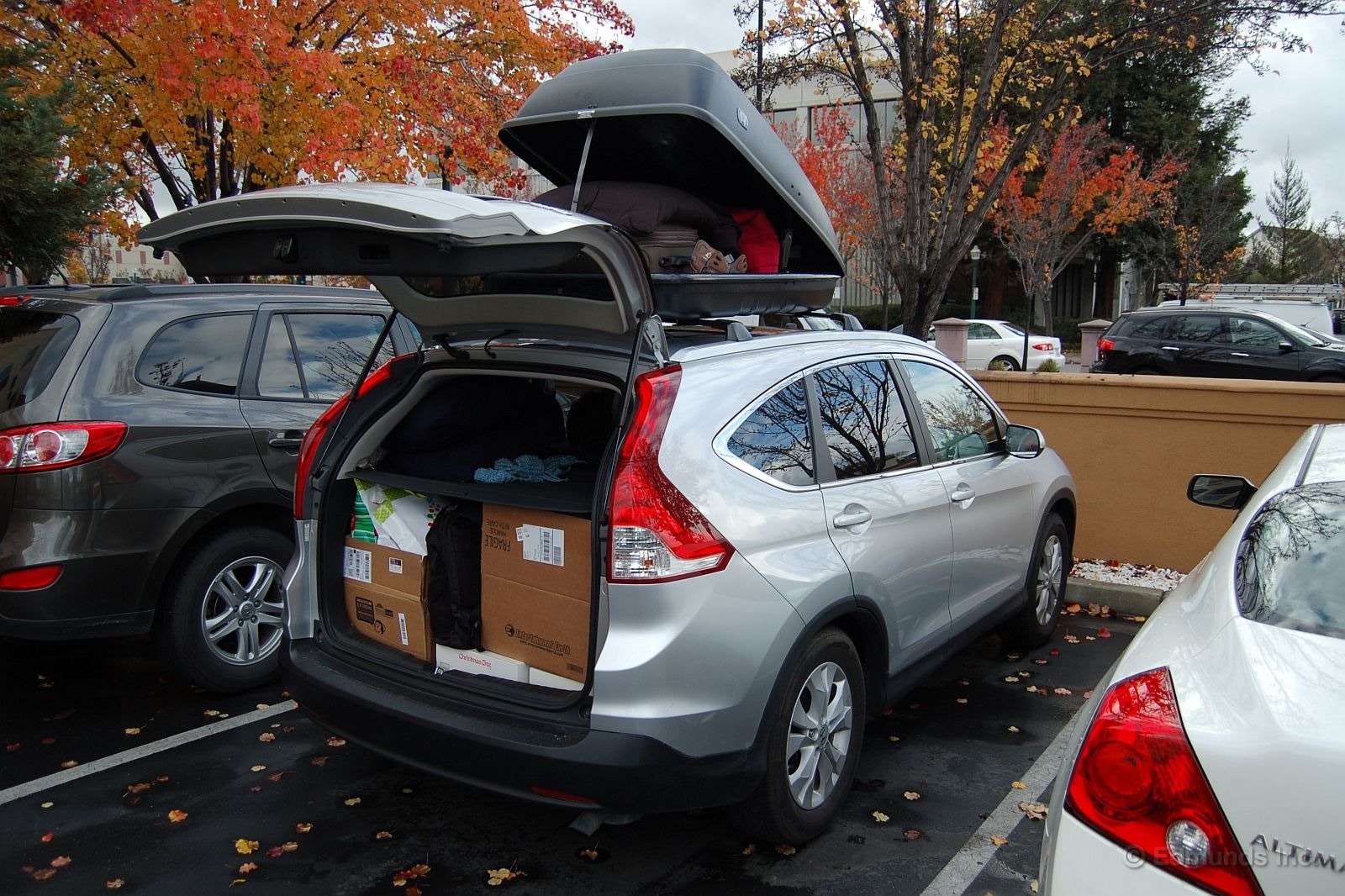
In normal conditions the 2012 Honda CR-V has proved it offers more than enough cargo space for a family of four on a long trip. We made just such a journey to visit my parents last summer in this very machine, in fact. Everything fit below the level of the retractable cargo cover, which is the safe way to go because visibility out the back remains unaffected. And it's highly preferable to have no teetering loose items that could topple onto rear seat passengers should one need to jam on the brakes to miss an elk.
But the holidays are a different matter. Staring at the mound of presents swelling beneath the tree, I knew I was going to have to do something to get them all safely north alongside the usual luggage the four of us would have.
That something was the installation of factory roof rack crossbars and a rooftop cargo box. Both were easy to install, requiring just two tools between them (or just one if you happen to have sturdy fingernails.)
For security purposes, I decided to pack the presents in the CR-V and put our personal luggage in the pod. Sure, the pod has a handy lock, but the vehicle itself has a better one — backed by an alarm — and it's got that retractable cargo cover to insulate the goodies from unwanted attention. Better to leave the pod empty in the hotel parking lots we'd visit along the way, I figured.
As we loaded up I realized I'd made the right call, because we filled the CR-V and the pod with little space to spare. It was time to head out, but how would the pod effect fuel economy, wind noise and, considering the high-mounted weight I'd just added, handling?
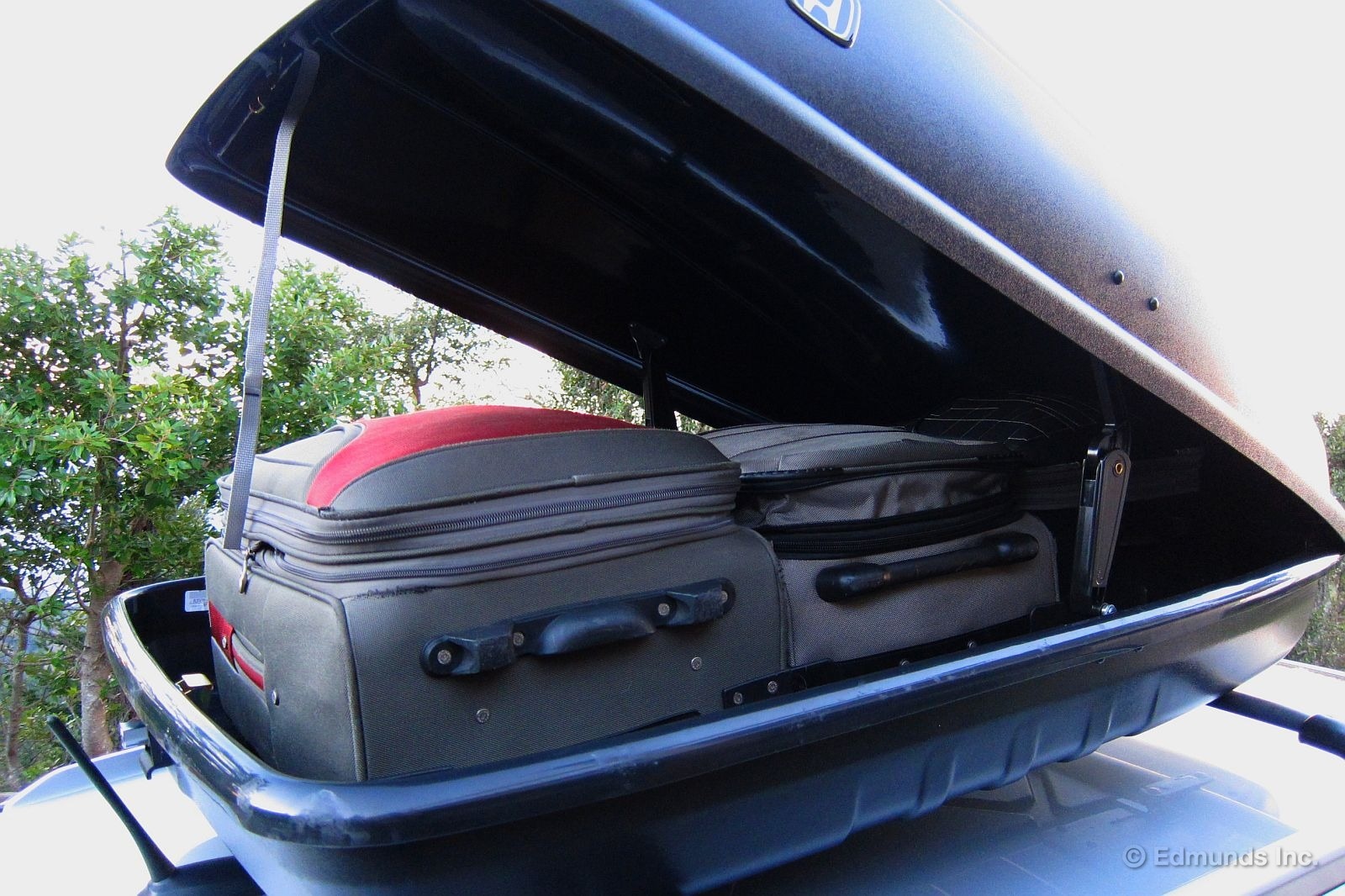
The roads on the second half of our trip, from San Francisco up highway 101 to the southern Oregon coast, feature a lot of corners and the asphalt dips and sags in many places due to incessant land movement. Handling and suspension tuning flaws are exposed easily up here, even when driven at the posted speed limits.
But the CR-V didn't flinch. It handled the corners as if nothing was different, loaded as it was with four passengers, presents inside and luggage on the roof. Three overstuffed 21-inch carry-on suitcases sat crossways up there, with space alongside in which we stuffed things like hiking boots, spare pillows and jackets. And we had rain along the way. We had high-wind advisories and actual crosswinds. But not once did it feel like a sail up there.
In retrospect this isn't surprising, because I came away massively impressed with performance of this suspension under load after a summer hiking trip I took with three other friends to Tonopah, Nevada. Steering feel and stability remained rock-solid there, too, where we drove on looser surfaces and carried perhaps more weight, though none of it sat high on the roof.
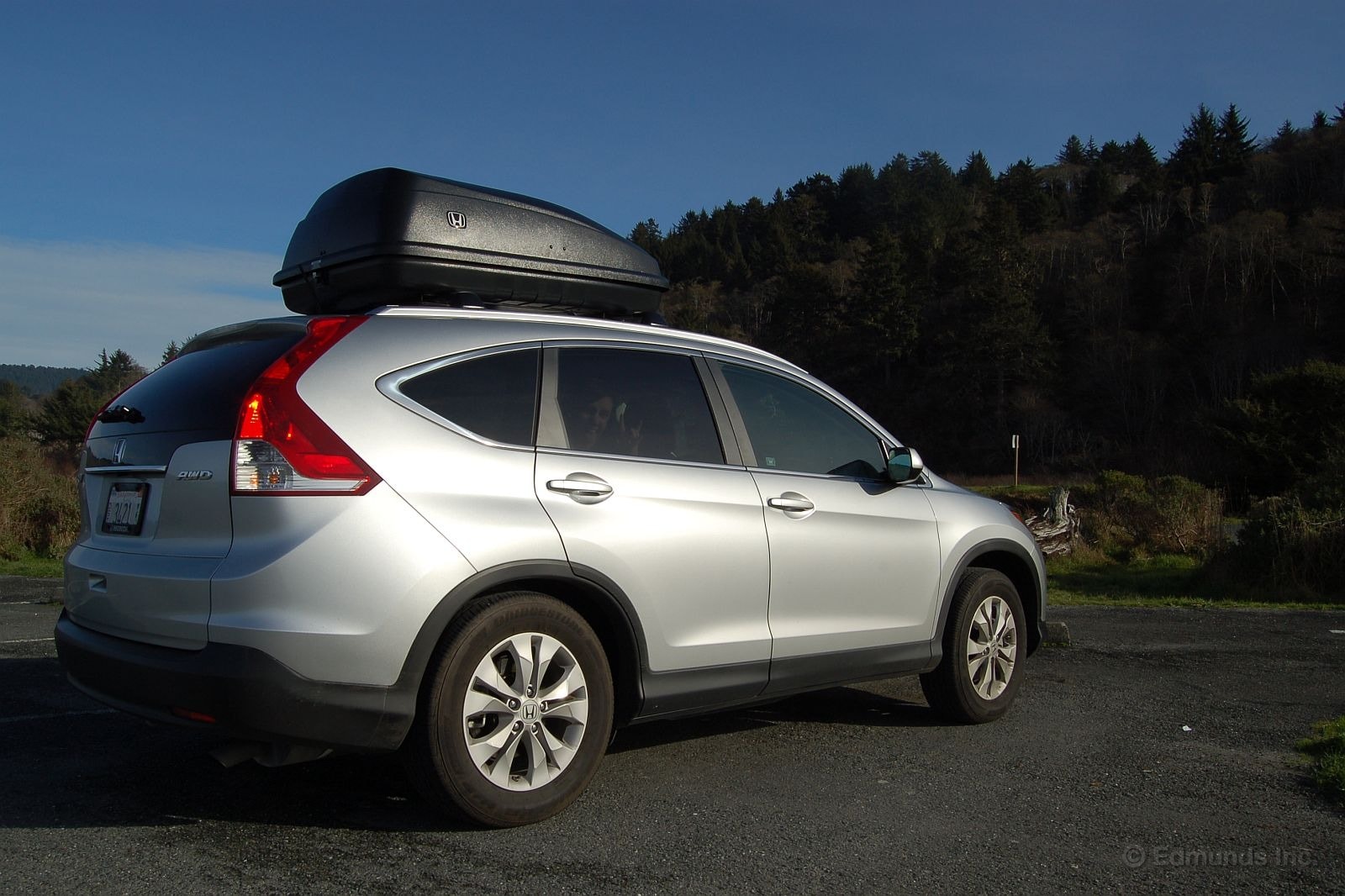
As for noise, we didn't notice much change because road noise from the tires still dominates the spectrum, and next most prominent is the usual whisper you get off the parked wipers. There may or may not have been a tiny smidge more coming from the upper rear corner of the front doors, which come within six inches of the front crossbar mounting point, but all-in-all it's as close as makes no difference. Nothing stood out, and the basic character of the sound didn't change: no new whistling, no pulsing turbulence.
I suppose the 2012 Honda CR-V benefits, in a way, from not being the quietest crossover when it comes to wind and road noise in the first place. The addition of factory crossbars and a rooftop box doesn't seem to move the needle much. Whether or not this has to do with the smooth contours of the factory crossbars remains to be seen.
As it turns out the gas pump was the only place the roof pod made its presence known. We averaged 27.8 mpg on a similar run with a naked roof last summer, and our best tank was 31.3 mpg. With the roof pod our average this time was 25.2 mpg, with a best tank of 28.5 mpg. So the additional aerodynamic drag of the protruding roof pod cost us 2.6 mpg, a reduction in fuel economy of 9.3 percent.
Frankly, I was expecting worse. This seems like a fair trade-off, especially when you compute it in dollars. At an average trip fuel price of $3.70 per gallon, the presence of the roof pod cost us $26.26 more in gas on this 1,912-mile round trip. Not bad at all, but you wouldn't want to leave it sitting up there empty all year.
In the end the "where to put it when I'm not using it?" question and the initial purchase cost are the only hurdles to overcome. The fuel economy penalty on this trip didn't even amount to a decent dinner for two, and the driving experience — on the well-sorted suspension of the Honda CR-V, at least — didn't change for the worse one iota. With one of these standing ready in the garage there's little reason to shy away from a downsized crossover SUV on a long trip.

The only way to tell the 2012 Honda CR-V is different is to close your eyes.
It's quieter, calmer and more refined. The CR-V used to hate big tires, but now it rides across broken pavement with impressive composure on these 225/65R17 Bridgestone Dueler HP Sport AS tires. There's still tire harshness in the Honda way, but the suspension no longer seems to crash across seams and holes.
The CR-V has come a long way in price (sadly), but it also seems to have come a long way in refinement.

I'm not opposed to foot-operated parking brakes.But I don't like having them in compact vehicles like ourlong-term 2012 Honda CR-V.
Thereason is thatthe footwell issmall tobegin with — it's not very widenor very deep. Adding a foot-operatedparking brake doesn'thelp this situation.And with my long legs and relatively large feet, it's easy to trip on it getting into the CR-V if the parking brakes happens to be off (and therefore in the "up" position).
After I'm seated in the vehicle, the parking brake is still kind of a hazard. When thebrake isstill on, it'spretty much on exactlythe same plane as the brake pedal (and in the way of the dead pedal), so the first thing I do when I get seated is to take theparking brake off... I'd rather just keepmyfoot on themain brake pedal(if necessary) while doing stuff likeentering an address in the nav system. Yet, even in the brake's off position,I'll still sometimes catch my foot on it while getting settled to drive.
Parking brake off:

Parking brake on:

Once I'm actually driving, I make a point of keeping my foot well enough away... it's not a big deal and I can still use the dead pedal as I normally would. It's just that with the foot-type parking brake, the footwell is more confining than it otherwise would be.
And although I like the big center console storage box, I'd be willing to trade it for a slightly smaller box just to make room for a hand-operated parking brake. Another option, of course, would be aspace-savingelectronic parking brake, but Honda's not a company that throws in those kind of lazy-man conveniences.

And so in automatic-equipped cars, what's your preference... foot-operated parking brake, hand brake or electronic parking brake?

Here's one reason the CR-V's cargo area absolutely rules. Forgive the Beyonce in the background as this was shot at a gas station.
One pull on each side and you're ready to go.

Honda is really good at some things. Small-item storage is one of them. Here, as you can see, is where the creative Honda people intended for me to keep my runnning shoes.
Perfect.

Here's another in what's sure to be a vast series of posts on our 2012 Honda CR-V's clever storage solutions. Yesterday, I made a fuss about wanting a handbrake and said I'd give up some of the CR-V's center console storage to get one.
Hours later, I was almost ready to take back those short-sighted words when I realized the deep center console box is a nifty solution for transporting wine securely from the grocery store. The rolltop-desk-style sliding lid is particularly convenient as it doesn't get in the way like a flip-top lid would.
Aside, someone asked if we would max out the hauling capacity of the CR-V. No promises, but that may happen next week when I pick up the six cases of wine I ordered, plus some cava-type sparkling wine, plus numerous other party paraphernalia.

Of course, the answer is, no, you haven't seen our long-term 2012 Honda CR-V for the last week, because I've been on vacation withit. It wasn't anything like aheroic road trip, rather the week of insanityleading up to my wedding.Honestly, I'velost count ofhow many times we went toTarget.
By the end of it, though, I'd racked up 600 miles of driving, all in Southern California. I hauled everything from family members to cases of wine to my own wedding dress, so yeah, mundane stuff. But I can't think many other vehicles I'd rather usefor constant errand-running.
I've had trouble warming up to small crossover SUVs in the past, so either I'm getting old and soft, or this is a really good one. The ride quality is comfortable — significantly more so than the previous two CR-Vs — and the driver seat is well shaped, supportive andsuitable for extended waits in unexpected traffic. The steering is darn good, too, especially for an electric setup. It's stable and unobtrusive on the highway and nice and precise around town.
The only thing I don't like about it is the same thing I didn't love about the previous CR-V...
...the drivetrain. The engine is weak in the grunt department (though at least it's smooth), and the transmission is slow to come up with downshifts (but again, smooth when it does shift). The thing is, the rest of the package is so strong, it's hard to give it much grief for this. Morestoriesof the mundane coming soon!

On the eve of my wedding, I loaded nine cases of wine in our long-term 2012 Honda CR-V, plus another eight or nine boxes and bins of plates, napkins, glasses and assorted decorations. Everything fit into the CR-V, and I still had a clear view out the back for the 30-mile drive to the church.
The CR-V has a nice, box-shaped cargo bay with minimal intrustion from suspension components, and you get an almost flat load surface when you fold the seats... there's a slight uphill slope (which is perhaps a slight disappointment given that the rear seat-bottom cushions now fold up independently of the seat-backs, eliminating the fore/aft adjustment the rear seat used to have), but the slope didn't stop me from tetrising everything in snugly.
Bottom line, I had a good amount of stuff to haul, and although I was pretty confident it would all fit into the CR-V, it went in a lot more quickly than I'd expected.


One thing that changed on the 2012 Honda CR-V is the liftgate. The one on the 2007-'11 model was lightweight and easy to close no matter what your level of upper-body strength. But the liftgate on our 2012 model is notably heavier and to get it shut securely, I find myself getting my legs into it a lot more often — kind of like this...

The driver's sideview mirror on the Honda CR-V is making me crazy. The line on the left-third of the mirror distorts my view much the same way my new bifocal glasses does.
If I wore the glasses or drove the CR-V everyday, perhaps I'd get used to it.
But for now, I'm simply annoyed.

The previous two generations of the Honda CR-V have always stood out for their low rear liftover height, and I saw the practical application of this in the Bevmo parking lot last week.
I was picking up three cases of sparkling wine, so I'd backed the vehicle into the nearest available parking spot to the door. It couldn't have been any easier to get the cava into the CR-V. Case is included for scale.

It's not often that you get to watch someone you don't know drive off in your car without getting freaked out...unless, of course, there's valet parking involved. Here our 2012 Honda CR-V ;is being wisked away to some unseen parking structure just off Cannery Row as my wife and I look on from our third floor balcony.
This year's Moto GP weekend at Mazda Raceway Laguna Seca coincides with our 20th anniversary, and since Monterey is halfway to Mom and Dad's place on the Oregon coast it only makes sense to keep heading north once the final checkered flag falls on Sunday.
Saturday night will prove interesting because the street below is to be closed and turned into a huge motorcycle parking lot. I hear alcohol consumption, whooping and hollering, gratuitous rev throwing and in-place burnouts will feature heavily. Whatever transpires, we'll have a bird's eye view.
As for the CR-V, all I know so far is this: a) it managed just 27.7 mpg during our semi-liesurely cruise up highway 101 and; b) I'm not in love with the laggy response of the touchscreen that controls the iPod/audio interface.

My plastic to-go coffee mug has a handle on it. I've mostly given up on the stylish ceramic coffee receptacles without handles, because I end up dropping them in my sink and they break.
So my mug has a handle and Honda designed the front cupholders in the 2012 Honda CR-V to accommodate one beverage with a handle. Nice.

Ordinarily, when I get into our long-term 2012 Honda CR-V, and click the text message button on the touchscreen, I see this message...

... because yeah, I have an iPhone without the Message Access Profile (MAP). My husband, however, has a MAP-enabled BlackBerry Bold 9780, so when his phone is paired and active in the CR-V, he can easily get his text messages. They come up as a list just like on your phone, and clicking on any of them displays the following and a female computer voice reads the message aloud:

You then have the option of responding with a handful of canned responses. Unfortunately, they're not customizable, which kind of limits the usefulness of this feature.

However, the CR-V's text-to-speech capability does at least minimally address the innate human urge to glance down at your phone when text messages come in while you're driving. Then again, my husband is also one of only 2-3 people I know who still has a RIMphone.

Monterey's Cannery Row is a very busy tourist destination, with little obvious parking for the hotels clumped along the narrow seaside street. I wandered into our hotel's parking structure to find out where the valets had been stashing our 2012 Honda CR-V each night and discovered the Clement Intercontinental's secret: they stack cars on dozens of lifts like this one. This discovery also explains why they suggest a 15-minute heads up from your room before you come down for your car. Turns out they have to shuffle the deck if your vehicle happens to be perched on top.
At least that's not a Triumph Spitfire or Fiat X1/9 up there.

Our trip up highway 101 and Interstate 5 is going smoothly, but the 2012 Honda CR-V hasn't yet put me in a mood to run out and buy one. And yes, my wife and I are in the market; our trusty minivan met an untimely end a couple of weeks ago. We're actively shopping but I don't think we'll be buying one of these even though it's in our price range and has the basic functionality my wife needs.
Exhibit A: the sun visor won't pull back, leaving a 6-inch area unprotected. As Scott Oldham once said to our crack photo squad, "It's the sun. You can't move the sun." The same is true of the trajectory of Interstate 5 north in central Oregon. So I sat there squinting for 90 minutes as the sun sank lower and lower off to our port side. This state of affairs would have persisted for another hour, too, if we hadn't exited the freeway and turned west.

Exhibit B is this screen and the matching computerized nanny voice that simultaneously breaks in over the music that says, "The phone has been connected," or words to that effect.
This would be OK if the message popped up just the once after I started the engine to confirm that the Bluetooth connection has automatically re-paired itself and is ready to go. Thing is, this message and that frickin' voice cut in and repeated that notification ... every ... thirty ... minutes. So far we've heard this about 25 or 30 times in the 14 or so road-hours we've spent in the CR-V since we left home. Something's not right here.
Exhibit C can't be photographed, but the wind and road noise are way too evident. It's loud in here on these asphalt roads, even the ones near the coast that don't see snow and tire chains in winter. Honda has never been one for stellar NVH, so this isn't a huge shock. I expected this.
Exhibit D is a cruise control I can't stand. When I set the speed and lift off the gas the CR-V doesn't immediately take over and continue on at whatever speed I was going. Instead it slows a mph or two, making me think it didn't "take", before finally cutting in and building speed back up to set point after a handful of seconds.
The laggy feeling continues when under way where it overshoots and undershoots unlike no other long term car I've taken on this hilly freeway route over the last 7 years. When it crests a summit, for example, the CR-V is frequently hard on the gas, accelerating straight over the top to the point that I have to intervene and hit the cancel button. Ultimately I turned it off altogether and went full manual to smooth things out for my passengers.
This system feels two decades old, maybe three. Sure, more power and a six-speed tranny would help, but I've seen others do better with similar equipment.

Exhibit E is a pair of leaky doors. My wife noticed this first on the passenger side, when a stream of cold air (it was 55 outside and the climate control was off at the time) tickled her fingers. It seemed to be coming from the seams that surround the door pull finger pocket in the armrest. I tried my side and the effect was quite noticeable there, too.
This is by no means the end of our gripe list — the touchscreen's menu flow is suspect and the wheezy 4-cylinder engine would be better served by a six-speed gearbox. And on the other hand my wife and I do like a thing or two. Still, it would seem the balance sheet tips too far the wrong way for us.

You didn't think all of my comments on the 2012 Honda CR-V would be negative, did you? Yesterday's gripes aside, the CR-V does do a lot of things right.
Cargo management is its forte. The CR-V swallows more stuff than it's outside appearance would suggest — 37.2 cubic feet behind the rear seats — and that volume presents a very usable shape because a typical carry-on roller bag fits under the cargo cover standing up. This made it ridiculously easy to fit all four of our bags with plenty of room to spare for laptop bags, a camera bag, makeup totes and whatnot.
Should you need more space (which we didn't,) the handle visible to the left is the release for the rear seatback.

What's more, the CR-V's cargo loading height is way down there at just 25.75 inches. Little chance of back strain here.

When all is said and done the CR-V has no trouble supporting our family of four on the road for a week with no loss of visibility, no loss of security.

Up front, Tracy and I really like the roll-top center console. It holds a lot of stuff, including the full-size digital SLR that snapped this picture. And the act of opening or closing it doesn't disturb anyone's comfort because Honda has not pressed the console lid into service as a center armrest like so many other consoles we could name.
Beyond its cargo and storage prowess, our 2012 Honda CR-V is living up to its advertised fuel economy. So far we've averaged 28.4 mpg over the 1,483 miles we've drivien to this point and just today it churned out 31.3 mpg, its best highway tank to date. These compare favorably to our AWD model's 25 mpg EPA combined rating and 30 mpg EPA highway rating. In an advertising climate where over-promising seems to run rampant, the CR-V's fuel economy ratings seem refreshingly conservative and achieveable.

Thanks in a large part to the all-new CR-V, Honda posted its best year-to-date sales figures since 2008.
The 2012 Honda CR-V has set its seventh consecutive monthly sales record with 20,554 units sold in July. That's 47-percent more than July 2011. The CR-V's sales numbers so far for 2012 are 167,236 units.
That's nearing Accord and Civic territory for best-selling models.
Are any of you contemplating buying a Honda CR-V?

Today we helped Dad clean out part of his garage here on the Oregon coast. Behind numerous "useful scraps" of plywood that "might come in handy someday" we found an old magnetic sign that dad used to slap onto the side of his parts-chasing trucks.
A former racer himself (1957 Indy 500 rookie of the year, in fact,) he used to own a shop that built race cars until he retired and moved up here over 20 years ago. One of my first jobs had me driving around southern California in a Ranchero or Corvair pickup with this sign stuck to the door, picking up things like Earl's Supply AN fittings, Premier nuts and bolts, FBI fuel cells, Halibrand rear ends and cro-moly tubing bends that would later make their way onto racecars. You could say I was born into this line of work, because it's true.

The Oregon coast is a great place to visit. Every roadside pullout is stunning and it almost seems as if there's a law requiring picturesque towns to be placed 25 miles apart, with a handful of outlying homes sprinkled between each. But don't be in a hurry because the locals most certainly are not.
Coast highway 101, though smooth-textured and generally well maintained, tends toward sinuous where it hugs the seaside cliffs and is often contorted due to incessant land movement downslope toward the sea. Oftentimes it's a challenging road that tells a lot about the worth of a given suspension calibration on roads that are less than perfect. Despite this fact it gets little attention from automaker suspension engineers because it's so remote. Pity.
Above is the Battle Rock parking lot in Port Orford.

Bandon sits 25 miles north of Port Orford, but about 5 miles south there's a jam store we stop at frequently for fresh preserves. They grow cranberries along this stretch of the coast and Oregon blackberries are nothing less than prickly hard-to-tame weeds that grow everyplace. Don't blow past this place without loading up.

But the roads around here are not to be trifled with. Dad lives on Carpenterville Road, an inland spur that used to be highway 101 before a straighter coastal route was made possible by a tall bridge over Myer's Creek. This narrow older route is even more subject to distrotions from land movement than the newer coastal route.
It's hard to tell exactly, but the above slump may have contributed to a motorcycle crash we came up on about 20 seconds after it happened. Or maybe the rider erroneously predicted the radius of the upcoming corner by the routing of the overhead power lines. Speed certainly was a factor. Whatever the cause, about six corners before this point a guy on a Ducati touring bike passed us in a hurry and motored on ahead, getting out of sight around the next bend in short order.
And then, right where the CR-V is parked above, we caught up to a huge cloud of dust.

He went off here, laid it down and sailed across a ravine and into those trees. My parents and I couldn't see him at first, but we could hear his shouts. I climbed down into the blackberries and found him crumpled between his bike and a tree, then flagged down a passing family who had better cell service than I did (Verizon >> AT&T up here) and had them call 911. We all waited with the rider and tried to keep him calm and prevent him from moving until an ambulance crew with a back board arrived. It was a long 20 to 25 minutes.
About an hour later we came back the same way. There were no skid marks, no sign anything had happened except these tracks, a pink exit-point dot sprayed by the Oregon State Police and some trampled blackberries.
Keep safe out there, especially if you're not a local and don't know the roads. They're ridiculously pretty, but they can bite.

If you decide you don't need to display a boring, wholly redundant analog clock, the Honda CR-V has a non-essential but nice feature. You can upload your own images via the USB connection and display them in that space instead.

The owner's manual spells out the wallpaper upload process and photo specs, which are principally that each image can';t be bigger than 2MB. I put three photos on a thumb drive and gave it a try. Despite the fact that all of them were under that size limitation, only one successfully uploaded. But now, at a glance, I can remember my leisurely day of rafting on the Weber River outside Park City, Utah. A nice respite from the taillights on the 405 at rush hour. (Photo: Tom Mills, Visions of the West Photography)

Sure, a long road trip doesn't hurt, but our 2012 Honda CR-V has already covered 5,000 miles. It happened a couple of days ago on the way home as we passed Mount Shasta headed south on Interstate 5. We'll add at least 600 more by the time we arrive back at home base.

When you look at the 2012 Honda CR-V's nav screen, it's easy to say it's the same as it ever was — dated and a little slow these days — but it's not the same. And it's not as good.
In previous iterations of this nav system (all of them until 2012) you could program the navigation and have full functionality of the system while the car was in motion. You can't do that anymore.
Honda was the last Japanese hold out on this issue and now, if you want to actually use the products you paid for, you have to go German. VW, Mercedes, Porsche and BMW all give you control whenever you want it and they've got far higher speed limits, and far faster cars to worry about.

I know I'm not the first to notice, but I have to give more props to Honda for having this hugely usable center cubby in the CR-V. As my co-workers will attest, my knapsack-style gym bag is like another appendage. In addition to my gym clothes this thing is packed with Clif Bars, water, iPod with armband holder, and shower stuff. Yet this jam-packed jock bag easily drops into the deep bin between the seats. And as Dan E. has noted, there's no flip-open lid to get in the way as the CR-V features a disappearing roll-top cover. I'm sure ladies with oversize handbags (like my wife) would appreciate this convenient feature as well.

Kelly Toepke previously blogged about the integrated blind-spot mirror in the CR-V, noting that she found the distortion it causes to be annoying. I too found that it was strange, especially when wearing glasses. I also don't think it does a very good job of actually showing you what's in the car's blind spot. I think the Fiat 500 had a similar mirror, but I thought it did a better job.
Now, Ford's integrated blind-spot mirror (pictured after the jump) found in most of its cars is far superior. It gives you a much better view of what's going on at 7 and 8 o'clock. In fact, I like it much better than the little blinking lights that come with high-tech blind-spot warning systems.


When I plug my iPhone into the CR-V to play music or a podcast it successfully plays ... for about 20 seconds. Then it goes quiet. Nothing I do can coax it into playing again.
Then I go into the Audio Source menu and call up Bluetooth Audio since my iPhone is paired for phone use. I then discover that it will successfully play in Bluetooth Audio. That's nice, except I don't want Bluetooth Audio. The sound quality's crap and I can't control anything besides play, pause, next and forward. If I wanted that functionality, I'd use a CD, which wouldn't sound like crap.
Others also noticed this annoying tendency, including Dan Edmunds who dug deeper and discovered that when you plug in your iPhone a little icon pops up on its screen. You press it, a menu pops up and then you tell the device where you want sound to be directed.
Hopefully you only have to do that once, though in other cars, you don't have to do it at all.

I despise high curbs and parking blocks. Why there's no standardized height for these things escapes me. A conspiracy perhaps conjured up by curb/block manufacturers and body shops? Who knows? But after a passenger scraped the bottom edge of my MR-2's door so many years ago, I've learned to carefully check the clearance if it looks questionable.
When I rolled up into this prime parking spot with this rather tall curb-like structure on the driver's side, I opened the door slowly and saw that I had plenty of clearance. Cheers to the little crossover for eliminating one of life's little stress points in the asphalt jungle.

The green 'Econ' button in our longterm 2012 Honda CR-V is for people who probably don't need it in the first place. Pressing it simply remaps the throttle calibration, deadening its response, and reduces the occurrence of the air conditioning compressor kicking on and allows the cruise control greater speed variation.
Engaging 'econ' won't provide a free lunch to a leadfoot since if you want to accelerate at a given rate you'll simply press the pedal further to achieve it. Plus, wide-open throttle is still wide-open throttle. The aircon thing still applies, sure, but it is possible its fuel economy upside would be lost in the noise.
Those who are truly interested in extracting the most fuel economy out of their car would likely already be driving in a fuel-efficient manner — gentle acceleration, using engine braking to slow, anticipate traffic signals, turning off the a/c, etc. — so pressing Econ won't do anything they're not already doing.
It may even be the case that people think that pressing Econ is a license to treat the throttle even more aggressively than they would have otherwise. Therefore I declare the green Econ button little more than show, especially when you consider the showy 'Econ' stickers on the rear-most side windows...

My use of the 2012 Honda CR-V for last month's trip to Monterey and Oregon came with one caveat: I would have to change the oil (or have someone else change it) before I set out. The hour was late so I decided to do it in my driveway.
I know, I know; 3,099 miles is a bit early according to the maintenance schedule. But the unusual nature of our track testing regimen has led us to halve the interval of the very first oil change. After this we'll stick to the published formula.
This is not something we feel is necessary for everyone. But, let's face it, our test days at Auto Club Speedway are not unlike an autocross weekend. We'd recommend you change your oil more often just the same if you counted autocrossing or track days among your weekend pursuits.
But even this bit of racer wisdom wasn't enough to make this decision on its own. It's also based on multiple new car oil samples we've sent to Blackstone Laboratories. After those tests the folks in Fort Wayne invariably reported back a version of the following: "Nothing looks bad, and prospects for long engine life are good, but we are seeing a wee bit more break-in metal in the oil than usual." Their advice was to do the first oil change early and settle in to normal maintenance after that.
I love it when lab results support gut feelings. And so we have the Edmunds test team oil change procedure for our long term test cars.
Enough back story. Here's how easy it is to change the oil and filter on this new generation of Honda CR-V.

Synthetic oil isn't specifically called for, but 0W-20 weight oil is required. At my local auto parts store these are one in the same, so I walk out with Mobil One. The oil volume is listed in the manual as 4.0 quarts without a new filter and 4.2 with one, but the stuff's expensive so I buy just 4 quarts, figuring I'll be very close to the full mark either way. The way I see it, the store is only a mile away if I'm unhappy with the result.
The end drive oil filter wrench comes from the same auto parts store, but I bought the oil filter and new drain plug washer at my local Honda dealer.

The CR-V has a forward center jack point that protrudes from a convenient notch in the plastic undercover. It's part of a perimeter subframe that encircles and supports the engine, transmission and front suspension. But this sort of perimeter subframe is not something that every car has, so it's quite common to find cars that lack such a front-and-center jack point. The new Ford Fiesta and Focus come to mind.

That forward jack point is especially fortunate because it makes it easy to put jackstands under the reinforced jack points. The results is a very stable platform.

The plastic undercover contains a hatch that must be removed to gain access to the filter and drain plug. It comes off easily with a Phillips screwdriver.

With the hatch out of the way, the filter and the drain plug are easy to spot. Better yet, they're very close together. Both can drain into the same pan at the same time with ease.
Trouble is, the drain plug you see here is not tight at all, as I don't have to exert myself in the least to break it free. I'm not sure what that factory pen mark is supposed to represent, but it is not near tight enough in my book. Barely tighter than snug, I'm able to loosen it with the pull of two fingers. Still, it hadn't been dripping before I started.

Glug, glug. Drip, drip.

Honda is one of those companies that suggest you install a new drain plug washer every time. You can barely see the scoring on the left one, but that's the telltale that marks it as used. As for the new one, it cost 30 cents at the dealer, the same place I bought the new filter.

In all the oil-stained excitement I forgot to take a picture of myself removing the filter. No matter, you've seen it before. An end-drive filter wrench of the type I usually prefer works very well here.
After that it's important to clean the sealing surface. All of the above is very easy because access is outstanding through the open hatch. This is an easy one.

Before installation I spread a light coating of fresh oil on the new oil filter's o-ring.
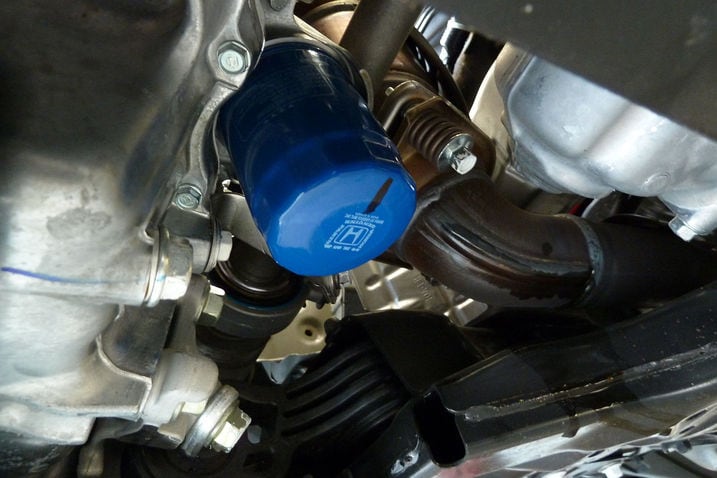
I like to put a Sharpie mark on the filter to make it easy to see when I've tightened it the proper amount — 3/4 of a turn, in this case. No tools but my bare hands were necessary.
Looks like I've got a bit more oil to wipe up, and I musn't forget to tighten that drain plug.
Once these are checked (and double-checked) it's time to reinstall the hatch and remove the jack stands to get the car back on level ground.

Pour, pour. Glug, glug. My patented water bottle funnel comes to the rescue once again. I pour in 3.5 quarts to start, then run the engine for a minute or so to distribute it to the nether regions. After that I refer to the dipstick as I pour in the rest. The oil level nudges up near the full mark when I'm done. Turns out I didn't need to buy that 5th quart.

The 2012 CR-V's oil life monitor is ridiculously easy to reset using steering wheel controls. It takes no more than a minute without the need to consult the manual.

Finally the oil needs to go into the waste drum at the auto parts store. My trusty Rubbermaid drain pan is excellent for this because its gasketed screw top lid doesn't leak and slosh oil all over the car. Don't think they make this one any more, though.

Done. But this all happened a month ago. I went on to put a good 2,500 miles on this new oil in the ten days that followed. Others have added at least another 1,000 miles since then.

The CR-V has a nifty center console, but owners of the previous-generation model know that this wasn't always the case. In last year's CR-V, the space currently occupied by the center console was an open area that could be used to stow large bags and whatnot.
I like the center console from an aesthetic standpoint, since it makes the cabin look more like an SUV's and less like a ladies' purse repository. And the console's bin is plenty big enough to store everything from gym bags to wine bottles, so no utility is lost. The only drawback is that the console makes the cockpit look and feel a bit less airy and spacious than that of the outgoing model.
Any owners of the previous-generation CR-V out there? Are you sad to see that open space go?

As you can see, the backup camera in our CR-V is not your average point-and-shoot. It has three available options for viewing the bumper you're about to run into.
Is this overkill?
Seems like it, although I'm sure there are situations where that fisheye view on the left comes in handy. So far, the standard setting in the middle seems to do the trick for me on most occasions.
I will admit that I'm becoming a bit too used to such cameras when it comes to parallel parking. It makes it so easy you barely have to think, and we all know where that eventually gets you.

I snapped this photo early in the morning sun as I was waiting for my daughter to meander out to the car. Today was her first day of 7th grade, and she was playing it super cool.
As we approached the circle drive in front of the crowded middle school, she unbuckled her seatbelt a tad bit too early, only to be audibly reprimanded by the Honda CR-V's female voice warning that the passenger's belt had become unhooked. Neither of us had heard that warning before.
"Jeez," said Emma. "I'm not even in the school yet, and people are already telling me what to do!"
Get used to it, kid.

This morning the Honda's CR-V voice command system asked me if I wanted to pair a phone. Weird, I thought, since I hadn't made any overture in that direction, and I'd never heard it make that request before. A few minutes later it asked me something more random about setting new controls.
Finally I realized that traffic was moving so slowly, I was perched very casually in the driver's seat, sitting with my left leg bent too far up. It was barely bumping the voice control button at the bottom of the steering wheel.
My accidental use of the voice commands made me realize the depth of the Honda's system.
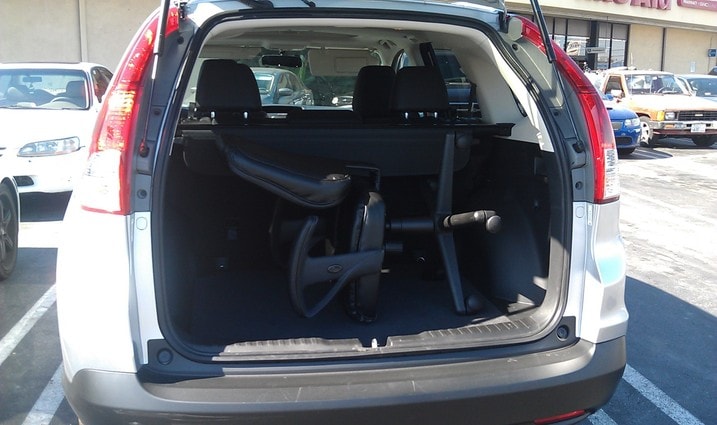
I recently bought a new chair for my computer desk at home. Staples had a nice one on sale, and for just $8 more they assemble it for you. I opted for that and was glad I had the CR-V the next day when I picked it up.
Stowing the chair in the CR-V's cargo hold took all of three seconds. I forgot the bungee cords but it was a non-issue as the load floor carpet and going smooth and easy when turning at the lights kept it from sliding around during the brief (two-mile) trip to my house.
Even though a compact hatchback would've likely been adequate for this particular task, it reminded me how convenient an SUV's cavernous cargo hold can be. Were I to get an SUV, this compact, easy to park, good on gas (26 mpg in traffic-ridden L.A.) crossover with its 71 cubic feet of maximum cargo space would suit my needs just fine.

The CR-V has been a strong seller for Honda so far this year and apparently Honda doesn't want to do much to stall that momentum. Today, the company released pricing for the 2013 models that will hit dealers in a few weeks and the CR-V only got a $200 price bump.
There are no new features or changes this year, so no price hike would have been nice, too, but there's no getting around a little inflation from year to year. So far, we would say that it's well worth it as our long-termer has been well liked by almost everybody that gets behind the wheel.

I drove our long-term 2012 Honda CR-V for two weeks before I got married, and so, with fondness, I selected it as my weekend car. I am a fan of this compact crossover, and true to its reputation, not because it does anything particularly well.
I know I could get more power and torque in a Ford Escape, a Hyundai Santa Fe Sport, or anything in this class with a V6. I know I'd prefer the steering and handling in the Mazda CX-5.
Yet, there's something about the way everything works together in this Honda that I just like. Throttle response is respectable. The automatic transmission shifts smoothly and feels kind of sophisticated for this class despite having only five forward gears. The ride quality is good, better than any previous CR-V, and it's composed over rough patches of freeway. And while this thing doesn't feel sharp and sporty through corners, it feels steady, capable, easygoing.
I also like sitting in the CR-V. The driving position is good for me, an adult of average height and weight, and there's a sense of space you don't get in other crossovers in this class.
I do have one complaint after my weekend in the Honda CR-V, though.
These reflector-type halogen headlights are dim. And they are as good as it gets, even on this $30,825 EX-L model. HIDs, or at least projector-beam headlights, need to happen.

Road noise has been an annoyance in the Honda CR-V since, well, the very beginning. Then again, no one buys (or should buy) a budget compact crossover SUV expecting total serenity, and if someone asked me to recommend one with a quiet ride, I'd suggest shopping for a normal hatchback or sedan instead.
That said, our fourth-generation CR-V seems quieter overall to me than its predecessor (2007-'11). We've logged official decibel numbers for both generations, so I looked them up to gauge the veracity of my ears.
2012 Honda CR-V
Sound level @ idle (dB): 39.2
@ Full throttle (dB): 72.3
@ 70 mph cruise (dB): 66.4
2008 Honda CR-V
Sound level @ idle (dB): 45.8
@ Full throttle (dB): 72.8
@ 70 mph cruise (dB): 67.5
So there would seem to be a difference, at least a slight one. Alas, I have to offer a caveat, because the 2008 model was tested at a different location (read: not at our default test track), so its 70-mph reading (at least) is subject to the different surface conditions there. My guess is that the 2008 CR-V's decibel level would have been a touch higher at our home track. (Of course, out in the real world, varying surface conditions are always a factor if you want to talk about road noise, and nowhere are they more variable than in a state like California.)
Both the 2012 and 2008 CR-V had original equipment, all-season Bridgestone Dueler tires, size 225/65R17 102T, by the way, but our 2012 has a newer version of that tire and no doubt a slightly different compound.
And just for kicks...
2013 Ford Escape (2.0T)
Sound level @ idle (dB): 44.9
@ Full throttle (dB): 72.7
@ 70 mph cruise (dB): 68.6
2012 Mazda CX-5
Sound level @ idle (dB): 43.5
@ Full throttle (dB): 74.2
@ 70 mph cruise (dB): 67.0
2010 GMC Terrain (2.4) (our long-termer)
Sound level @ idle (dB): 43.2
@ Full throttle (dB): 72.3
@ 70 mph cruise (dB): 69.7
2010 Hyundai Tucson
Sound level @ idle (dB): 40.4
@ Full throttle (dB): 73.1
@ 70 mph cruise (dB): 68.4
2011 Kia Sportage (2.4)
Sound level @ idle (dB): 42.8
@ Full throttle (dB): 73.5
@ 70 mph cruise (dB): 70.6
These numbers all came from our usual test track and are directly comparable to the 2012 Honda CR-V's numbers.

You can't do much with the 2012 Honda CR-V's navigation system when the vehicle is moving, at least not if it involves touching the screen. Mike Magrath already told you that. However, in a moment of mild desperation and annoyance over the weekend, I tried the voice control. And surprisingly, it works great.
Great, as in I almost never I have to repeat myself because the system usually understands me on the first try. All you do is hit the talking head icon button on the steering wheel, say "destination," and wait until it asks you what kind of destination you want to enter (i.e., "address," "intersection," etc.). Then, the nav lady guides you through the entry process, and prompts you enter the city, then the street, then the house/street number. Street names can sound alike, of course, so the Honda's system brings up a list of possibilities and lets you touch the screen (just this one time!) to select which of the names you actually said.


Over the course of two days, we entered a couple destinations on the fly, by voice, and were satisfied with the results. This is a really good voice control system, and I also used to select specific satellite radio stations, because there's no tuning knob here and using the channel list on the touchscreen to page through to the channel I want is tedious and distracting.
Taking into account voice control, I'd rate the nav system average for the price range — more useful than some other factory setups but not as nice as others. My main complaints are that the screen is picks up all kinds of glare (as seen in my lead photo), and that the maps aren't nearly detailed enough — trying to zoom in to see a specific street is a pain.

As far as trip computers go, I'm just interested in knowing what my fuel economy average is and how many miles I can still drive before needing to refuel. I don't need distracting, minute video game graphics that tell me the fuel mileage every nanosecond or that act as a "coach" to promote more fuel efficient driving. Let me guess — If I go easy on the gas I'll get more miles per gallon?
The CR-V provides all I want in large, clear font that's located up high where it's easy to see at a glance. And don't be alarmed by the 17.0 mpg average I was getting over the weekend — the CR-V saw virtually all city driving (with plenty of traffic as seen above). The CR-V is averaging 25.7 mpg overall with us thus far.

Yesterday, I posted a quick infographic on the Prius lineup. Today, it's crossover SUVs that include our Honda CR-V. You can read the whole story here.
On the numbers alone, the Honda CR-V nabbed the top spot among its competitors. For a family CUV, it makes a lot of sense, but for me?
I'm in the minority that would pick the Kia Sportage. I don't need a ton of space and the fuel economy is only off by 1 mpg. In terms of TCO, it's pretty bad, but those who know me would understand my problem with money and sensibility.
I attended the media launch for the Sportage, and maybe what they said resonated with me. It was aimed at single- or single-minded males. Zing! Now, that wasn't enough for me to drink the Kia Kool-Aid, but it certainly pointed me in that direction. Sharp styling and a tighter suspension had me sold, but I know most would pick something else.
What is your choice?

I passed a first-gen Honda CR-V on the road this morning, and thought it looked much smaller than I remembered.
So I did what I always tell my kid to do. I looked it up:
2012 Honda CR-V AWD
Height:65.1 in
Length: 178.3 in
Wheelbase: 103.1 in
Ground clearance: 6.7 in
Curb weight: 3,426 lbs

1997 Honda CR-V AWD
Height:65.9 in
Length: 177.6 in
Wheelbase: 103.2 in
Ground clearance: 8.1 in
Curb weight: 3,164 lbs
Current model is a little shorter in height, little longer in length, and quite a bit heavier.

Our longterm 2012 Honda CR-V's five-speed automatic is a relic of a bygone era. It could use an additional cog if for no other reason than to not drop so far off the power following an upshift. Also, it's got a pushbutton lockout for 4th and 5th and old-school D2 and D1 selections on the console selector. I won't bother to bring up the non-revmatched downshifts when you use it, either (oops, too late). And no manual mode? What is it, 1991?
Niggles aside, it's not a bad gearbox. Just behind the times, that's all.

There's nothing wrong really with the five-speed automatic transmission in our long-term 2012 Honda CR-V. You can pick on it for only having five forward gears instead of six like many rivals, but it shifts smoothly and so far has helped us to a 25 mpg average (which also happens to be the CR-V's EPA combined rating).
But now I've experienced Honda's continuously variable transmission as paired with a new, direct-injected 2.4-liter engine in the 2013 Accord, and it's really good. Not only is it quite tolerable for a CVT, as it's programmed to mimic conventional upshifts when you lift off the gas so that engine rpm drop back in a more "natural" way, it's far more responsive in passing situations on the freeway. And the 2013 Accord is a second quicker to 60 mph than last year's model.
There were several instances over the weekend in which I wished the CR-V could respond more quickly to throttle inputs. Acceleration is adequate in the Honda but no more, and its track numbers (9.4-second 0-60, 16.8-second quarter-mile at 83.0 mph) reflect that.
In the broader context of the CR-V as a sensible small family hauler, the current drivetrain is livable, but I can't help thinking I might prefer it with the new CVT. I would guess I'll eventually get my wish but probably not until the next generation of the Honda CR-V.

When we first reported a recall on the 2013 Honda CR-V for door latch failures, parts were not yet available at dealerships. Now they are in stock. So we called our local shop, Honda of Santa Monica to schedule service.
Renovations didn't seem to slow the process. This was a reasonably quick fix. Both front door latches and handles were replaced under warranty in about two hours, as promised. Now we are back on the road.

So I'm recommending the 2012 Honda CR-V to people with young families all the time. Along with the Ford Escape and Mazda CX-5, it is my favorite of the new breed of compact utilities. And as with every Honda, the CR-V is a miracle of space-efficient packaging, a perfect container for grown-ups, small kids and all the stuff that comes with that stage in life.
The trouble is, I cannott drive the CR-V to work.
It's partly the route that I drive, as this portion of the San Diego Freeway is famously over-used and worn out. Even after recent resurfacing, the road crests noticeably on each overpass across the surface streets. The CR-V bounds over every crest as if it were some kind of baby buggy of the 1950s. It even kicks at little at the back, which is the classic sign of stiff springs in the rear that don't have as much rebound damping control as you'd like.
Ironically enough, this is the kind of ride behavior that always cursed utility vehicles that were based on pickup trucks (like the original Ranger-based Ford Explorer), which is part of the reason that preferences shifted to more comfortable, controlled crossovers on car platforms (like the new, Flex-based Ford Explorer).
I shouldn't complain, really. The CR-V's freeway ride isn't that bad. Plus, it's not like you can suspend the laws of physics, because when you calibrate springs stiff enough to carry the load of five people and all their stuff, you'll get a package that's not exactly suited to one person. This is why your basic heavy-duty pickup truck with an empty cargo bed seems to spend so much time in the air rather than on the ground as you drive it down the road at a high rate of speed – stiff springs for cargo capacity, not enough damping to control compression or (especially) rebound.
But even so, this reminds me that there's something about the way that Honda does its ride tuning that I don't get along with. For me, the only Honda that really suits me is the Acura ILX, which indeed has up-rated (and expensive) dampers as part of its suspension package.

I've spent a lot of time in the 2012 Honda CR-V, and although I find its interior functional on a lot of different levels, the i-MID interface seen here at the top of the dash is not one of them. I almost never use it. I just leave it on the radio display. There is a wallpaper function, a trip computer display and a settings menu. But, in order, I'm too lazy to upload a photo, don't like to feel pressured by seeing my average mpg as I drive and never need to adjust those settings.
One potentially useful feature i-MID does offer is the ability to change audio sources using the buttons on the left side of the steering wheel.

The sources scroll by horizontally and look sort of slick, sort of recreating a smartphone/tablet vibe.

But I can get the same functionality in a more straightforward (and old-fashioned) manner simply by hitting the Audio button on the center stack and then the Source "button" on our EX-L Navi model's touchscreen. For me, this is the quicker, more intuitive way to change from FM to AM and so on.


Of course, my anti-i-MID stance is based partly on the fact that we have the ritzy, low-volume Navi model with a convenient (though not exactly elegant) touchscreen. However, I drove a non-Navi 2012 CR-V EX cloth model when we made this video and still found myself using the hard buttons on the center stack to change sources rather than the i-MID-specific steering wheel buttons.
On the other hand, i-MID is the only way to see album art if you're taking advantage of the 2012 CR-V's Pandora integration. If I used Pandora more, I'd probably be a bigger fan, but between the morning news and post-season baseball, there simply isn't the time.
I'm curious to hear from anyone who owns a 2012 CR-V or Civic... do you like i-MID?

There's nothing like a desert road trip in the fall, when the heat of summer starts to slack off and the sky gets a little more interesting. I grabbed the keys to our 2012 Honda CR-V and joined 10 of my friends for a few days of hiking and exploring near Tonopah, Nevada and the ET Highway, some 405 miles away from home base.

Four of us are travelling in the CR-V, and since we're not staying in the same hotel twice we're toting around our luggage and hiking gear the whole way. The Oregon road trip I took some weeks back left little doubt that the CR-V would have no trouble on this trip.

I didn't get much sleep before we headed out, so the drive up here left me a little tired and gaunt. I should be feeling better after I down a couple of cervezas and get a good night's rest.

Our three-vehicle convoy, consisting of our 2012 Honda CR-V, a Toyota FJ Cruiser and an Isuzu Rodeo, was following a trail headed due north out of Rachel, Nevada. Within a couple miles we'd encounter a nameless, medium-sized dry lakebed and motor straight across.
That was the plan, but nature had other ideas. The rains of the previous day had rehydrated the ancient lake, if only to a depth of a half-inch or so. That was all we could tell from shore as we all posed for walking-on-water photos, at any rate — it could have been deeper and softer farther out.
To find out if we could continue on our intended route we sent the FJ Cruiser on ahead, with its knobbly wide-footprint tires and low range transfer case. He stayed close to "shore" as he crept around the perimeter, looking for a way around, but ended up aborting the trip when his front end suddenly hit softer ground and began to sink to the axle. After he extracated himself it was clear as mud we'd have to give up on this trail and go find another.
But that wasn't the end of it. We did what any of you would do: we hung around and splashed about in this most massive of puddles, making sure to stay close to shore and within range of the FJ's winch on our relatively hard-packed end of the lakebed.


Thanks to Terry for manning my camera while I went splashing about.

Recent rains made the going easy in this part of Nevada, on account of a near total absence of dust and excellent grip. Resident mountain biking ace Josh Jacquot calls this sort of just-right damp soil by the name of Duncan Hines brownie mix, though the sandier patches out here trend slighty towards oatmeal cookies. Whatever, our 2012 Honda CR-V ate it up, which is a good thing since we covered all of 150 miles on dirt today, maybe more.
Mostly, the roads were kind of straight, but a good number of high- and medium-speed corners and more than a few crests and dips were sprinkled along the route to keep things interesting. The low places almost always presented us with an inviting mud puddle, and there were a few places where stones had been washed into the road.
Considering our load of 4 adults, their luggage, and two loaded coolers, I expected I'd have to rein myself in and tiptoe through the dips to keep out of the rear bump stops.
This was not the case. The Honda's suspension does not go all soggy when you add weight, instead it seems to come into its own, as if this was the situation it was built to serve. And so I was able to maintain a high pace — upwards of 60 mph, in places — and through it all the steering was direct and sure, the springs and dampers felt like they were right in their sweet spot, and the rear suspension still had travel enough to roll through the low places at barely-diminished speed, soaking up the compression without coming close to bottoming.
Note to self: remember to close the sunroof as you approach a mud puddle in this situation, otherwise your backseat passengers will be wearing tiny flecks of it. Sorry Linda and Rodger.
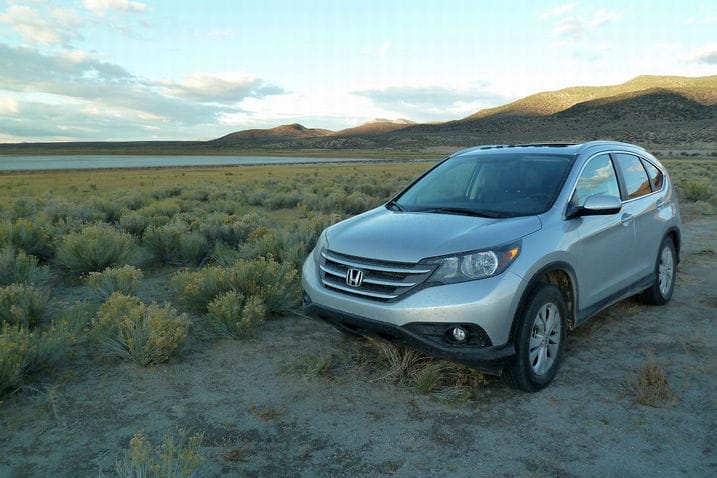
Of course the spur roads were narrower and more primitive than these, with steep gradients, rocky washouts and plants growing up through the middle and along the sides. Here we did have to back off as we negotiated around and over stones and straddled brush that rubbed harmlessly along the underside of the car. The CR-V's AWD system proved quite capable through a couple of three-wheel teeter sections, and the Honda's oddly slanted and somewhat unattractive nose provided decent approach angle clearance through a section of those huge desert whoop-de-doos that ATV's and dirt bikes leave behind.
Still, the 2012 CR-V doesn't have anything close to Jeep levels of ground clearance, so good line choice and a healthy respect for rocks is essential. We never had to get out and move any, though.
Could a passenger car have come this way? Yes, on 85 percent of these roads, but at nowhere near the pace we were able to comfortably maintain — especially in the low, rocky and muddy places. As for the other 15 percent, the chances that a sedan would get stuck or damaged without copious on-the-spot trail grooming were pretty high.
All-in-all, the CR-V AWD is proving to be quite a capable soft-roader. It likes it out here.

During my Oregon trip, and every now and then around town, the CR-V's Bluetooth connection drops out, but I only know this because the nice nav lady's voice breaks in and says "The phone has been connected" as a similar text message covers the screen.
This is supposed to happen just once when you start the car to let you know an existing connection has been reestablished, but in our CR-V it sometimes happens while we're driving, indicating the connection was lost then found again. On long trips it's not unusual for it to happen once every 30 minutes to an hour.
Why? I have no idea, but it should have nothing to do with variations in local cell reception, because Bluetooth is a protocol that connects a phone/MP3 player to the car. What's going on at the tower shouldn't matter.
It's mildly annoying, but things started to get out of hand when we were in Rachel, Nevada, where the message started to come up every 2 or 3 minutes. I started to keep track but quickly gave up after I recorded 30 incidents in less than 90 minutes.
In case you don't know, Rachel is mid-point way station on Nevada's Extraterrestrial Highway. It's the nearest settlement to Groom Lake and Area 51, an isolated military base where top secret stuff is tested. It's all fun and games, but the top secret military base is for real. Who knows what kind of radio signals and jamming devices are in play out here.
From the Honda I want two things: a stable and robust Bluetooth connection, and if I can't have that I need a way to turn off the damn warning so I don't have to listen to it all the time. But there is no such setting in the CR-V's nav system.

It was a brisk morning in Tonopah, Nevada and the other two vehicles in our convoy had already left the parking lot. "I have a blog photo to take in front of this mural," I said. "You guys go on ahead. I'll catch up."
Just after they got out of radio range I noticed that the 2012 Honda CR-V's TPMS light was ablaze. "Oh, expletive," I muttered, thinking back to the large number of small stones that had been strewn along the gravel roads we'd been on the previous day.

Nothing looked out of sorts, as is often the case at times like this, so I whipped out my gauge and checked all four tires to see which one was low. The recommended pressure according to the CR-V's door jamb sticker is 30 psi all around. My trusty gauge read 30 psi on three of them and 29.5 psi on the other.
Basically, there was no problem. This was a false alarm. The typical TPMS trigger point is 25% below the recommended tire pressure, so the light should not have come on unless the tire pressure was down to 22.5 psi or less in one of the tires.
Why the false alarm? I have no clue. The overnight temps were in the low 40s, and Tonopah sits at 6,000 feet, but my gauge reading made sense in the same circumstances.
So I drove on, confident that the light would extinguish itself in 10 or 15 minutes.
Why that long? Well, the sort of TPMS the CR-V has, the kind that doesn't have wheel position intelligence, transmits a pressure reading to the central computer every three minutes or so. In order for the light to go out the computer needs to see a string of similar readings — typically 4 or 5 — before it gains enough "confidence" to extinguish the light. Three minutes times 4 or 5 readings works out to 12 to 15 minutes.
And so it was. The light went out as expected about 12 miles down the road and it hasn't come back on since.
I could get irritated by this, but that impulse disappears when I think back to all the times TPMS has saved our editors the hassle and potential peril of a roadside flat or blowout. I'm OK with the occasional flakey reading if the worst thing that happens is I get out my gauge and check the tire pressures when maybe I don't really need to.
Of course the operative word here is "occasional." Once a month I could handle, because we all should be checking our tires at least that often anyway. But I'd be pissed if this happened several times a month. We'll keep an eye on it.


Our 2012 Honda CR-V quietly rolled past the 10,000-mile mark on the way to work after a few eventful days under gorgeous skies in Nevada. This trip alone accounted for 1,100 of those miles, but with all the dirt roads and the start-stop driving we did they weren't particularly efficient ones.
At one point we had to buy gas priced at $5.89 per gallon at the Nipton Road exit on our way back from Las Vegas. Unlike the nearby bustling metropolis of Baker, there's only one station at Nipton Road, so they've got no price competiton. Yikes! Keep on going to Baker if you can make it. Compared to this mugging you'll save a ton.
Still, the tank of gas we bought there resulted in 30 mpg, our best mileage of the trip. This matches the CR-V AWD's 30-mpg EPA highway rating despite our load of 4 adults and their luggage and a general desire to get home without wasting any time.
Our worst tanks, achieved for the most part while poking around in the dirt, were 20.5 and 21.1 mpg. These crummy but understandable results were largely responsible dragging our trip average down to 24.2 mpg, slightly below the CRV AWD's 25 mpg EPA combined rating.

Dan Edmunds sent me this photo from his adventures in the desert. We haven't had a caption contest in a while, so I'll give you until Friday afternoon before I post our favorite.
What is your caption?

Thanks to boff for our favorite caption.
Thanks to all who participated. Here are the others that made us laugh our faces off:
Ghost In The Machine (boff)
Ghost rider (teampenske3)
Who turned the seat heaters on high? (noburgers)
The CR-V is no bum steer. (ergsum)
Yup, dead steering! (billtrez)
Okay, whose boneheaded idea was this?! (ergsum)
The CR-V is a bonefied off-roader! (altimadude05)
Pushing Daisy. (kain77)
Roast rage. (kain77)
Honda, a car so reliable, it will outlast its driver. (itsmpt)
License, Branding and registration please. (stpawyfrmdonut)
That drive really took a lot out of me. (stpawyfrmdonut)
I have no beefs with this car. (mnorm1)
He was racing a Ferrari and got slaughtered. (mnorm1)
Cattle in cars getting coffee (stpawyfrmdonut)
Top Steer (ergsum)
What was your favorite?

On my way to wash our 2012 Honda CR-V this morning I encountered this guy. Red Bull calls Santa Monica home, as we do, so it was only semi-surprising to see it. But when I got back to the office I did some research. Apparently, this thing is even more awesome on the inside. Take a look...




I was off to the local recycling depot this morning in our 2012 Honda CR-V when I saw this truck parked on the curb. It looks like he beat me to all of the good cardboard. It also looks like he didn't plan for it to rain last night. Better to see him parked than trying to drive. Good luck, buddy.

If you're a frequent visitor to the Edmunds site, you're probably familiar with True Cost to Own, a metric that looks at a wide range of ownership costs, including things such as depreciation, maintenance costs and fuel expense.
The numbers change from month to month, and for the month of October, the CR-V had the lowest True Cost to Own in its segment (SUVs $25K-$35K). Not exactly a surprise, given Honda's reputation for reliability.

Our 2012 Honda CR-V was parked in my driveway the other afternoon. The sun was at just the right angle to highlight the tire tread grooves of its all-seasons. Without these the CR-V would be slipping and sliding every time it crossed a puddle.
Maybe I'm easily amused. But I think this is pretty cool. Its something you don't see every day, at least.

I knew the CR-V could haul plenty of stuff for my kid's birthday party — coolers, ice tub, chairs, an old pigskin — but I didn't think it would have the depth to haul two 8-foot long folding tables. A fold-flat front passenger seat like the Honda Fit's would have made easier work of this task, but as it was this was simple.
Slide the seat max forward, recline until the seatback met the folded second row, remove the headrest and slide the tables to the windshield. There was still almost another foot of clearance to the liftgate. Impressive.
No room for the kid and her mom, though. I left them at home and ate the cake by myself.

Our CR-V's oil life is down to 15 percent now. We're at nearly 11,000 miles. In-house Jedi wrench Dan Edmunds changed the oil at around 3,100 miles, ahead of the recommended interval due to our initial track test regimen and Dan's subsequent road trip (read his post for a fuller explanation).
So we're at 8,000 miles on the current oil. The "B1" notification also reminds us that it's time for a full complement of factory recommended services: oil change, brake service, tire rotation, regular inspection of links, hoses, lines and levels.
I'm guessing we'll get it in for service (or DIY-it again) soon enough. How long should we wait? Should we take the oil down to zero percent and just thicken it with metal flake?
In times like this, it's helpful to ask: What Would Soichiro Do?

Since our 2012 Honda CR-V apparently doesn't come with a cargo net and I couldn't very well have my precious Halloween party booze spill all over its 37.2 cubic feet of cargo space, this did in a pinch. FYI, footwells are also too big to secure one bag of booze. In other news, those with long legs love it I'm sure.

Seems that in the past five, six years, Honda's instrument panels — particularly the dash gauge cluster — have gone goofy with the starship bridge motif. Other automakers have also fallen for this techno funk, but all the winged displays, semi-circle gauges and kaleidoscope lighting feel distant from the more classic Honda/Acura interfaces of 10, even 5, years ago.
I can hear a product planner pleading, "But it's what the kids want!" And that's fine, except the kids aren't the ones buying your CR-V, and they started getting bored with your Civics when you put struts up front (2006 Si excepted).
So it's some relief that while driving at night, you can turn off the navotainment screen entirely for a little visual soothing. This is a personal peeve, and I'm staying on it until every automaker in the developed world hears me. I even kinda want a screen defeat feature named after me, like the Monroney sticker, so just bear with me here. I'm on a mission.
The i-MID screen doesn't dim completely, but it's not as bright as the camera makes it seem. And you can kill the graphics except for time and temp. Not ideal, but it'll do.

I'm pretty sure this was the first time I've driven our CR-V long-termer. And it stood out for me.
But not because it's exceptional at anything. Rather, because there's nothing that this little SUV does badly. Well, except for maybe that rear styling.
But back to my point. So far, anyway, I haven't found any truly annoying driving quirks.
There's no wonkily-abrupt throttle delivery. The CR-V's is smooth and intuitive.
Same for the automatic. You can rag on it for only being a five-speed, but it's exceptionally subtle and reacts just quickly enough to throttle inputs.
The ride is well-damped, nothing at all like the jiggly Kia Sportage short-termer I drove the other night.
The engine doesn't have a ton of power, but it's also not thrashy.
Ultimately, there's nothing overly exciting about the CR-V. I certainly wouldn't call it fun to drive. But in terms of getting folks from A to B with zero fuss and in plenty of comfort, it gets the job done.

Oh, great! This is exactly what I don't need while driving to the airport at 0-dark:30 on the way to catch an early flight to Japan. Our 2012 Honda CR-V is throwing me a two-fer: a TMPS warning light and a maintenance light.
I can not miss my flight, and leastways I have no tire gauge, no handy gas station with an air hose. Still, a very quick stop on the roadside for a hasty visual check is warranted. All four tires look the same, so I press on, figuring I'm good to go for the 25 remaining miles to the airport parking lot, where I can deal with the tire if time permits.
Thankfully, the TPMS light winks out about ten minutes later, making me think it's at least partially temperature-related. Maybe all four tires are a little low and the low morning temps were enough to illuminate the light until they got some heat in them. I can sort that out later.
But the panic got me thinking about Wally Park, a particular LAX airport parking outfit I frequent. They have mechanics that can perform an oil change and do other minor work while you're out of town, but I've never bothered. Maybe now is the time to give it a try.

The pricing for the synthetic 0W-20 oil and filter change I want looks reasonable, so I put in my order and hand over the keys to the valet. They throw in a free car wash, too.
Minutes later I'm on the airport shuttle on the way to the terminal. We'll see how this pans out when I get back. So far the very idea of having an oil change done while the car sits idle anyway is quite appealing.

In our last episode I drove our 2012 Honda CR-V to LAX and parked it at Wally Park for the duration of my trip to Japan. With oil maintenance looming, I decided to try their oil change service.
For $54.95 they'd change the oil (synthetic) and filter and throw in a car wash, too. I made sure the attendant wrote 0W-20 on the work ticket, the recommended oil viscosity from the CR-V's owner's manual.
You can almost smell what happened next when I got back to LA and drove home.

Apparently someone can't read. Or they didn't have 0W-20 synthetic on hand and didn't feel like going out to get some. Pennzoil seems to be their official oil (they had a banner up, too), and Pennzoil certainly makes a 0W-20 synthetic, so they have no excuse on that front.
Unfortunately for Wally, my suspicions were aroused by this gaffe. Did they/he actually use synthetic or not? Did they really change the filter? It seems I have a little follow-up investigation to do.
Besides, Honda's B1 service requires a tire rotation. My next stop, therefore, is the Edmunds Rotary lift, where I'll shuffle the tires, see if I can get to the bottom of the TPMS mystery (the lamp wasn't on again when I picked up the CRV at Wally Park) and poke around and check Wally's work.
Who knows? I may even pull an oil sample if Blackstone says they can sniff out synthetic from conventional.

Meanwhile, the price I paid wasn't half bad. The base price of $54.95, which is decent for synthetic to start with, gets cut by 10% if you have a WallyClub membership or a AAA card. I bit for the one-time 20% discount that came with renewing my expired membership because I'll easily make that back on parking savings in a given year even if I never opt for another oil change.
On that front I'll withhold judgment until I check their work. I'm none too happy about the 5W-30 mistake — I was very clear about the oil I wanted — so you can rest assured I'll quiz them when I go back to LAX in a few days for another business trip.

I've never been a huge fan of circular buttons on steering wheels. Seems like too much real estate goes to waste and they're often hard to use.
Honda did a good job with the setup in the CR-V, though, mainly because it works well without looking. The shape of the button allows you to feel your way around it easily and the logic of the controls makes sense. I could do without the other two buttons, but I'm sure with a little more practice I'll get used to their functions and not need to look.

Unbeknownst to our airport parking oil change technician, I set a trap under the hood of our 2012 Honda CR-V to see if they really did do the work I paid for. Well, no, actually, I didn't set a trap intentionally, but the underhood mess created by my escapades on a temporarily wet dry lakebed in Nevada a few weeks back amounted to the same thing.
Yes, I'll wash it off, of course. The point is this: the technician either didn't spill a single drop that he needed to wipe up around the cap or he didn't actually add any oil or do the work.
A check of the dipstick revealed the golden hue of uncontaminated new oil, so it would seem we are dealing with a mechanic that is proficient at not spilling much.

Meanwhile, the sight of that yellow Pennzoil filter down below confirms they did indeed do the whole job because the one it replaced was a blue Honda factory unit I installed myself. But the dribble of oil on the new filter and around the drain plug made me wonder if they were tightened properly.
So I checked. Turns out they're both plenty tight enough, and the darkness of the residual oil suggests this is an old-oil clean-up issue, not a new-oil leak. That said, there's no way of knowing if the drain plug washer was indeed changed, per Honda recommended procedure.
I wiped both areas clean so I can check back in a couple weeks to see if the dribbles return.
On the face of it, they did the job I paid for, the price was reasonable and I dig the convenience aspect of having my oil changed while I'm busy elsewhere.
But the use of the wrong oil — 5W-30 instead of the 0W-20 I clearly specified (and that's molded into the oil cap itself) — is a deal breaker. I'll put the question to them and see what they say when I go back to park there early next week, but my trust has flown out the window.
This is the kind of thing that makes me want to change my own oil. I'll know if the washer was changed, if the aftermarket oil filter fits as well as the factory one. I'll know if everything was tightened properly. I'll know if the dribbles mean anything or not.
Mostly, I'll know it was done right. Trust is everything, and at this point I'm in short supply with respect to Wally Park's work, and it all started to come unraveled with the notation on the oil service label they stuck to our CR-V's windshield.

Traffic was awful on the way home the other night. Most nights at this hour, I can usually get a clear run home to Orange County. But this is Thanksgiving week. Traffic moved, but cars packed the lanes. Just a lot of people on the road at that hour, and everyone has their own interpretation of flow of traffic.
You've got the box truck clogging the #3 lane. Or mid-90's Elantra Guy running up on bumpers, trying out different lanes, willing himself to get there, somewhere, before you do. And there's the old dame in the fast lane that keeps 18 lengths between her and the car ahead. And there's no closing that gap with her. When she sees those brake lights up ahead, she's right on top of hers.
So I got to know the CR-V brakes, including one event that induced some squeal and sent my bag tumbling from the passenger seat.
I started thinking that the brakes felt pretty good, that the pedal felt consistent and instilled some confidence. Then I remembered I was driving a Honda, which further surprised me. Honda has had moments, but brakes have never been among the company's traditional strengths.
In track testing, our long-term all-wheel-drive CR-V's braking results fall below the average, stopping from 60 mph in 129 feet on its Bridgestone Duelers. That's well below most small crossovers, which average 123 feet. But our long-termer's number is also at odds with an earlier test of a new AWD CR-V. That car, equipped with Continental Cross Contacts, stopped from 60 mph in 120 feet. That's about the distance you can expect from a Mazda CX-5, Toyota RAV4 and the Ford Escape all-wheel-drive models.
I'm curious to talk to my colleagues on the test team about the discrepancy after the holiday break. In the meantime, while I like the CR-V's brake feel, I won't be overly confident driving it this weekend.
Happy Thanksgiving all.
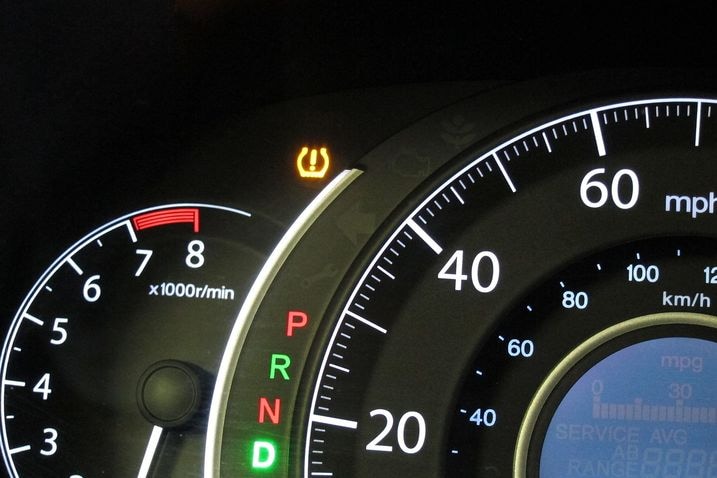
A couple weeks back the TPMS light came on while I was headed to the airport for an overseas business trip, but it winked off once the outside air temperature — and the tires — warmed up.
That was the working theory at the time, anyway.
Here's what I found when I got back.

All four tires measured 25 psi or thereabouts at an air temperature of about 75 degrees, and I made the check after rotating the tires, a job that took 15 minutes. But it takes about 30-40 minutes for a tire to cool down after being driven at speed, so the true "cold" pressure in this case is probably a half-pound or so lower than what's shown here. Let's go with 24 psi.
The CR-V's tires are supposed to be set at 30 psi, but the typical TPMS system doesn't raise the alarm until a tire is 25% below the target pressure. In this example that works out to 22.5 psi.
Sharp-eyed readers will note that 24 psi is not sufficiently low to trigger a warning. And indeed, when I drove it into the garage for this check, the TPMS light wasn't on.
But on the morning in question the car had been parked outside overnight in temperatures at least 30 degrees colder. At some point during the night, it seems possible that the tire pressure dropped below the magic 22.5 psi threshold. Then, as the sun came up and the car was driven a bit, the pressures came up and the light shut off.
There's no leak involved here — all tires ooze a little air over time and in any case we're talking about all four tires here, not just one.
But here's the weird part: the same thing happened when I was in Tonopah, Nevada last month and that time the tire pressures checked out OK at 29.5 to 30 psi. I can only surmise the gauge I used that time (different from this one — a buddy's) was inaccurate; maybe the tires were low in Nevada after all. It certainly would explain that false alarm.
The alternative is all four tires really did lose 6 to 8 psi in the ensuing 5 weeks. A pound or two I could, believe, but not that much.
No matter. Now they're back at the correct pressure and all is well. And I'm going to advise my buddy to round-file his tire pressure gauge and buy a new one.

As best I can tell, this is a new feature on the current-generation CR-V: rear doors that swing open nearly 90 degrees. I only discovered this in an empty driveway while shuffling a car seat in and out of the CR-V. Seems like you only discover these things through physical interface with the car: pushing the door open wider with your foot, thigh or butt until you realize you've either dislodged the hinges or that these doors do, in fact, open 90 degrees.
Cool feature whether you raise kids or ride bikes. At its longest point (just past the handle), the fully-opened door extends almost 38 inches from the body.

A couple of weeks back I decided to try the oil change service offered by Wally Park, a premium LAX parking garage I frequent. They're efficient, all of their parking spaces have foam pads suspended between the cars to prevent door dings (except for the cheaper rooftop and outdoor spaces) and it's generally a pleasant place to start and end a business trip.
Beyond that, the price they charge for an oil change would still be reasonable even if they didn't include the free car wash they provide as an incentive, and the convenience of having this stuff done while the car sits idle in my absence is mighty appealing. But, as has been documented here, they screwed up on the oil viscosity. I asked for 0W-20 synthetic and they put in 5W-30 synthetic. It was a somewhat deflating end to an otherwise pleasant experience.
True to their courteous nature, however, they didn't argue when I came back in to talk about a resolution. They offered to redo the oil change for free. The mechanic who did the job came out to talk with me, and he wasn't the careless noob I'd half-expected. He was well-spoken, experienced, professional and sincere.
It soon became apparent what happened. Turns out they simply didn't have 0W-20 synthetic on hand. They get their Penzzoil in tanks from a commercial supplier, and the somewhat recent industry change to a 0W-20 oil recommendation caught them out — they simply didn't have a drum of the stuff on hand. Stuck between a choice of installing the wrong oil or not doing the work, they chose the former, not wanting me to return from my trip to a job not done at all.
I'd have preferred option 3: send someone to the local Autozone for some 0W-20. After all, I was out of town for 4 days. They had time.
As we stood their talking I decided to accept their offer of a full refund rather than wait for them to go off to a local store to buy the oil while I needed. After all, Airport Marina Honda was just a few miles down the road. I'd take my money back ($43.96) and go there instead.
A half-hour later I was there in the Honda dealer's "Express Service" lane.
"How long?" I asked the service writer.
"About 45 minutes," was the reply. "No one is in front of you in the Express Service lane."
The above photo above was taken a full 70 minutes into my eventual 91-minute wait. Even the 45-minute estimate had me rolling my eyes because I knew I could DIY it in my own driveway in 15 minutes — and I don't have a lift.
In the end I paid $48.79 for a confirmed 0W-20 oil change at the dealer. And when I picked up the car I noticed they did something else that surprised me.

They refrained from simply adding 3,000 miles in a knee-jerk fashion to the oil change reminder they stuck to the windshield. Instead they acknowledged the existence of the oil life monitor and Honda's corporate CR-V oil-change interval policy. Sure, there's still some life left at 15%, but the idea is to start thinking about it, to figure out when you can fit an oil change into your routine.
For most of us that takes a little time, at which point the oil life will probably be down to the 5-to-10-percent point anyway. I'll certainly take them more seriously than I would if they'd have attempted to encourage me to needlessly change it at 3,000 miles.
Meanwhile, the Wally Park oil change convenience does trump the heck out of the dealer's 90-minute "Express Service" wait. I'll try W.P. again someday, and they're taking a good hard look at adding a tank of 0W-20 so other new-model Honda/Acura/Toyota/Subaru customers can be properly served.
Still, next time around I'll make a point of asking the mechanic if they stock the oil I need before I place my order with the valet that takes the keys and parks the car. Assuming the valet knew the answer was what got me into trouble here.
That said, this impromptu Wally Park versus dealer comparison test tells me the DIY oil change still reigns supreme if I have the time and the weather is good.

Drive a BMW X3 for a couple days and then hop into our long-term 2012 Honda CR-V, and you will notice a difference — in the available torque for merging and passing, cabin noise levels, styling and, well, pretty much everything. And no wonder, given that it costs over $20K more, the Bimmer crossover had better offer some advantages over the $30,000 Honda.
But for the local highway conditions peculiar to Southern California (which is a peculiar place by anyone's measure), I find the supension calibration and tire package on the 2012 CR-V more agreeable.
Whereas our Sport Activity package-equipped X3 feels busy, and almost frenetic, as its short-sidewalled 245/45R19 (102V) all-season, run-flat Goodyear tires attempt to pound the 405 freeway into submission, the CR-V is relaxed and better at absorbing the grooves and expansion joints on this silly but iconic commuter route. Of course, with the big sidewalls on the Honda's 225/65R17 go-flat Bridgestone Duelers, you'd expect that.
You'd also expect the CR-V to concede every handling and braking test to the X3, and indeed it does — the Bimmer slaloms at 64.4 mph, the Honda at 60.7. The X3 manages 0.80g on the skidpad versus 0.76g for the CR-V.
Braking is maybe the most interesting comparison, as both end up in the 120s — which is maybe a little better than you'd expect of a Honda and a little worse than you'd expect of a BMW. CR-V: 129 feet. X3: 123 feet.
Returning to my freeway commentary, though, there's no denying the CR-V is louder than the X3. Even with its quieter tires, there's more road noise coming into the cabin, plus some significant wind noise, too. I still think it's better than previous CR-Vs, but is it good enough for a crossover SUV priced around 30 grand?
Well, I'm driving the long-term CR-V to Phoenix next week, so I'll have ample opportunity to consider that.

It's amazing how badly you can screw up the interface for a dual-zone automatic climate control system. The advent of touchscreens-for-all seems to be making it worse.
But Honda doesn't overcomplicate it in the 2012 CR-V. There are two, large well-damped dials for adjusting the temperature and both are in easy reach of the driver and front passenger. Buttons are clearly labeled, and in most lighting conditions, the digital display is easy to read. Plus, the whole setup is compact and easily packaged at the bottom of the center stack.
About the only improvement I could ever see myself wanting is a third dial for fan speed adjustment, but that might mess up the visual symmetry and package-ability of this not-unattractive function-first design. Also, I'm not demanding about cooling or heating (I rarely use Max A/C in cars that have it) and I'll usually just fiddle with the temperature to get the fan intensity I want.
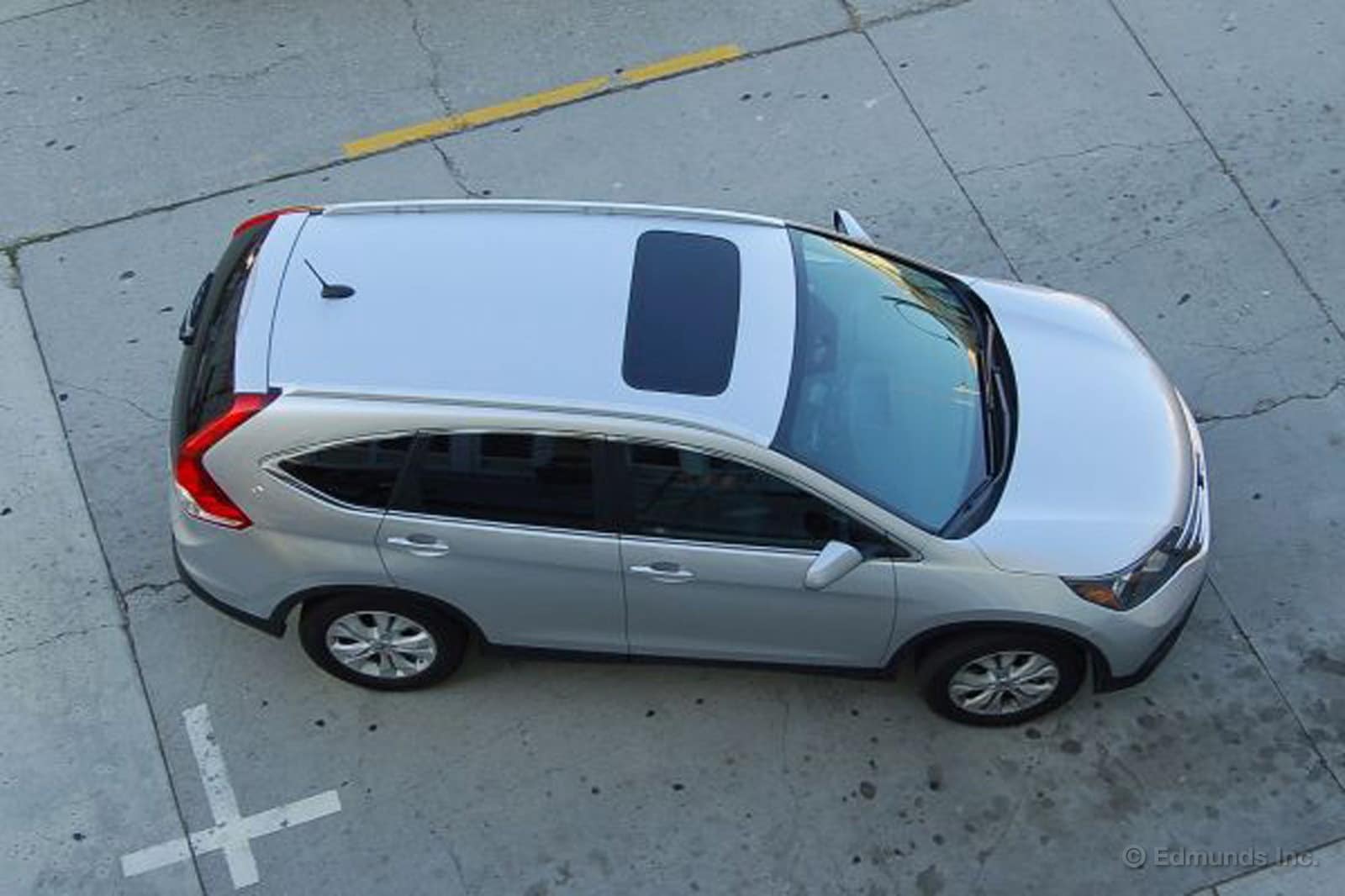
It's time once again for my family's annual holiday road trip up the California coast to Oregon, and this time we're taking the 2012 Honda CR-V. Thing is, cargo space is going to be at a premium, what with all the presents and all.
So I'm thinking about installing a roof pod. Or at least I was until I saw what it costs to rig one up.
Our CR-V is an EX-L, which is a good start because one of the many things you get when you step up from EX to EX-L is a pair of aluminum roof rails that run from front to back above the doors. They're a good foundation and they can support 165 pounds. If you have an LX or EX you can fork over $491 to get the same bits from a Honda dealer's parts department as an accessory. Those who aren't into the whole DIY thing will pay still more for installation.
In all cases the all-important cross rails your gear is meant to attach to aren't part of the deal. Honda wants another $791 for a pair of those. Ouch. This may be a job for the aftermarket.
Yakima sells square cross bars and fittings that mate with our CR-V's factory roof rails for $315, and Thule sells a similar square pair for $365. Thule also offers another option with more aerodynamic cross bars for $425.
Why such a difference? Factory accessories need to generate profit for three entities, not two. And then there's the matter of reputation and development time. Honda has more at stake in terms of how their "Honda Genuine" cross rails affect things like wind noise, fuel economy and the related customer satisfaction quality scores. In their case it's more of a low-volume tailor-made situation with fully rounded corners and smooth surfaces as opposed to a set of adaptors that mate with overhanging universal cross rails shared across an entire product line.
And here's the punch line: The above expenses come before we start talking about the $450 to $600 they get for a cargo box that sits on top. It adds up fast.
At this point it looks like we're going to have to pack more conservatively and send some of our gifts up north with the grandparents in their car. We'll manage … probably.
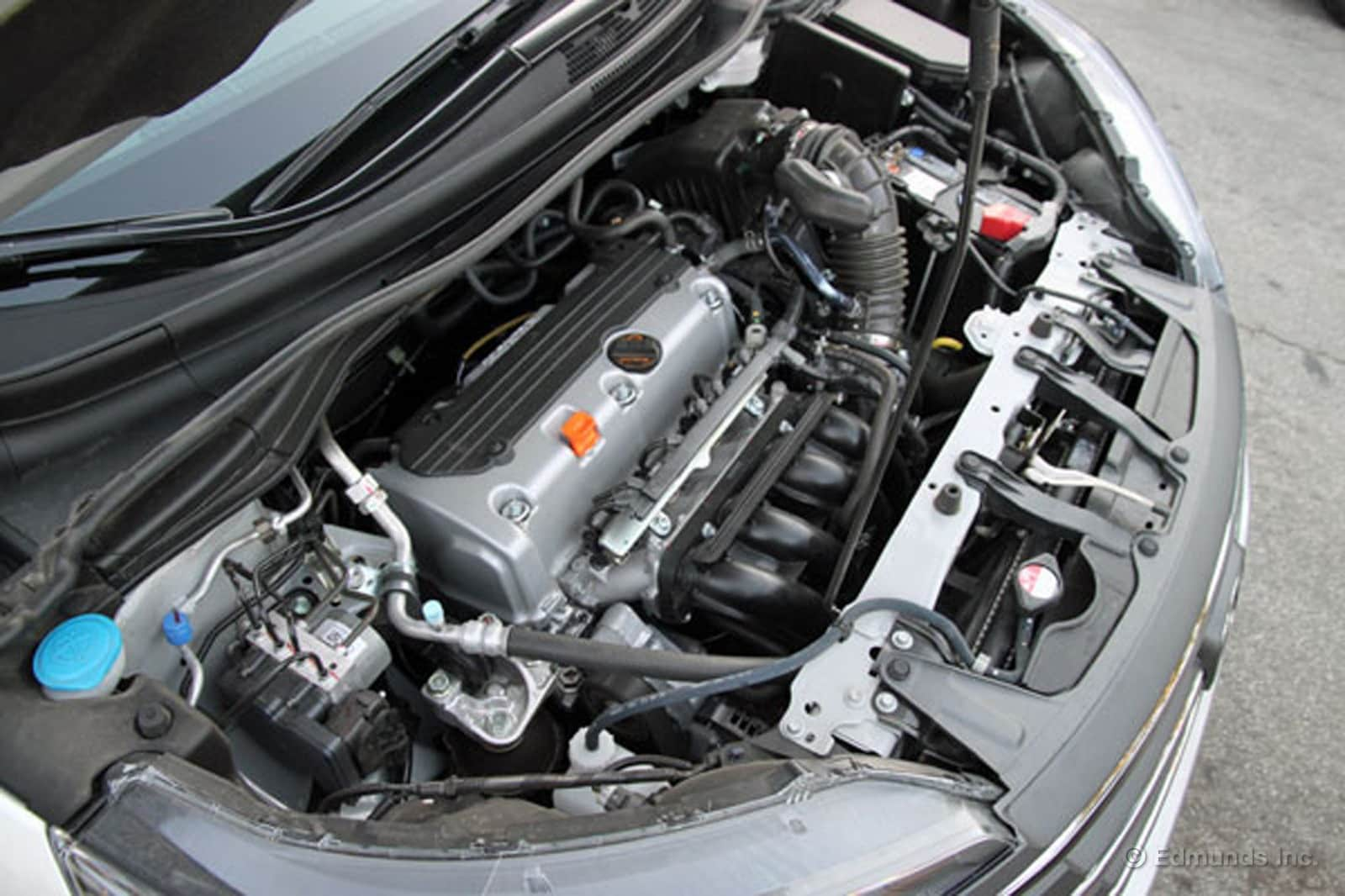
Am I surprised that our CR-V isn't the fastest vehicle in the fleet? Hardly. Its normally aspirated four-cylinder can only do so much. What does impress me is how smoothly it works in nearly every situation.
Whether it's winding up near its redline or just cruising along on the highway, the CR-V's 2.4-liter engine always delivers refined power. It runs out of juice pretty quickly on the highway, but the quick-shifting automatic does a good job of grabbing another gear when it's required. At slower speeds the shifts are a little less predictable, so it's not perfect.
Overall, it's a solid setup that matches the personality of this SUV. In other words, it's a typical Honda.
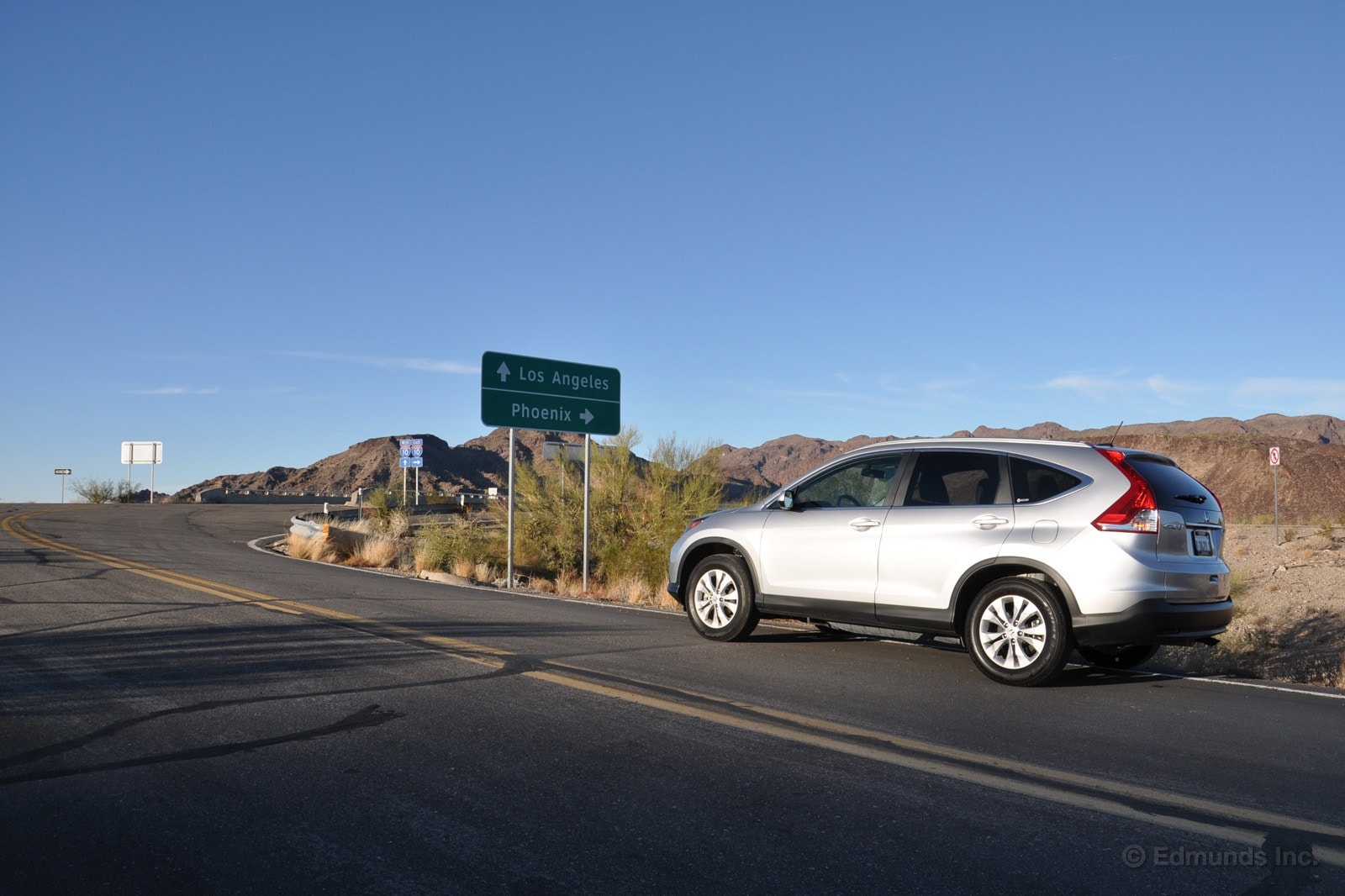
I took a quick 800-mile trip to Arizona in our long-term 2012 Honda CR-V last week. My destination was Scottsdale and while there I would drive the revamped 2013 Toyota RAV4, so it made sense to get some context by spending some time with the RAV4's chief rival, which also happens to be the best-selling SUV in the U.S.
You already know I'm a fan of the CR-V's cabin, which is unspectacular at a glance but somehow manages to check all the boxes anyway. There's a lot of space in here, the visibility is excellent, and I love all the storage compartments that surround the cockpit. For me, the CR-V still has a big advantage over the RAV4 in storage areas, and overall, I prefer its more conservative cabin design.
On the open road, more noise intrudes into the cabin than I'd like. Most of it is road noise from the tires, but there's a fair amount of wind noise that comes in off the large side mirrors... I don't necessarily want to give them up, because I like seeing traffic to my left and right, but the noise is there. Also, there are mountains between here and Scottsdale, and the ordinarily adequate 2.4-liter engine has to work pretty hard on uphill grades. And when the engine is working, the cabin vibe is not so relaxed. Is the RAV4 significantly more serene on the highway? Well, in Arizona it was, but until we drive one here in Southern California, I'll reserve judgment.
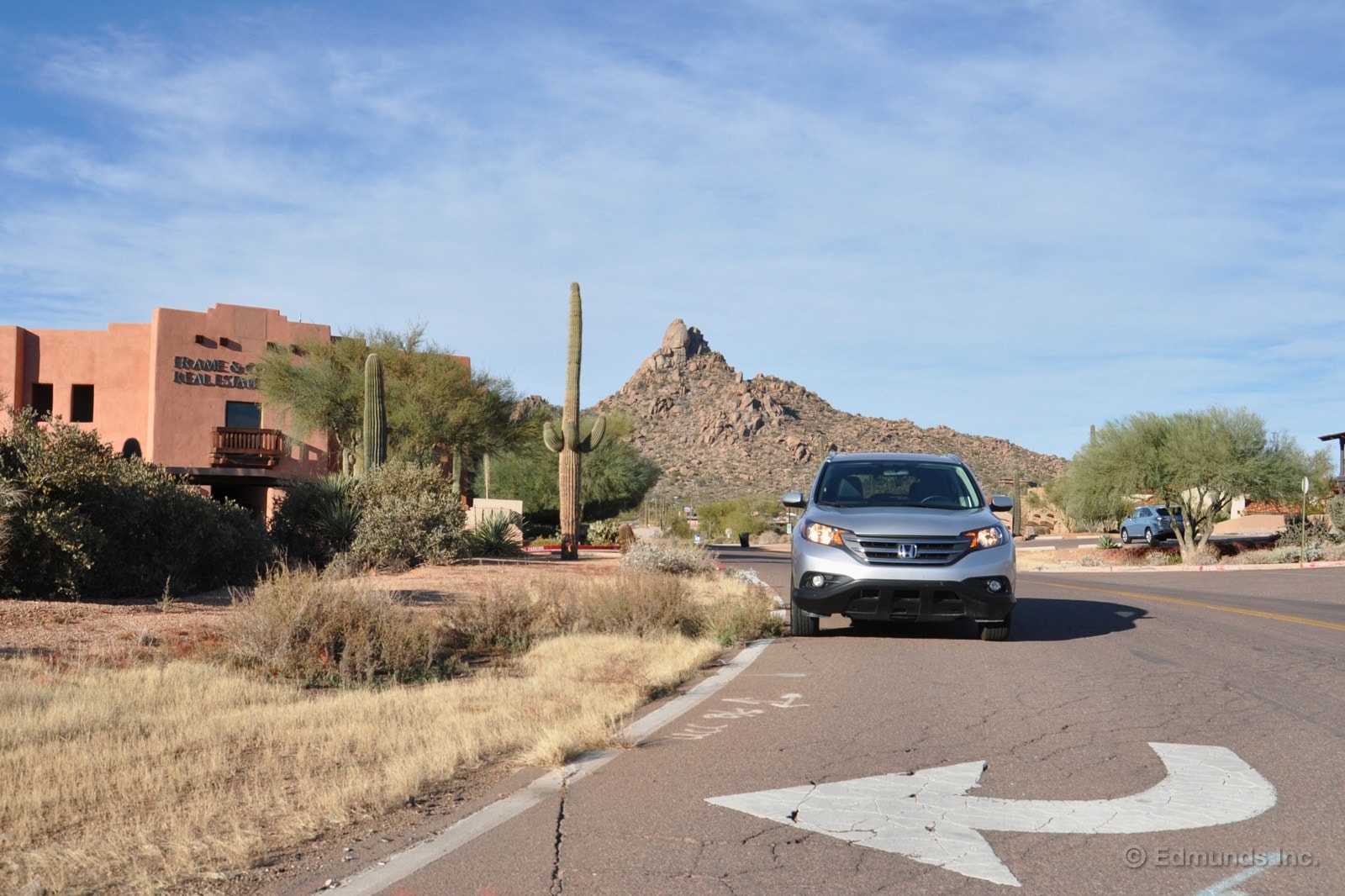
The Honda's five-speed automatic transmission shifts smoothly through it all, but I can't deny that I prefer the six-speed automatic you'll be able to get in the RAV4. That transmission has one more overdrive gear to keep things quiet on the highway, but more importantly, it has a Sport mode that gives you quicker downshift. Of course, as I noted in that story, the RAV4 has the same 25 mpg combined rating as our all-wheel-drive CR-V, so no advantage there — at least not until we do some fuel economy testing.
Apart from wanting a bit more power and maybe another gear, I enjoyed my travels, though, but then, I always enjoy road trips. Still, the Honda CR-V goes down the highway well. It's stable, and I never felt like I was fidgeting with the steering to keep it pointed straight ahead. The ride is comfortable, too, and just about ideal for a crossover SUV — I can't imagine anyone complaining that it's too firm.
I'll share fuel economy numbers and a few more thoughts in my next installment.
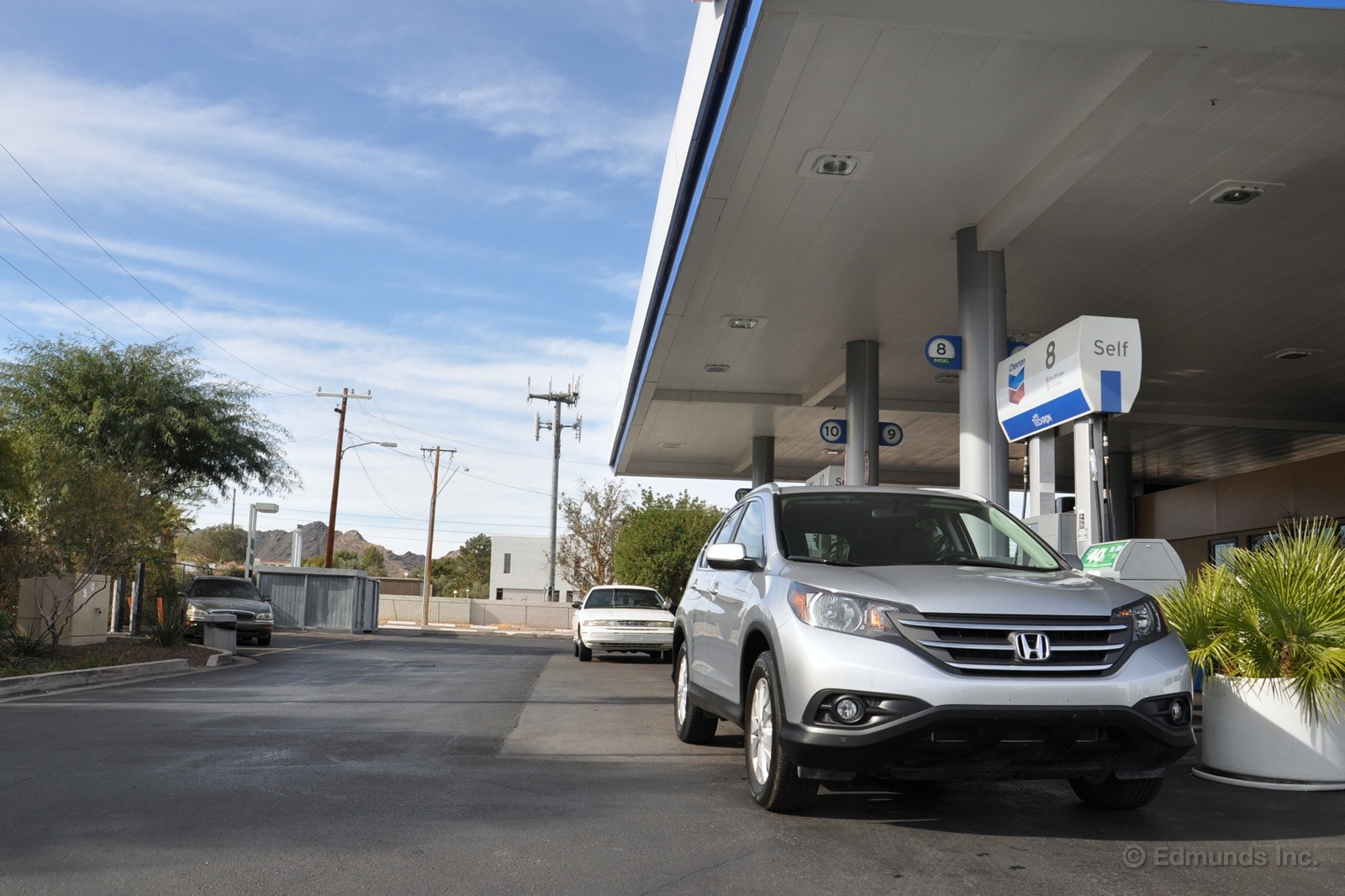
My road trip to Arizona saw our long-term 2012 Honda CR-V amass over 900 miles, nearly all highway, and maybe three percent of them in heavy traffic (a welcome home gift from Southern California).
So I knew my fuel economy was going to be good. But I didn't think it would be outstanding, because once you're past Palm Springs, the speed limit goes up to 70 mph on California's Interstate 10. And not long after you cross into Arizona, it goes up to 75 mph and doesn't drop back until you're pretty much on top of Phoenix. I didn't have time for a serious fuel economy run, so I stayed with the flow, passed the trucks when I had the opportunity and didn't go especially easy on the 2.4-liter four-cylinder engine.
So I was pretty stoked when I crunched the numbers: The CR-V averaged 27.9 mpg over 919 miles. I got 27 mpg on the outbound leg, but aided by some downhill grades, managed 29 mpg on the trip back. Given that the all-wheel-drive CR-V is rated 22 city/30 highway/25 combined by the EPA, I count my results as pretty impressive. I could own this vehicle and drive it in my usual manner without getting terrible mpg.

A fortuitous thing happened after my last post, in which I fretted over our the growing mound of presents our 2012 Honda CR-V would have to haul some 900 miles north, along with four passengers and their luggage.
I managed to get my hands on a set of Honda Genuine crossbars to try out, along with a rooftop cargo box. Among other things, it will be interesting to see how fuel consumption compares to the nearly identical naked-roof run I made to the same area in this car last summer.
But I have to install the stuff before any of that can happen. Today I'm tackling the crossbars, an accessory that mounts to the longitudinal aluminum roof rails that came standard on our CR-V EX-L. Those of you with an LX or EX won't have the aluminum roof rails, but they're available as an accessory, too.
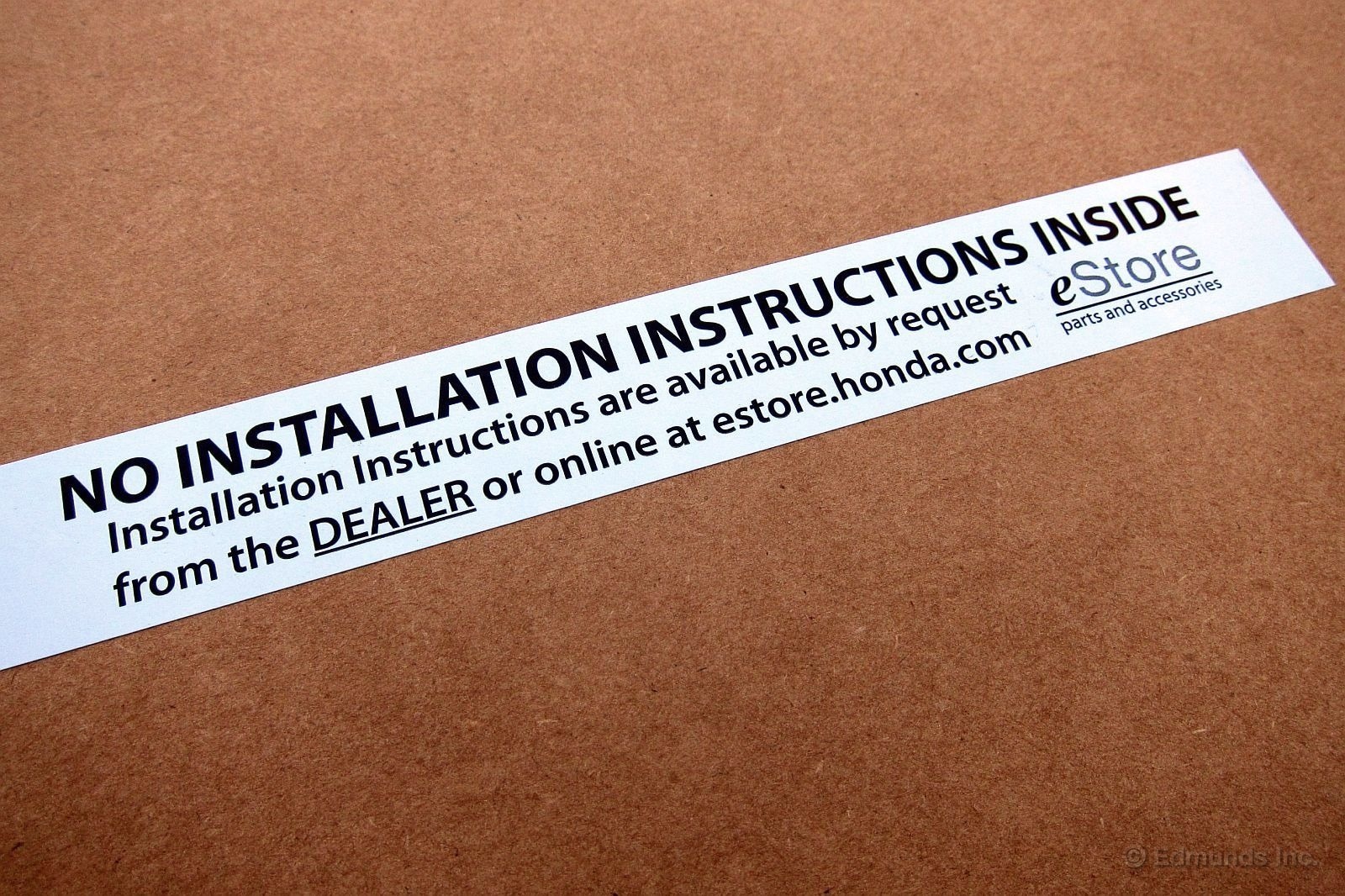
A sticker on the box warns there are no instructions inside. But how hard can this be? There's only one way to find out.
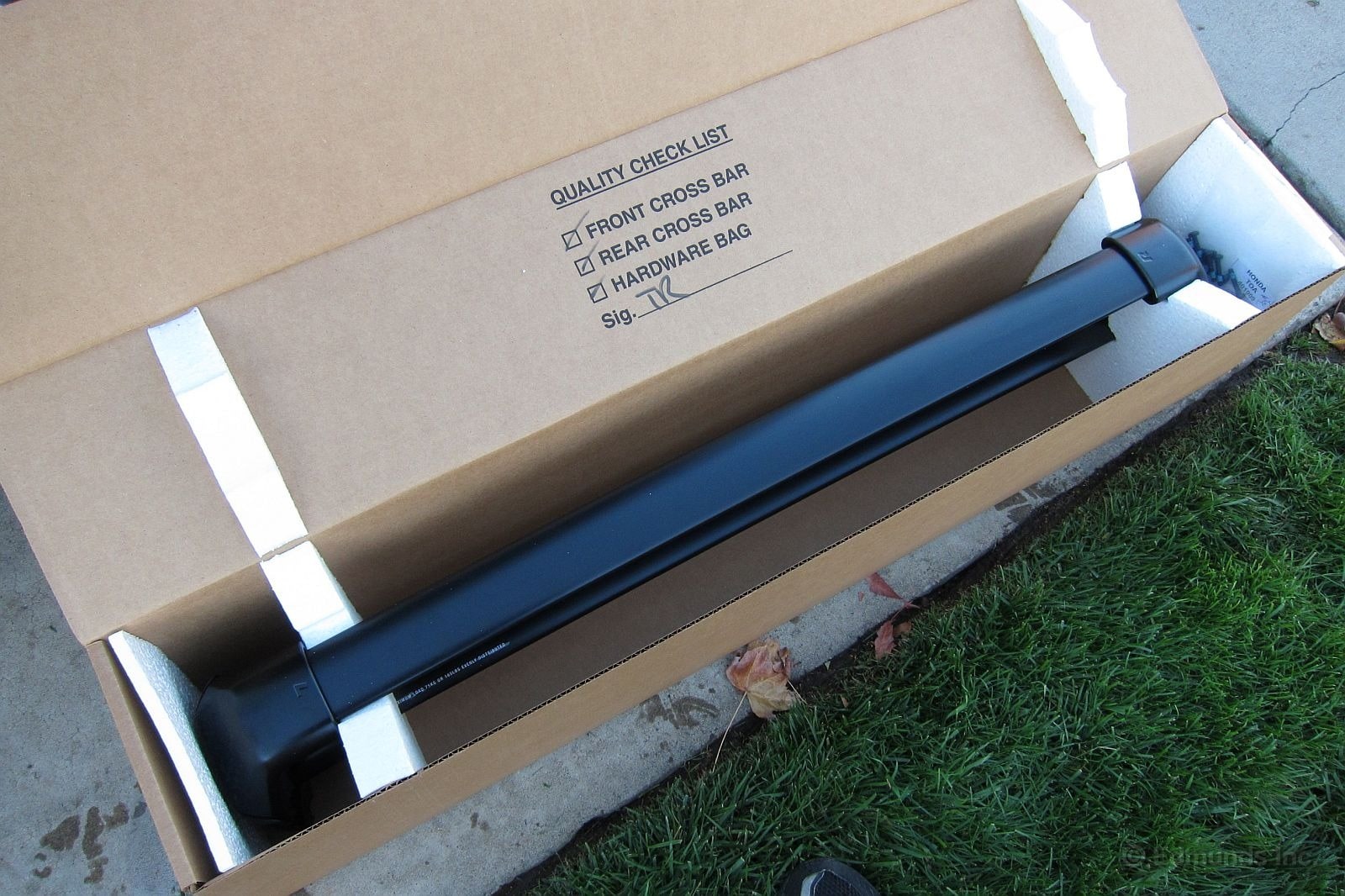
It's looking good. The crossbars come fully assembled. It looks like this is going to be a simple matter of installing 8 bolts.
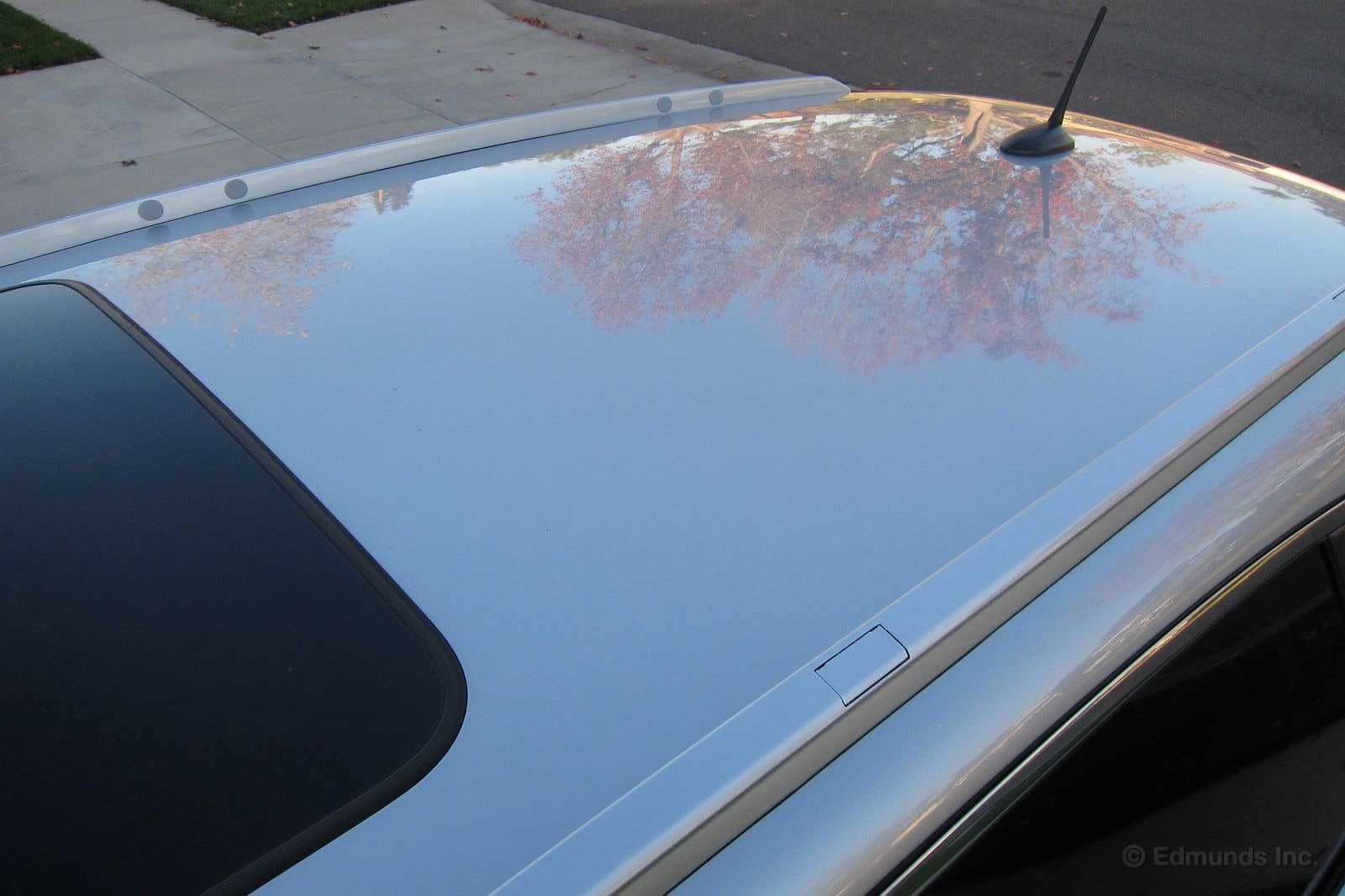
More good news up here. Four pairs of rubber plugs positioned along the inside flange of the roof rails show where they need to go.
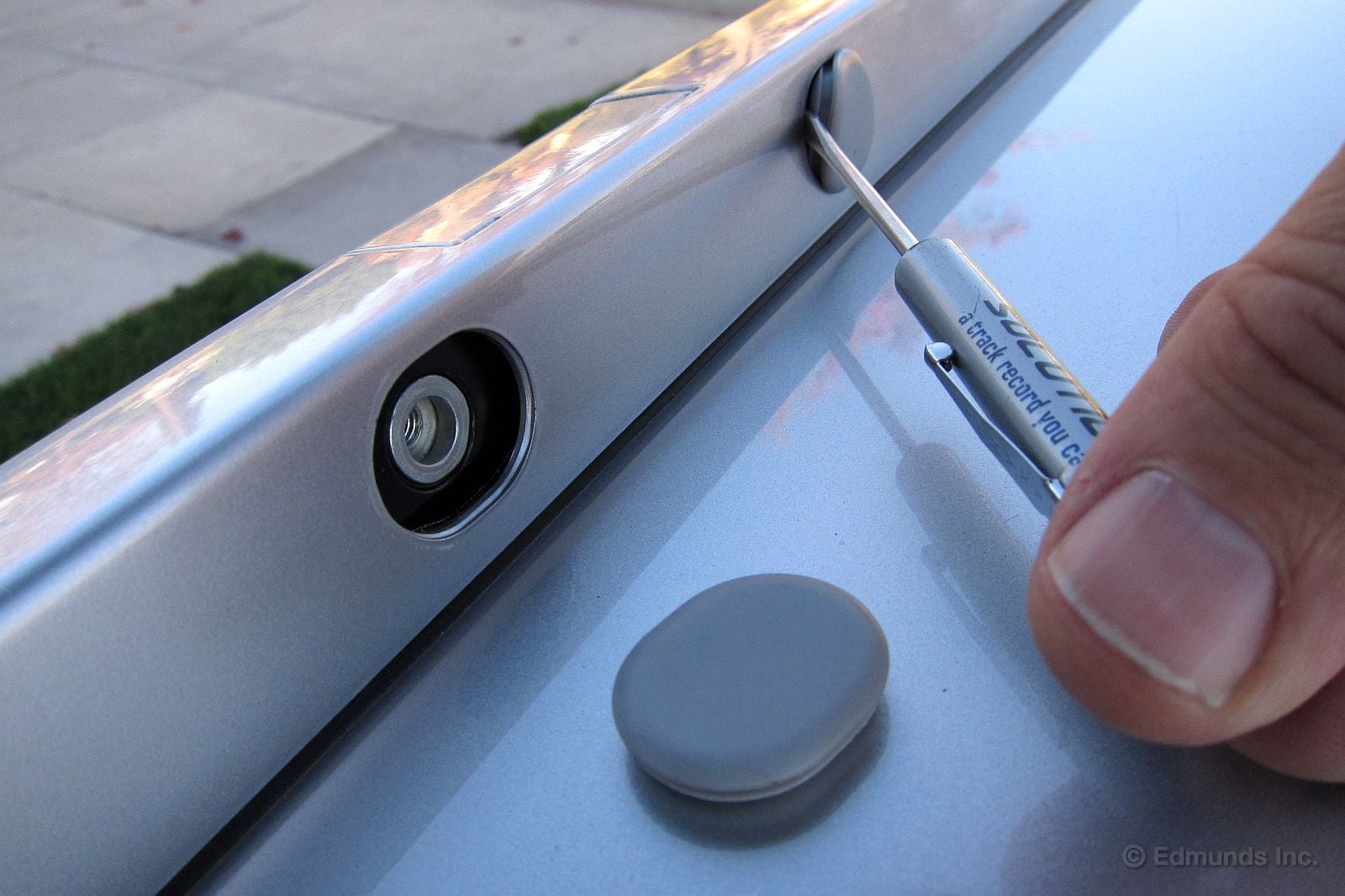
Open doors provide a handy step to get the height necessary for easy access. After that the caps come off in seconds with a small thin-blade screwdriver, revealing the threaded holes the kit's bolts will twirl into.
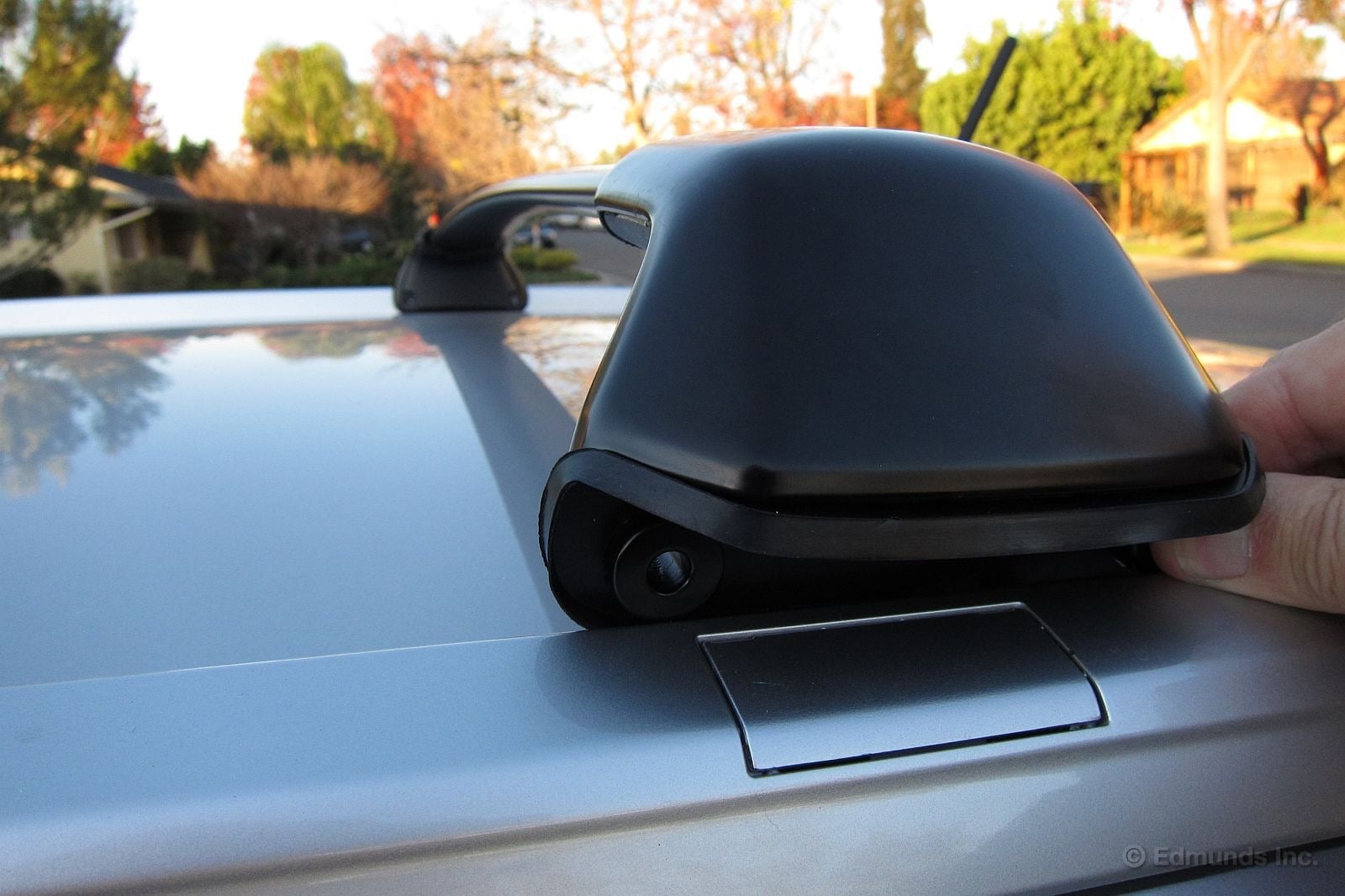
The crossbars are labeled left and right, front and rear, so it's easy to figure out where they go. Set the far side in place first, then press in on the near side and compress the gaskets until it slots into position.

The bolts have a Torx head, and it takes a T-30 bit to engage them. You can get one at any auto parts store or home improvement megaplex. I'm using a socket-style that snaps onto my ratchet, but T-30 Torx bits come in many forms.
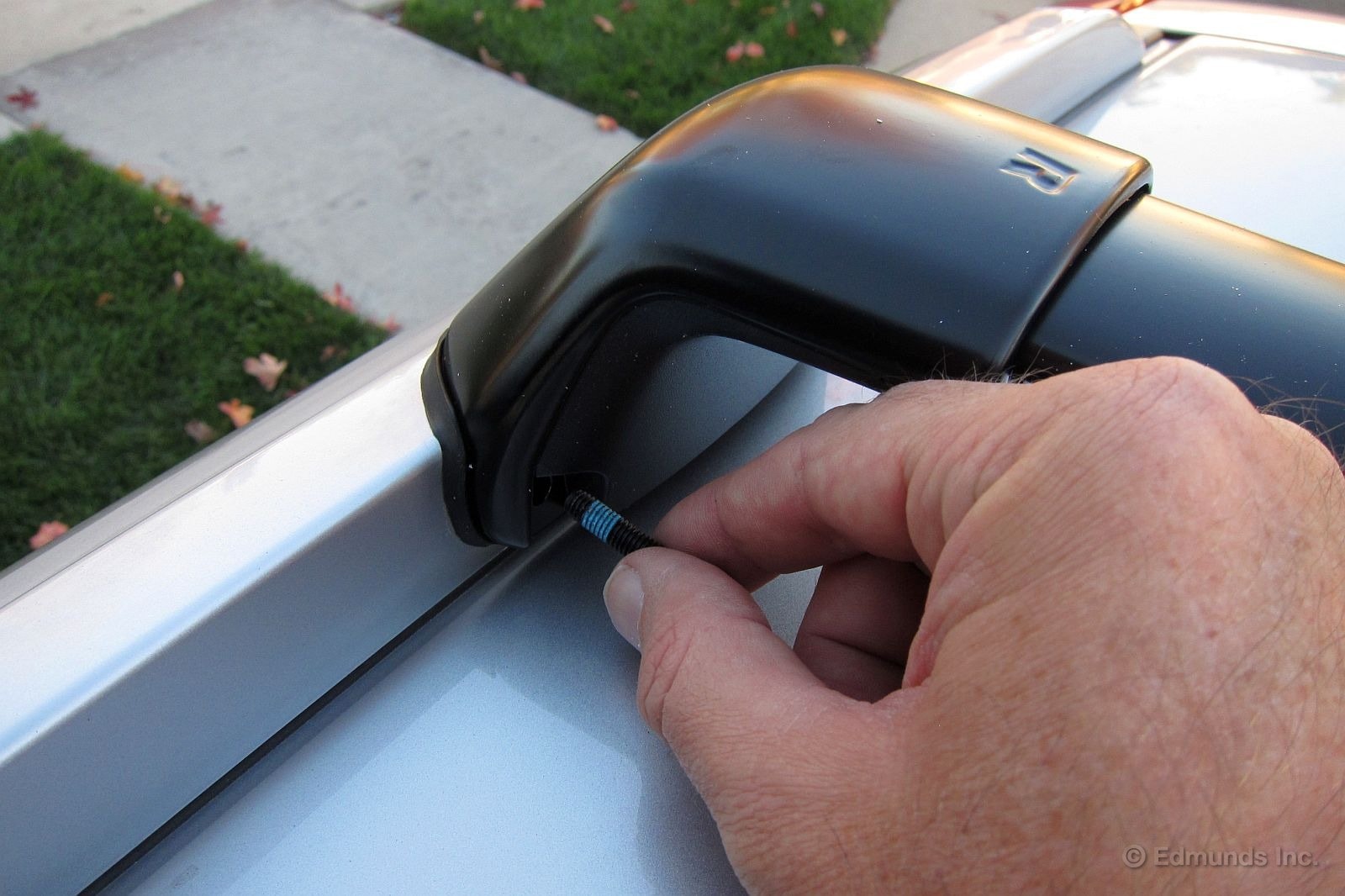
This part is pretty straightforward, especially since the bolts come with blue thread lock compound already applied.
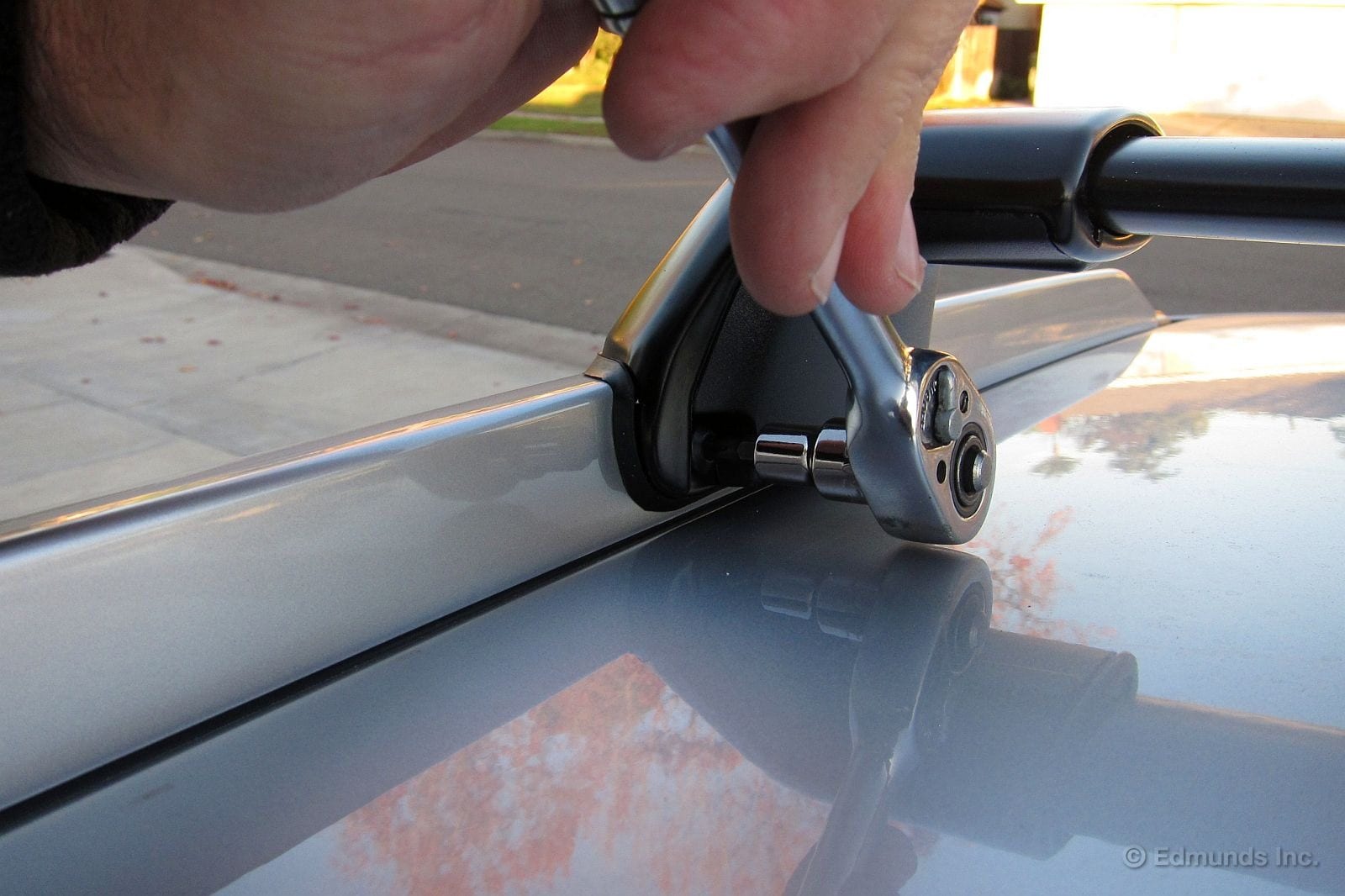
Tighten the bolts until everything is fully seated and tight, but there's no need to overdo it. In my case it looked at first like the front crossbar was too short, but the assembly telescoped easily as I tightened the bolts and it all mated up properly.
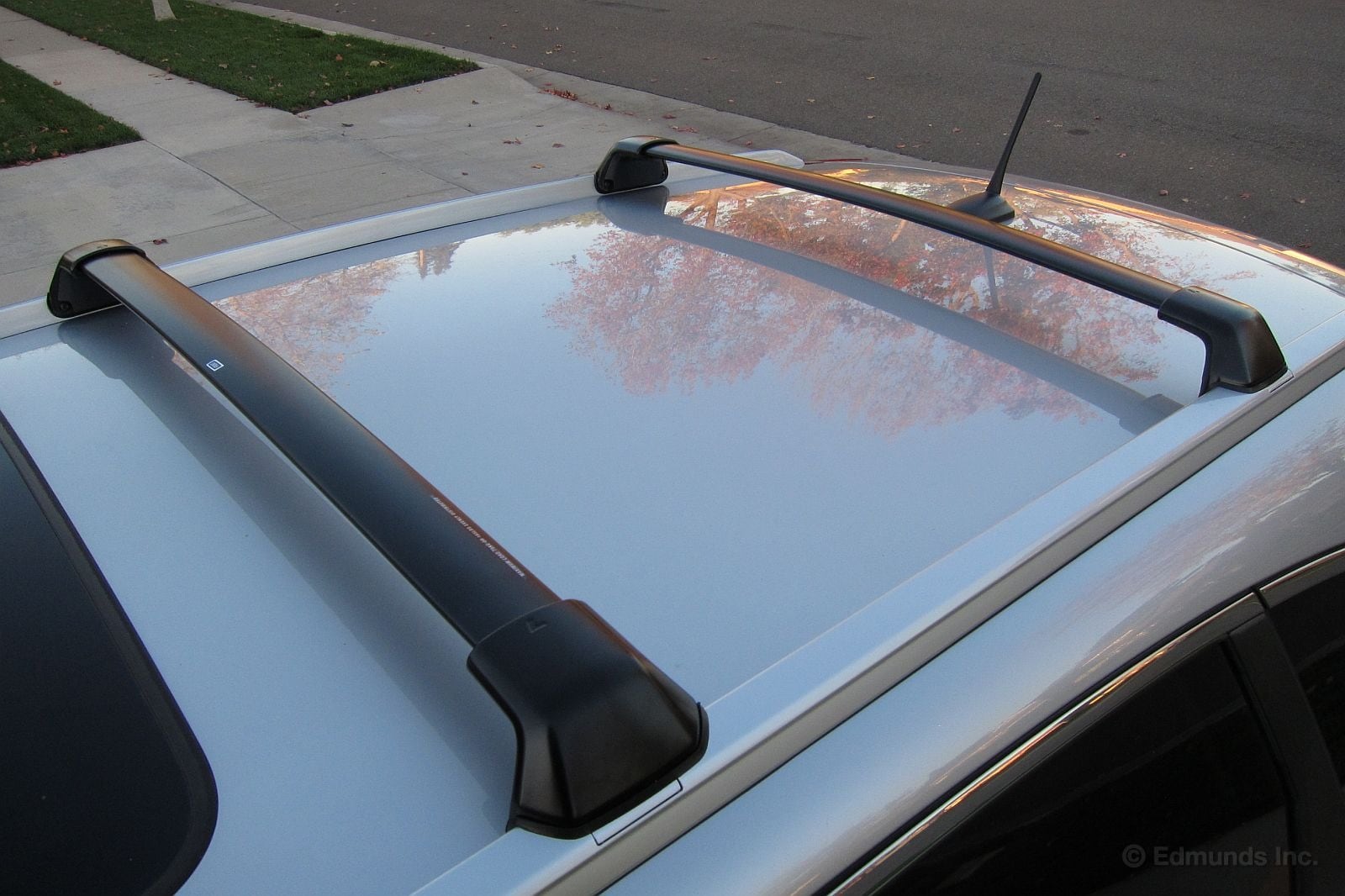
This was easy. We're done after no more than 15 minutes. There isn't much reason to pay a dealer to do this job if you have basic mechanical skills and can get your hands on a T-30 Torx wrench or screwdriver bit.
Honda offers a whole range of attachments that fit these crossbars that accommodate skis, snowboards, surfboards, kayaks, bicycles and the enclosed cargo box I'm going to mount.
At some future date we'll compare these crossbars to a similar aftermarket product, but for now I'm going to mount the box, load it up with stuff and head north.
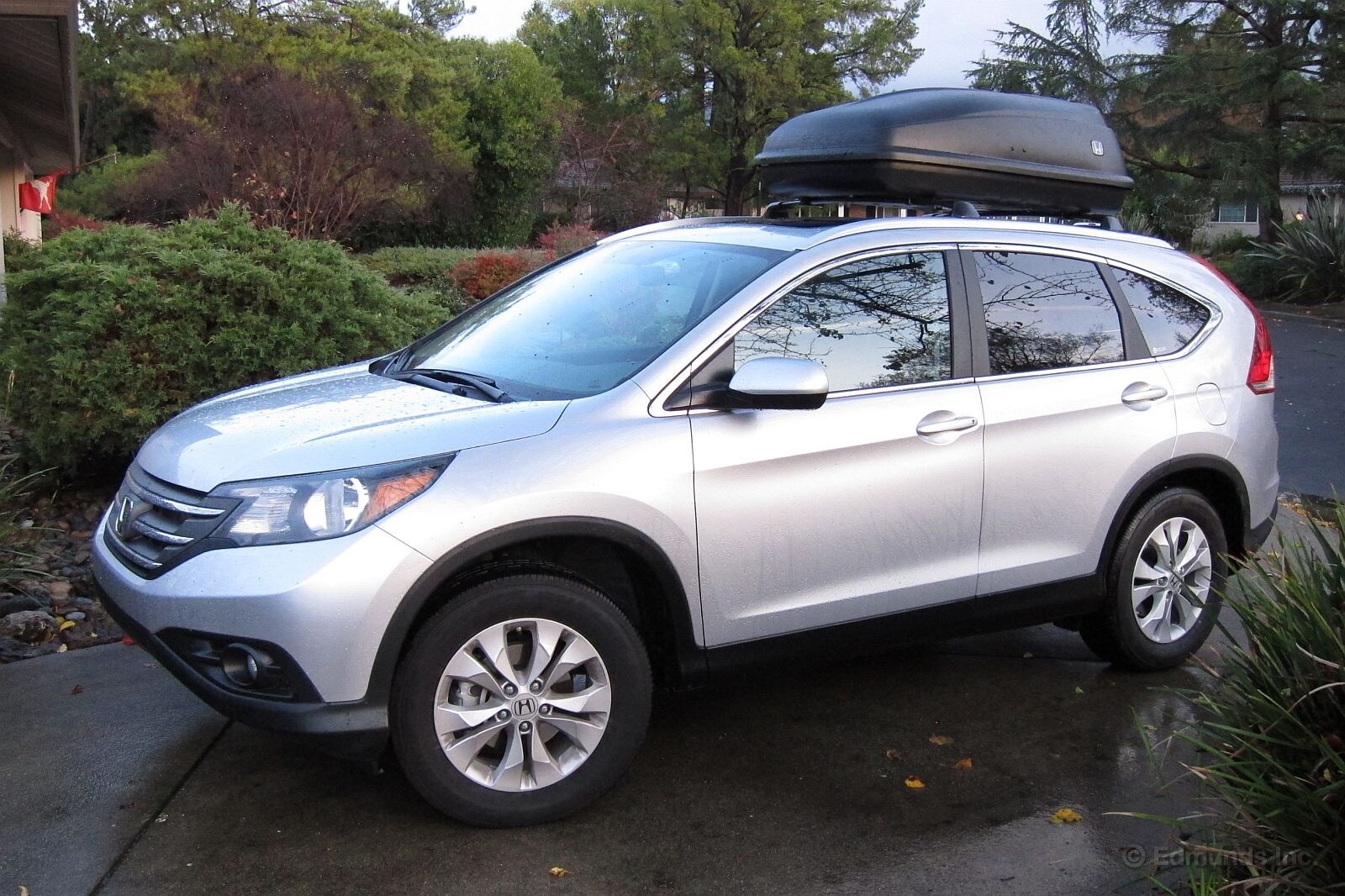
It our last episode we installed Honda's accessory crossbars onto the roof of our long-term 2012 Honda CR-V, a move that opens the door to a whole range of Honda Genuine rooftop accessories. One of them is a 13-cubic foot rooftop cargo box, which your local Honda dealer will sell you for $499, a price that's fairly competitive when compared to similar aftermarket products.
Wherever you get yours, a roof pod is the kind of thing you want to be able to install and remove yourself, because driving around with one on your roof when you don't actually need it isn't a great plan. For one, there's the obvious and potentially damaging loss of overhead clearance in your typical garage or parking structure, but you can also expect a drop in fuel economy on account of the additional frontal area and aerodynamic drag the pod represents, whether it's loaded or not.
As you read this we're measuring the scale of the fuel economy loss during our annual 2,000-mile holiday trip to Oregon and back. What follows is a short description of how the installation went down before we left.

The box the roof pod comes in fits inside the CR-V itself, which is not something you can say about some aftermarket roof pods, which come in a confusing array of sizes. I suppose this test represents a good rule of thumb: if it's too long for the cargo space, it's probably too long for the roof, although I suspect skiers will take issue with this.
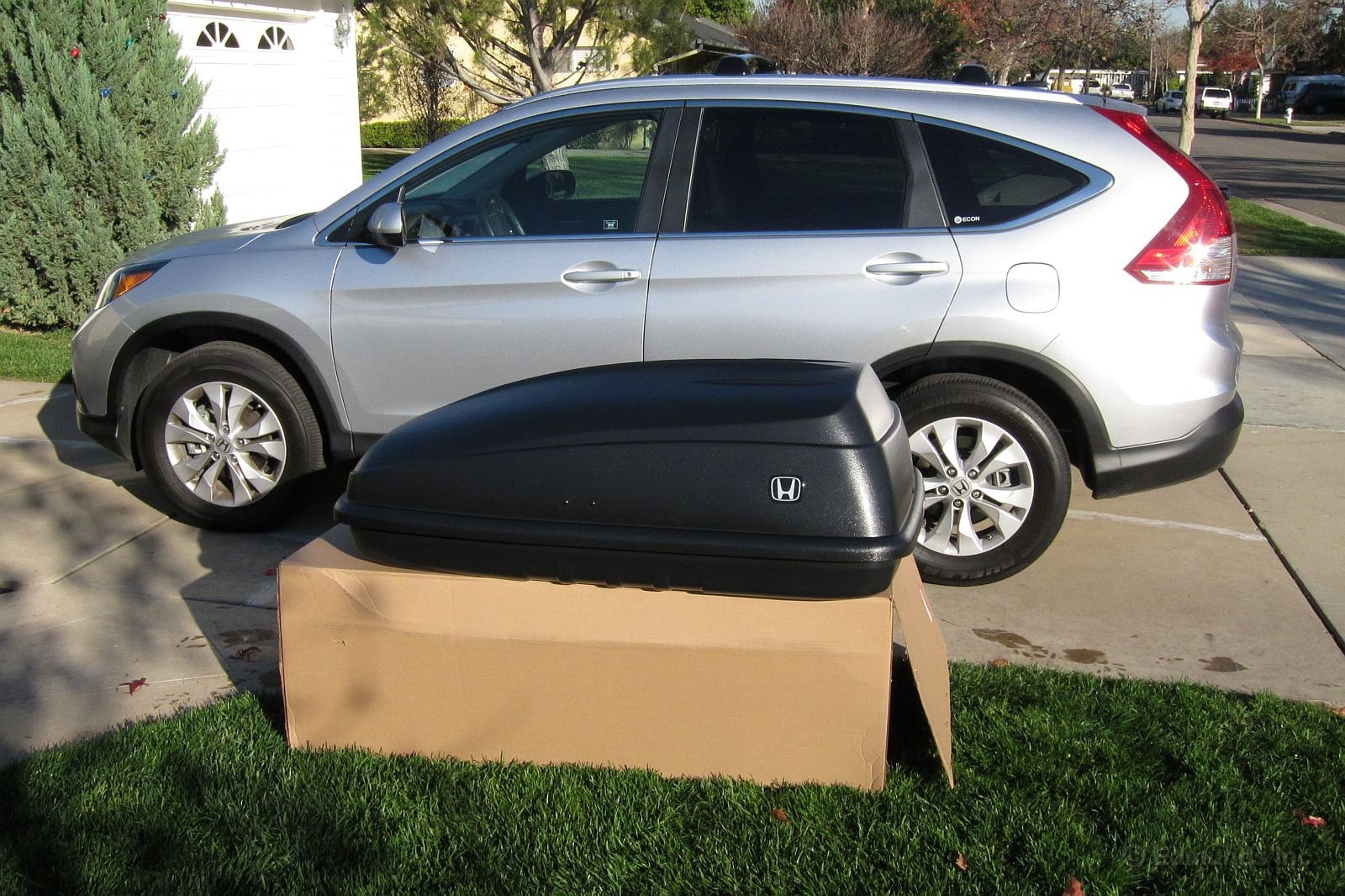
The fully-assembled box is ready to go right out of the box, but there is the small issue of mounting hardware, which is in a bag inside.

There's a lot of stuff in the mounting hardware bag, but almost all of it will only be installed this first time. Subsequent removals and reinstallations of the cargo box require far less work and time.
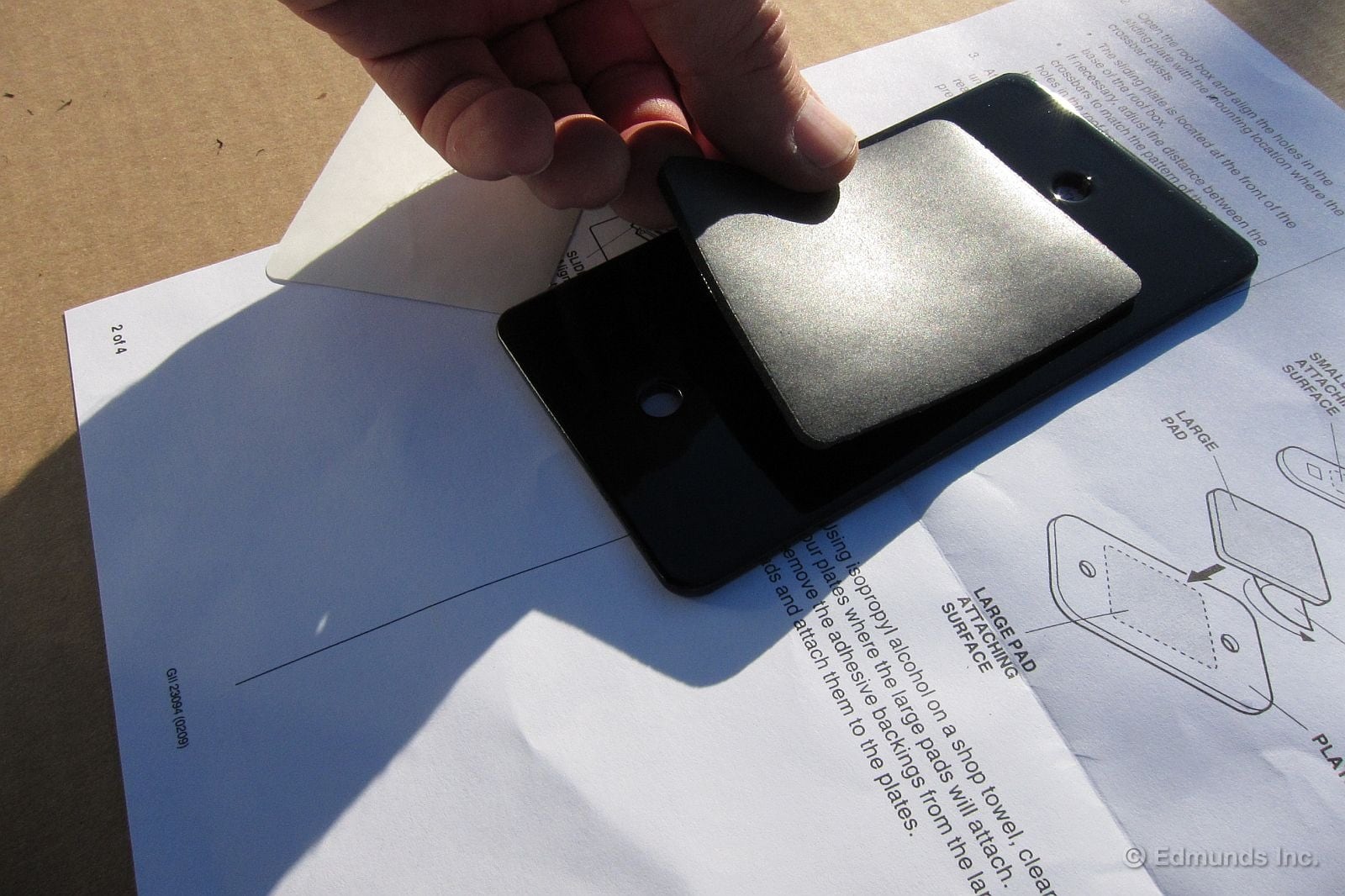
The first order of business involves peeling the adhesive backing from foam pads and sticking it to metal plates.
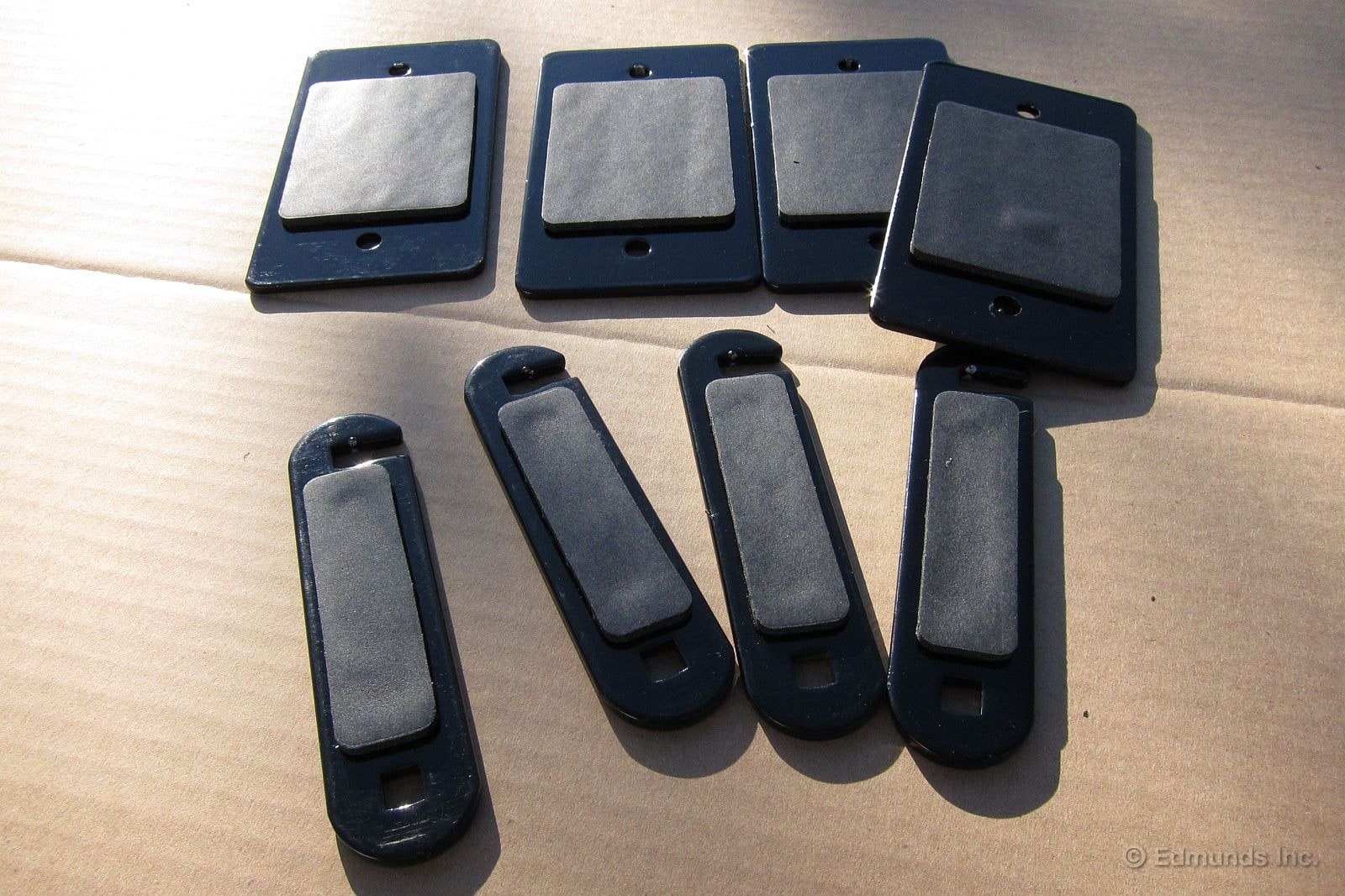
There are eight pads in all.
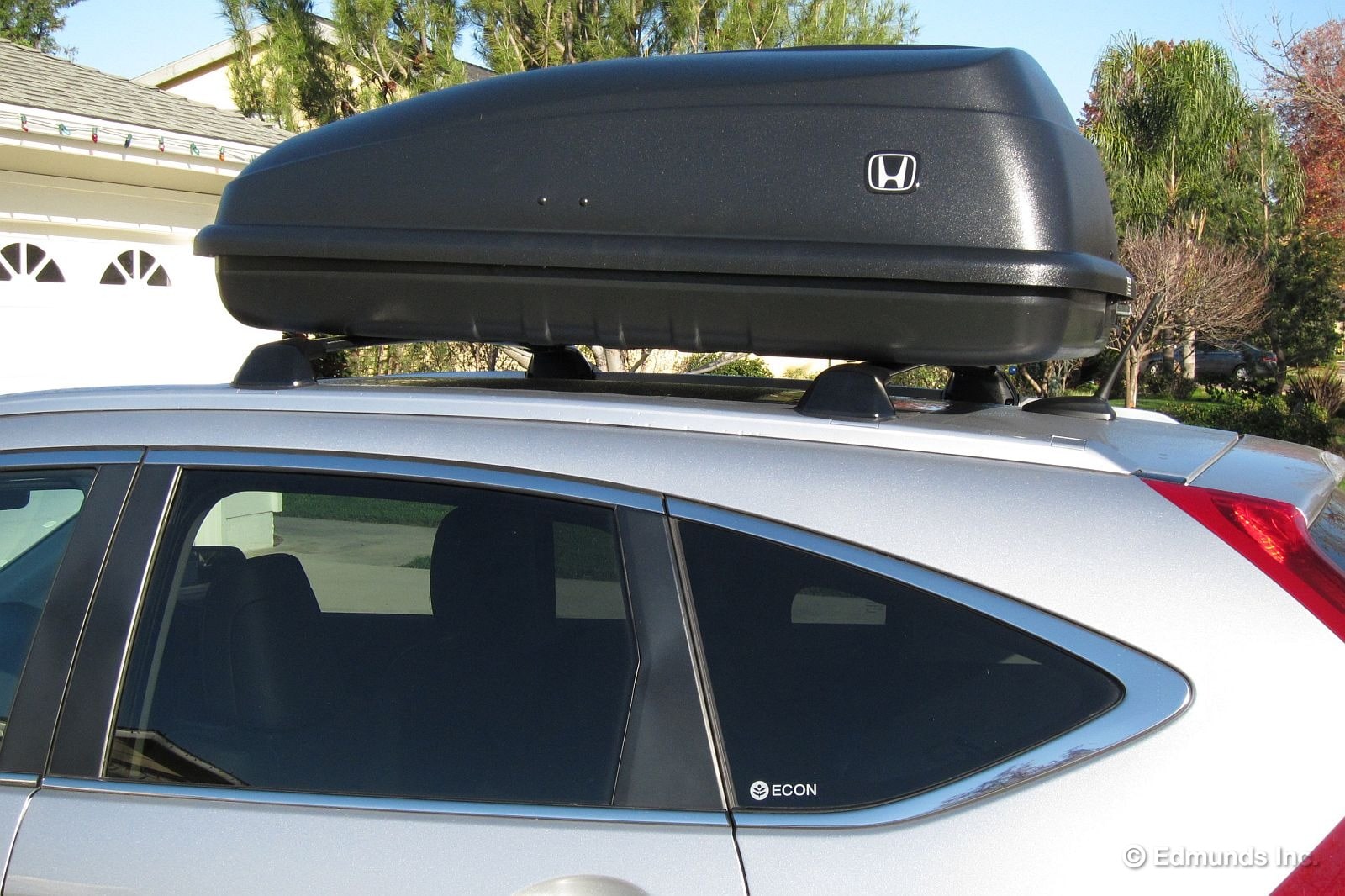
Now it's time to set the box on the crossbars. A second pair of hands can be of help, but it weighs less than 30 pounds. One person can do it, but you may find it a little awkward.
It's important to place the box just forward of the CR-V's centrally-mounted roof antenna. Honda's factory accessory development team takes this into consideration, but you've got to be a bit careful if you're shopping for a longer aftermarket box because you can't let it extend any farther back than this one because of that antenna.

At this point we've opened the cargo box so we can see the mounting holes from the inside. There are two pairs of available holes (the span of the holes in the plates we prepared before makes it necessary to skip one) and the relative position of the back edge of the box and the CR-V's roof antenna makes it necessary to use the rearmost pair.
The two chosen holes straddle the crossbar, which is why the unused hole between the pair we've chosen appears blocked. The kit comes with stickers to cover the two unused holes so moisture doesn't come in through the openings. There are more than enough of these stickers, so I put one on the inside and another on the outside.
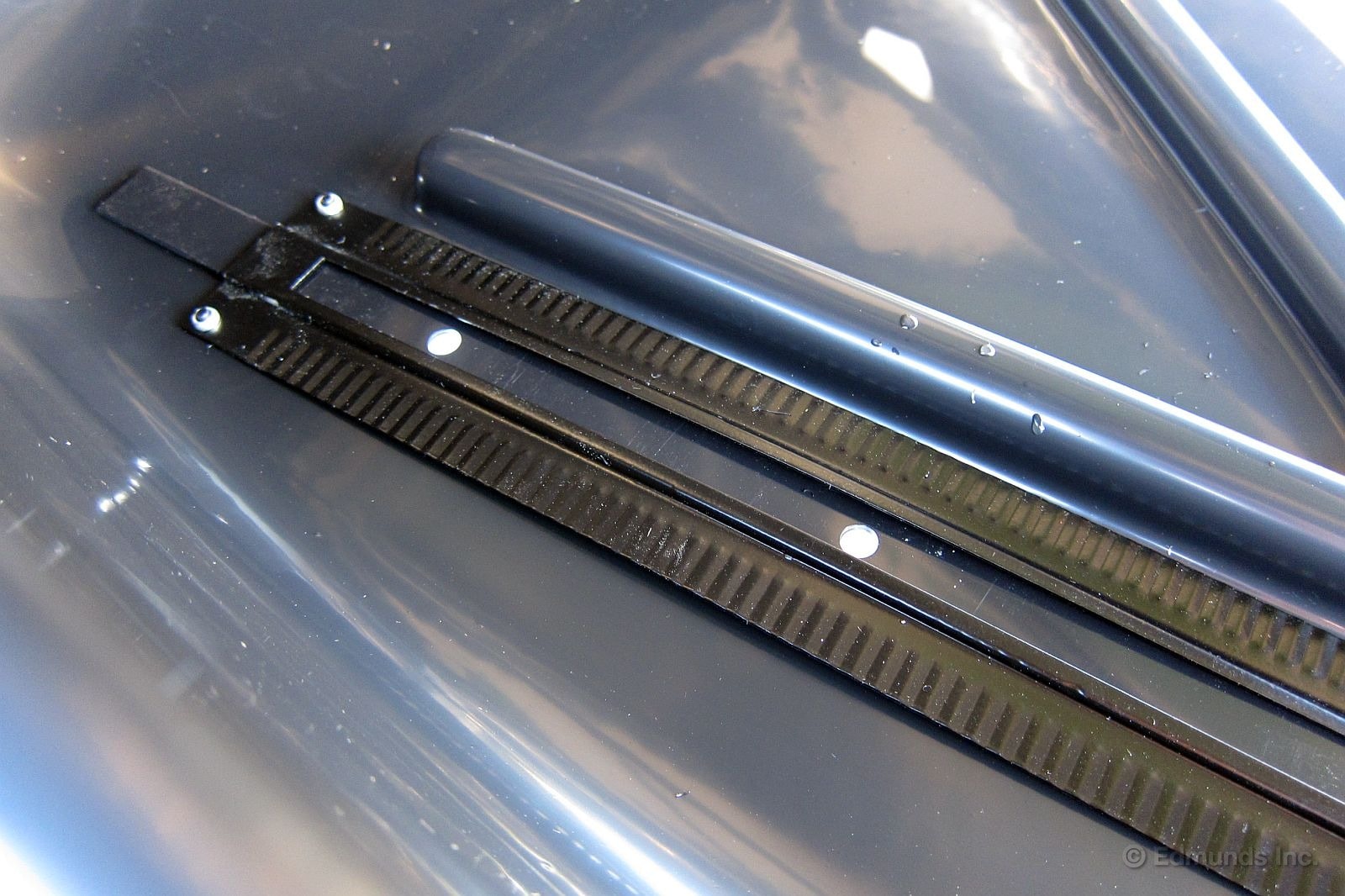
The single pair of holes at the front end are part of a sliding assembly that adjusts to suit once the rear crossbars holes have been selected.
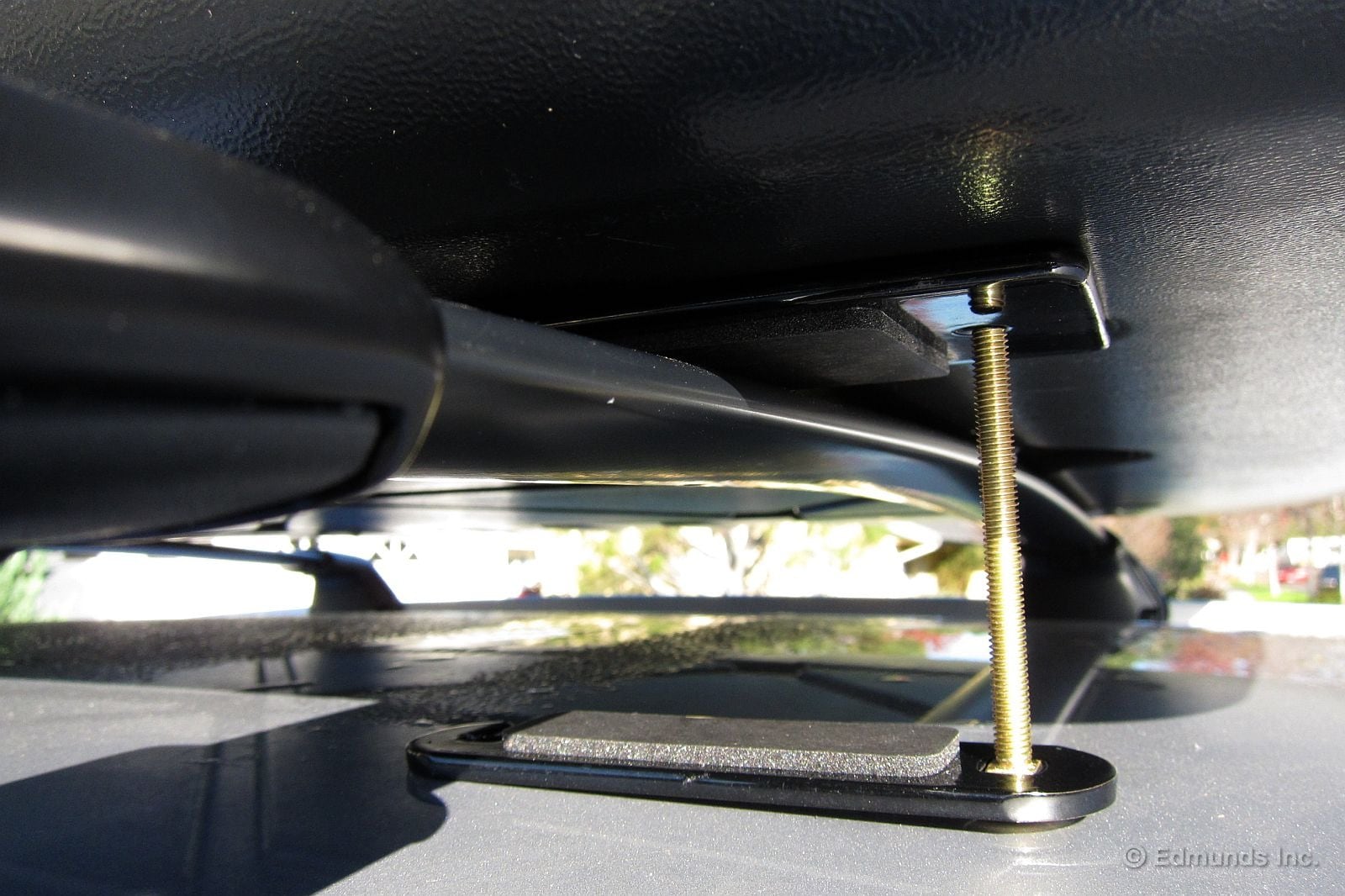
With the box in place and the holes roughly lined up we can now install the clamps and bolts. First we lift up the box just enough to slide the large metal pad above the crossbar, foam side down. The smaller plate goes below, foam side up, and we skewer them both with a stove-head bolt that comes up from the bottom.
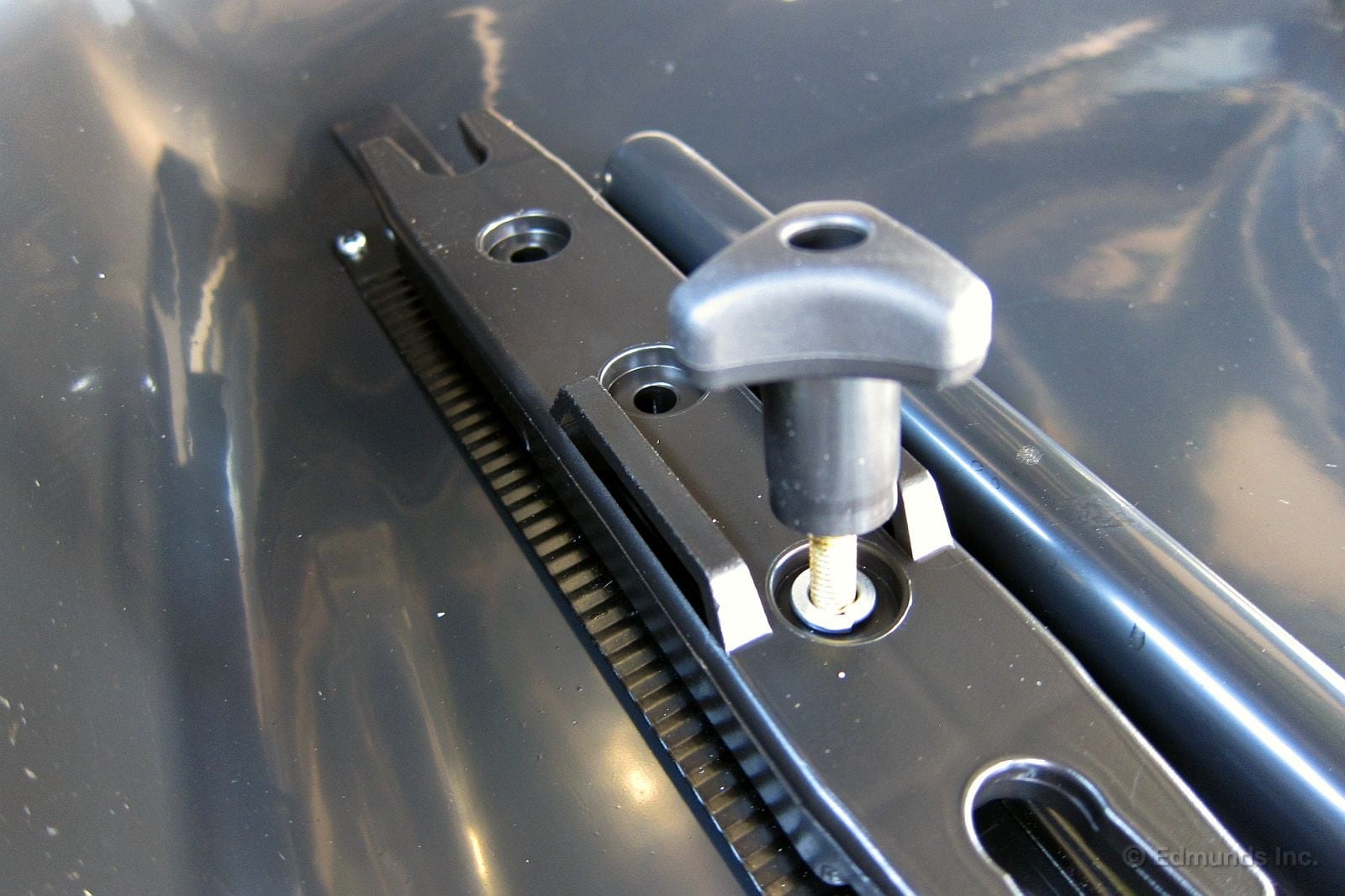
Pass the bolt on up through the hole in the box, then place a retaining bracket and split washer over the end before threading on a retaining knob. Add a second bolt, washer and knob on the other side of the crossbar, where everything is the same except for a slot in the lower part of the clamp.
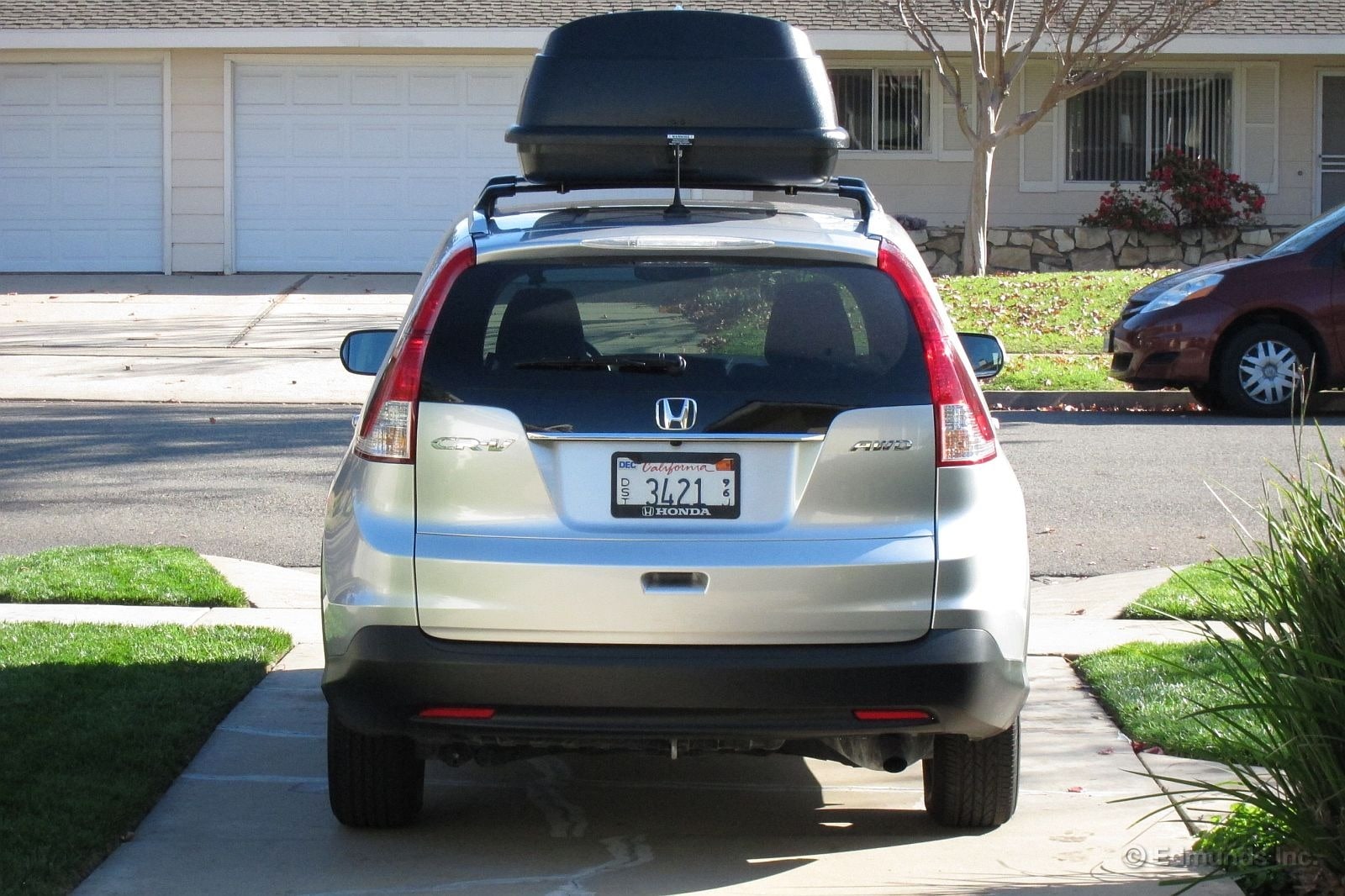
Center everything up before cranking down on the clamps. A tape measure helps, but isn't strictly necessary because this is more about aesthetics than anything else.
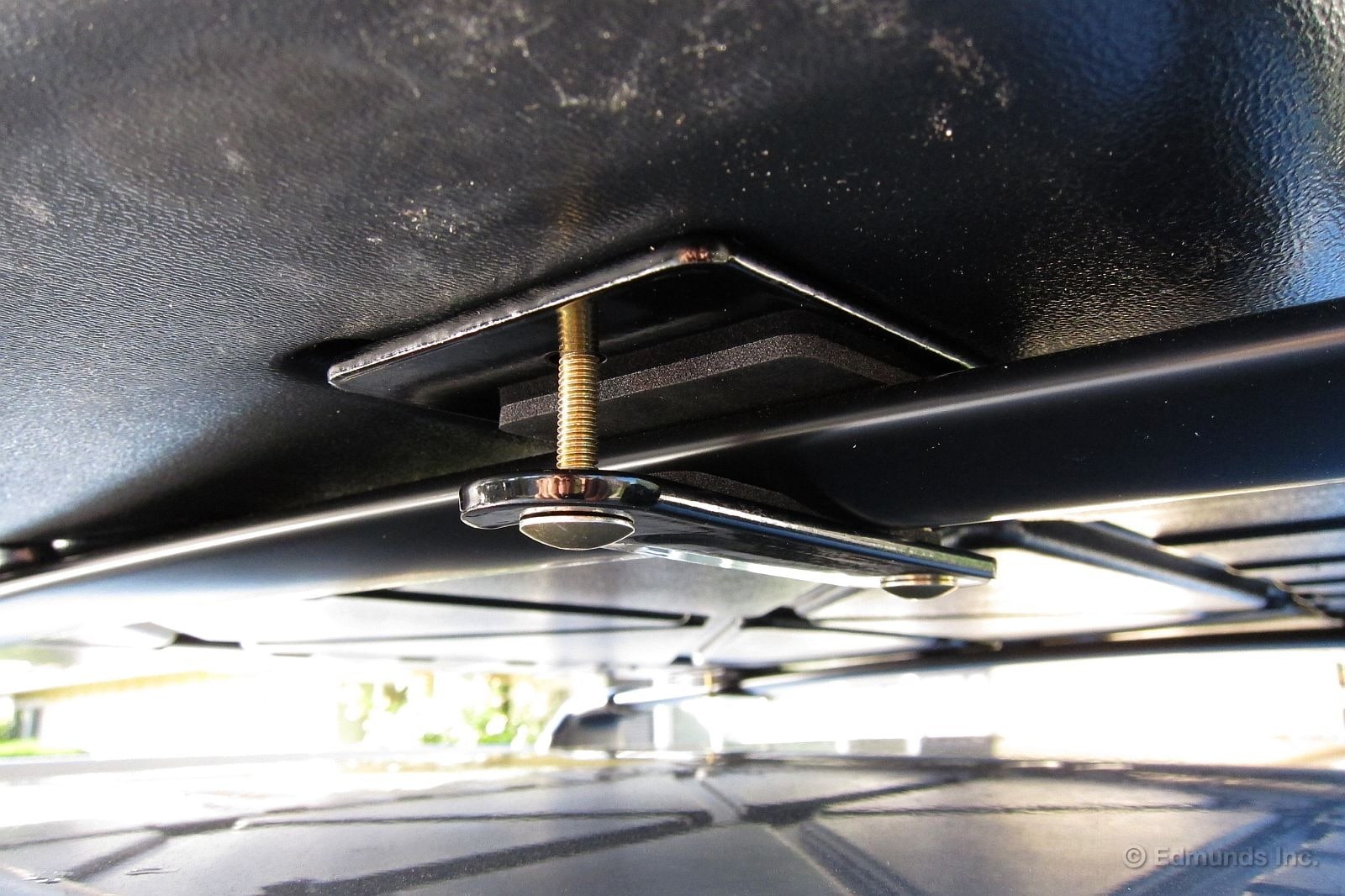
Tighten each knob gradually to bring the plates together to grip the crossbar, taking care to alternate between the two ends to keep the plates parallel.
The slotted end of the lower clamp, barely visible in the foreground here, is what allows the box to be removed and reinstalled more easily after we've finished this initial assembly. As the knobs are loosened enough slack will be created so the lower plate can be pivoted free of its bolt. Spin it 180 degrees and it will no longer capture the crossbar and the box can be lifted off without removing any parts.
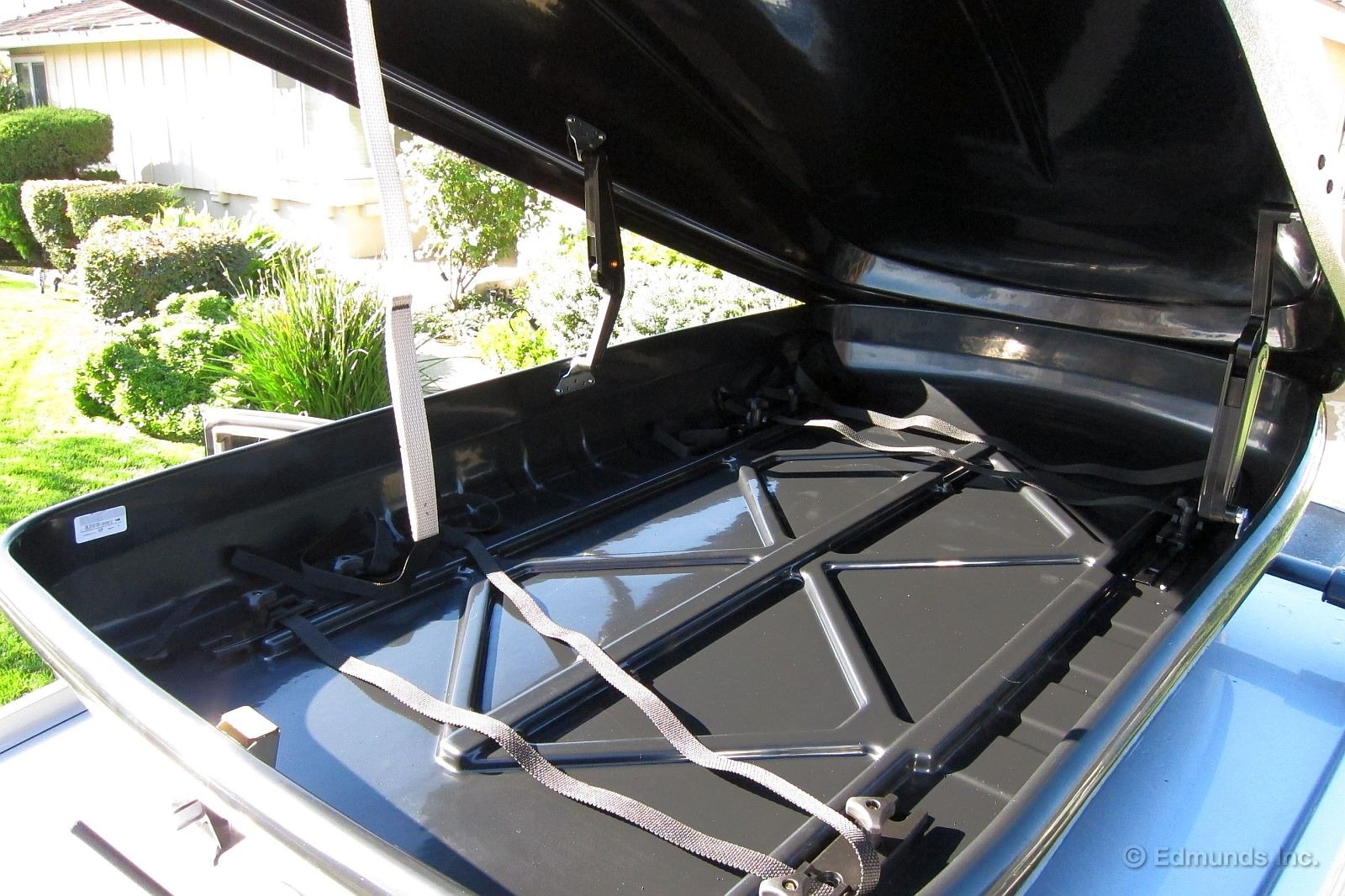
The retaining brackets have slots that allow retaining straps to be threaded through and around the cargo you put up here, like the inside of a humungous suitcase.
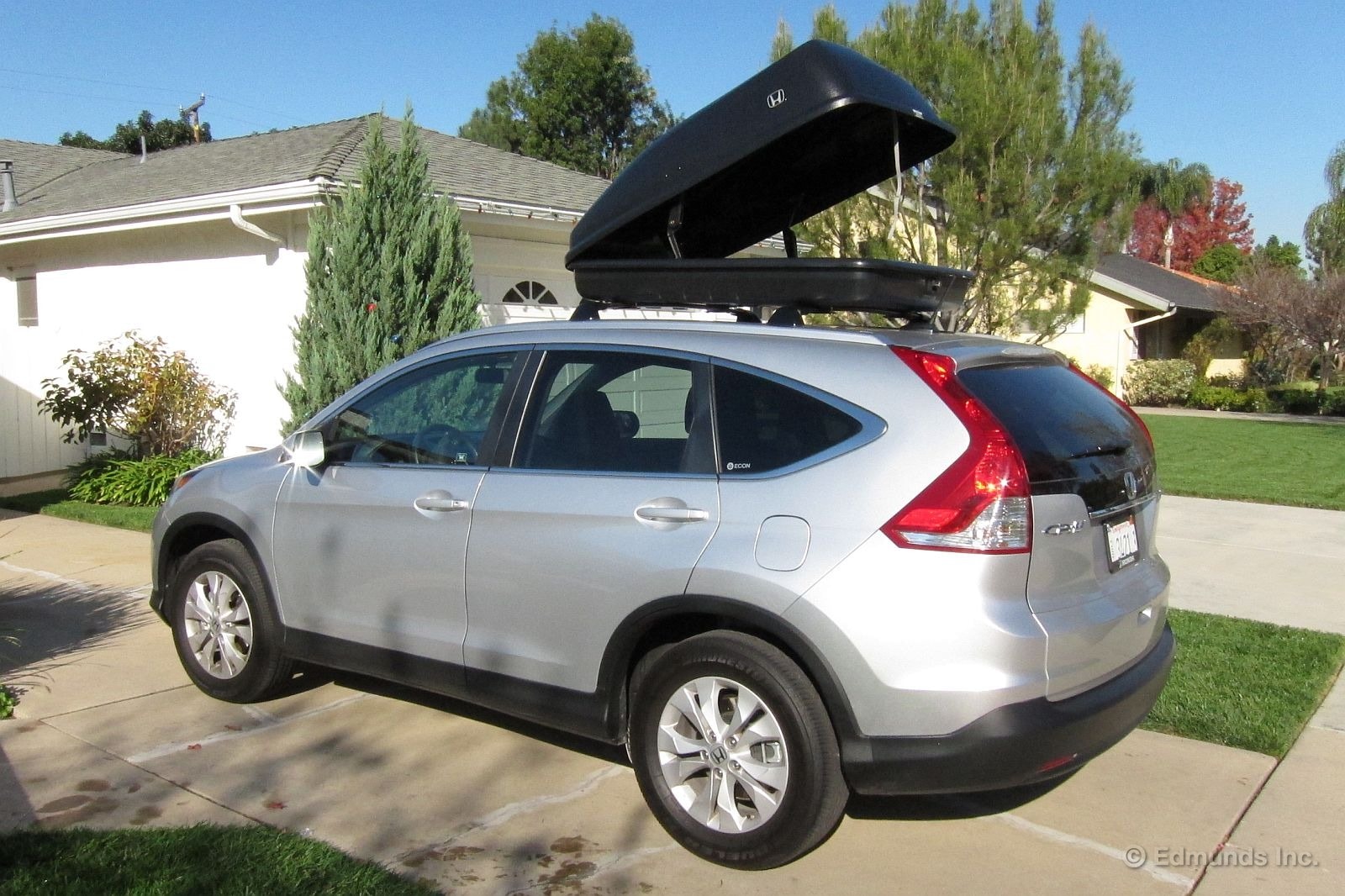
We're done. The box opens from the back, of course, but you load it from either side, using an open rear door to provide a handy step.
The installation wasn't terribly difficult, but there were quite a few parts. At least we'll only have to do most of it just this once. From here on out removal and installation will be a simpler matter of loosening or tightening eight knobs.
Of course we still need to figure out where we're going to stash it between trips.
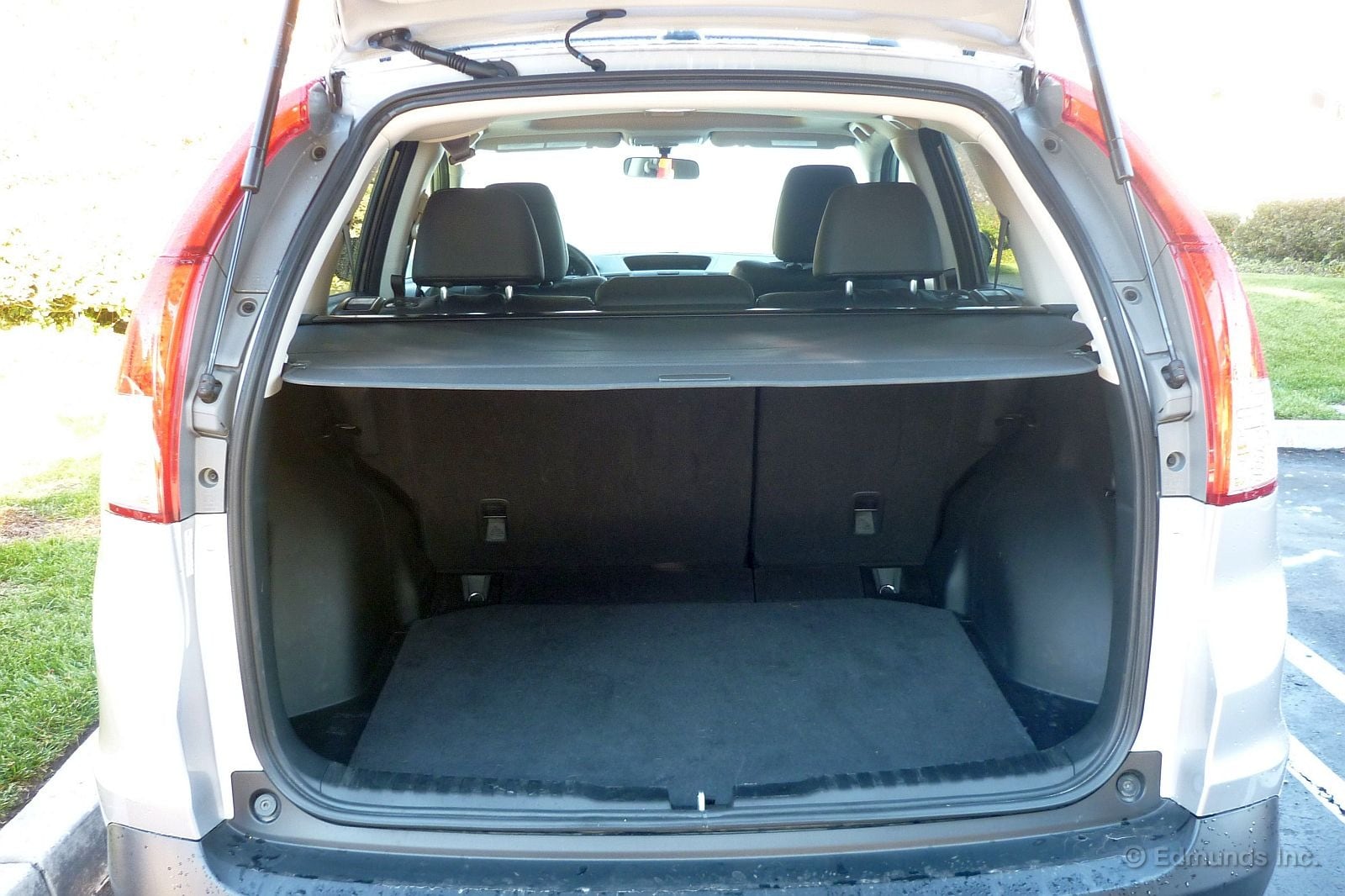
I got a nice surprise when I grabbed the 2012 Honda CR-V's rear-seat release lever from the cargo area. One pull and the folding rear seat made a big commotion: The seat cushion instantly tilted forward, the headrest dropped and the seatback folded down. Handy.
Okay, in truth you have to pull the left and right levers, since it's a split/folding rear seat, but man, this is easy. It's a true one-touch operation.
On the downside, the CR-V's load floor isn't completely flat. But there's plenty of usable room regardless. Also, putting the rear seats back in place is a two-step operation: First, drop the cushion back to the floor, then raise the seatback and slam it into its upright position.
One other high point of the CR-V's luggage area: The cargo cover sits unusually high, which allowed me to load a mountain bike in the back without having to remove the cover. Easy.
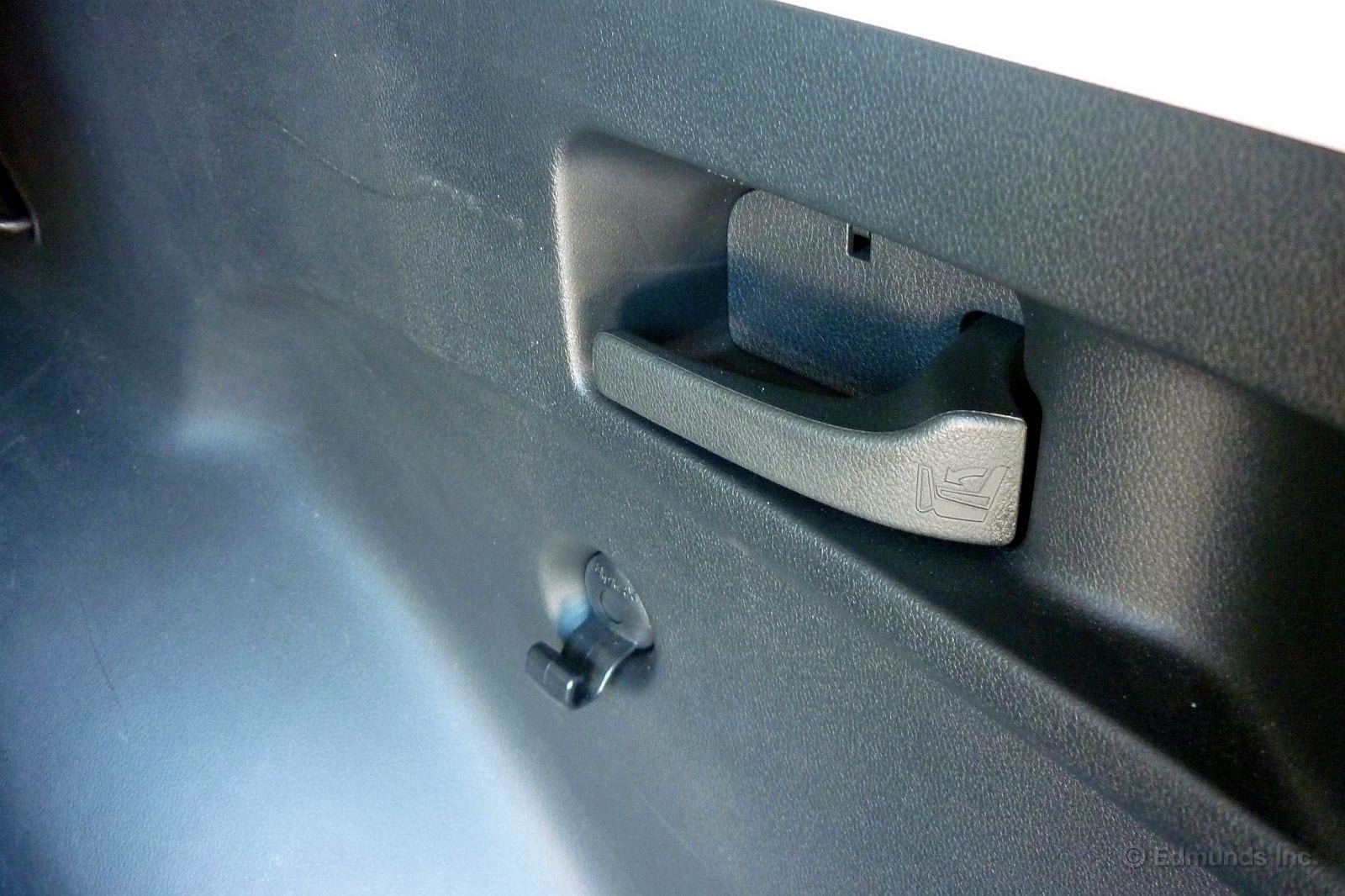


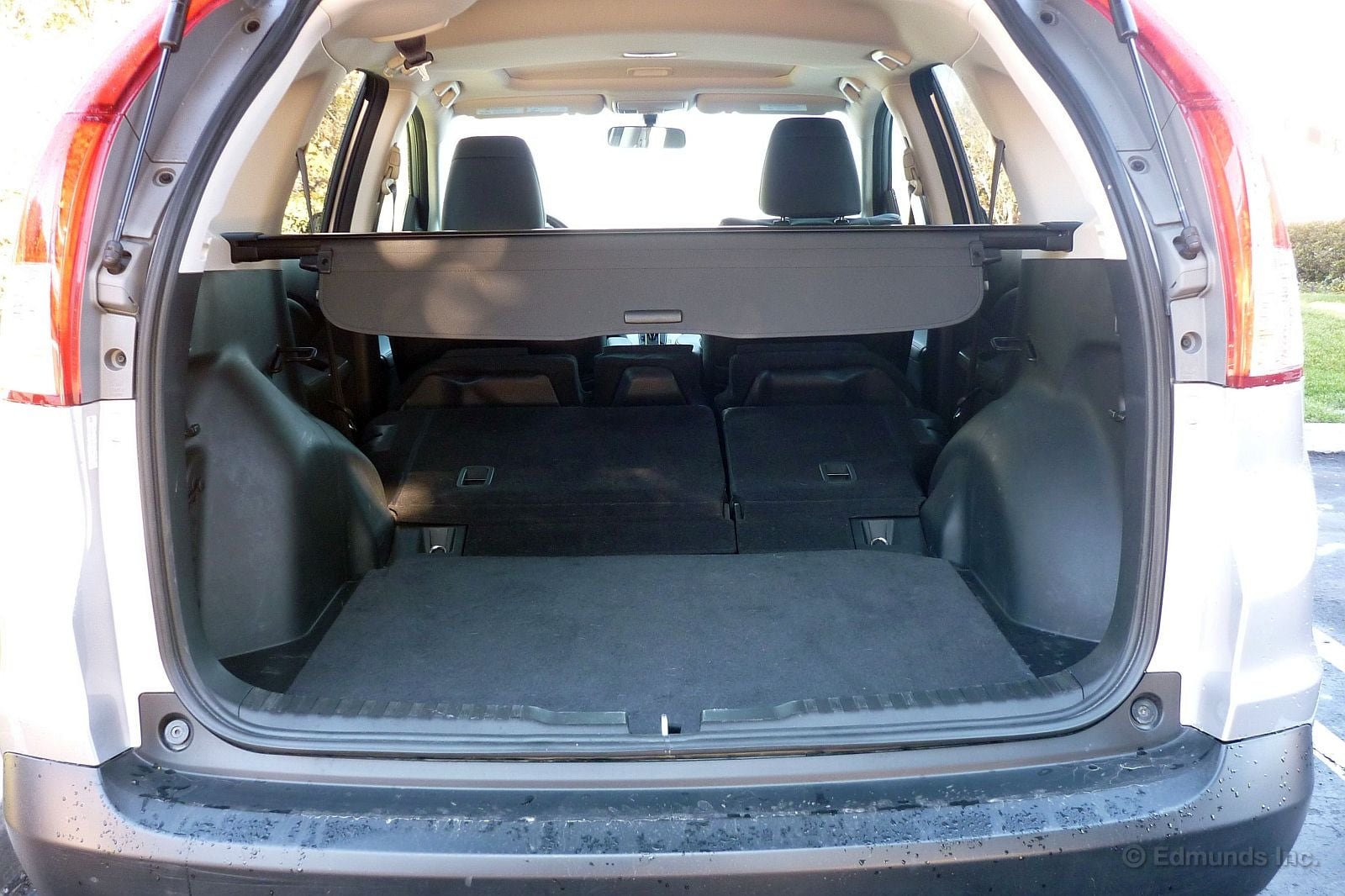
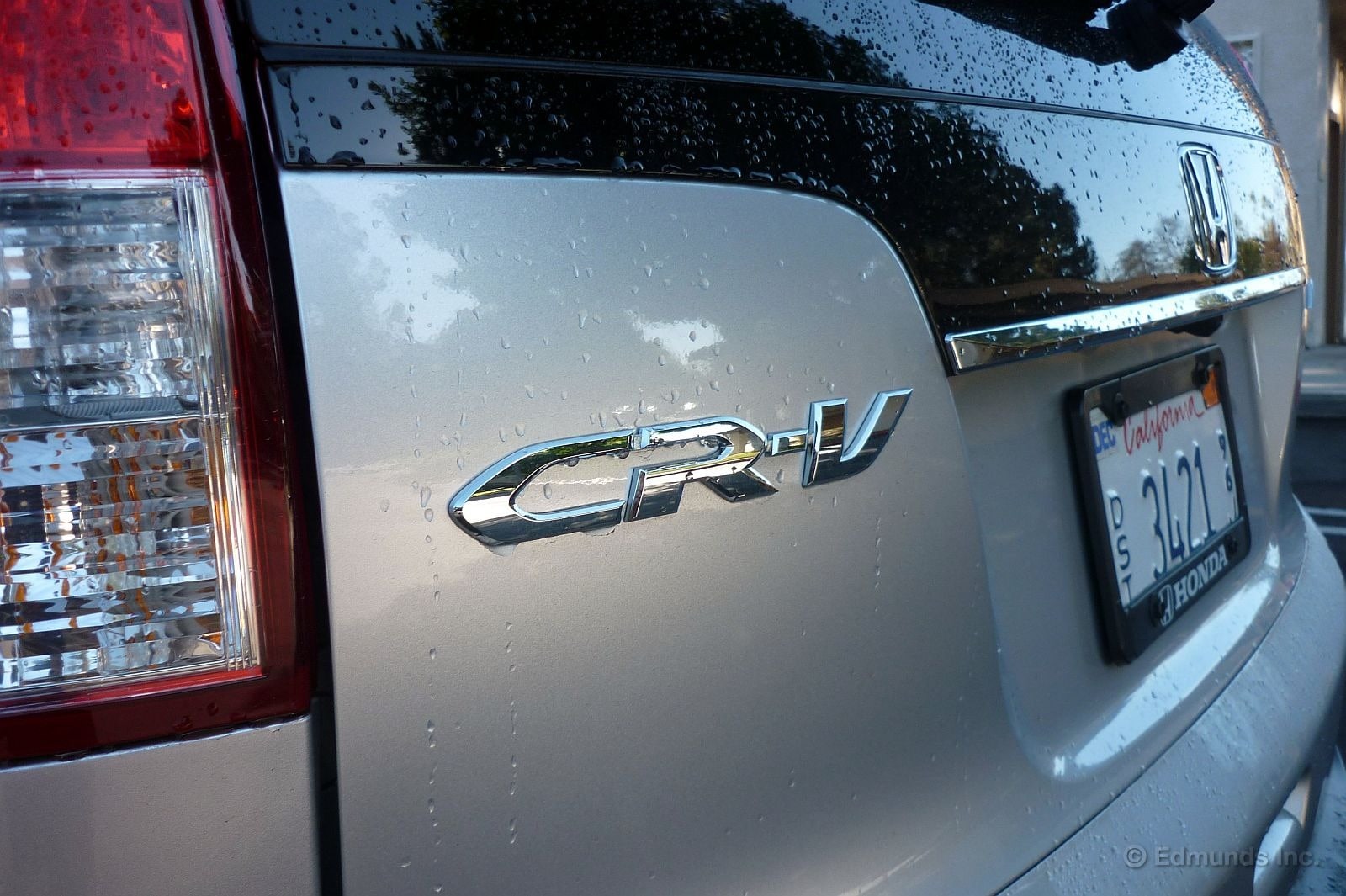
The 2012 Honda CR-V's throttle response is so perfectly intuitive, so perfectly supple that it surprises me if I haven't driven it in awhile. Yes, that's right, I'm actually more shocked these days when I drive a car that doesn't immediately lurch forward at throttle tip-in rather than one that does. This abrupt throttle thing has gotten out of hand.
But the CR-V's gas pedal is so well-calibrated that it doesn't matter if you take off gently, with a little gusto, or immediately floor it. It's always smooth. Which makes the daily drive less of a hassle.
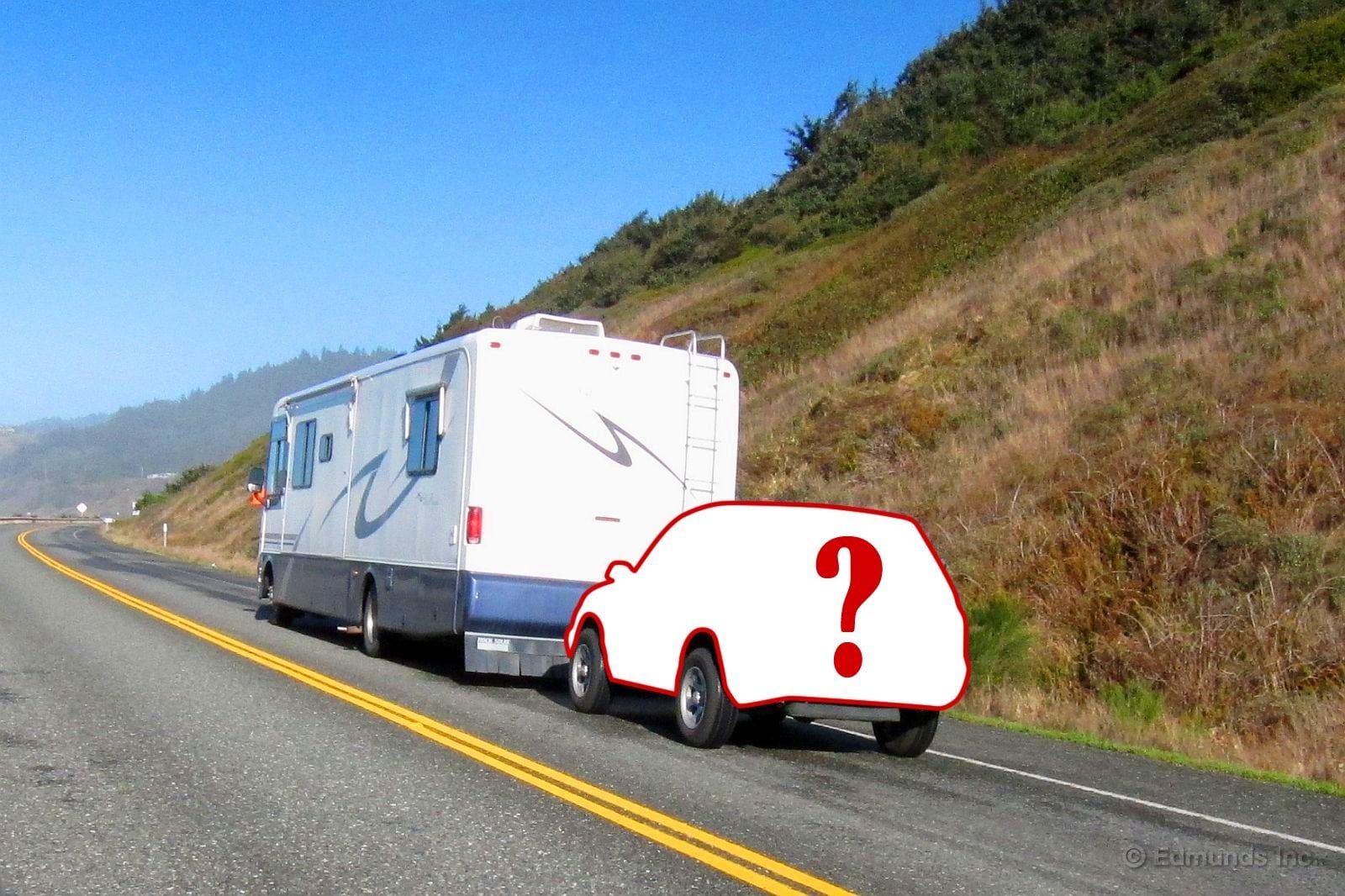
You can tow any car behind a motorhome if you bring a trailer. But that's not the preferred method. The ideal scenario is pictured above: a so-called "dinghy" vehicle rolling behind on its own four wheels, ready to be unhooked and driven around on side trips while the motorhome sits parked with its awnings unfurled and its sliders popped out in full relaxation mode. The extra towed weight, loading time and storage hassle of a trailer puts an unwelcome damper on such proceedings.
This activity goes by many names: dinghy towing, flat towing and four-down towing to name a few. As you can imagine there are mechanical implications for the car involved.
Automatics tend to be less compatible than manuals, in large part because of the way some of them are lubricated. Some all-wheel drive systems can hack it, others cannot. The only way to know for sure is to dive into the owner's manual.
The only transmission offered in the 2012 Honda CR-V is a five-speed automatic, but the drivetrain comes in front-drive and all-wheel-drive versions. The latter is more versatile for this sort of usage because it can tackle sightseeing terrain that's a bit dodgier.
But can it be done? Does the 2012 Honda CR-V make a good dinghy?
The answer is yes. Any 2012 Honda CR-V can be safely towed behind a motorhome, be it a front-drive or AWD version. The one caveat is this: the front-driver can also be towed with its front tires on a dolly, if you're into that sort of thing, but the AWD models cannot — only four-down dinghy towing for that one. But that's OK. That's what we're after.
As usual, Honda wants you to do things in a particular way to stay within the bounds of your warranty and avoid damage.
First, check your transmission fluid level and make sure it's between the upper and lower hash marks. This isn't really a dinghy towing thing — this state of affairs should always be the case — but it underscores the need to treat the transmission right before you subject it to this kind of use. And if you dinghy-tow often they advise you to change that ATF every 2 years or 30,000 miles instead of the usual interval.
After hooking up and latching on to the motorhome, step on the brake and start the engine if it isn't running already. Keeping your foot on the brake, move the shift lever briefly through all its positions. Finish by holding it in drive for five seconds, then shift to neutral and let the engine run for three more minutes. It is vitally important to make sure you do this last step from drive to neutral as described. Going from reverse to neutral instead could lead to "severe transmission damage," they warn.
Shut the motor off, leave it in neutral and make sure the parking brake is fully released. Turn the key to the accessory position and confirm that the steering is unlocked.
At this point you're set to go, and if you won't be towing more than a few hours you don't need to pull any interior fuses, especially if you make sure nothing is plugged into the cigarette lighter and the dome light is off. Don't laugh. During my last Oregon road trip I actually saw an RV towing a CR-V in the wee hours with the dome light still on. Don't be that guy.
If you are going to be towing 8 hours or more, then you should pull the 7.5-amp "accessory radio" fuse from the interior fuse panel. I have no idea if this prevents the dome light problem, but it's the only fuse they call out.
Beyond that, Honda asks that you do not exceed 65 mph, and they want to make sure you re-start the engine and repeat the transmission shifting and idling sequence described above after every eight hours of travel and each morning before you hit the road again.
Beyond dinghy towing, the 2012 Honda CR-V is a solid vehicle on many other counts. It really is the right sort of vehicle to have if you want to do some light off-roading or just want something more substantial than a sedan during your RV travels. Unloaded curb weights range from 3,300 pounds to just over 3,500 pounds.
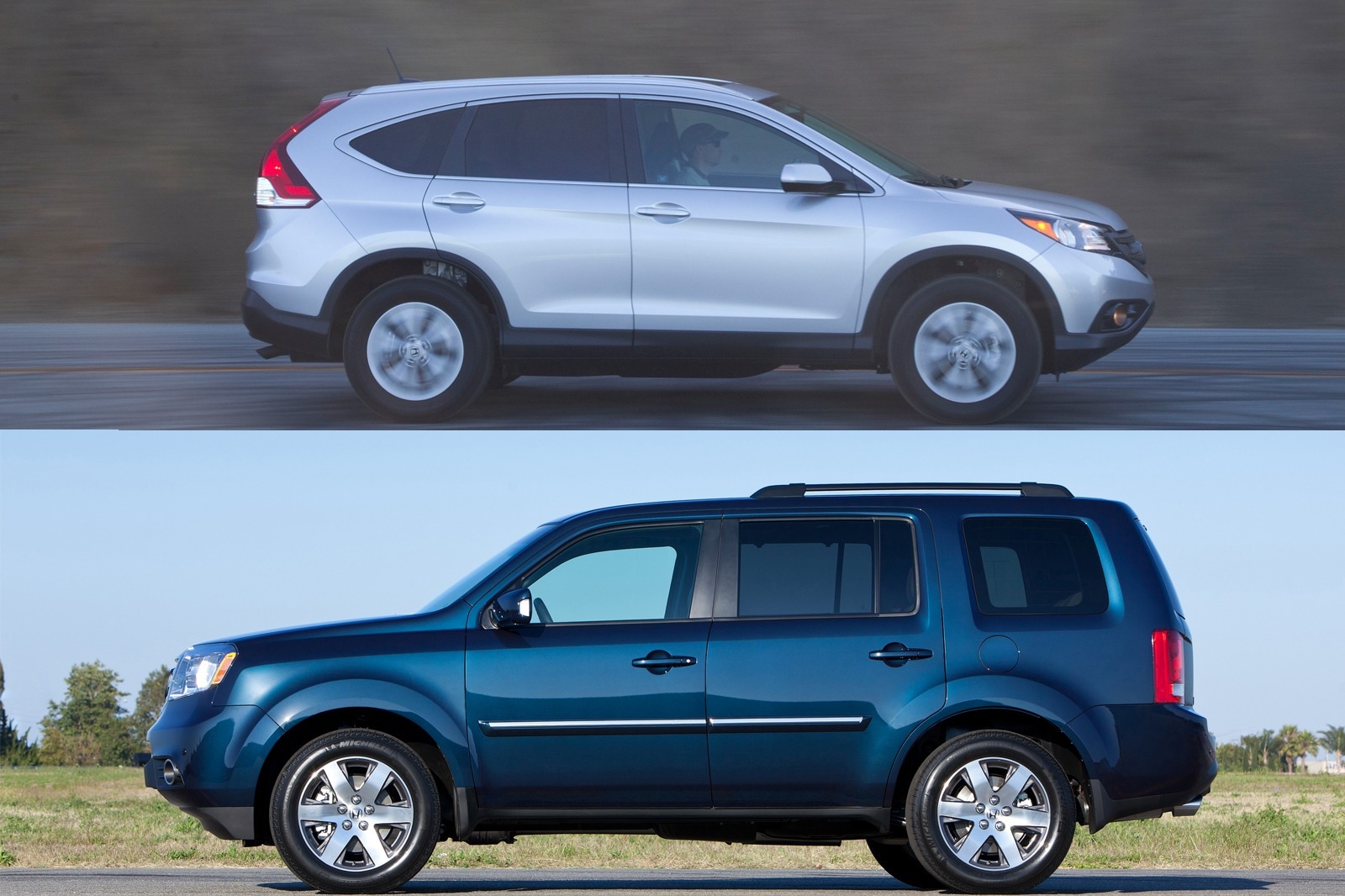
I spent a great deal of time over the holidays in a Honda Pilot and discovered that it perfectly embodies the Honda tradition of vehicle packaging excellence. It's actually much shorter in length than a Mazda CX-9, for instance, but has more useable interior space, along with an abundance of little cubbies, bins and other clever storage solutions.
However, the Pilot drives absolutely nothing like a Honda. It feels more like an Expedition, with monumentally slow steering, roly poly body motions and a center of gravity that feels located a good three feet above the roof.
The CR-V, on the other hand, definitely feels like a Honda. Perhaps not like those hallowed Hondas of old that make certain folks weep at the thought of CRXs and mid-90s Civics with those funky one-armed headrests. But it definitely has that dynamic DNA — responsive steering, a relatively nimble handling feel — while also having an interior that's quite cleverly packaged.
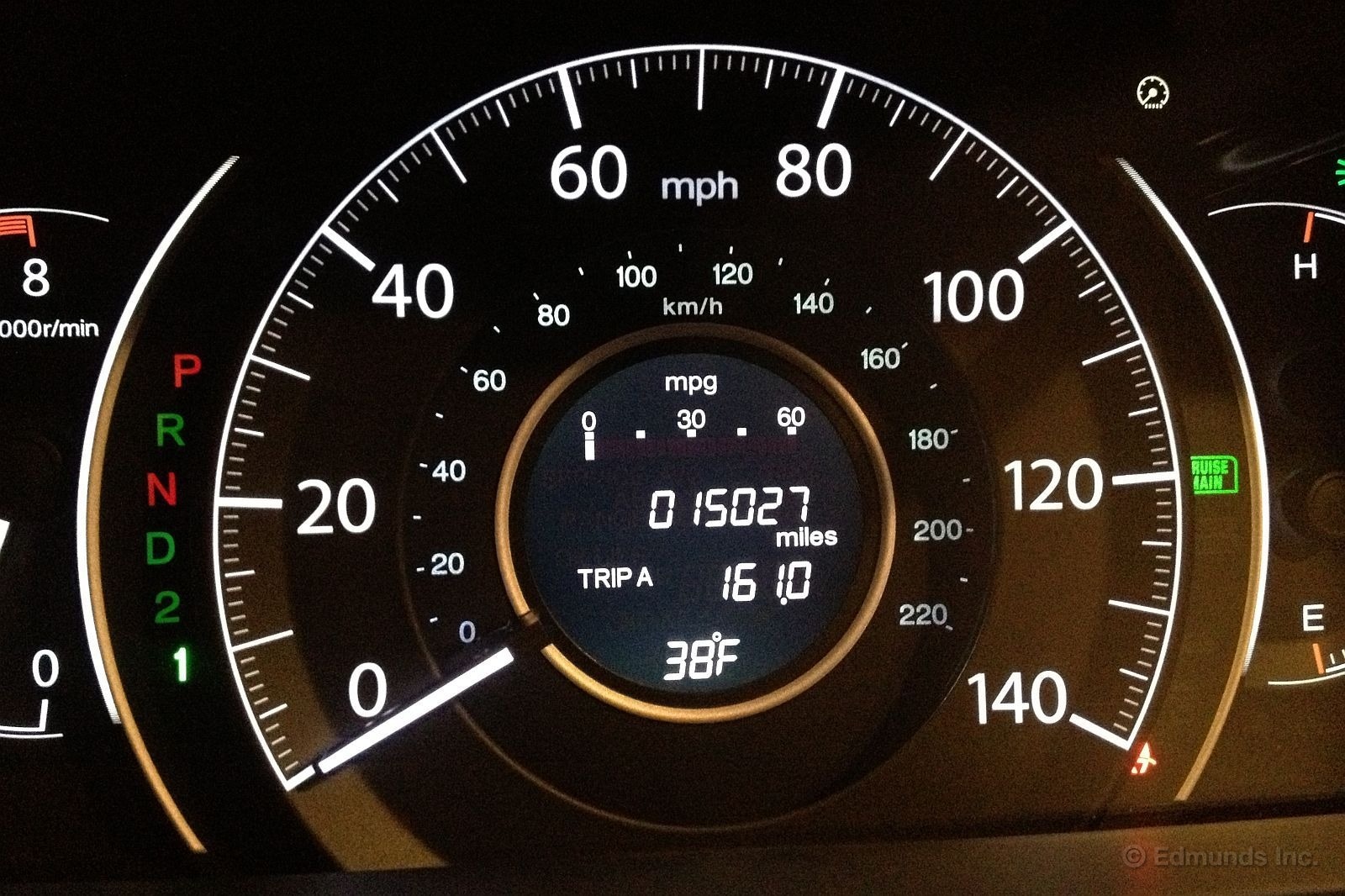
The goal for cars in the Edmunds long-term test fleet is to accumulate 20,000 miles during their 12-month stay. As of the New Year our 2012 Honda CR-V is comfortably ahead of schedule. It entered service last June 25th, which means it took just over six months to cross the 15,000-mile mark. At this rate 25,000 miles looks to be a cakewalk, and 30,000 miles isn't out of the question. Clearly, it's a popular choice.
Why? Anyone who has owned a CR-V will know the answer. It's practical, versatile, efficient and affordable, and the new generation ushered in with the 2012 model year may be the best example of the species to date. It also helps that the CR-V is a good road trip vehicle, as numerous road test editors in the office can attest.
We're pretty diligent about our fuel consumption records during the entire test period, and so far the CR-V has not let us down. The EPA's combined fuel economy rating for the 2012 Honda CR-V AWD is 25 mpg, and our 15,000-mile average is right on the money at 25.1 mpg.
Of course, carmakers have gotten into the habit of talking almost exclusively about highway fuel economy, as if all any of us ever did was criss-cross the country on the interstate highway system. We know better, but we'll play along.
Our AWD example's best tank so far was 31.3 mpg, compared to a highway rating of 30 mpg. Its best observed range to date has been 388.9 miles, but that was a 29.3 mpg run in which we pumped 13.3 gallons into its 15.3-gallon tank. The magic 400-mile barrier is clearly attainable on the right sort of trip.
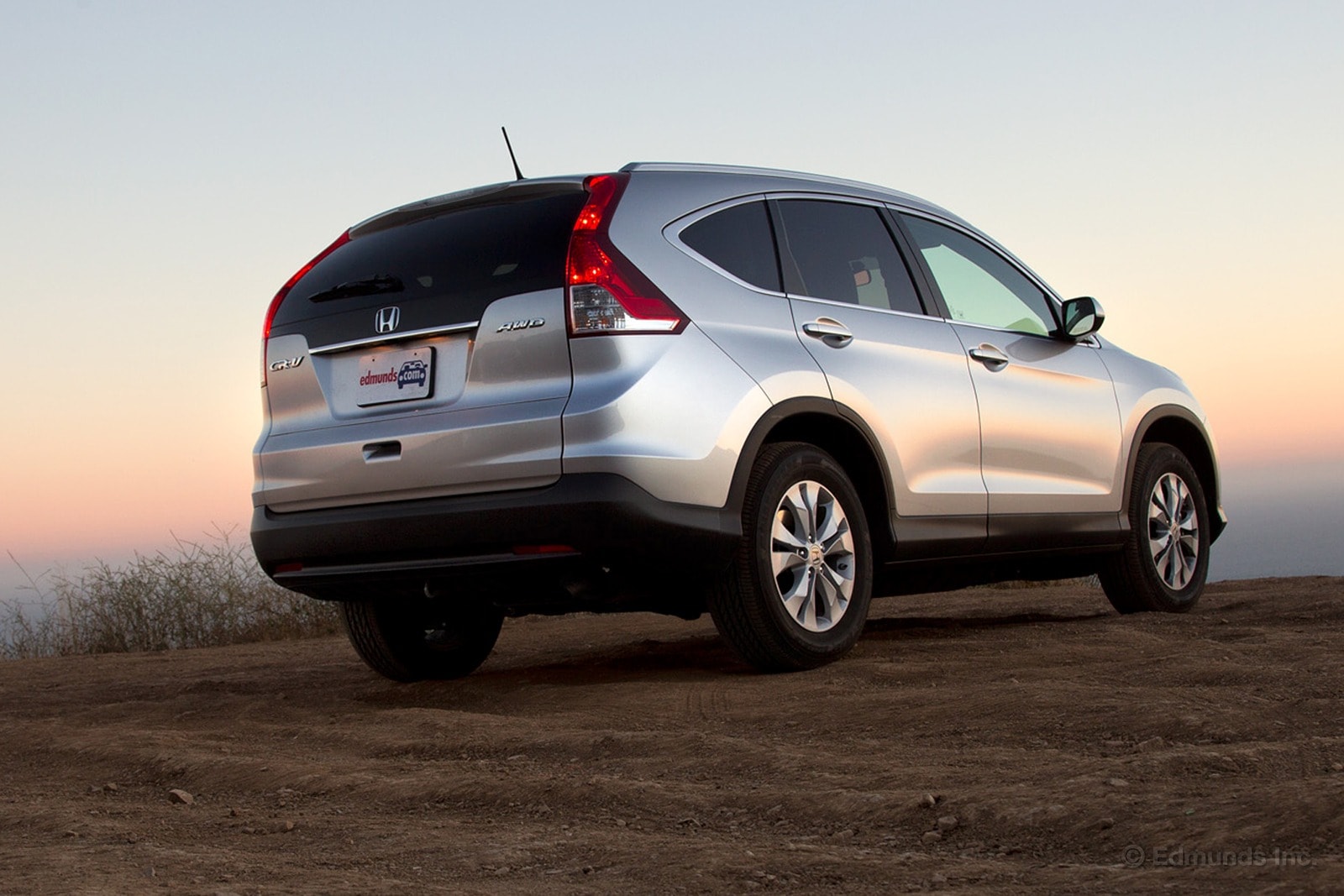
I drove the CR-V to a friend's house to watch the Niners clean up the Pack. Since he owns a 2011 CR-V, I thought I'd get his impressions of the redesigned model. It wasn't exactly an apple-to-apple comparison. He owns an LX model, strictly a utility wagon, and admitted it was easy to be impressed by our EX-L's leather, nav system and quasi-piano black trim.
But he specifically liked the new CR-V's deep center console with the rolltop lid, even though he appreciates the functionality of his CR-V's flip-up table/console. He noted how the new CR-V cuts away some of its ceiling above the rear seats, allowing for more vertical cargo space. And being somewhat of a Luddite nostalgist himself (we sometimes record music at his house on an old 8-track tape machine), he liked that the new CR-V returns to an analog fuel gauge, needle and all, as opposed to the LCD digital display in his car.
He wasn't as enthused with the exterior design. Although the new CR-V looks a bit bolder, he voiced a complaint similar to that of others: the rear end just looks too long, lumpy, and overhangs its welcome. When asked if he'd consider trading up however, he said he'd be tempted, simply because he's been so pleased with his current CR-V. Thus, Honda's magical emotional connection sauce works its charm again.

As last year's sales numbers come rolling in, the folks at Honda have plenty to smile about. The Honda CR-V nabbed the eighth spot on the list of 2012's best-selling vehicles, sandwiched between the Toyota Corolla and the Ford Escape (the Honda Civic and Honda Accord also made the list). Its strong performance means that the CR-V was the best-selling SUV in the land last year.
Congrats, CR-V. With your comfortable ride quality, impressive features list and highly functional interior, it couldn't have happened to a nicer vehicle.
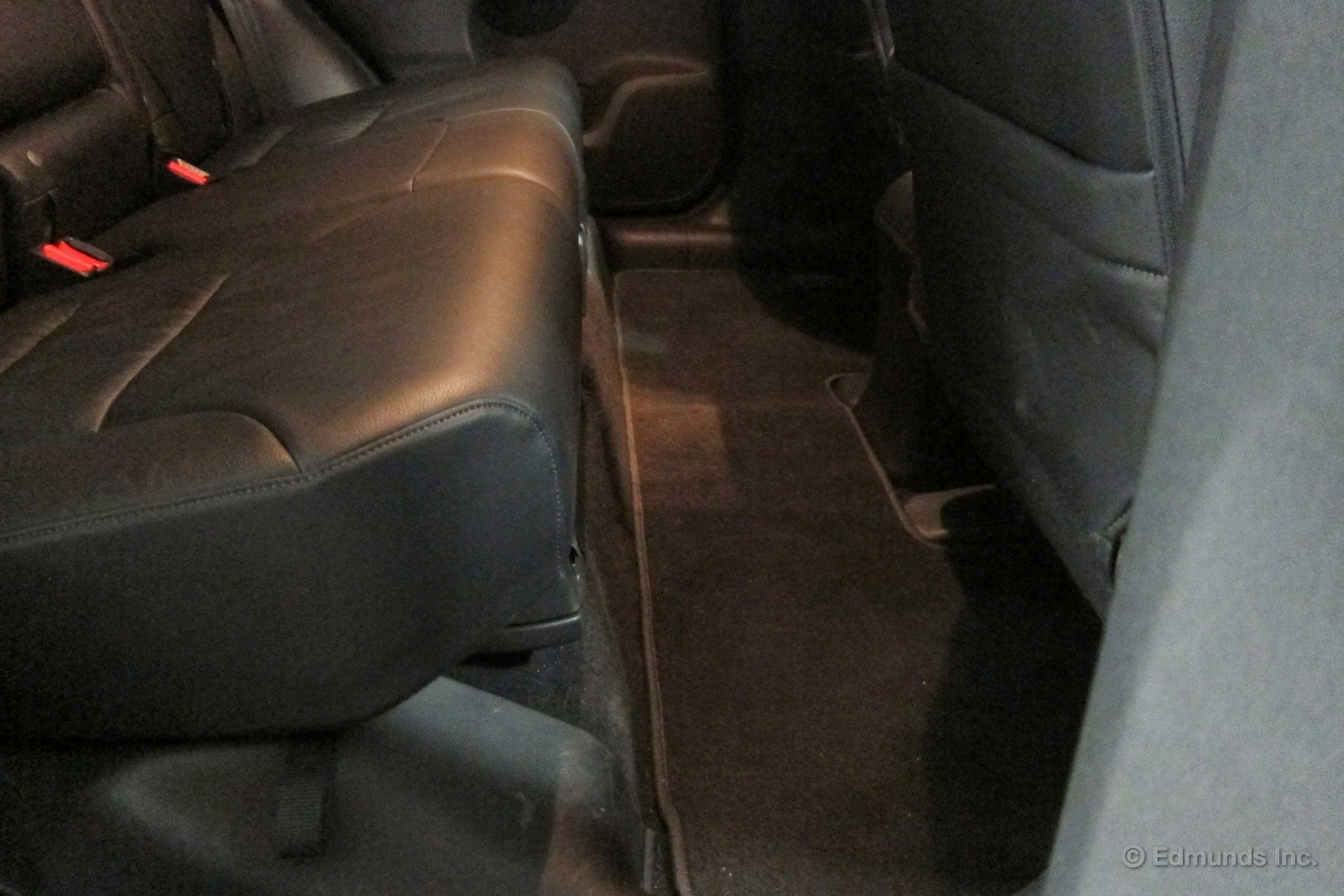
You forget how handy this flat-floor design is until you haven't used it for awhile. The CR-V's is wide and long enough for a couple of coolers of beers, brats and burgers to tide you over while watching the Niners decimate the Pack. Too bad too, since Aaron Rodgers seems like a good guy. But the Niners are California's only legit football team, at least until the Trojans wise up and sack Lane Kiffin. Sorry if that hurts you Charger fans, but you had your chance.
The CR-V's also good for floor-loading a couple of guitars, probably even a bike. No hump in the middle means flexible cargo options and good legroom for all. On the flipside, it also sometimes means spilled groceries after taking a particular turn with too much enthusiasm.
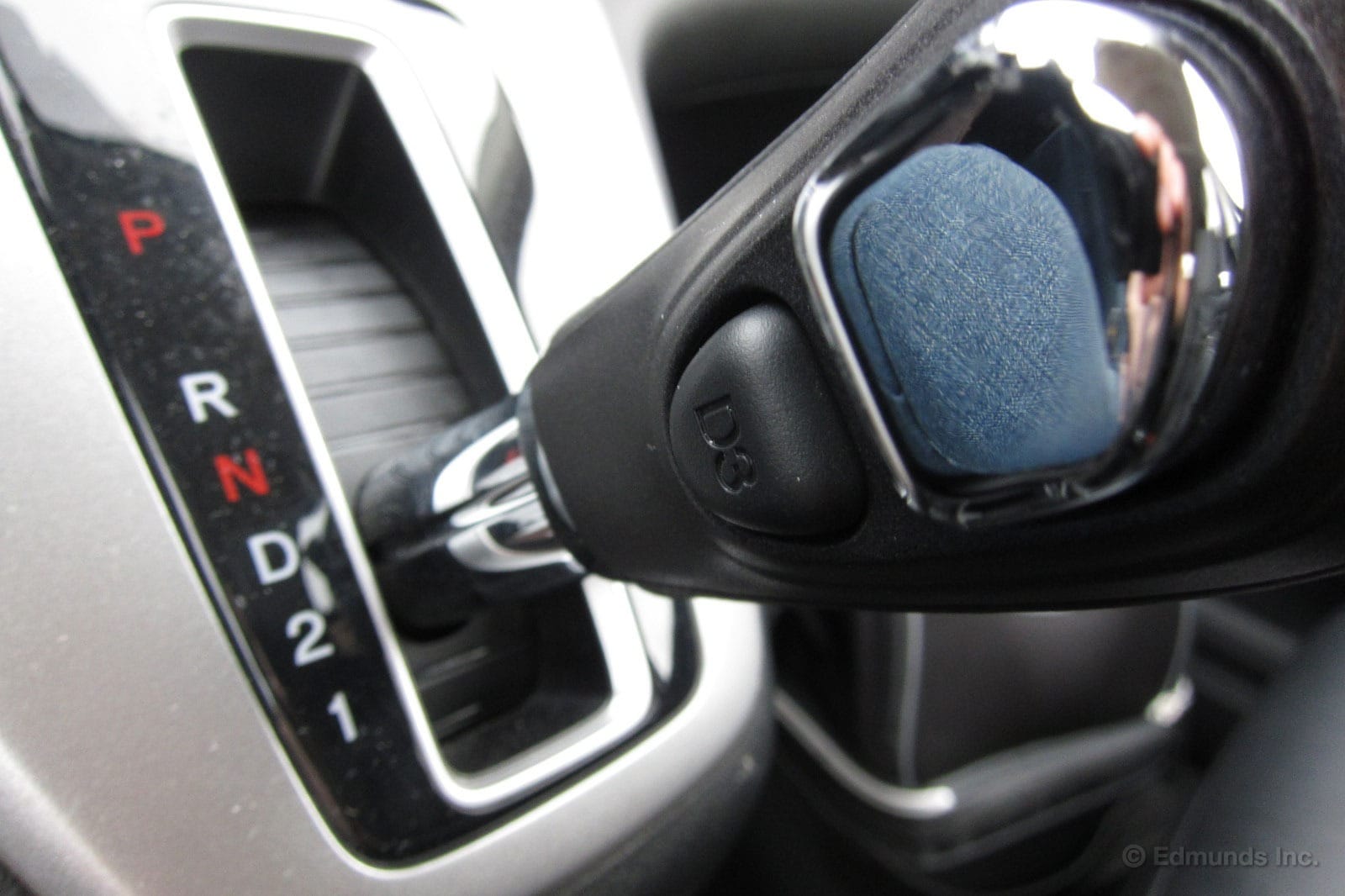
That Honda's CR-V uses a five-speed automatic transmission while its primary rivals, the Ford Escape and Toyota RAV4, use six-speeds isn't ideal. That the five-speed lacks a manual gate, shift paddles and rev-matching abilities is inexcusable.
Here you can see that the only way to lock the transmission in a gear is to pull it down into 2 or 1 or use the D3 button. None of these options is as elegant or as easy as a rev-matched downshift would be using a paddle or a manual gate.
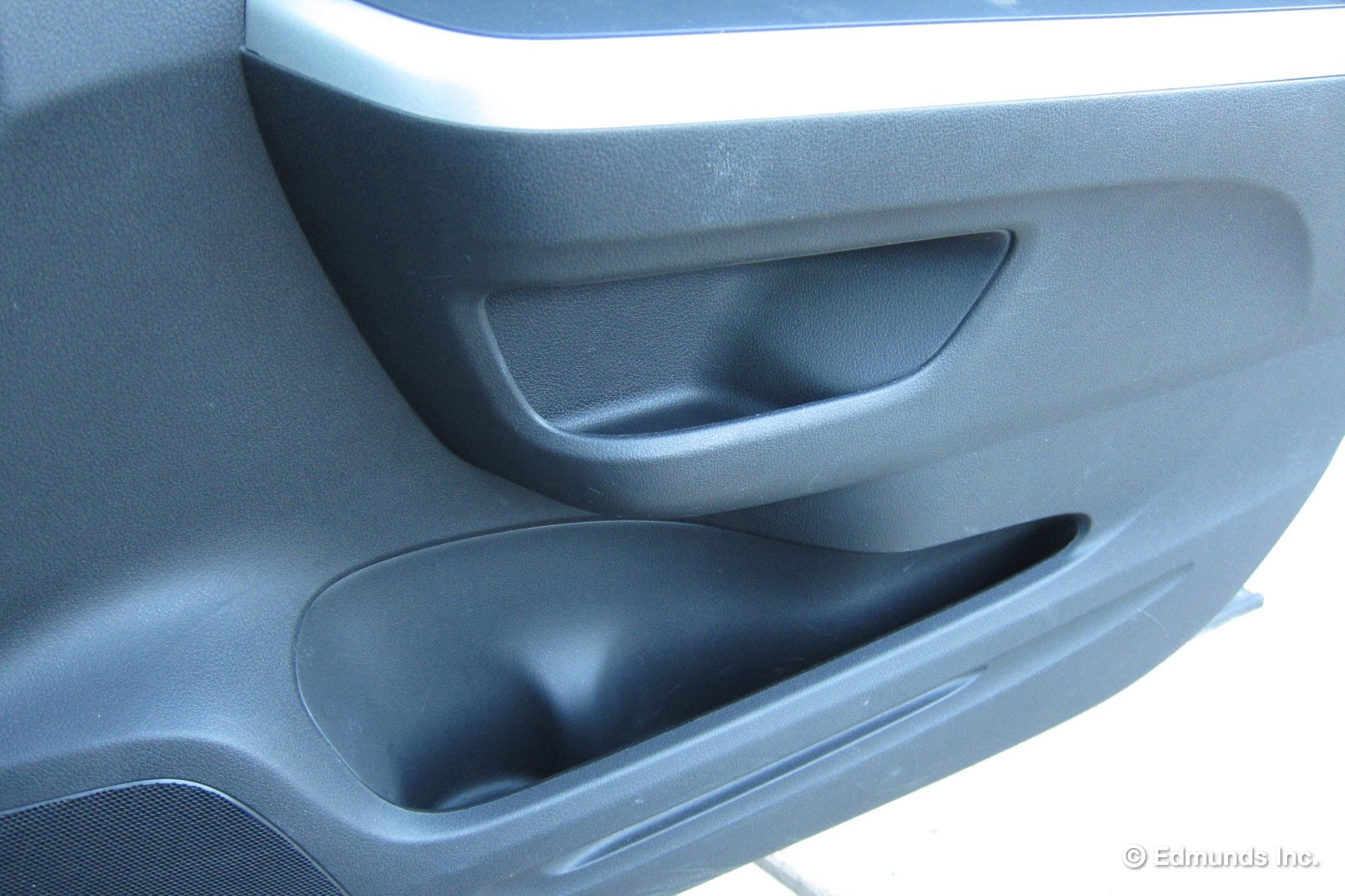
Honda does small-item storage in the form of small, well-placed bins better than anyone else. Here's a tour starting with the two-bin door pocket.
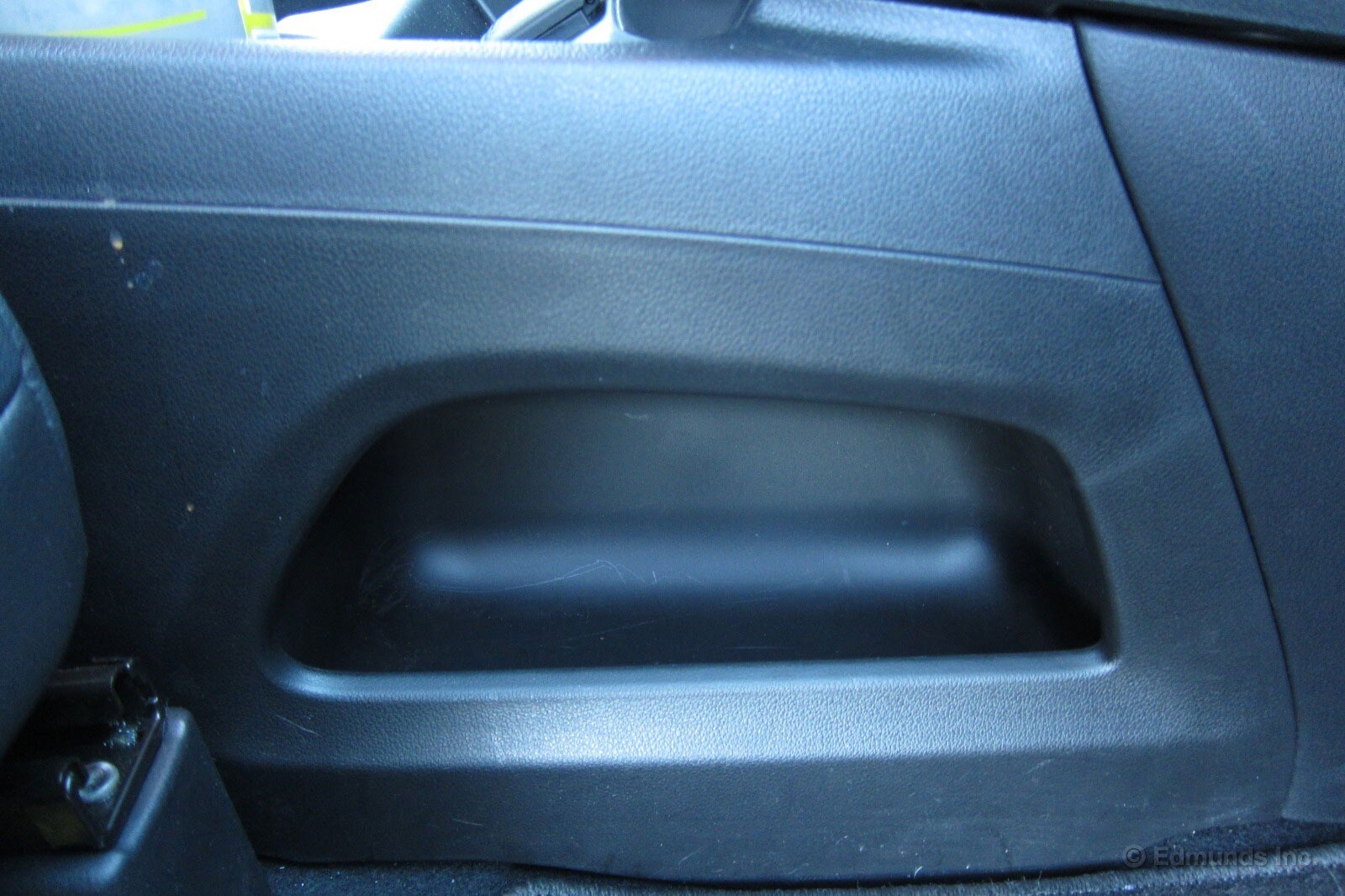
These small bins flank both sides of the center console.
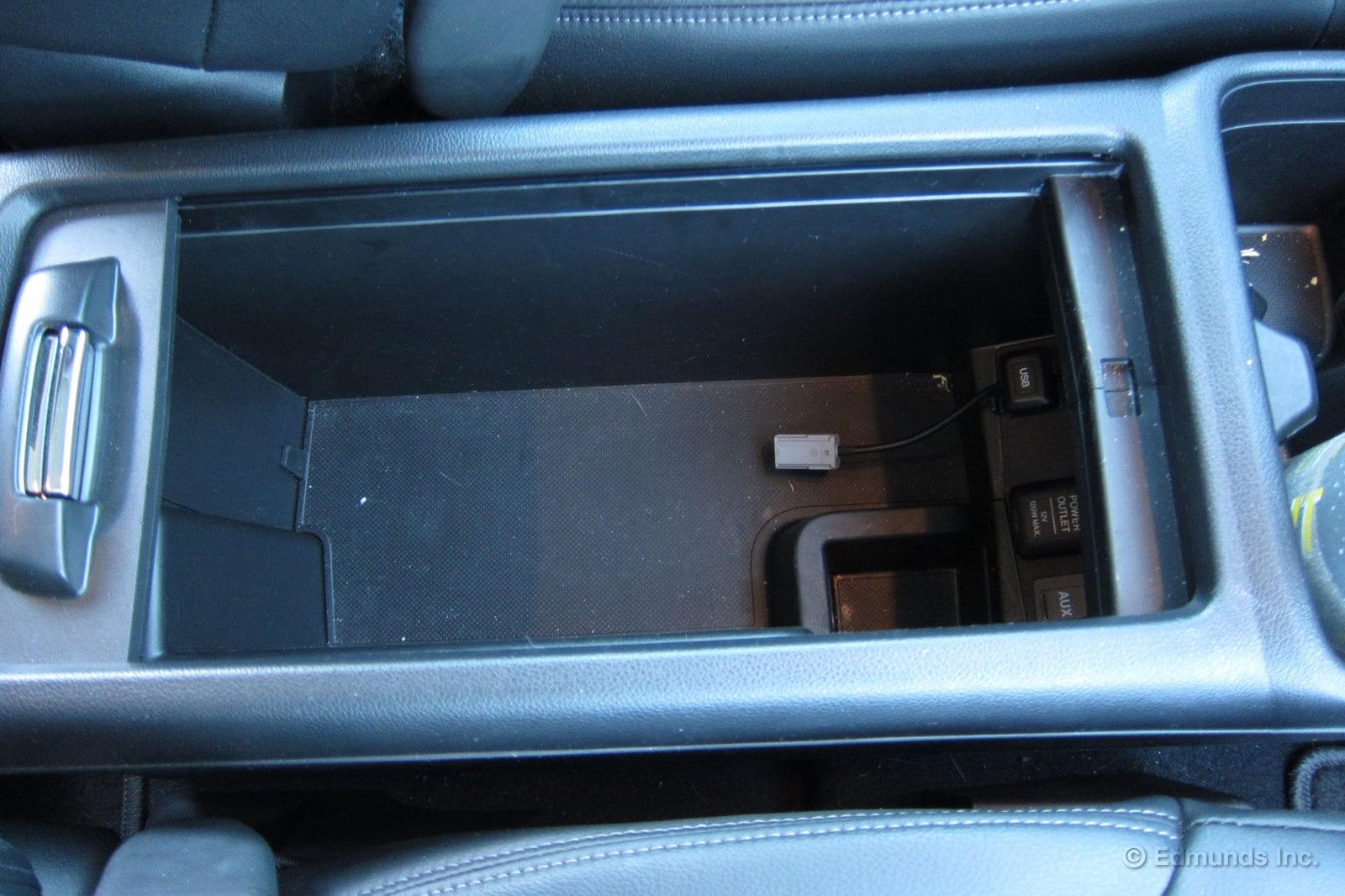
And the center console itself is, well, massive.
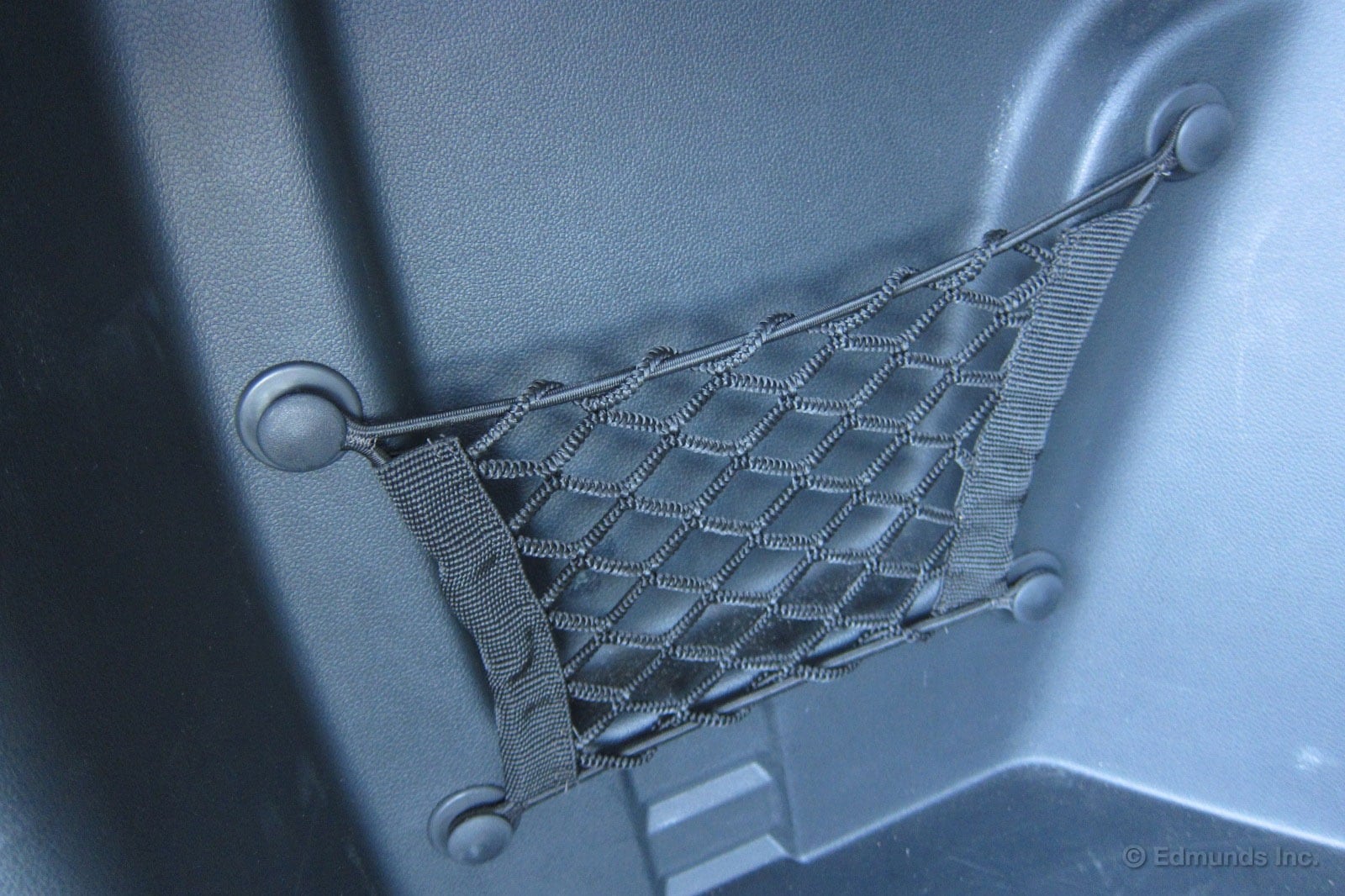
This net pocket is on the driver's side of the rear cargo area.
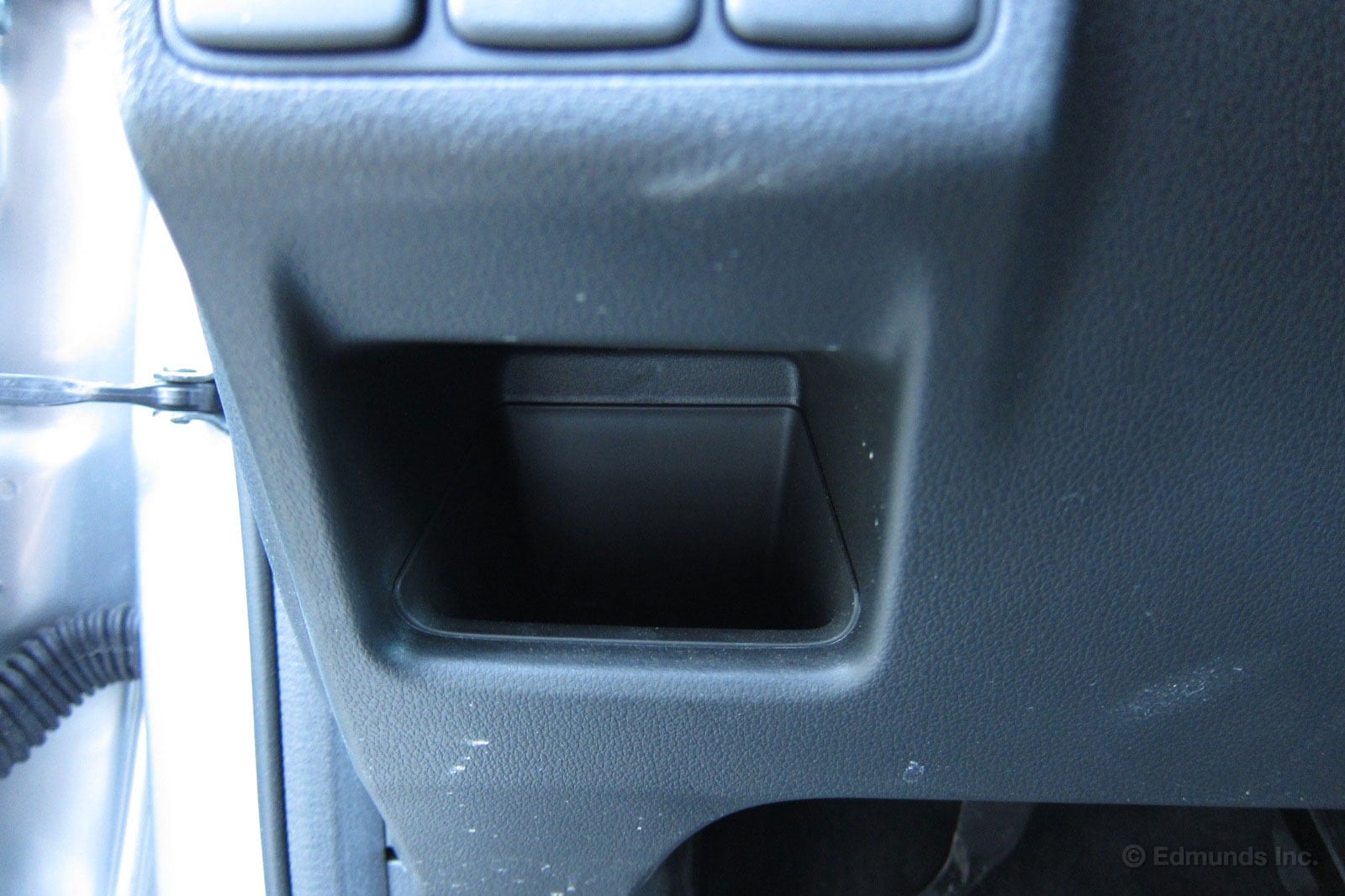
This small change bin is on the dash neat the driver's left knee.
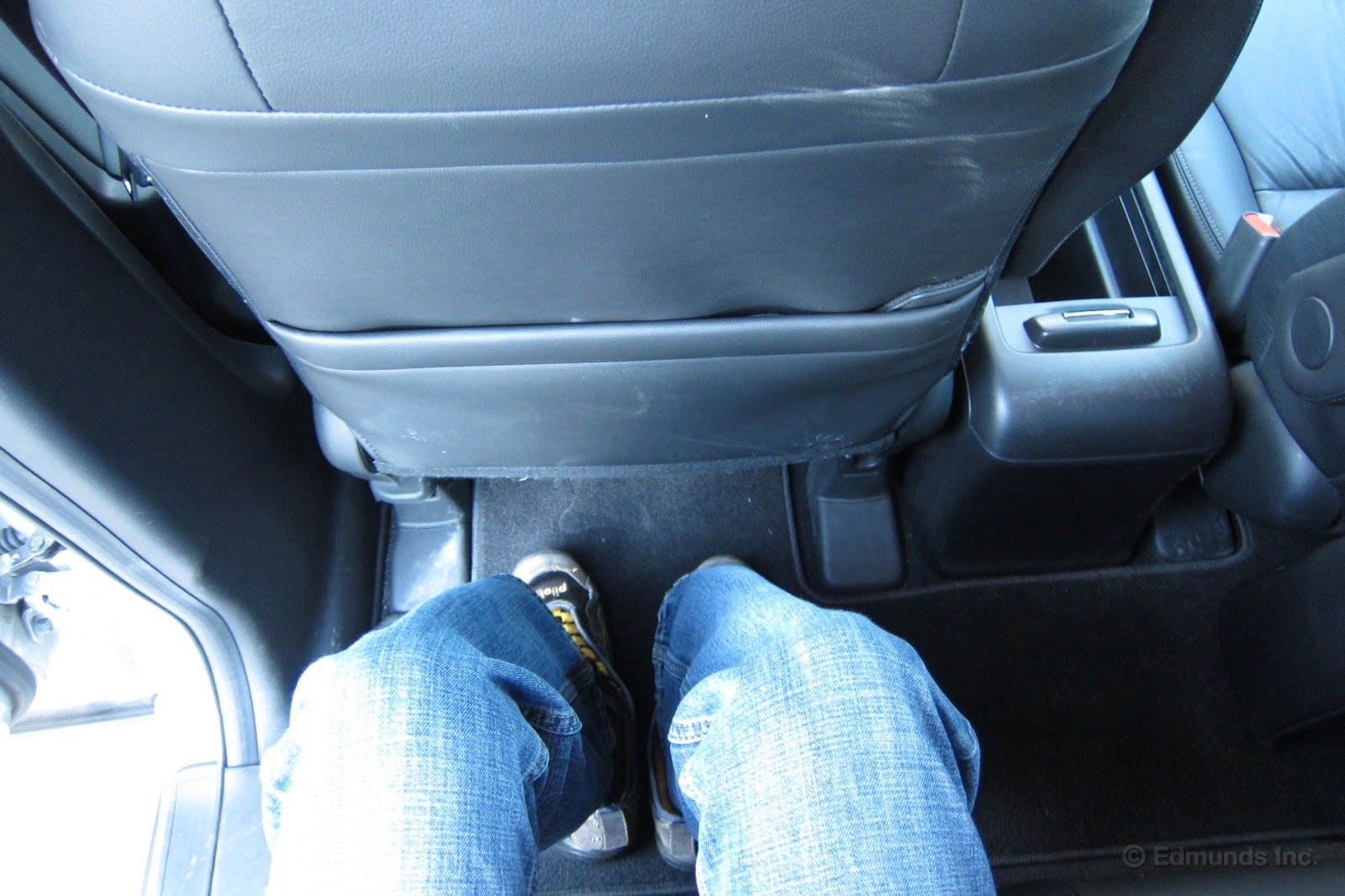
Leg room. The CR-V has lots of it. I've got a 32- to 34-inch inseam depending on how things are measured. This photo shows how much leg room is available in the CR-V behind the driver's seat when it's set in my preferred driving position.
No one will complain about rear leg room in this SUV.

A couple of weeks ago we noted how the 2012 Honda CR-V was the best-selling vehicle in its segment last year. Some of that success is no doubt due to sales momentum. Honda's been doing this a long time, and there's a lot of loyalty associated with the CR-V. But it all had to start somewhere, and the latest CR-V is still excellent at what people expect out of it.
Read through our various posts on our long-term CR-V the past six months and this is what you'll learn: It's roomy inside, but not too bulky to drive. It's comfortable around town and on the highway, but there's still a secure feeling to the handling. It's fuel efficient. It's inexpensive to operate and own. It's got top safety scores. And unlike a small or midsize sedan, you can fit bulky things in the cargo area and get it with all-wheel drive.
Whether you're young and single, starting a family, or have already made it to empty-nest status, the Honda CR-V will likely fit your life quite nicely.
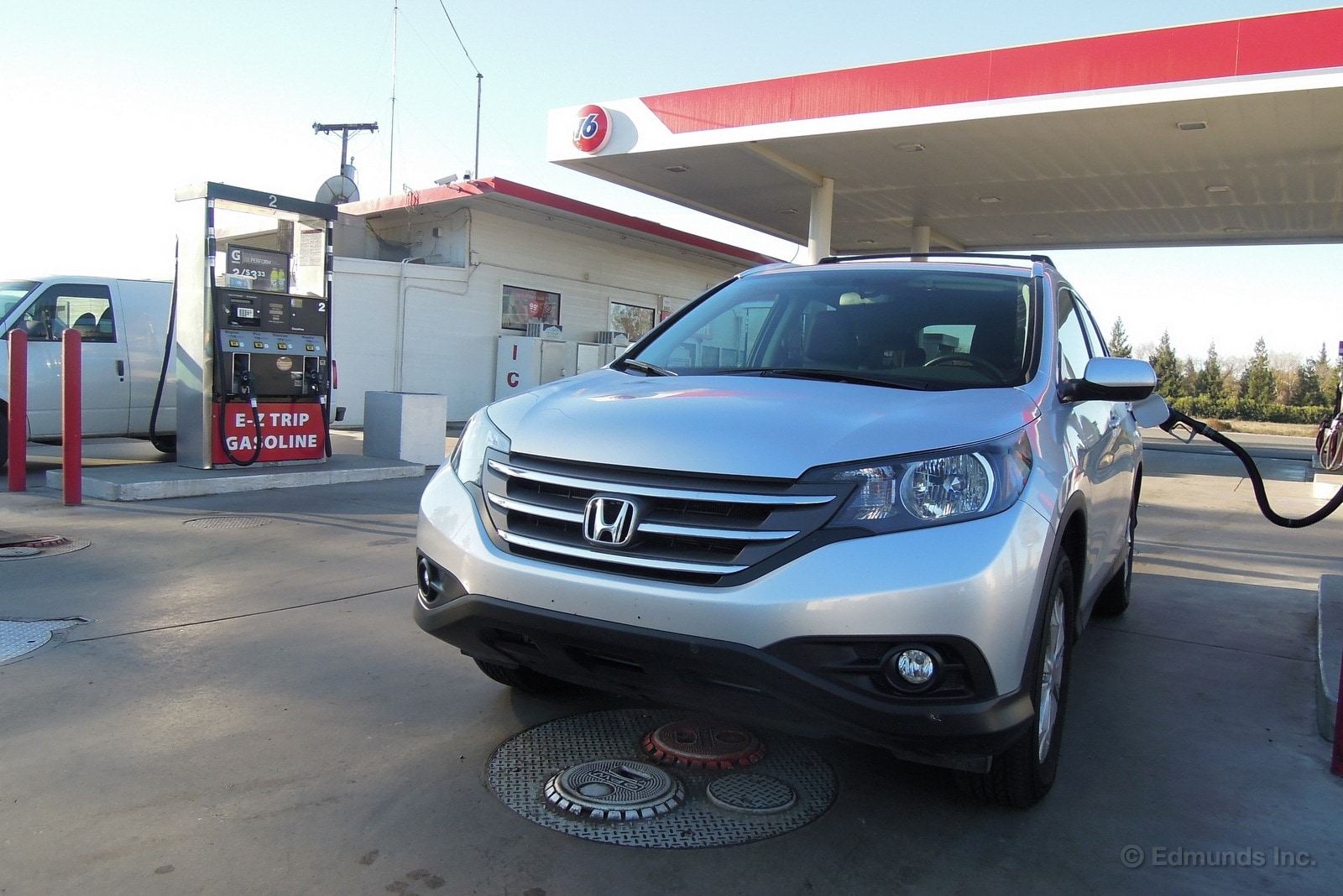
We continue to rack up miles in our 2012 Honda CR-V, adding about another 1,400 in January. These were largely miles commuting around Los Angeles, unlike in December when Dan Edmunds used the CR-V for a trip to Arizona.
Even so, the CR-V averaged about 26 mpg, which is even a bit better than its 25.2 mpg lifetime average (and 25 mpg EPA combined estimate).
Worst Fill MPG: 17.1
Best Fill MPG: 31.3
Average Lifetime MPG: 25.2
EPA MPG Rating (City/Highway Combined): 25
Best Range: 389 miles
Current Odometer: 16,445 miles
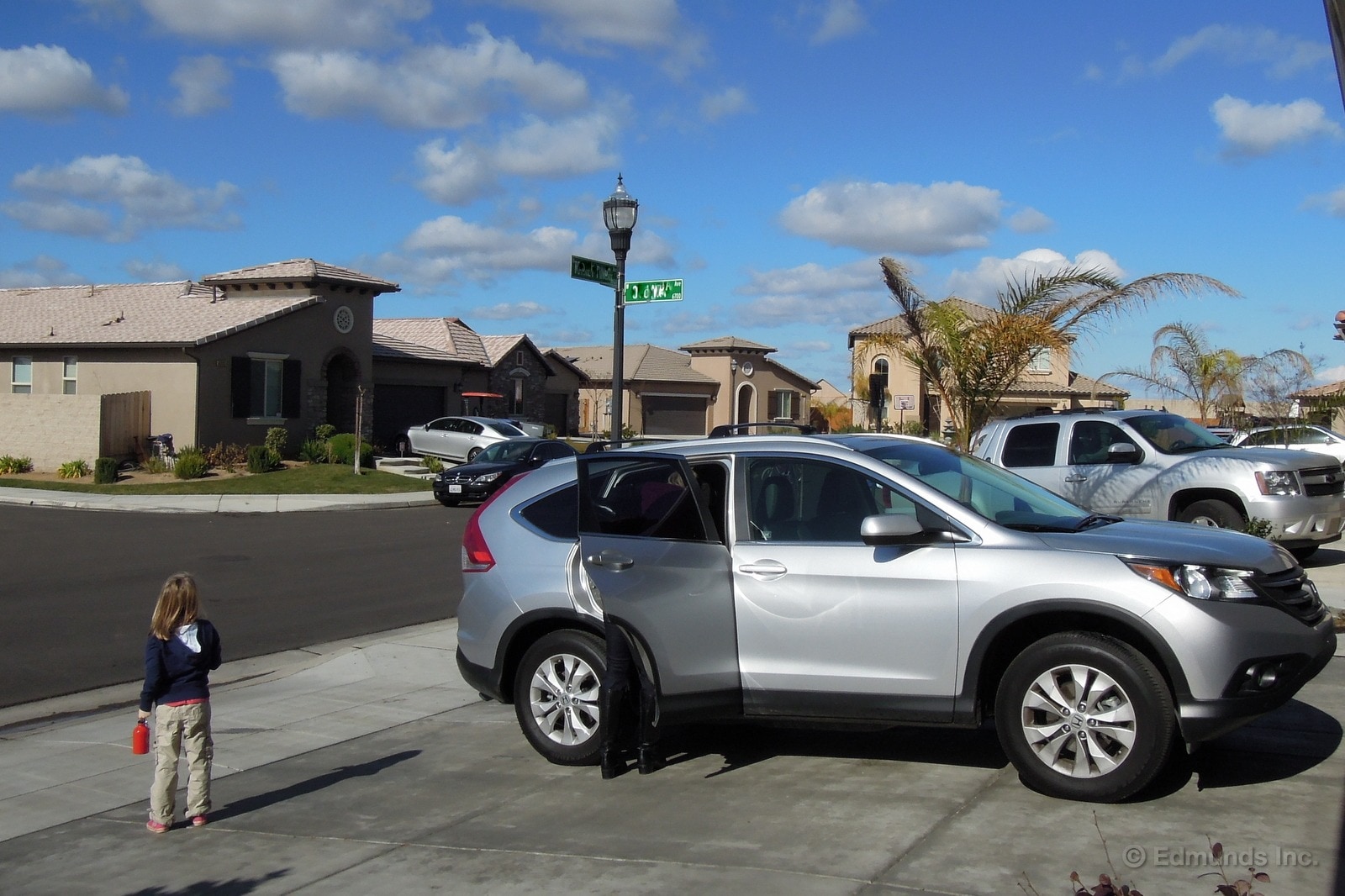
I'm 40 years old, married, have two kids and live in suburbia. I'm guessing that's close to Honda's target demographic for its CR-V. So it's with some interest that I've been observing how the CR-V fits into my life. For the span of 24 hours, I figured I'd jot down what I did with the Honda. In hindsight, it was all pretty mundane and could have really used some Kiefer Sutherland-style cliffhangers. But it did show off the CR-V's suite of strengths.
First up was packing up the kids for a morning trip to Target. The 2012 Honda CR-V's rear doors, though not shown in the above photo, open quite wide, and that makes getting the kids in and out easier.

Once at Target, the CR-V's 37 cubic feet of luggage space behind the second-row seats was more than enough for all of the stuff we bought. Throwing the Target bags into the back was also quite easy thanks to the CR-V's low lift-over height.
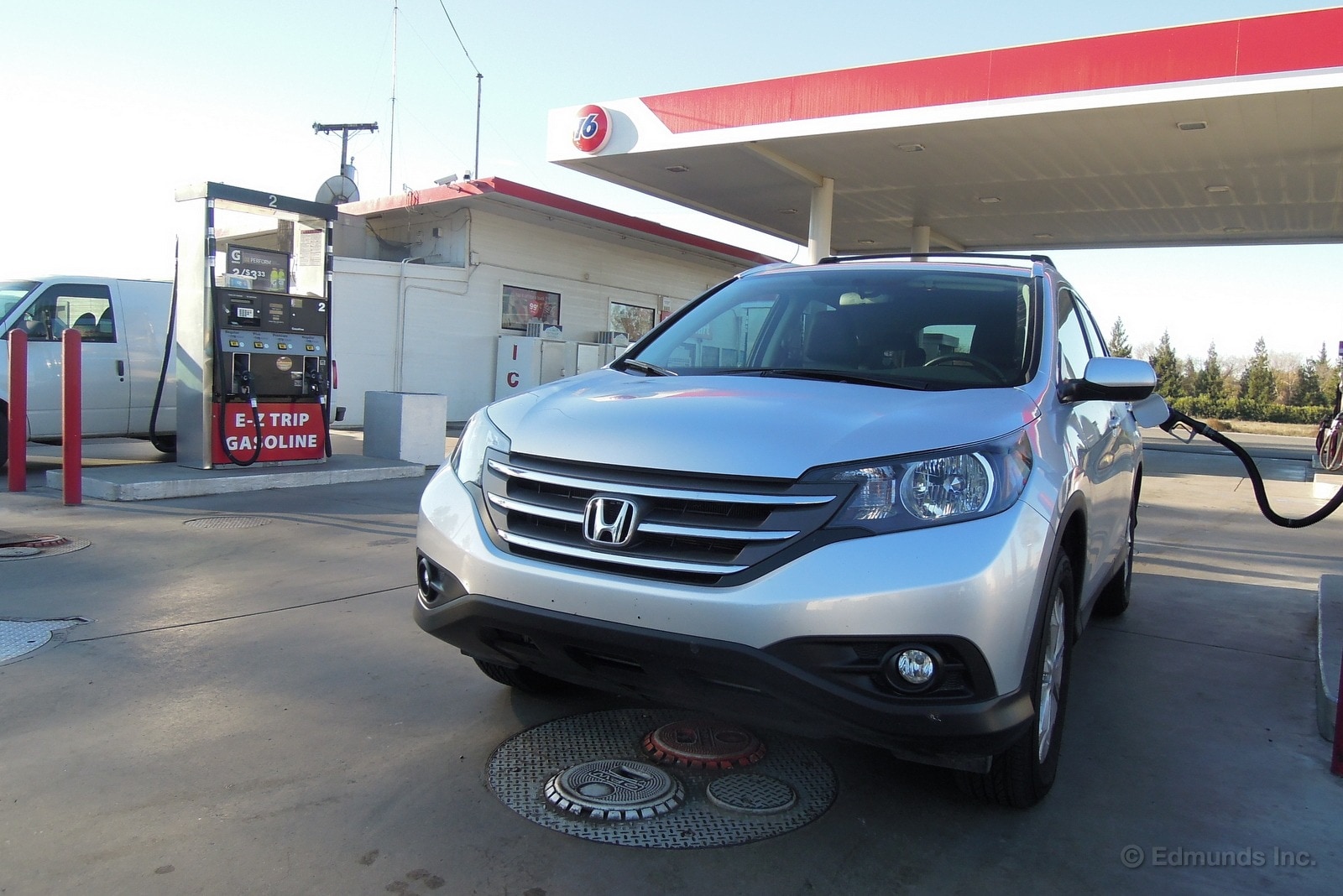
Next, it was time to fuel up. Not having an available V6 is a common knock on the CR-V, but you can't complain about the fuel economy. We're averaging 25 mpg after 16,000 miles, which is spot on with the EPA combined average.
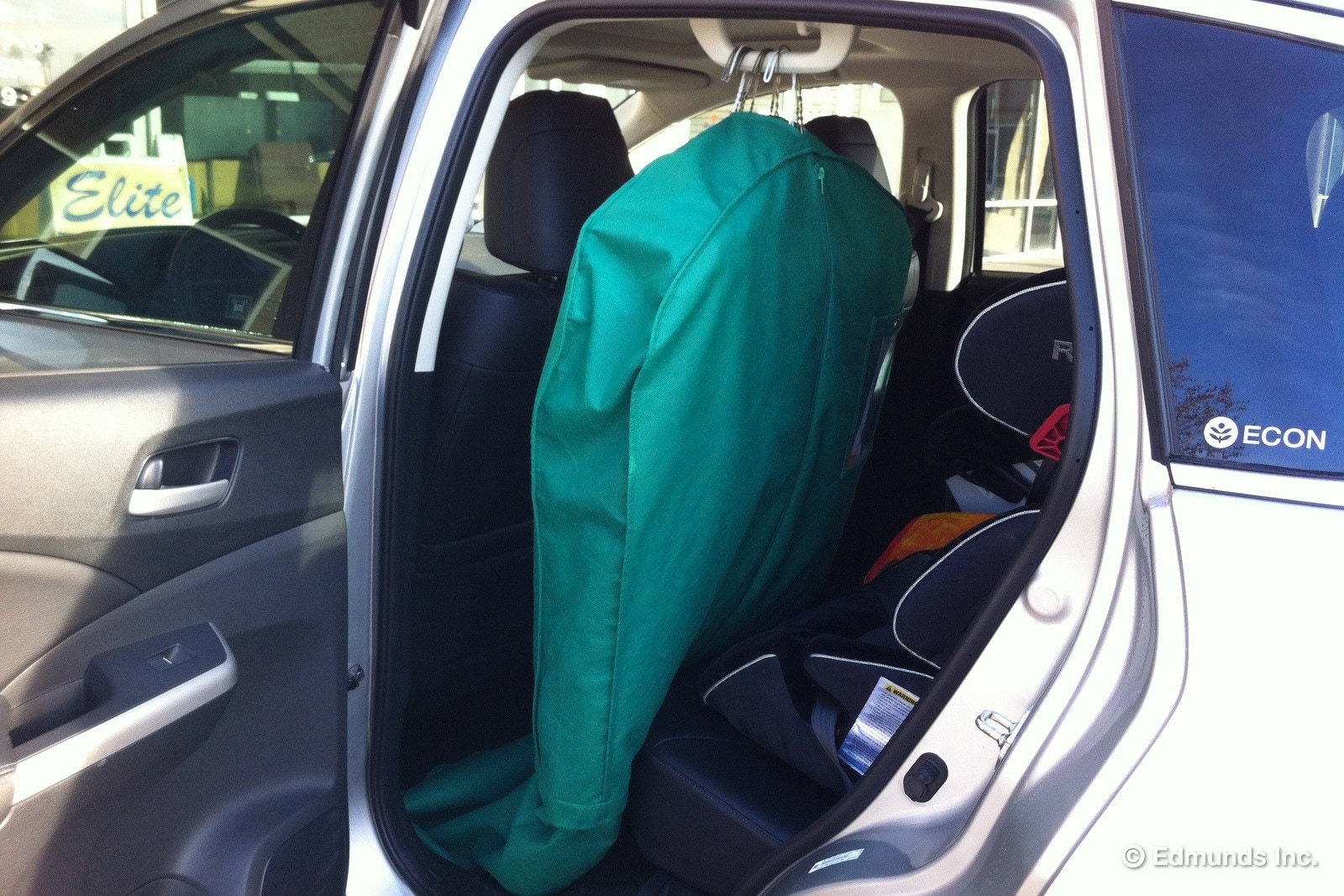
By now Kiefer would have shot some terrorists and disarmed a bomb. Me? I picked up clothes from the dry cleaners. Notably, the CR-V's rear grab handles come in handy for hanging big groups of clothes hangers.
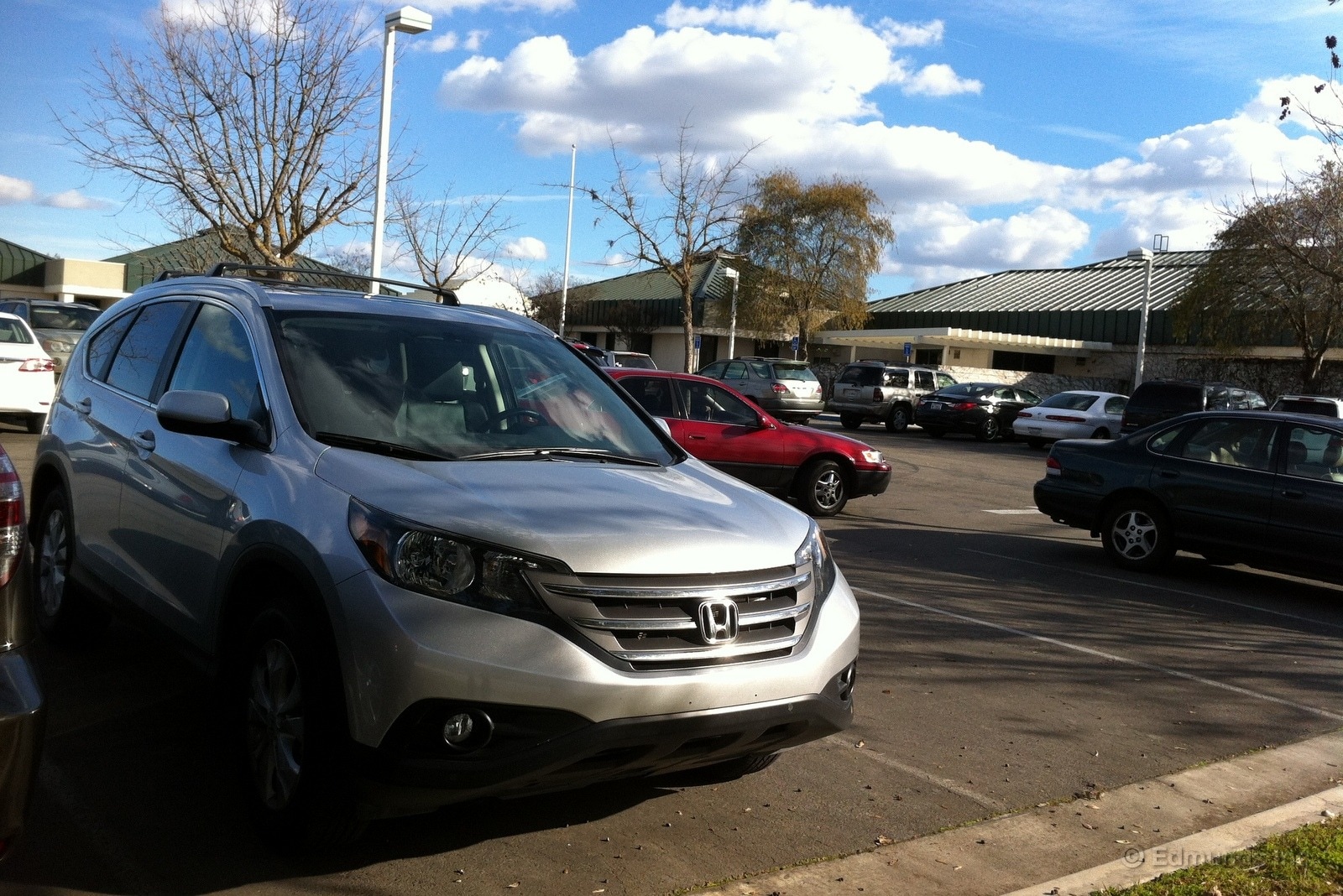
Early the next morning I took my daughter to her elementary school. The CR-V is nice because it's relatively small and nimble (compared to the typical large SUVs or crossovers that people have at the school) and easy to park. The standard rearview camera also provides extra piece of mind when backing up in case there are children about.
So again, all pretty mundane stuff. But we can't all be Kiefer, and in that case the CR-V is there for you.
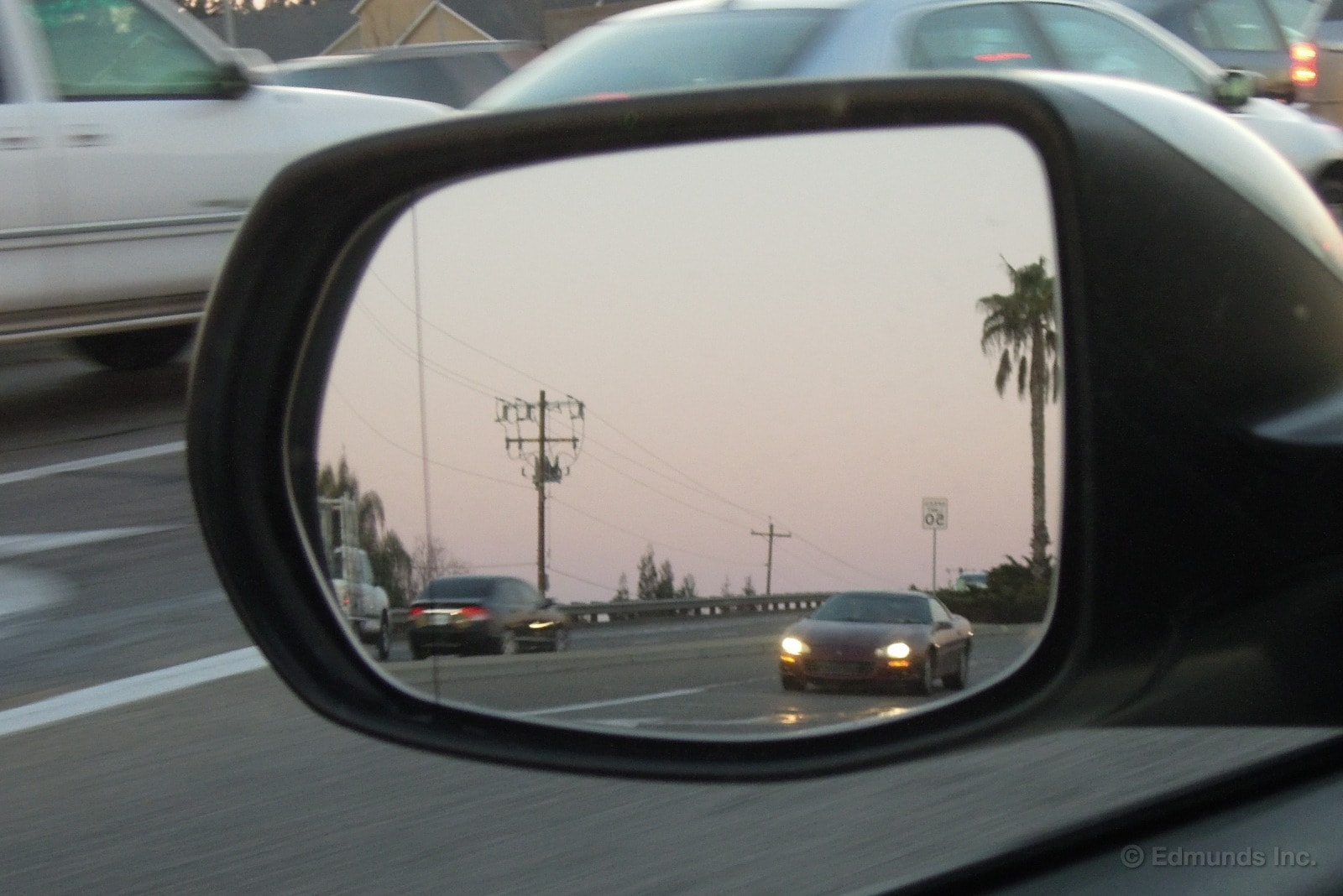
We've previously written a couple of entries about our long-term 2012 Honda CR-V's blind-spot driver-side mirror. Neither was favorable. Kelly Toepke wrote that it reminded her of bifocal glasses, while James Riswick observed that Ford's blind-spot mirror design works a lot better. You can add me in to the mix as an editor who's unmoved by our CR-V's mirror design.
This would seem to be a fairly minor thing, and perhaps it is. But I was also thinking recently how my 67-year-old mom really likes the blind-spot detection system on her Ford Fusion. For a lot of drivers, I think blind-spot detection systems are great. But you can't get one on the CR-V. And that, I think, is important.
You can get such systems on a few other top small crossover SUVs, including the new Ford Escape, Mazda CX-5 and Toyota RAV4. While all of these models are excellent, your final shopping decision could come down to something like blind-spot monitoring feature availability.
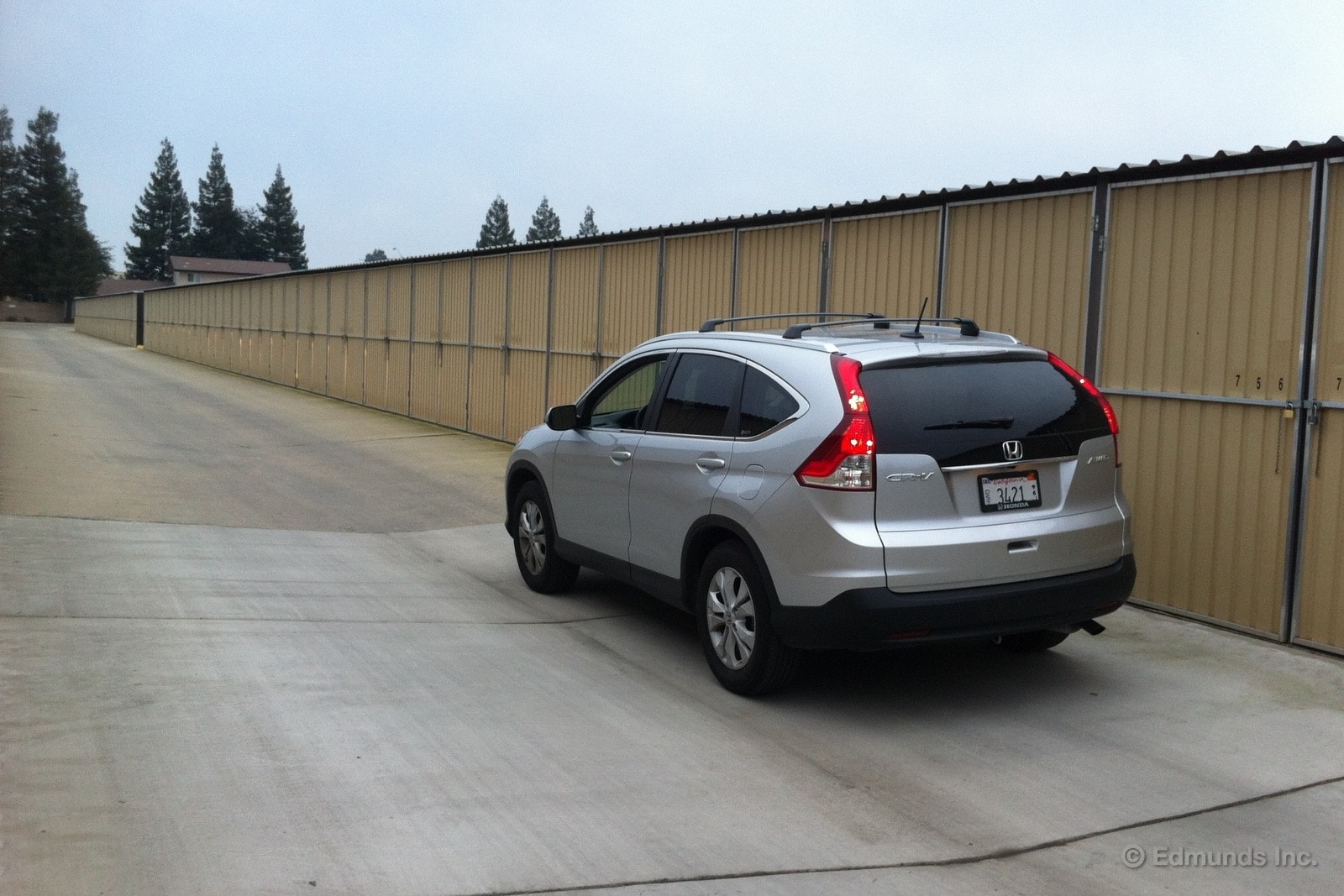
The home I live in doesn't have a basement. Actually, few California homes (where Edmunds is based) do. So when it comes time to store my, err, stuff, I have to rent a storage unit. And this is where vehicles like our 2012 Honda CR-V are so great for me.
I'm often shuttling bins and boxes between the storage unit and my house, and the CR-V makes it easy. The spring-loaded fold-down rear seats are there for a quick transition from people to cargo hauler. There's also the low load floor and 70 cubic feet of space, which is among the roomiest you'll find in a small crossover (and more than enough for what I'm typically moving back-and-forth).
Yet when I'm done using the CR-V as a beast of burden, it easily transitions back to being a daily-use vehicle. It's not the most exciting vehicle in our long-term fleet, but for me our CR-V offers excellent utility and practicality.
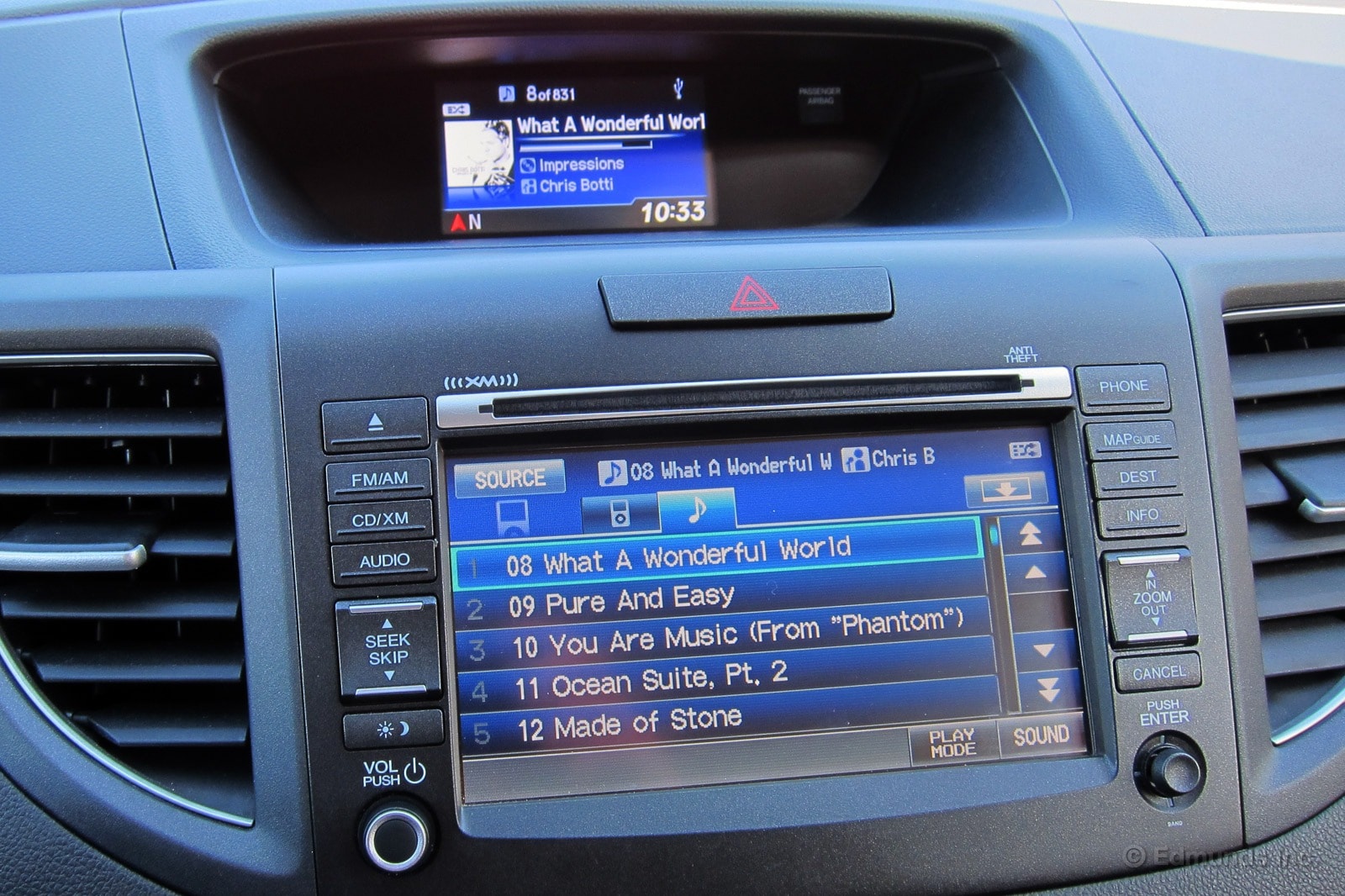
I like that the display in our Honda CR-V shows me the next few songs that are coming up on my iPod. Working in an open floor plan like we do at Edmunds, I have a lot of "writing music" on my iPod. When I'm in the car I like to shuffle all of my songs. So I spend a fair amount of time skipping tracks.
Ocean waves and classical music are great for drowning out noise at the office, but not exactly rocking tunes for the commute home.
Seeing ahead I get to skip more than one track at a time, or at least know what I'm in for.
My pet peeve with the CR-V? The stubby USB connector cord is hard to reach within the deep center storage console. It makes it awkward to plug in my iPod with one hand as it keeps moving around. I'd rather have a longer cord so I can use both hands or just a flush-mounted jack that isn't a moving target.
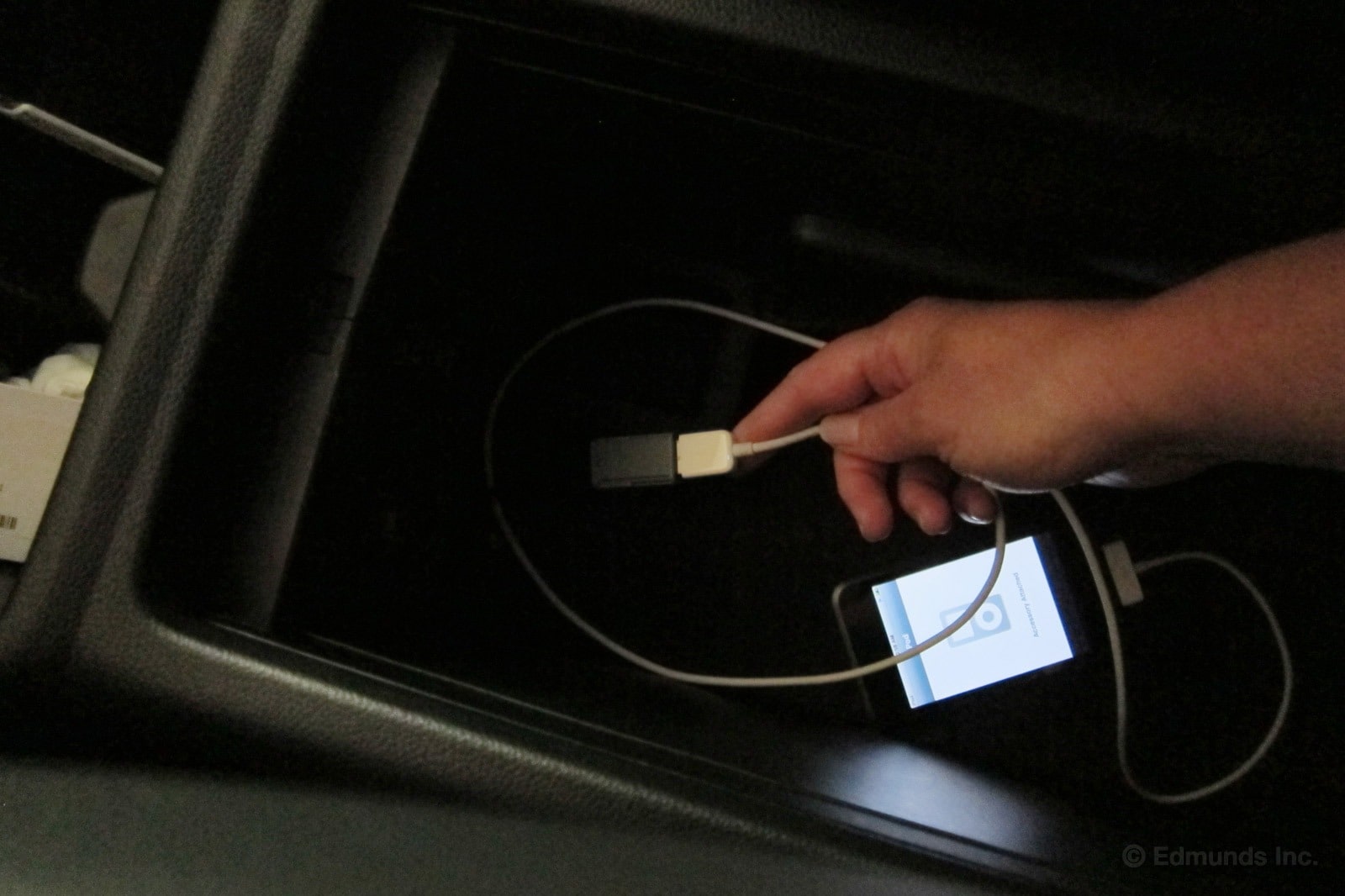
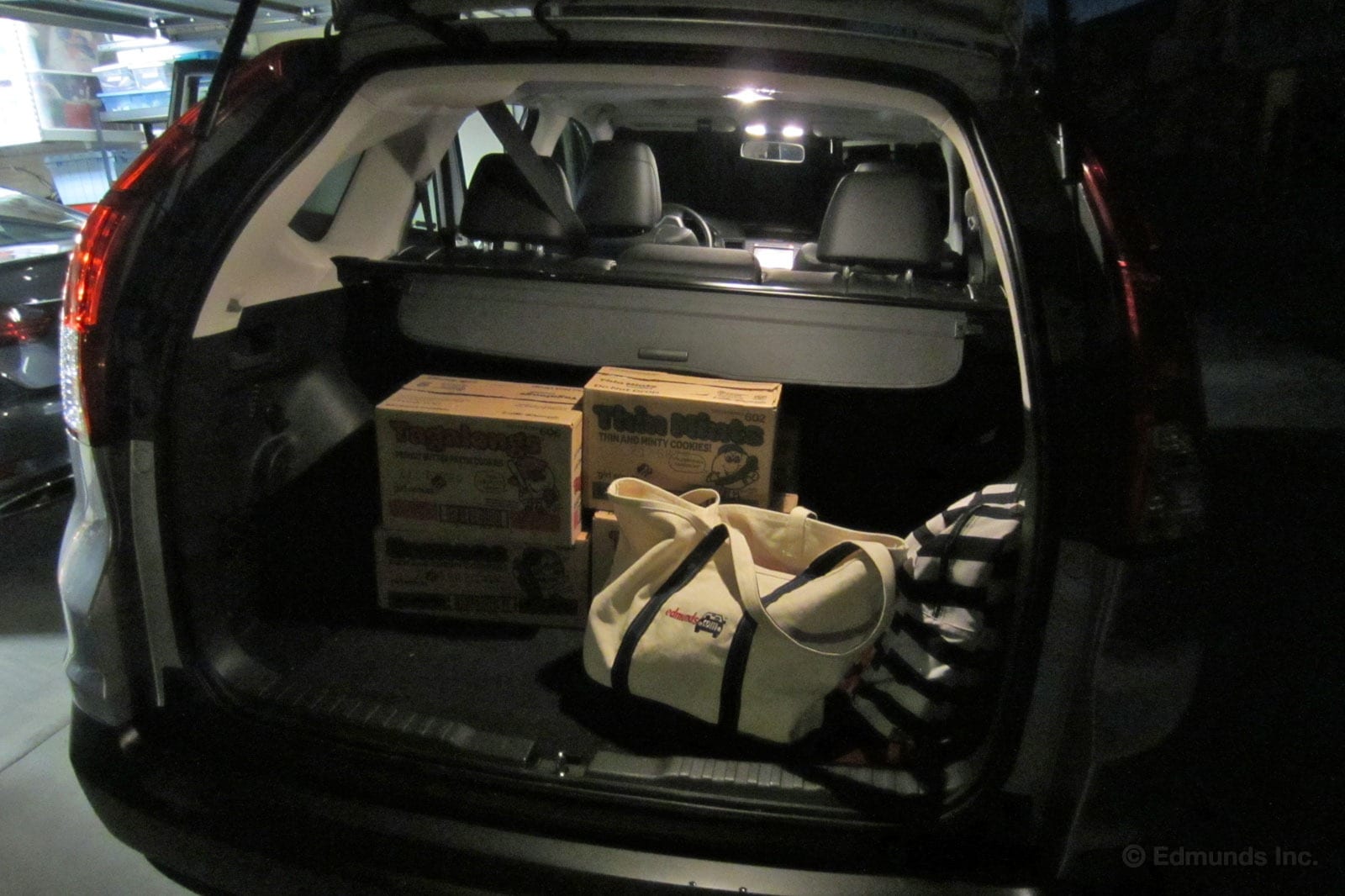
When your daughter's sales goal is 500 boxes, she doesn't care that the call for more Girl Scout cookies comes at 11:00 p.m. She's happy for the order.
And you're doubly pleased to have the handy 2012 Honda CR-V crossover already backed up to your garage.

There are plenty of minivans and large SUVs filing through the school parking lot, but when it comes to carpooling two middle-schoolers, our 2012 Honda CR-V offers a full range of amenities.
During the six-mile, 20-minute drive, the girls spread out their breakfast fixings, charge their iPhones in the front center console, and loudly read off the name of each song that appears on the CR-V's stereo display.
After we pull into the school's circle drive, they jump out, easily grabbing their backpacks through the rear hatch.
That's when I throw away their trash, restore the iPod charger, and regain my sanity.
Until the afternoon.
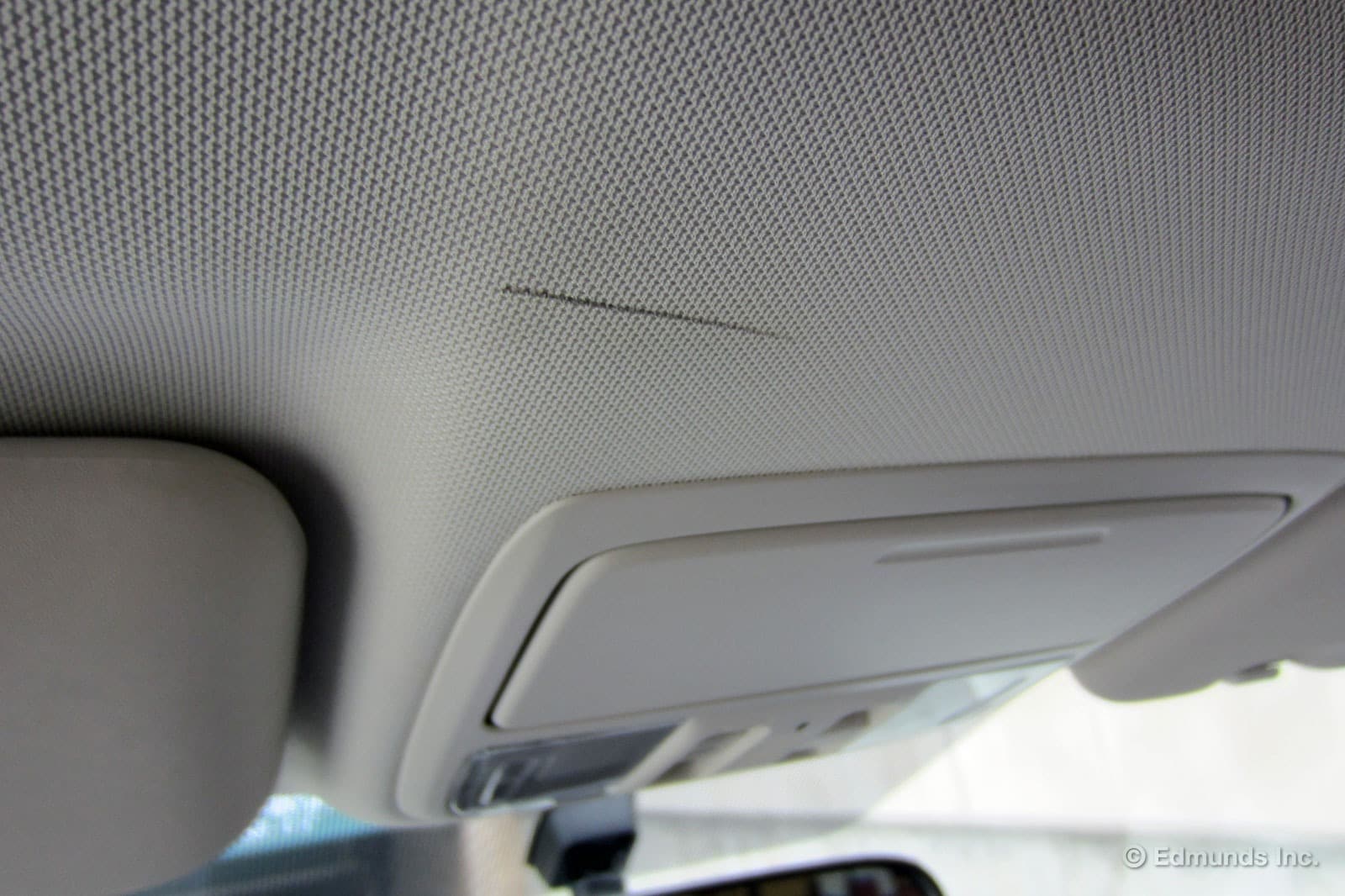
This weekend I noticed there was a long, dark pen mark on our 2012 Honda CR-V's light gray headliner.
I resisted taking a cleaning solution to it right away, afraid I'd make a bigger spot.
What have you used to safely remove stains from your car's interior fabrics?
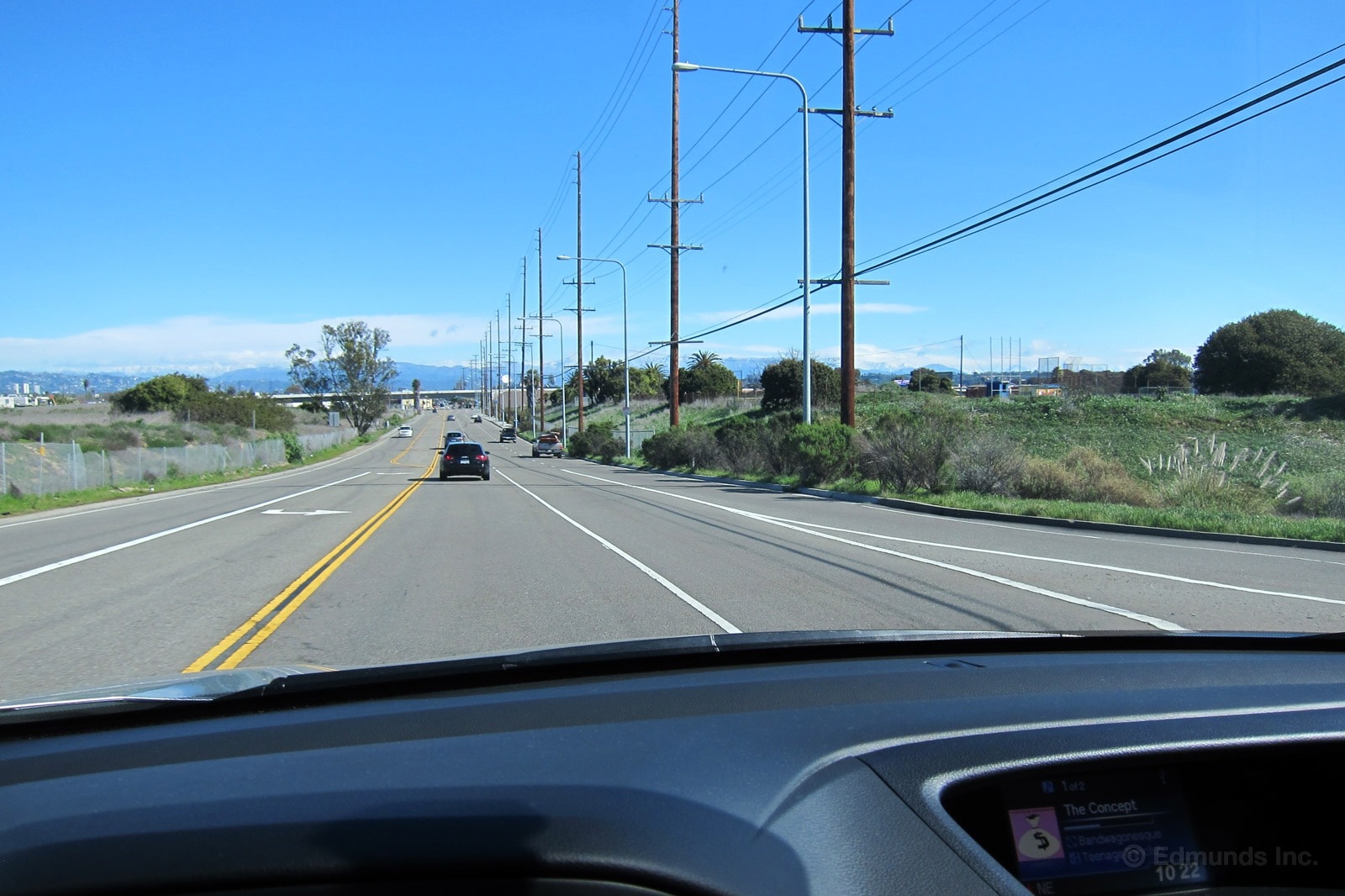
It's nice to be able to see out the front of a car. Modern cars are stuffed full of airbags and the pillars can greatly reduce visibility.
I appreciate the added safety features, of course. But it's refreshing to have a wide, expansive view out the windshield, like in our 2012 Honda CR-V.
We had a rainy, windy night last night and it blew out all the stink. You can actually see the snow-capped mountains in the distance. Most days you wouldn't know there are hills out yonder at all.
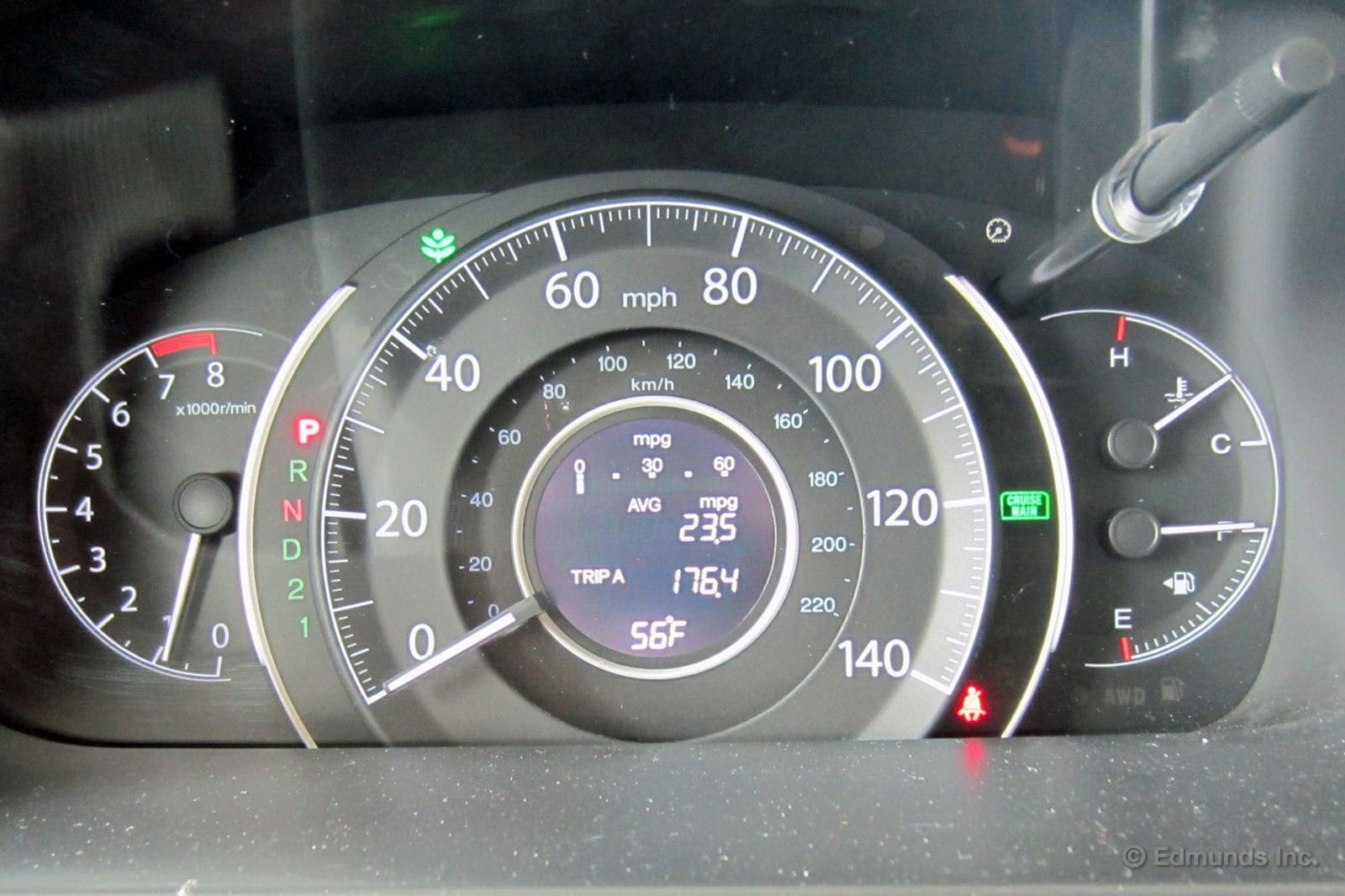
My daily commute is 37 miles each direction, and typically includes several stretches of stop-and-go freeway driving.
One way I entertain myself is trying to better the instant average fuel economy. Today I took the 2012 Honda CR-V from 19.5 mpg to 23.5 mpg.
Tonight someone else from our staff will drive it less frugally, and it'll be back in the 19s.
Sigh.
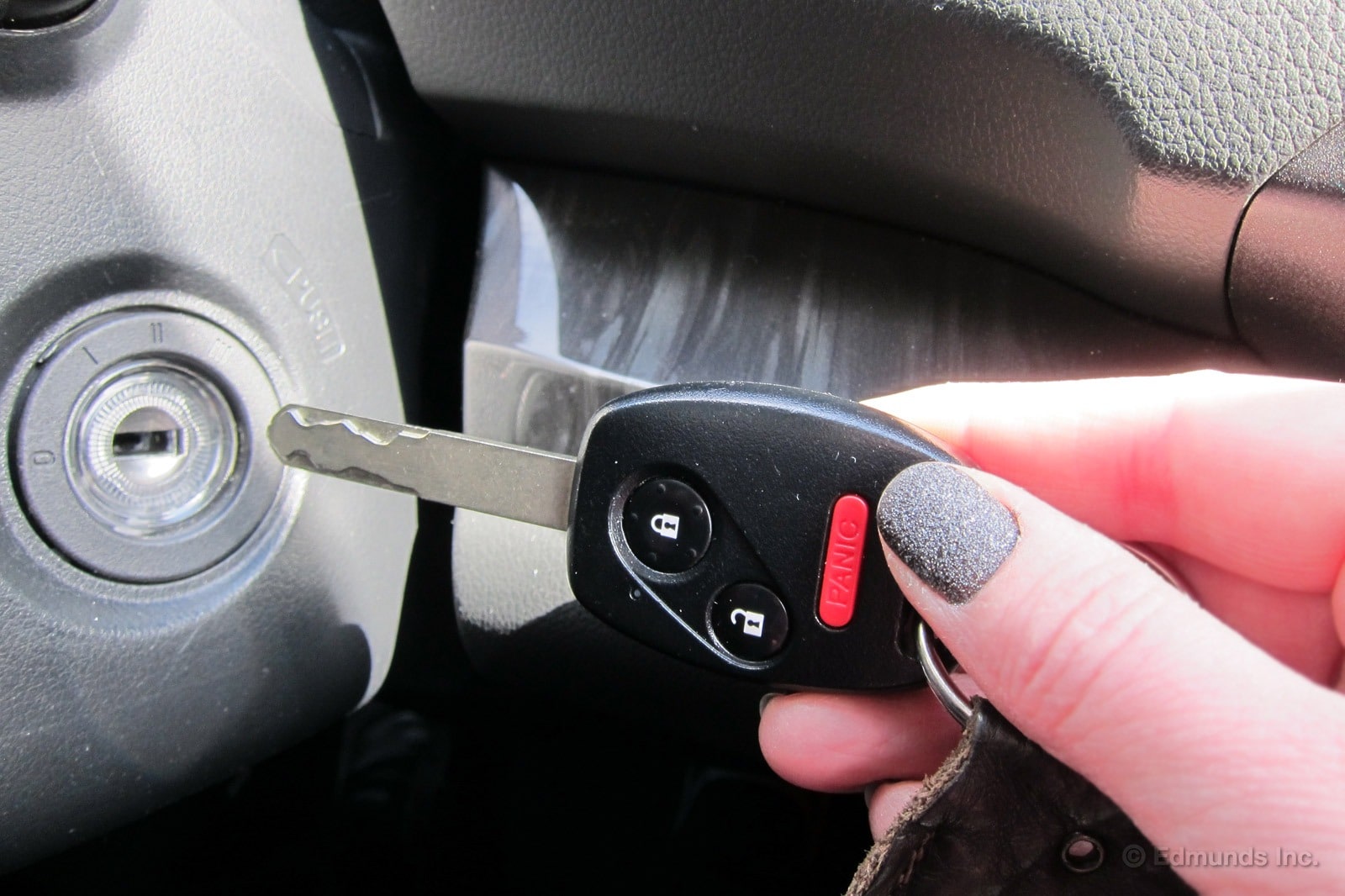
Look, the 2012 Honda CR-V has a real old-fashioned key. Well, not completely old school as it has buttons to lock/unlock.
But I mean the design. The key itself doesn't fold away into a piece of plastic. And it has a metal key, not just a plastic fob.
It takes up space in my purse.
Which type of car key do you prefer, truly old school like our Buick Grand National, sleek and modern like our Porsche 911, or can't-miss-it like our Honda CR-V?
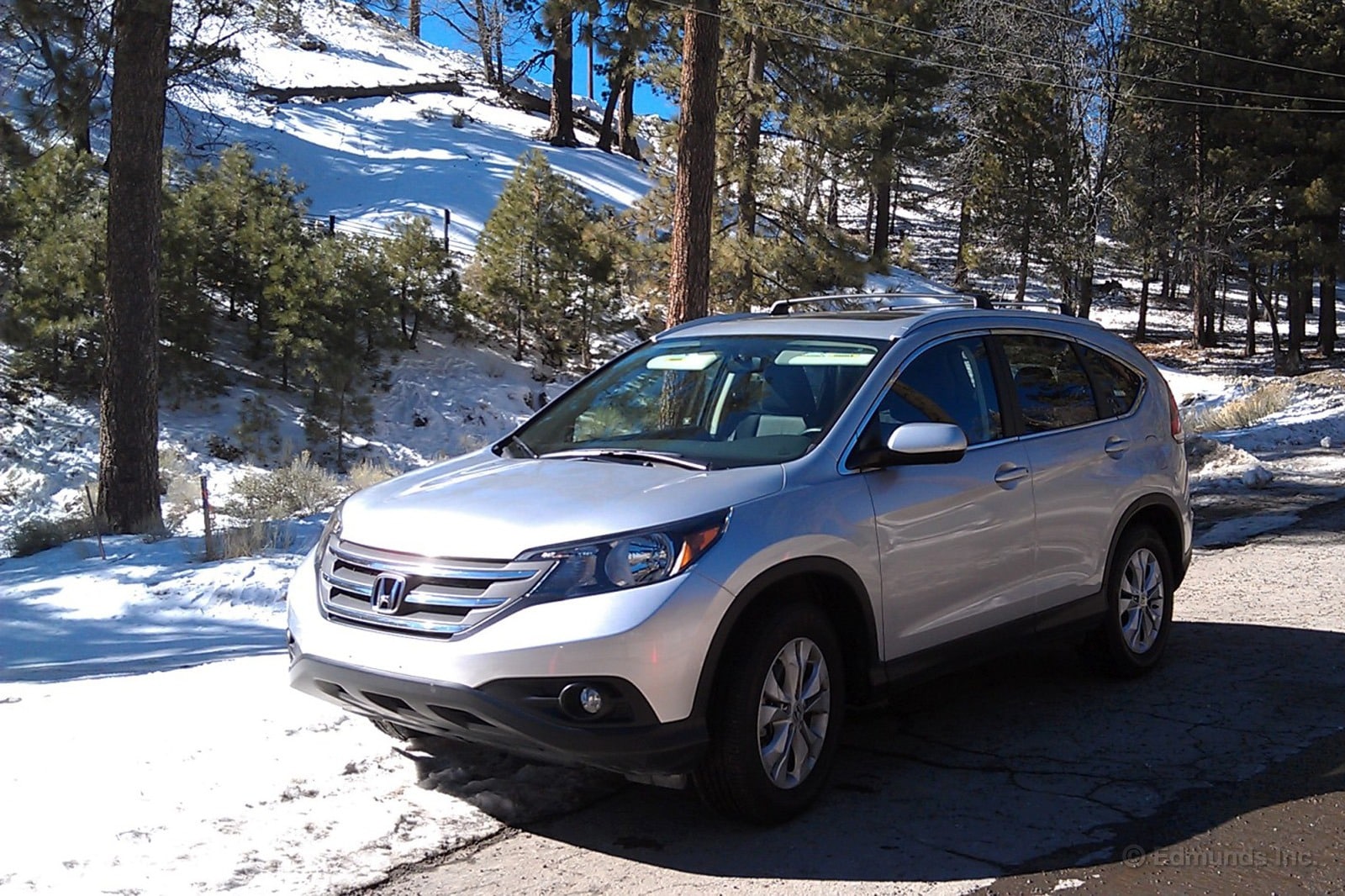
I've driven a lot of crossover SUVs, ranging from small ones like the Kia Sportage to biggies like the Chevy Traverse. Of them all, the Honda CR-V seems to strike the best balance between being small enough to be fuel efficient and easy to park, while being large enough to provide a spacious rear seat and generously sized cargo area.
With an overall length of 178.3 inches, the CR-V slots in between the truly compact Hyundai Tucson (173.2 inches) and the more midsize than compact Chevy Equinox (187.8). Rear leg room is good for all, as it measures 38.3, 38.7 and 39.9 inches, respectively among the three.
In maximum cargo space, however, the Honda beats them soundly with 70.9 cubic feet against the Tucson's 55.8 and the Equinox's 63.7 cubes. It also boasts the highest fuel economy as well, rating 25 mpg in combined driving to the Hyundai's 23 and the Chevy's 23.
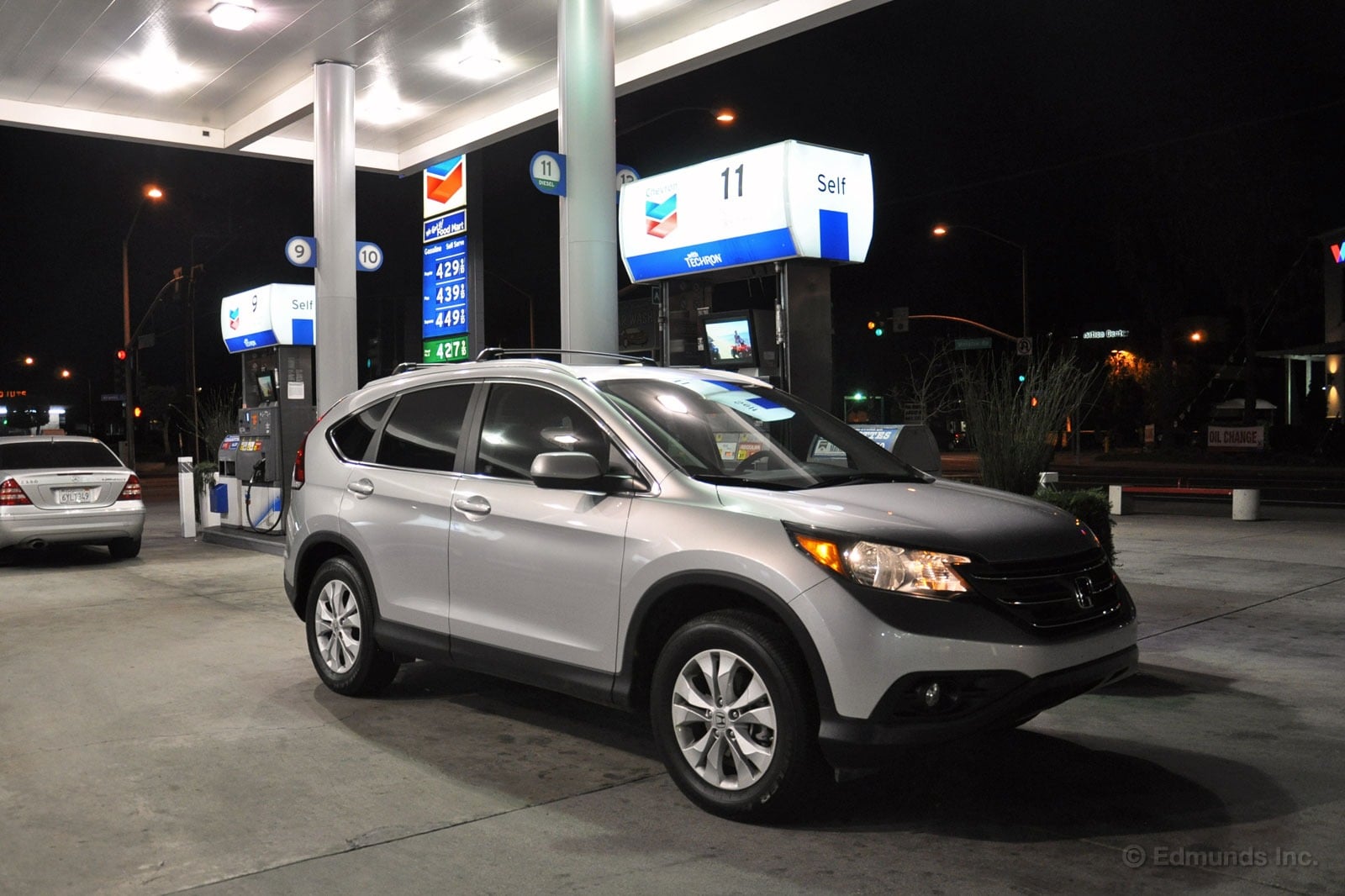
Our long-term 2012 Honda CR-V continued to rack up mileage at a brisk pace in February. We drove 1,892 miles in our compact crossover, and with three months left in our year-long test, we might just hit 25,000 miles before all is said and done.
During February, the CR-V averaged 25.4 miles on plain old 87 octane fuel (which cost us a cool $4.30 per gallon during this last fill-up of the month). Not only is that consistent with the crossover's lifetime average, it matches the EPA's combined mpg rating for the all-wheel-drive CR-V. Not bad.
Meanwhile, our best tank of the month netted 30.2 mpg over 263.3 miles (short of our Honda's lifetime best of 31.3). February's worst tank came in at 21.3 mpg over 162.0 miles (its lifetime low is 17.1).
Worst Fill MPG: 17.1
Best Fill MPG: 31.3
Average Lifetime MPG: 25.2
EPA MPG Rating (City/Highway Combined): 25
Best Range: 388.9 miles
Current Odometer: 18,611 miles
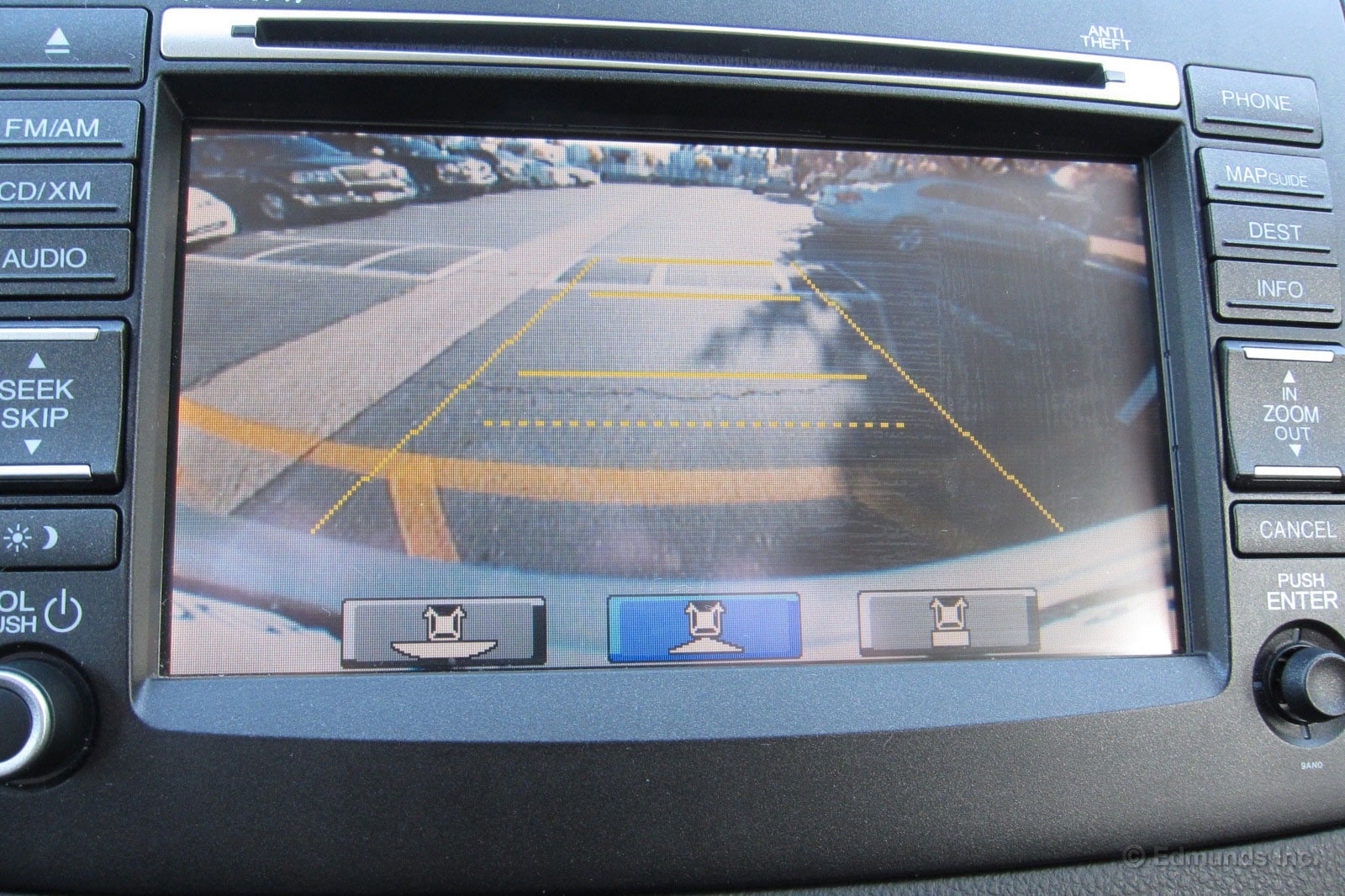
I noticed a few days ago that the CR-V's rear-view camera has three handy modes. The standard view, pictured above, shows a conventional field of view, which works for straight reversing.
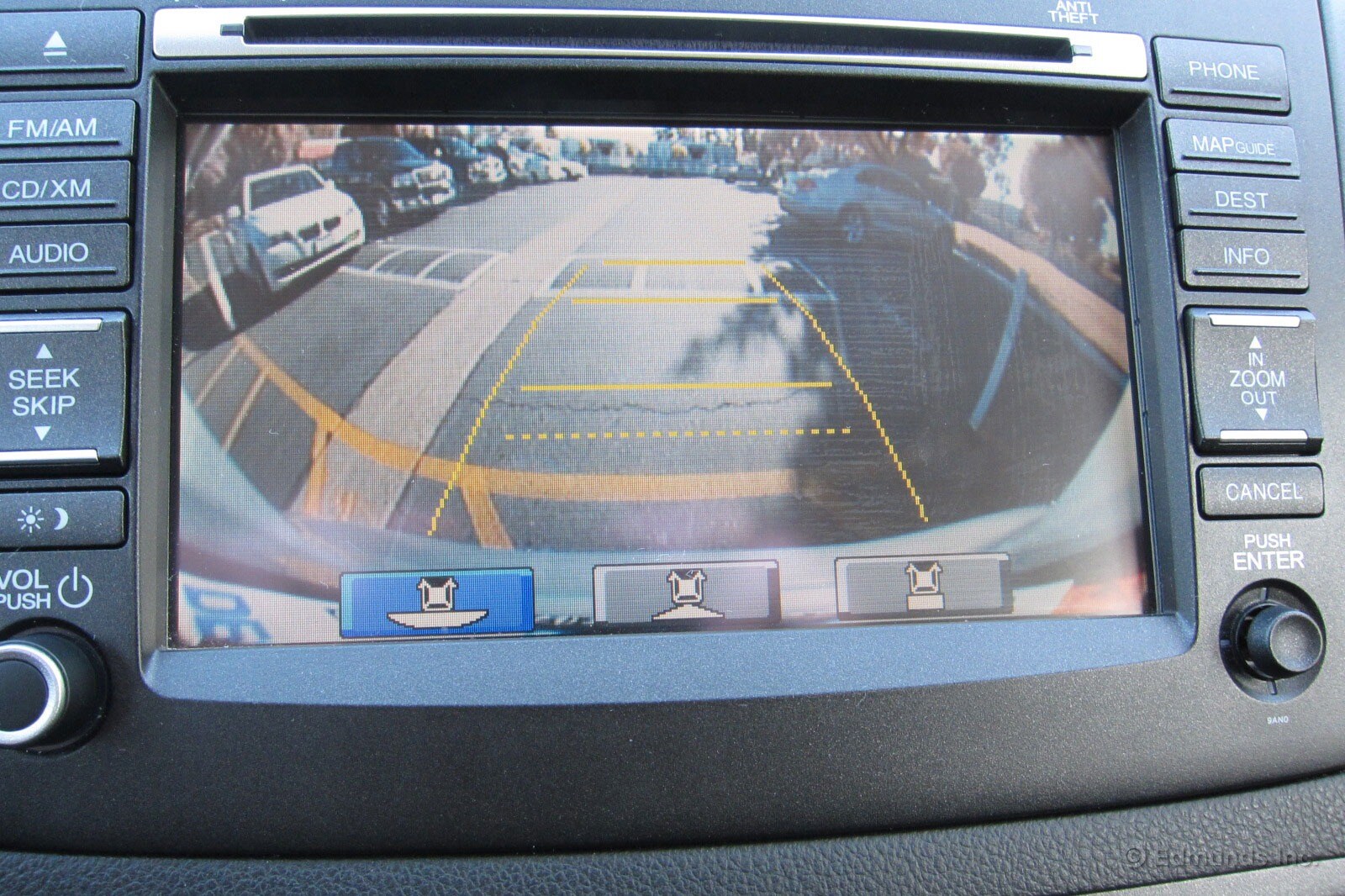
The second option is a wide-angle view which is handy for reversing through a slalom course.
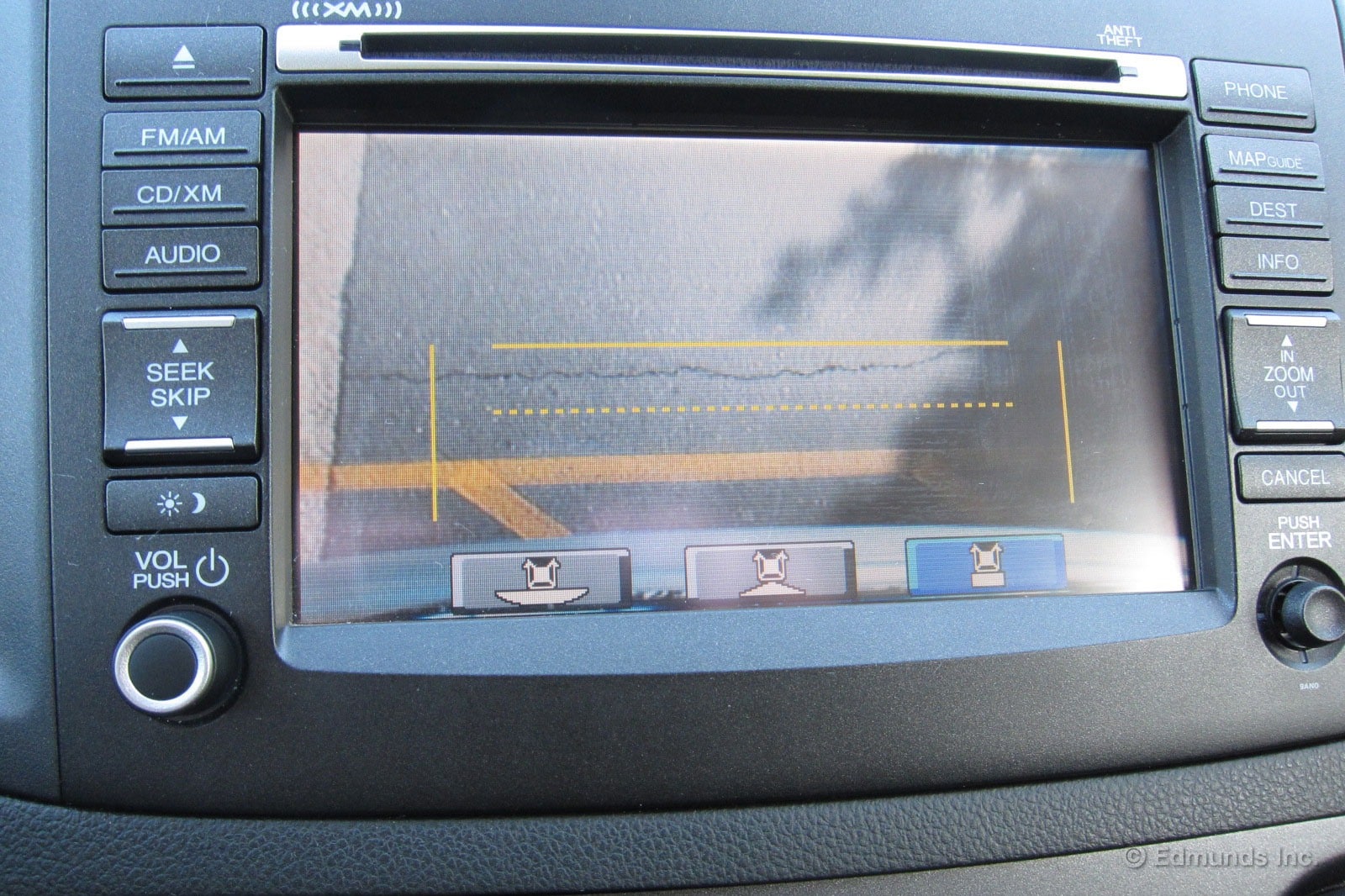
The third is a downward-facing view which allows you to sneak right up the curb or, I suppose, a trailer, should you be unfortunate enough to have to tow with your CR-V.
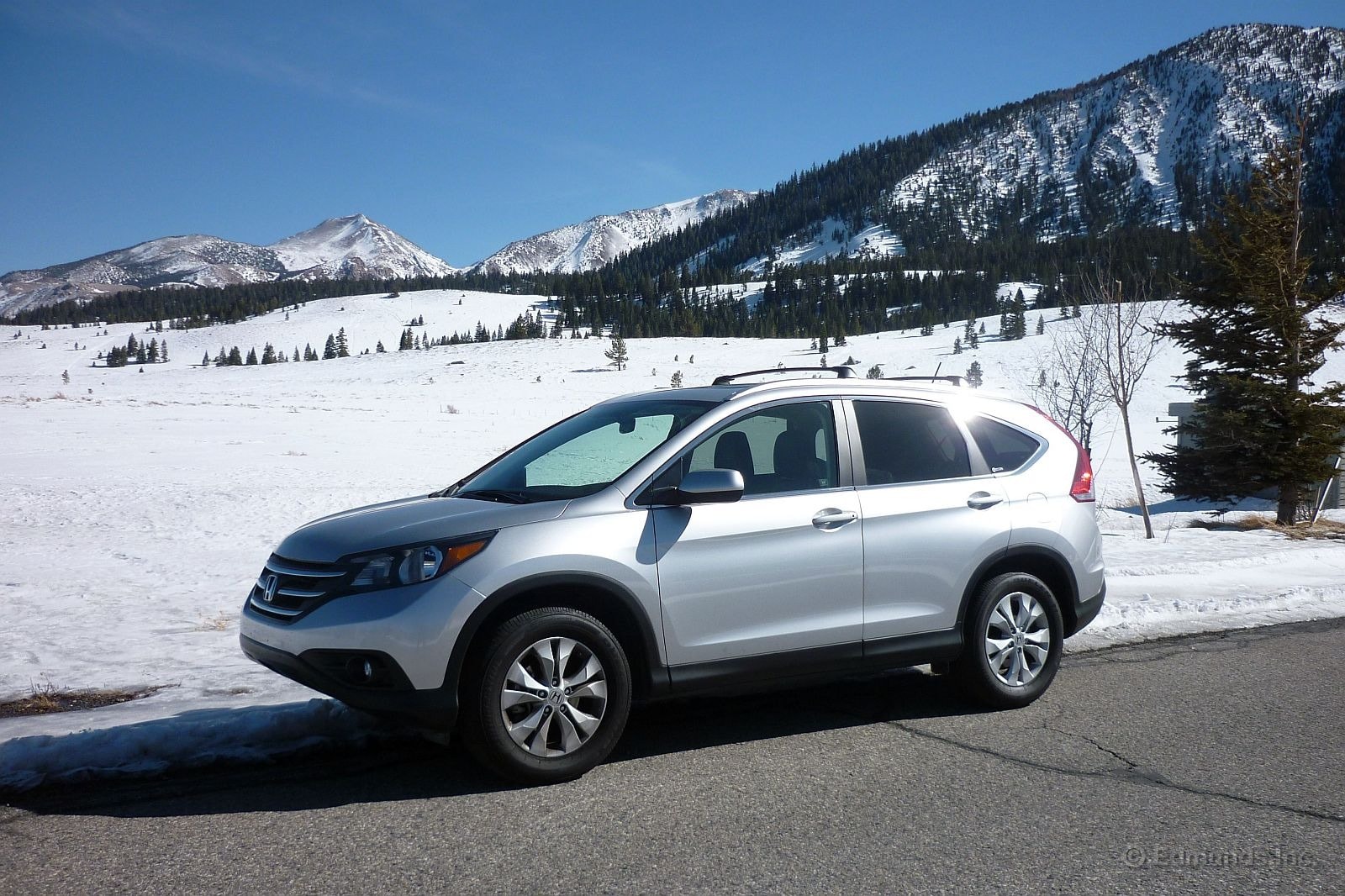
The 2012 Honda CR-V served as transportation for my recent road trip to Mammoth for a ski weekend.
It was a good choice. We didn't really need the all-wheel drive, as only a smidge of new snow fell while we were there. But it's nice to have that bit of confidence in your back pocket when you're five hours from home.
With just two of us onboard, there was plenty of room for our skis and stuff. The CR-V is a comfortable and relatively quiet place to spend a five hour drive, although road noise was a bit higher than expected.
While the CR-V has always seemed to have adequate enough oomph for getting around the general L.A. slog, out on the two-lane sections of U.S. 395, where power is required to pull out and pass 18-wheelers, the CR-V proved a bit of a dud.
My friend took to calling it the gutless wonder after a couple of what seemed like slow-motion passes. Her words, not mine. On the bright side, I guess you could say the CR-V makes passing more exciting...
Once at Mammoth, the CR-V was definitely a good vehicle for trucking us, our two friends and our four pairs of skis from the condo to the slope in the morning. Put the "40" side of the split/folding rear seat down, slide in the skis and pile in. The girls said they were a bit squished in the rear seat, but it was a short drive up the mountain.
Despite my occasional full-throttle (and then some) passing shenanigans, we averaged 28.5 mpg for the 692-mile round trip.
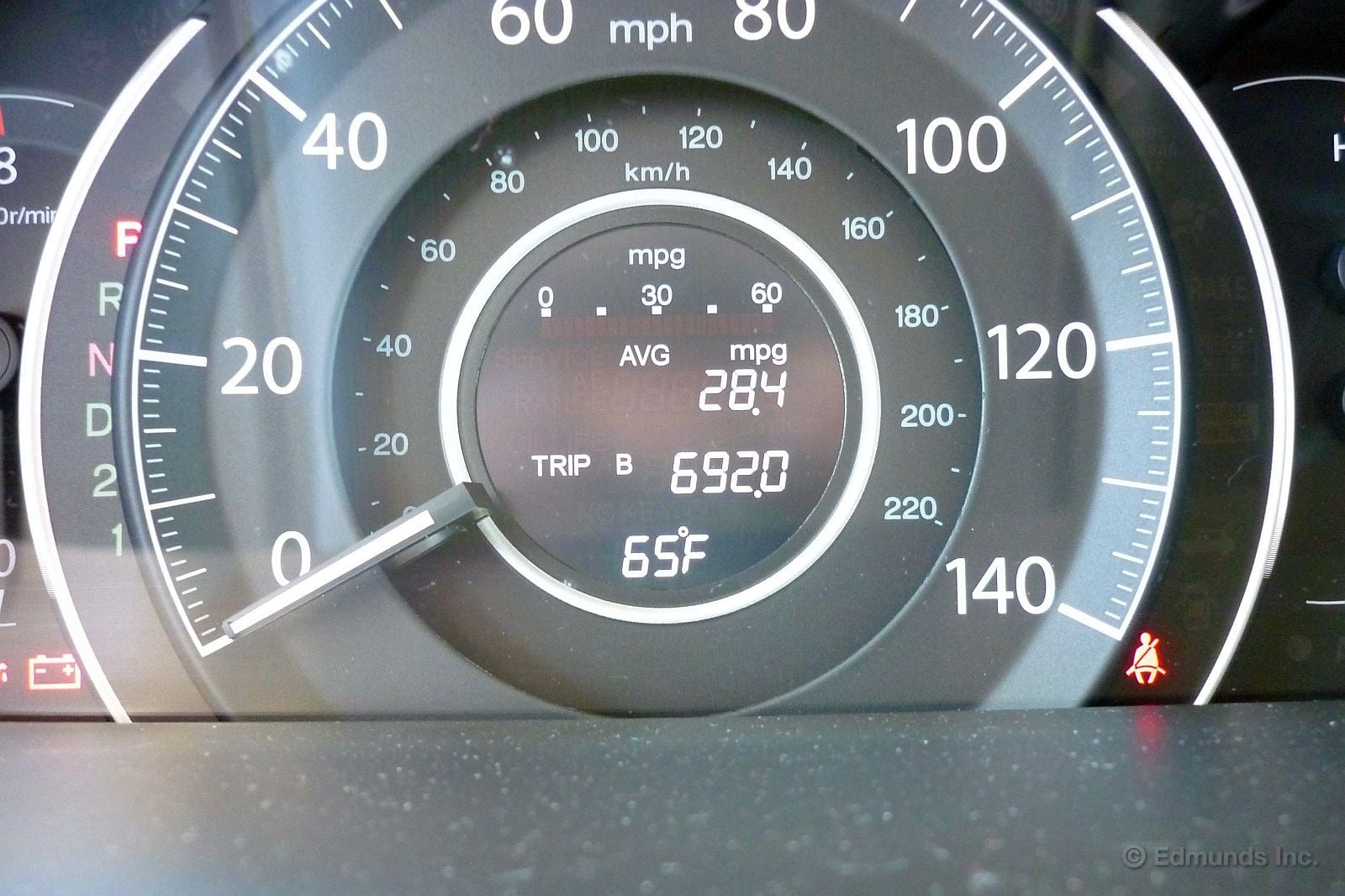
Here's something kinda cool about the 2012 Honda CR-V: An average fuel economy readout not just for Trip A, but also a separate one for Trip B.
I found this particularly handy on my road trip to Mammoth because it meant I could let Trip B keep a running tally of both miles covered and average mpg for the entire trip, while Trip A took care of each fuel fill-up segment.
This meant I could toggle back and forth while I was driving to see what I was averaging right now versus what I had averaged overall so far.
Here's some other interesting mpg-related tidbits from the trip:
First, unlike many cars, the Honda CR-V under-estimated the average fuel economy we were getting per fill-up two out of the three times.
Second, the Trip B readout said we had averaged 28.4 mpg for 692 miles. What did we average in reality? 28.5 mpg. Now that's pretty damn close.
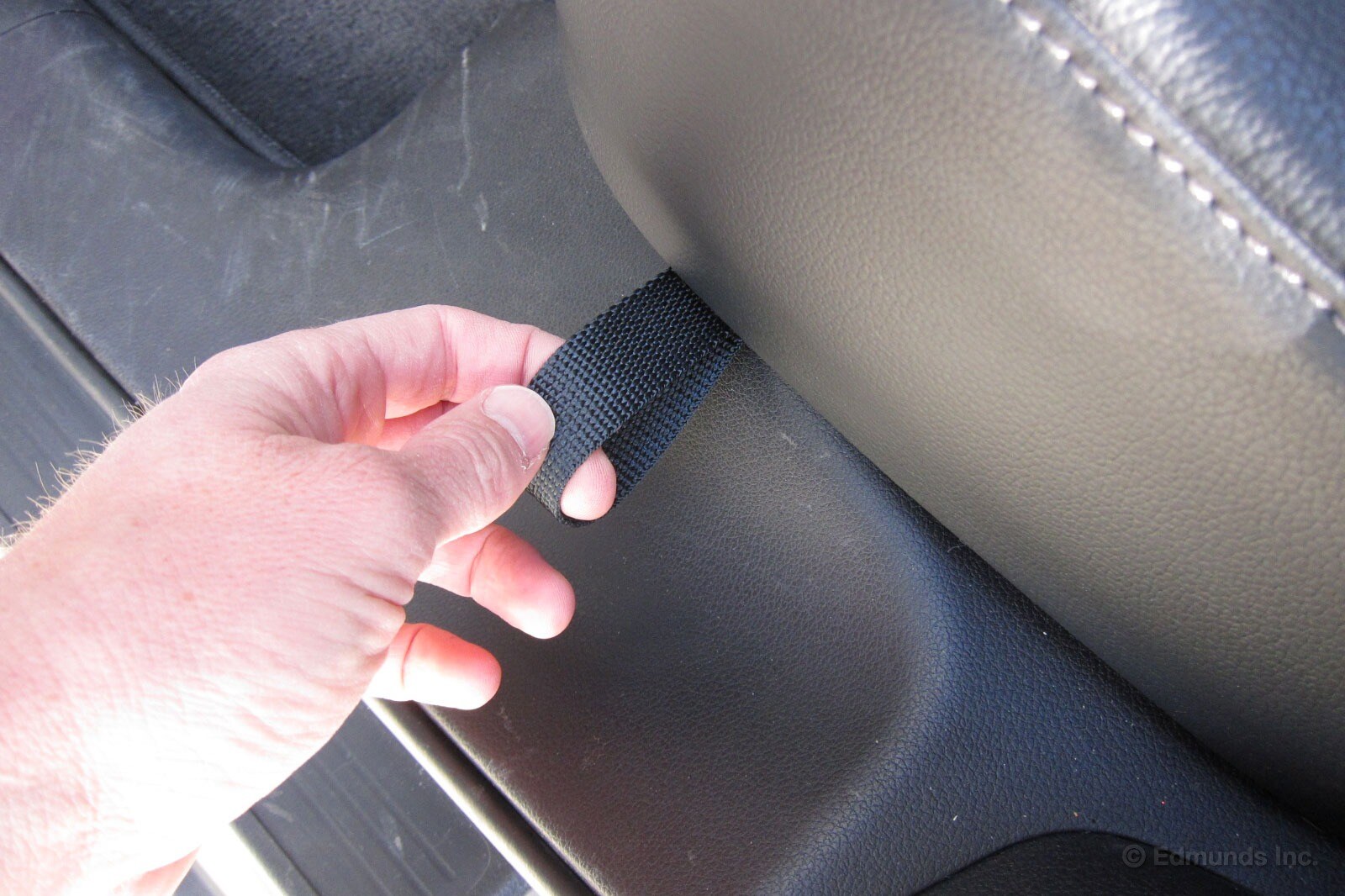
By now you know how quickly and efficiently the CR-V's rear seats can be dropped. What you don't know is that the same can be accomplished by pulling this fabric loop which sticks out from both seat bottoms inside each rear door. The tab triggers the same tumble-and-flop scenario that you'll get using the releases inside the hatch.
It's probably the best design in the segment if not in the industry. Brilliant.
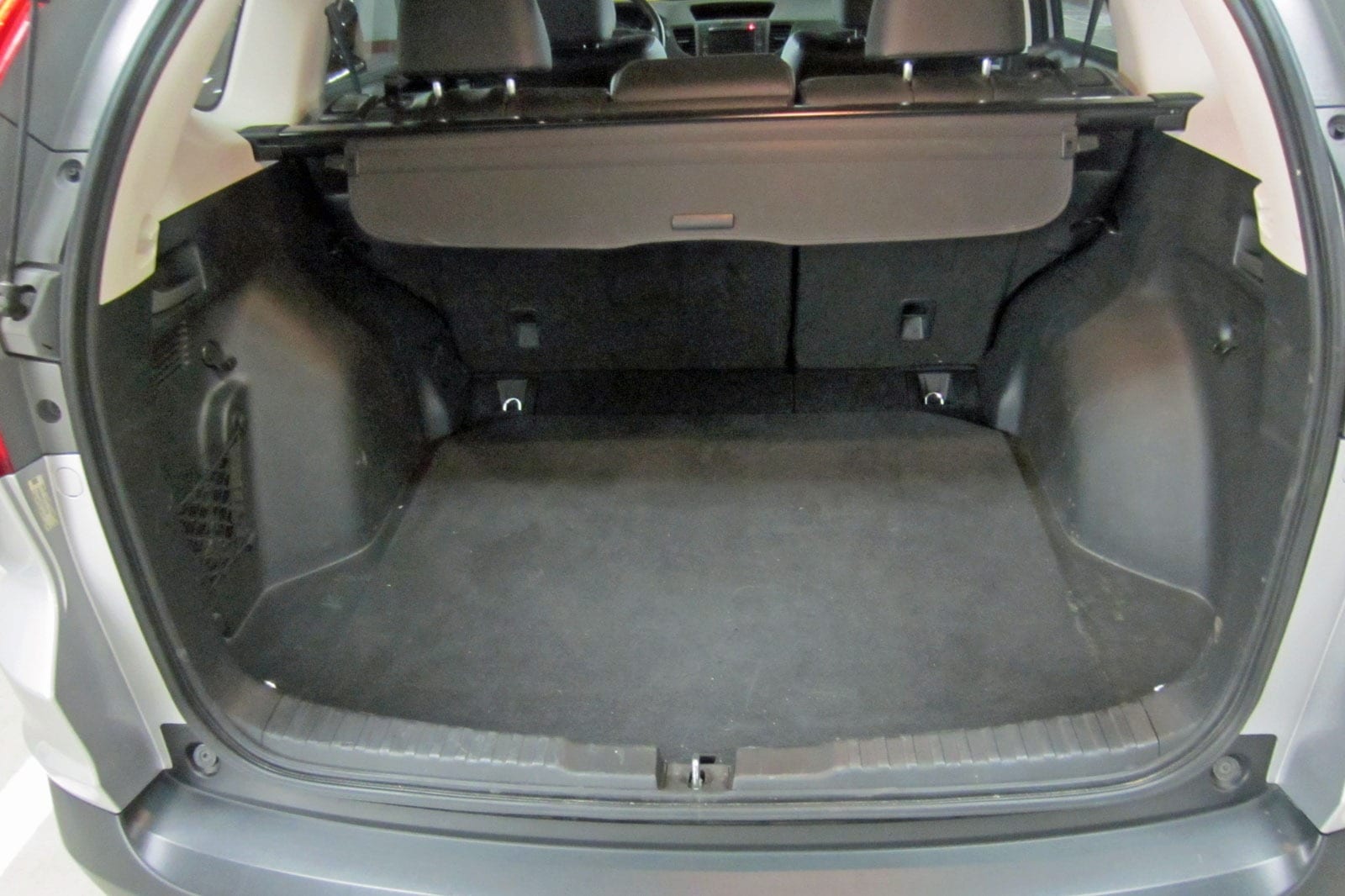
Here's the thing about our 2012 Honda CR-V's power rear hatch: It doesn't have one.
Sure, the door is lightweight and easy to open and close by hand, but with a spacious 37 cubic feet of cargo space behind the rear seats, the CR-V can handle a big load o' stuff.
It would be convenient to pop the hatch remotely as you're on the approach.
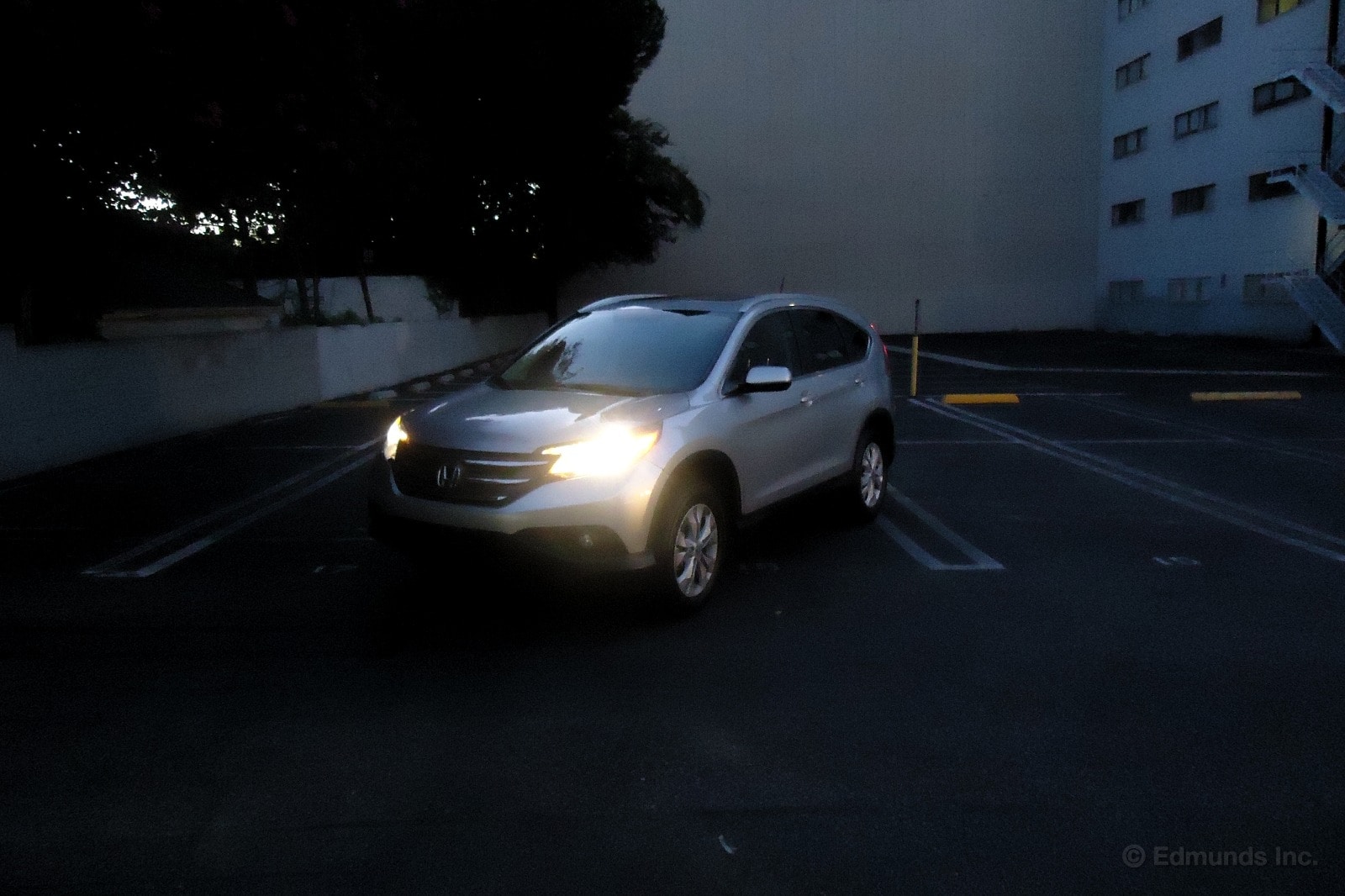
Sometimes we get emails from disgruntled car buyers calling us out for not addressing certain shortcomings in X, Y or Z's road test or model review. The most recent of these emails concerns the Honda CR-V. Here's what this reader had to say:
"I almost bought a 2013 Honda CR-V this week, but luckily drove it first at night. The headlights were so poor that they should be recalled as a safety issue. I then saw on the CR-V owners' forum on line that many CR-V owners have this problem. How could Edmunds not see and report this problem in their reviews?"
At first, I found this email surprising, since I've driven the CR-V and have never had a problem with its headlights (but I should point out that I've traveled in areas with ample street lighting).
However, a quick look at the long-term updates for our Honda uncovered this nugget from our very own Erin Riches:
"These reflector-type halogen headlights are dim. And they are as good as it gets, even on this $30,825 EX-L model. HIDs, or at least projector-beam headlights, need to happen."
After exchanging a few emails with this reader, I learned that she lives in a rural part of the country, and frequently travels down surface roads and highways that are bereft of street-lamp illumination. So I get why she'd consider the CR-V's headlights a significant safety issue.
Any CR-V owners out there? What has your experience been with the headlights?
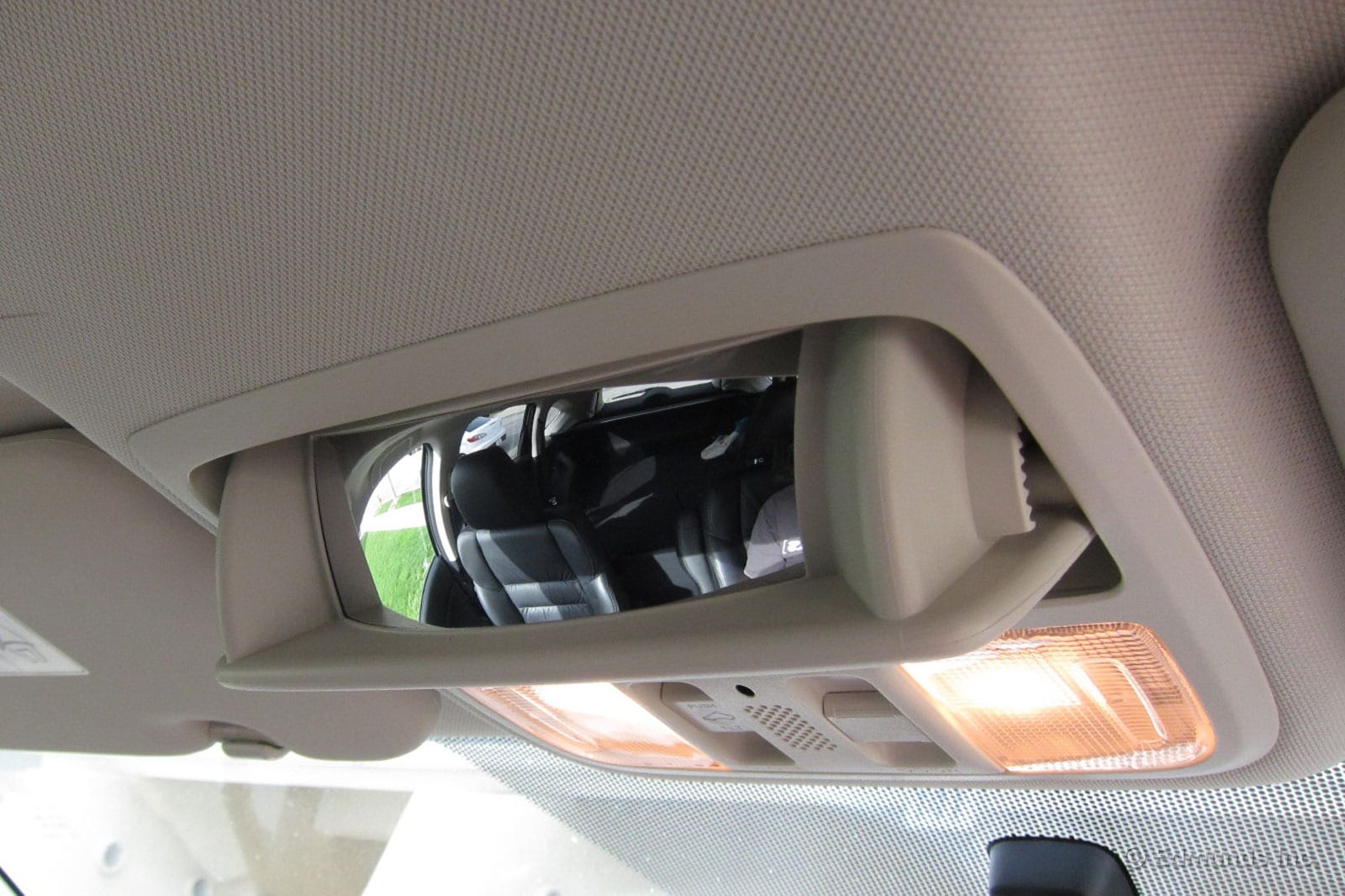
Here's a feature I haven't seen anywhere except in a minivan: The sunglasses holder that doubles as an interior rearview mirror. Sure, Honda probably just stole this thing from the Odyssey. But it's every bit as useful for spotting back-seat hijinx here as it was there.
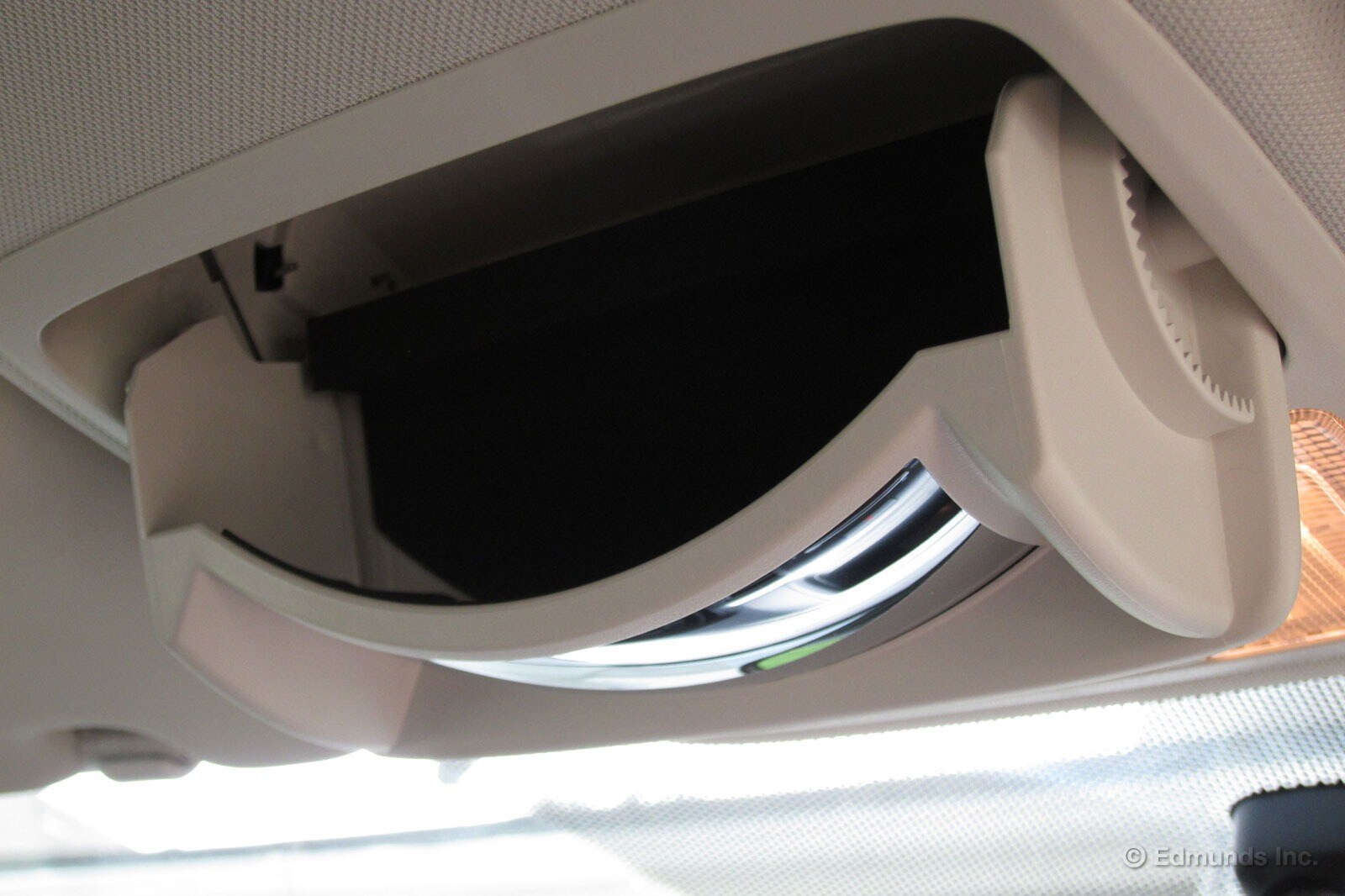

The seats in our 2012 Honda CR-V are really comfortable. They give great support and the leather isn't bad either. But I think my favorite part about them is the armrest. When I have control over my own folding armrest, I feel like I'm in First Class on a transatlantic flight and there's no one in the seat next to me.
The interior of the CR-V isn't made with the most expensive or plush materials, but it's still a comfortable place to sit during rush hour (which is saying a lot). Plus, after 18,000 miles, the seats seem to be holding up well with little signs of wear.
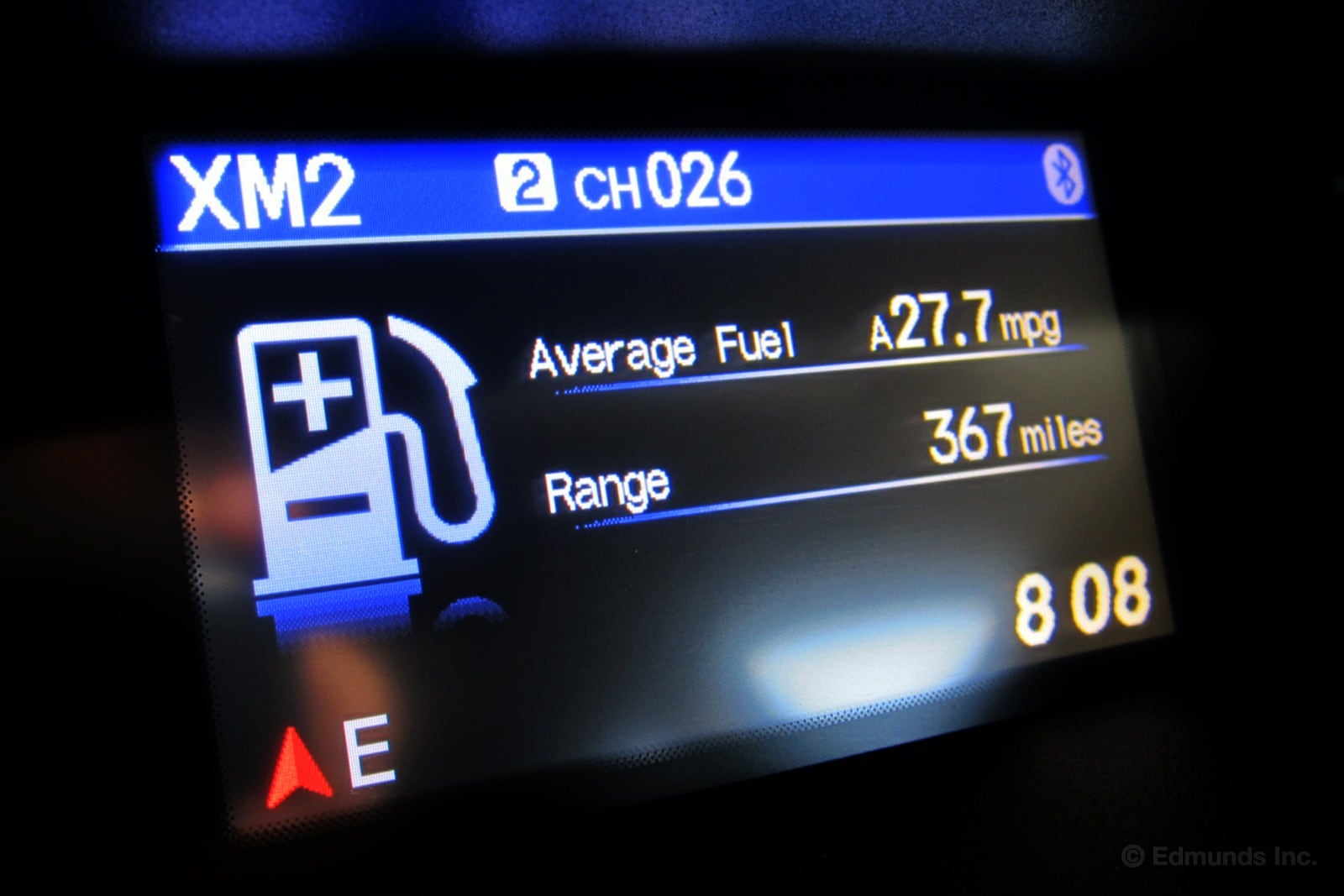
During March, we put about 1,200 miles on our Honda CR-V and we're closing in quick on 20,000 miles. Despite only average four-cylinder sauce (especially on long grades), this versatile crossover remains a staff favorite and a go-to road tripper. In March, we used the CR-V mainly in and around town, except for a ski run to the Sierra Nevada mountains which accounted for about 700 miles.
Over six tanks, we averaged 23.4 mpg. That's shy of the EPA combined rating, but who knows what abuse the CR-V suffered under Monticello's right foot en route to and from his alpine adventure. And as Mike pointed out in an earlier post, either the Honda CR-V's on-board eco meter isn't properly calibrated or it's just humble. Looking at the fuel log, the CR-V underestimated its actual fuel economy on almost every tank.
Worst Fill MPG: 17.1
Best Fill MPG: 31.3
Average Lifetime MPG: 25.1
EPA MPG Rating (City/Highway/Combined): 22/30/25
Best Range: 388.9 miles
Current Odometer: 19,770

Whatever grief Honda has taken, and the harvest it now reaps, for letting bean counters strong-arm the engineering corps over the past decade, the company still knows how to package.
Here's a minor detail, but totally useful. I assume this is a loose coin or a cell phone tray. I usually and needlessly keep my cell phone in a cupholder, usually tethered to the USB connection, so instead this tray comes in handy for gate opener and key cards. Could probably fit a CR-Z in this cavernous console, actually.
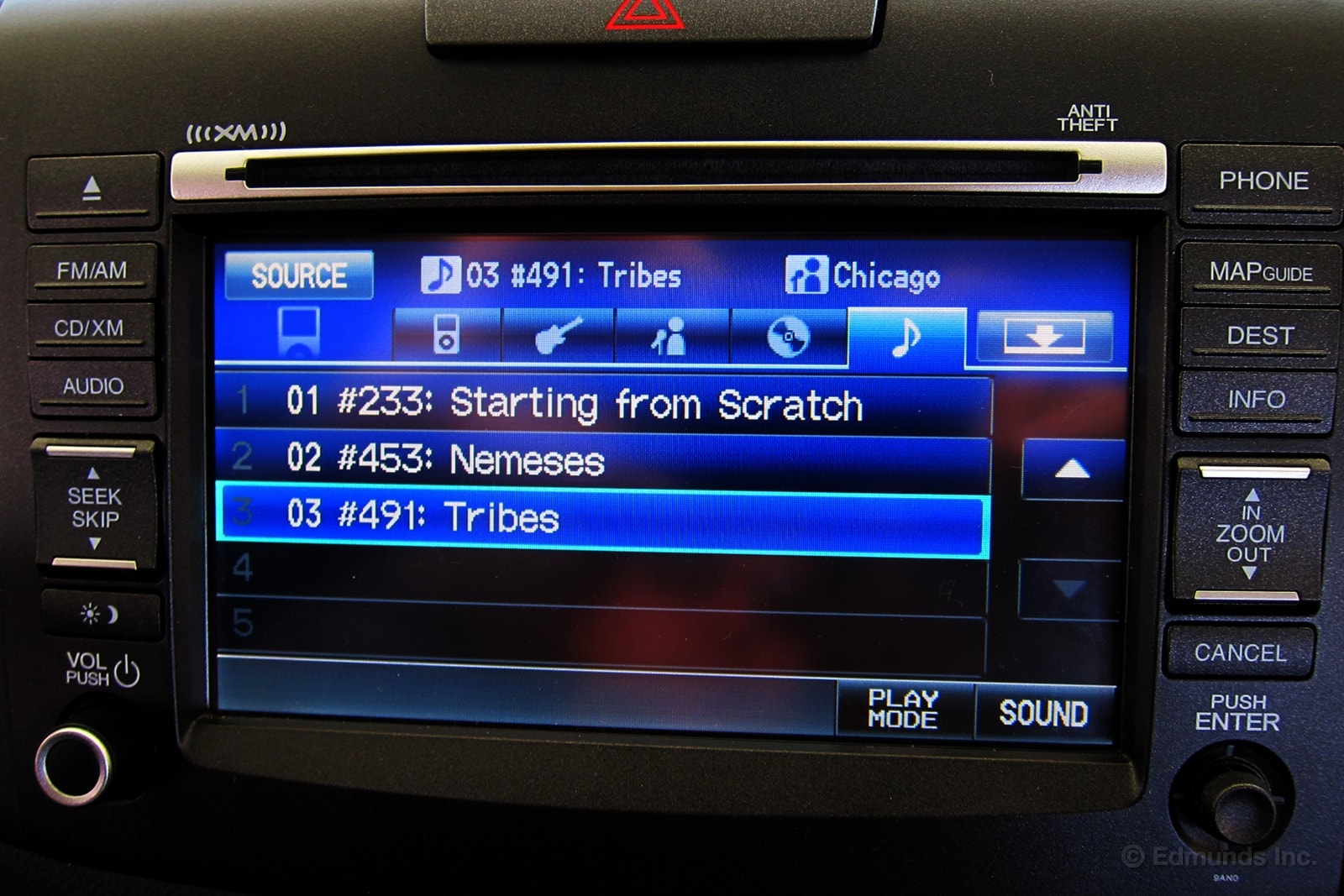
A couple of weeks ago, I mentioned that I liked how the Beetle mixes icons with text buttons in its center stack. But I'm not so sure how well icons explain the file structure in this example of the CR-V's media display.
For example, here I'm listening to a podcast of This American Life. The podcast titles are listed under a music note and the name of the podcast series listed in the CD-looking tab before. The guy standing in front of the microphone, that screen tells you the file is from Chicago Public Media, and the guitar icon, I think that leads you to the top of the podcast menu.
It's all needlessly dense and tells me nothing at a glance. But it looks cool, in an old Nintendo kind of way.

Before our 2012 Honda CR-V turned over 20,000 miles, I noticed it telling us that its oil life was down to 20 percent. Shortly after it ticked over 20,000, oil life dropped to 15 percent and the CR-V also tells us it wants a B1 scheduled service: replace engine oil and filter, check front and rear brakes, rotate tires, and inspect a grip of the essentials like brake hoses and lines, tie rod ends, suspension components and more.
To the dealer, then.
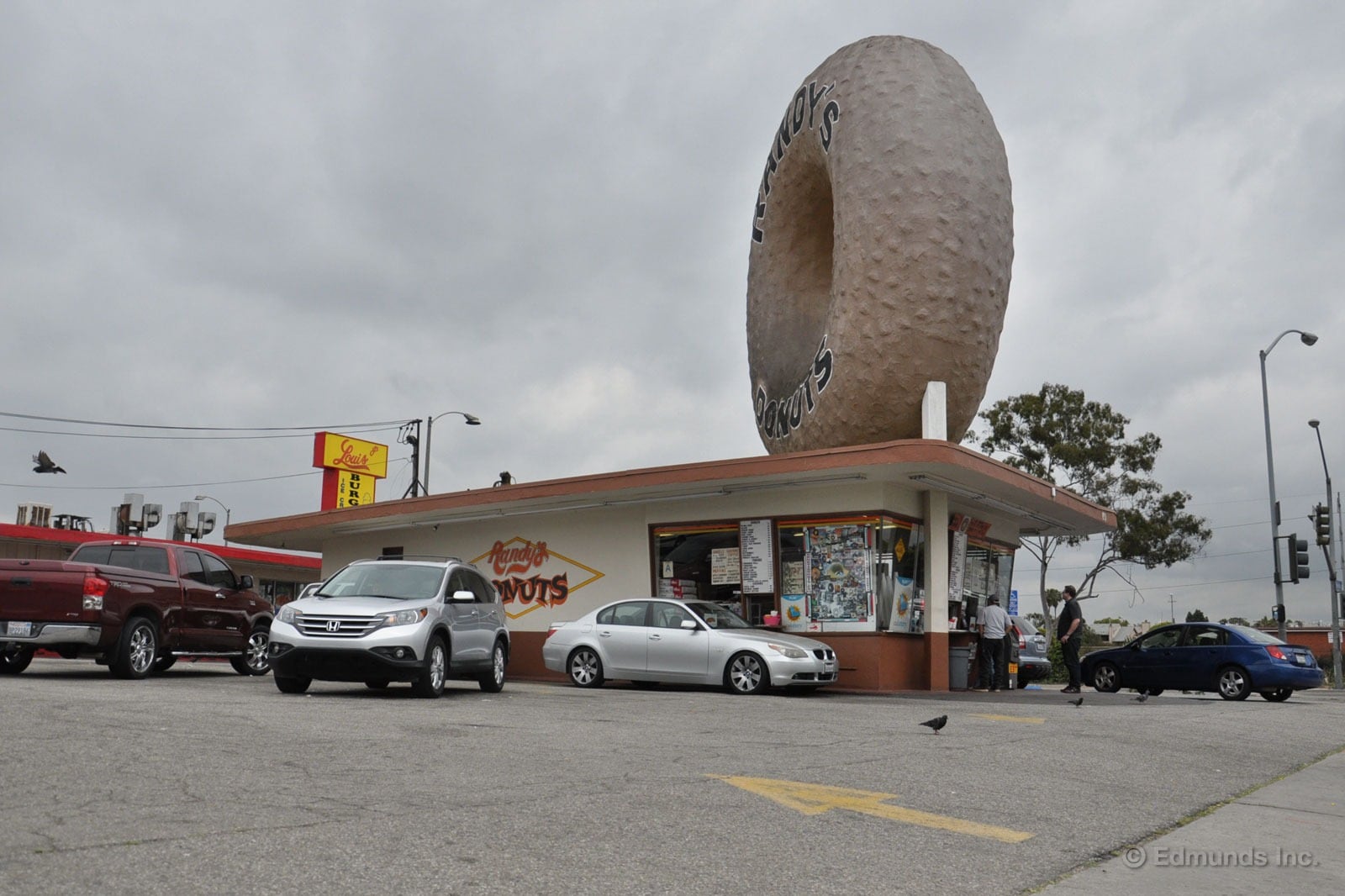
Our long-term 2012 Honda CR-V recently hit 20,000 miles, and we drove another 400 miles before we even noticed. Of course, the CR-V isn't really a milestone kind of car. It just goes about its business and doesn't make a fuss about anything. That's probably why I like it.
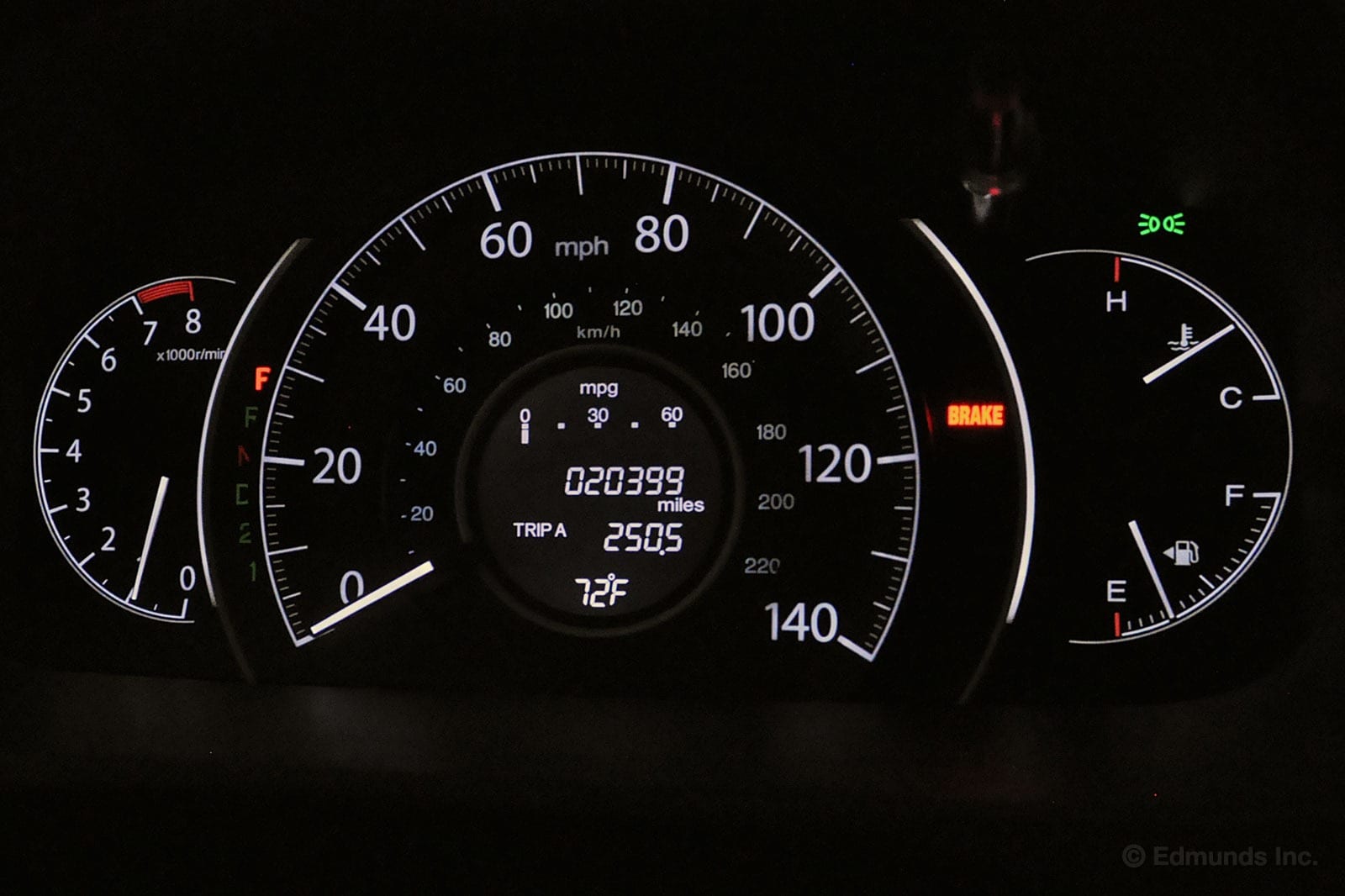

Over the weekend, I took it to an Angels game. The CR-V is a great vehicle to take to an Angels game. It's easy to park and reasonably sized. And you just don't worry about it when a bunch of kids get out of the BMW 7 Series on your left. After the game, my spouse and I relaxed in the comfy front seats and listened to the post-game show while waiting for traffic to die down. I still can't get over how roomy this cabin feels. No other automaker, it seems, can create a sense of space the way Honda does, at least not in this class. (This was the best game the Angels have played all year, by the way. The stadium erupted when Pujols hit a double in the bottom of the ninth inning and Trout scored the winning run.)
The next day, I made a doughnut run in our Honda. I couldn't have picked a less sensible food option, but I was happy with my vehicle choice. The suspension calibration and wheel/tire package on this crossover are close to perfect for life in Southern California. The 2012 CR-V smothers all the ruts and uneven pavement around here, yet it's not so soft that it flops all over the place when you're rounding a corner. It's absolutely not sporty, of course, and although that might bug me in a small sedan or hatchback, I never can seem to hold it against the CR-V.

Earlier this week, I took our long-term 2012 Honda CR-V to the dealership to address the B1 service reminder that popped up just before it hit 20,000 miles. I showed up at Honda of Santa Monica just before 11 on Monday morning. I didn't have an appointment, so I pulled right in to the service department's dedicated lane for customers without appointments.
Within 30 seconds, a porter approached and asked what I wanted.
"I'd like to get a B1 service if I can," I said.
"Sure, I'll get a service advisor for you," she replied.
Sure enough, a friendly advisor appeared at my door with his own iPad about 30 seconds after that.
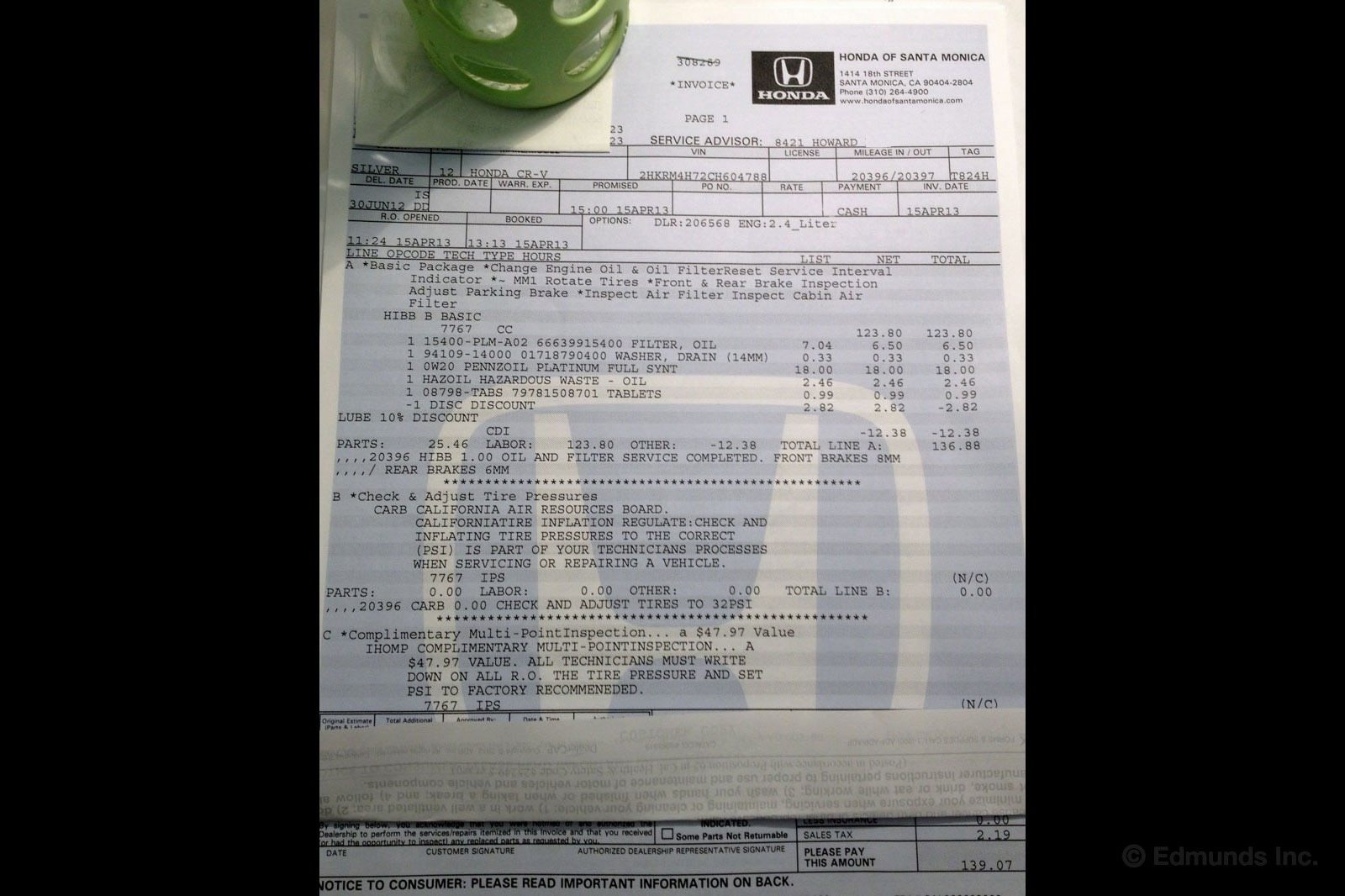
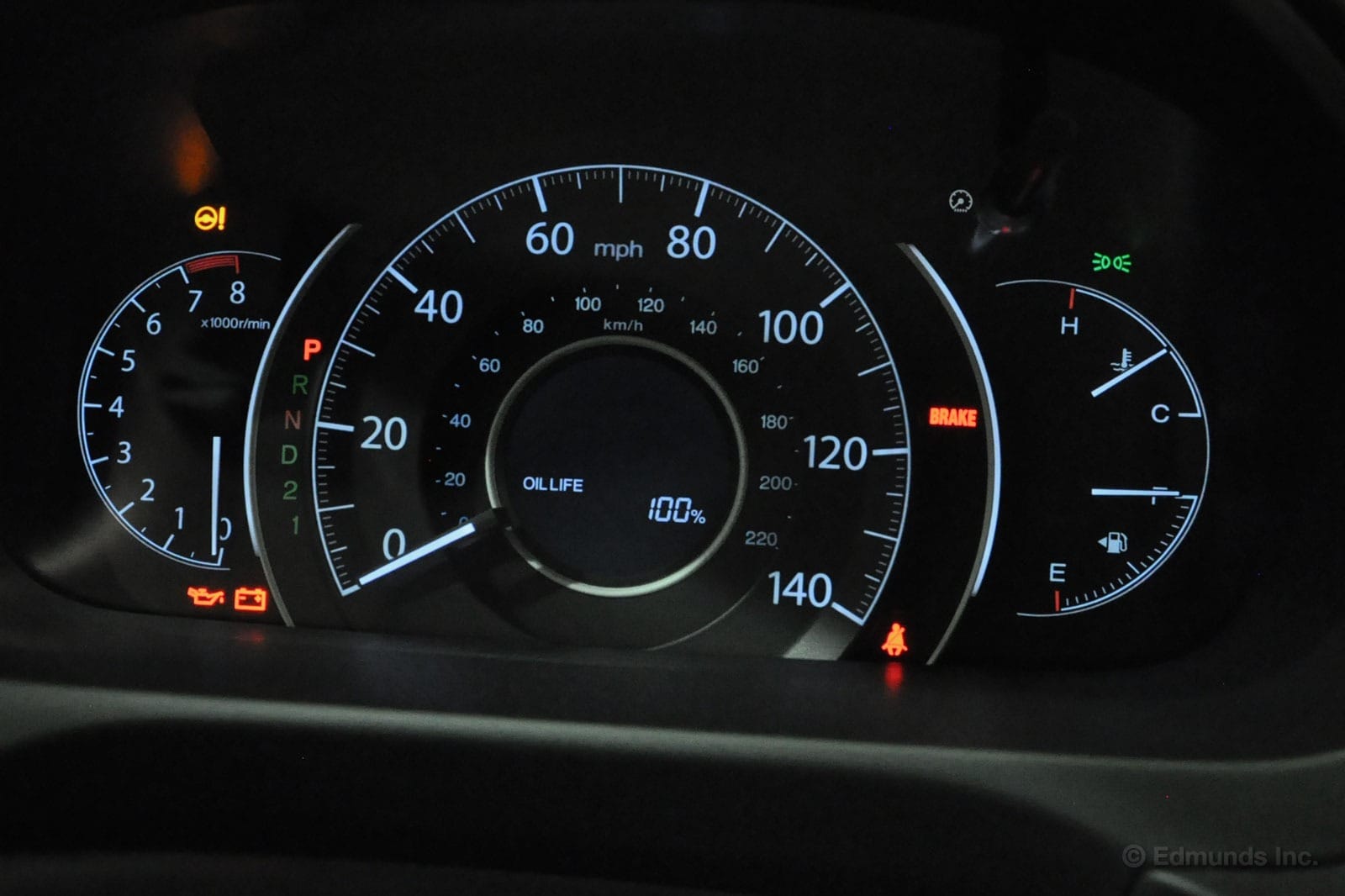
That iPad made all the difference. The advisor was able to look up the CR-V's VIN quickly to pull up details from its previous visit here. He then quickly set up a repair order for the B1 service. I know that 0W20 synthetic is required for the CR-V, and I knew that our long-termer had its crankcase filled with 0W20 Mobil 1 during its last oil change, so I made sure to confirm it would be getting the same at this dealership (other Southern California car dealers have been known to use synthetic blends on cars that require 0W20). He assured me it would.
B1, by the way, is Honda terminology for a somewhat more extensive service. In addition to changing the oil and rotating the tires, the service technician is supposed to inspect the brake lines and hoses, suspension and steering components, driveshaft boots, the fuel lines, and the condition and level of all fluids.
My advisor's initial estimate for the service was $157.91. I tried to use a coupon I'd printed off the website (it wasn't for the B1 service specifically). Regrettably, he said he couldn't apply it to this service but offered to apply a 10-percent-off coupon to the final bill. At this point, we were still standing outside next to the CR-V, and I wouldn't have had to go inside at all, except that I wanted a hard copy of the repair order.
We went inside, and the advisor quickly printed one for me and promised the CR-V would be ready by 3. I hopped into the shuttle (an aging but serviceable first-generation Honda Odyssey) and got a ride to the office.
At 1:20 p.m., I got a call from the advisor that the Honda CR-V was ready and in tip-top shape. Presently, it was queuing up for a turn in the dealership's car wash machine, and I could come pick it up any time before 7 that evening.
I picked up the CR-V about an hour later and was pleased to find the total bill did indeed reflect a discount: It was $139.07 with tax. That's right in line with the Edmunds.com Maintenance Calculator's suggestion that you should pay $145 for a 20,000-mile service on a 2012 Honda CR-V if you live in the 90404 zip code. As we've said many times, the cost of living and caring for a car in Southern California is high.
Overall, this was an incredibly painless service. It's a great idea to let the service advisors use iPads, because at least at this dealership, it makes the whole data entry process go much quicker.
One final note: The service tech remembered to reset the oil life monitor. This should always happen, but it doesn't always, so nice work.
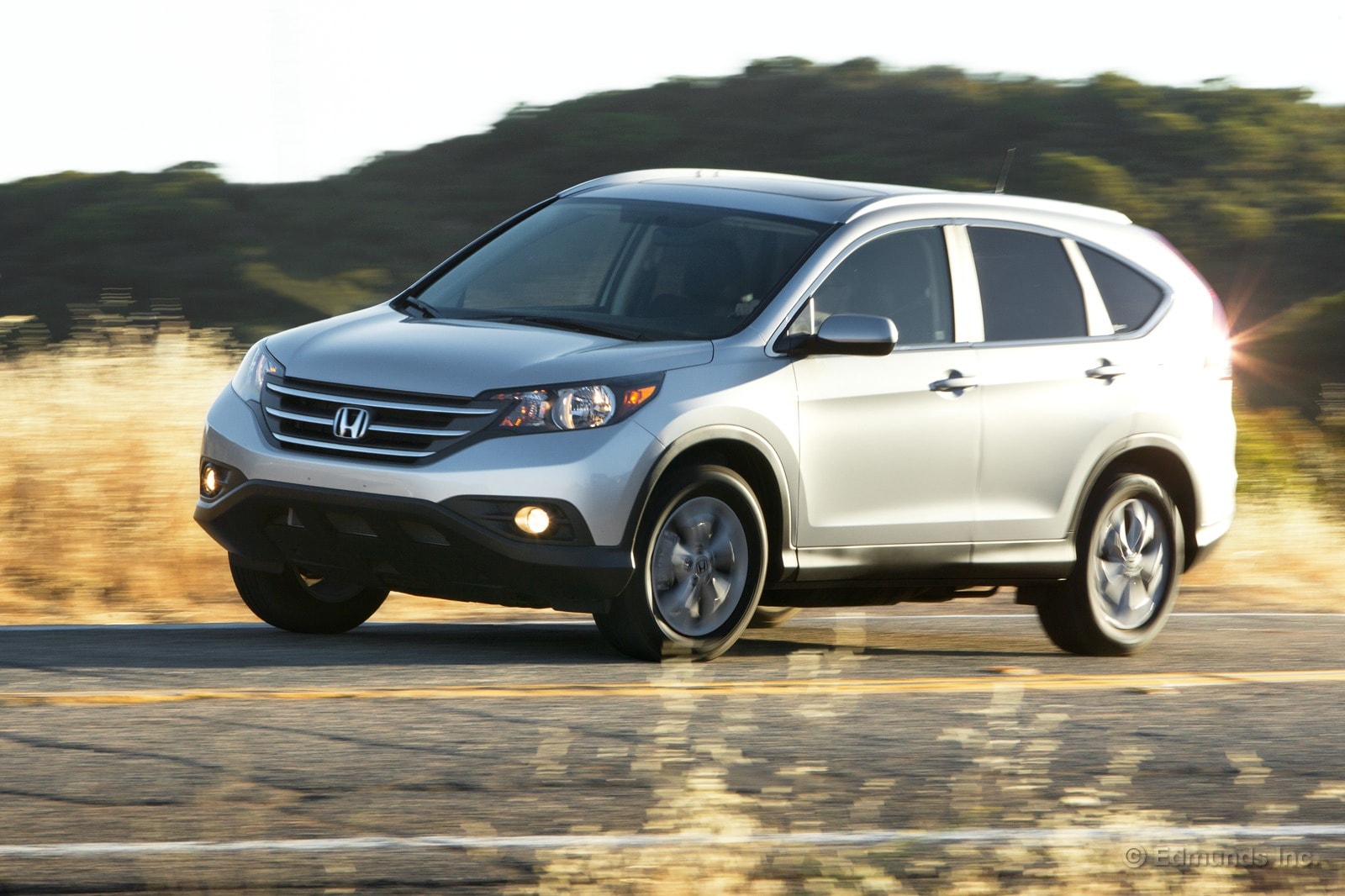
In the month of April our 2012 Honda CR-V traveled 1,530 miles on 87-octane fuel. We averaged 24.3 mpg for the month, just shy of the EPA rating of 25 mpg in combined driving.
The lifetime average fuel economy for this car dropped by 0.1. Here are the details:
Worst Fill MPG: 17.1
Best Fill MPG: 31.3
Average Lifetime MPG: 25.0
EPA MPG Rating (City/Highway/Combined): 22/30/25
Best Range: 388.9 miles
Current Odometer: 21,250
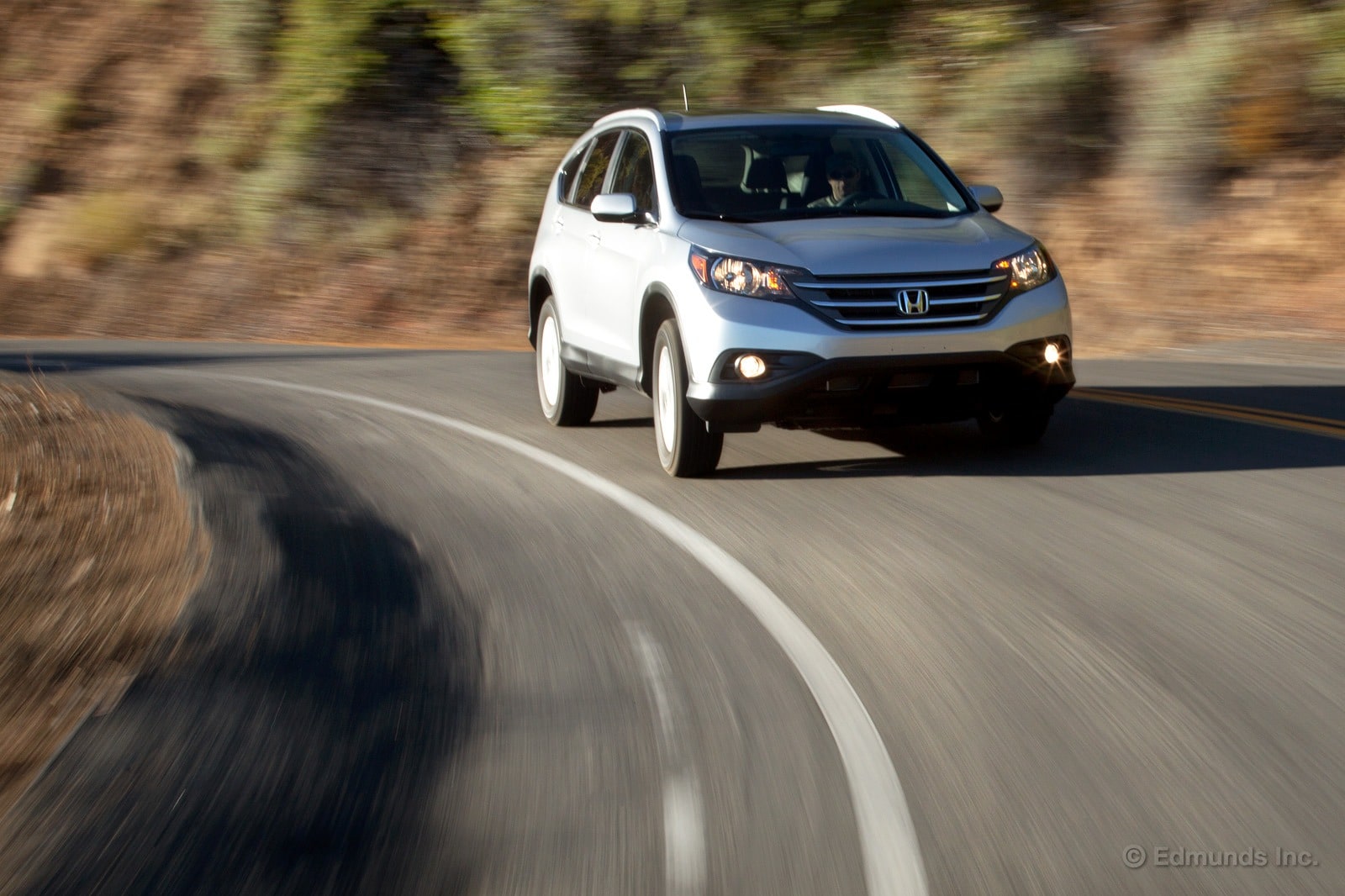
The Honda CR-V has been a best-seller in the U.S. since it was introduced in 1997. Back in the day it was a practical if scrappy vehicle that appealed to people who wanted an SUV but didn't want to go off-roading and didn't want something the size of Montana.
Its first full redesign in 2002 improved its power, added interior room and safety features without compromising the original feel of the CR-V. It grew somewhat in size but the 2002 model was probably the best CR-V ever made. There was something endearing about it.
Its special features have come and gone over the years. Remember when this little Honda came with a picnic table in the back? Or the versions that had cargo shelves?
Well, 10 years later, we again have a Honda CR-V in our long-term fleet. It has a new look and includes modern tech features to keep up with the times. Several issues have been taken care of, like the huge amount of road noise it used to have.
But have its improvement taken away what made it special? Yes, it's still wonderfully practical but I can't help think it is a bit bland now. Maybe this happens to all vehicles that have been around a while.
What do you think?
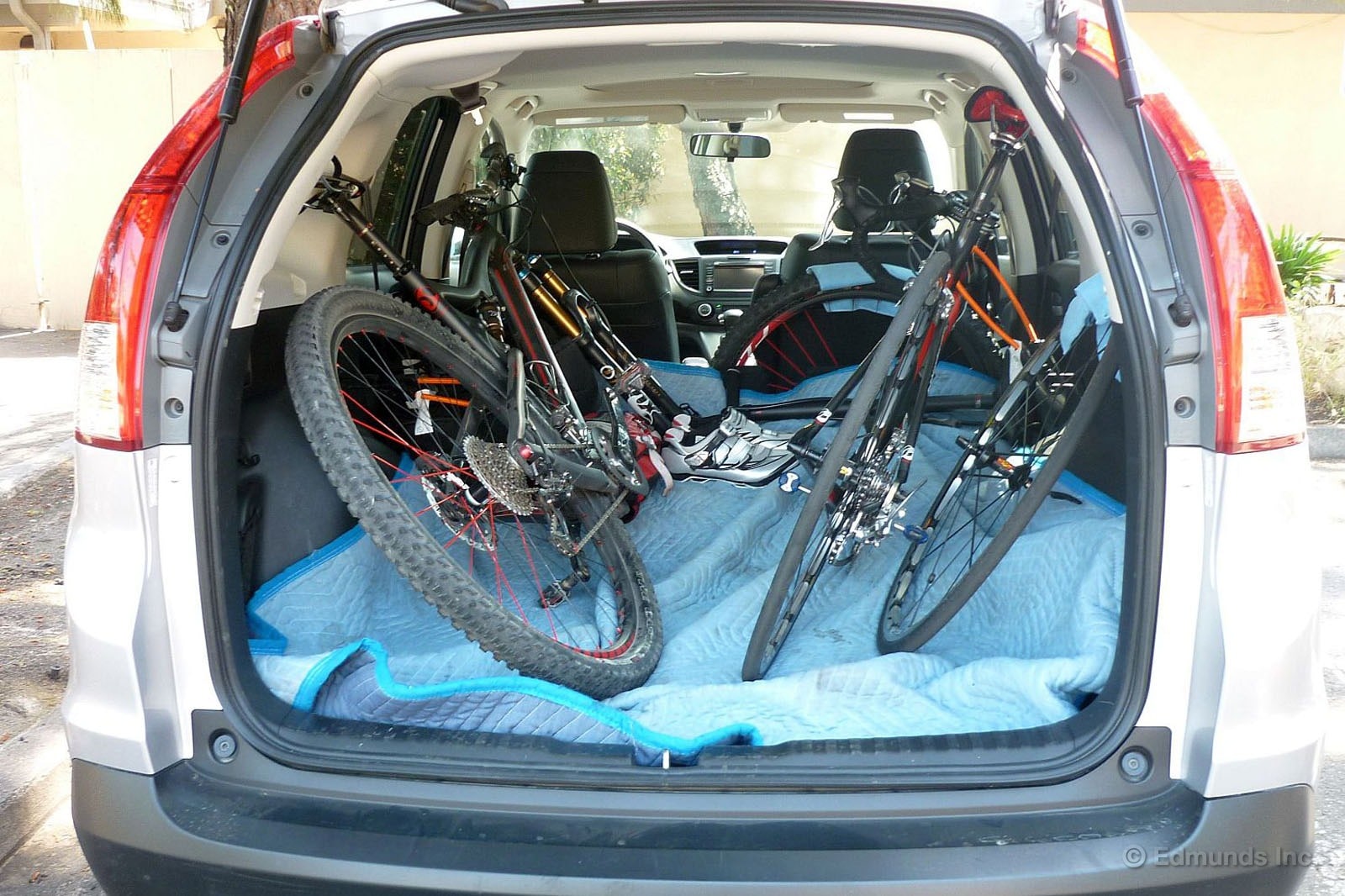
I don't really consider myself an SUV guy. To be honest, I'd much rather be driving a sports car or a sport sedan. But there's no denying the inherent utility of an SUV. Hey, it's in its name.
I especially like SUVs when I'm on my way home from mountain biking and I remember that I need to pick up my road bike from the shop after having some work done on it.
And that's where our long-term 2012 Honda CR-V came in pretty handy. I fit both bikes in easily, secured with bungee cords. Gotta love a tall roof.
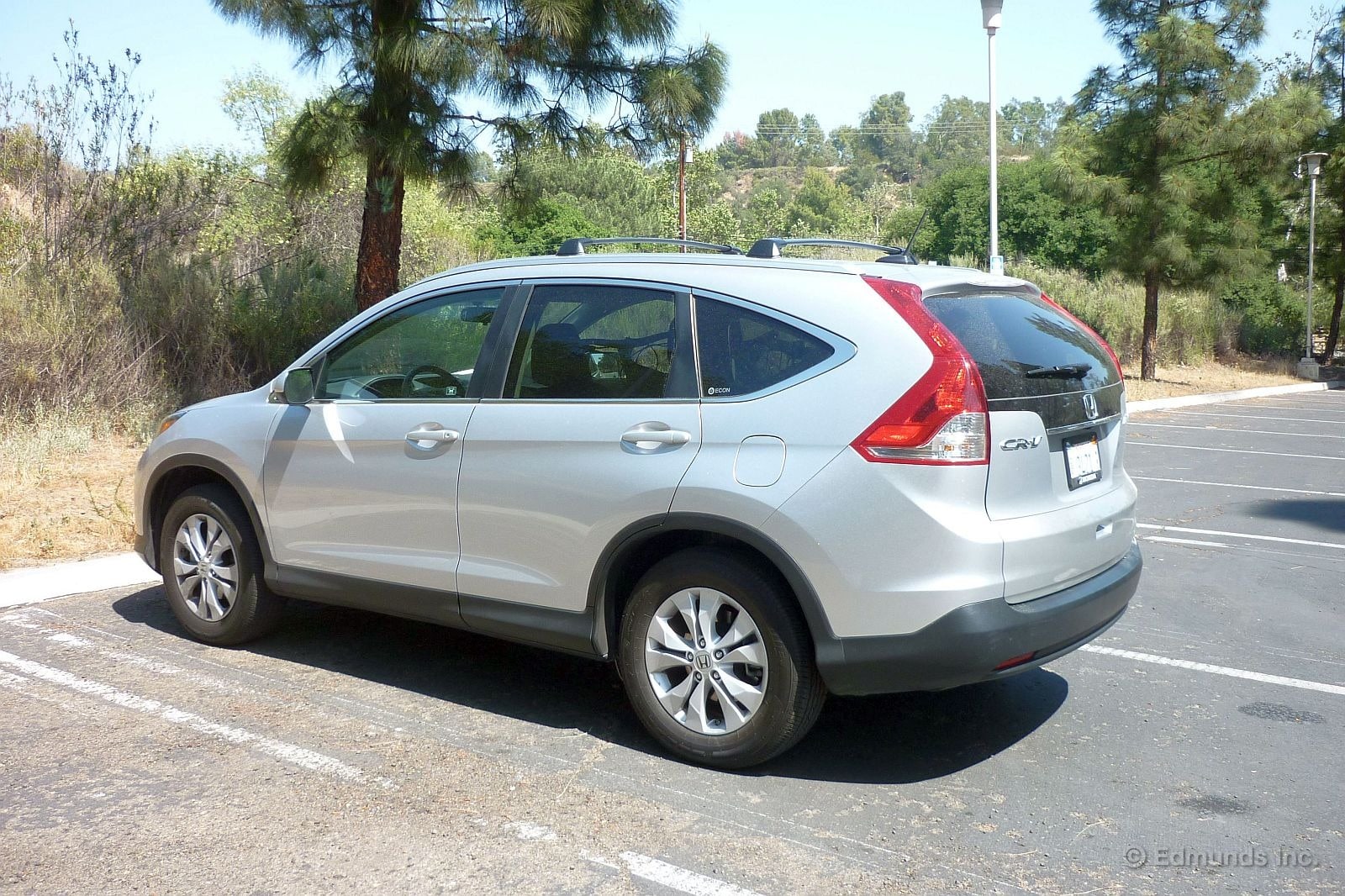
Sometimes, a vehicle is so good that you struggle to find faults with it. The 2012 Honda CR-V falls into that category.
I'll admit there are times I wish its little four-cylinder engine had more power, especially at higher speeds, like when you're trying to pass a line of cars on a two-lane road. But then it wouldn't get such respectable fuel mileage.
And sure, the rear-end styling is a bit odd. At least in my opinion.
But beyond those quibbles, there's little to complain about with what Honda's done here. Comfy front seats, a pleasant ride quality, intuitive throttle delivery, easy-folding one-pull (from the cargo area) double-action rear seats, cubbies galore, quality materials and tons of room.
Yep, the 2012 Honda CR-V is one of the good ones.

It's no secret that the Honda CR-V compact SUV has grown in size since it first hit the market in the late '90s. As I was vacuuming out the rear cargo area this morning, I decided to see how much more room the rear area offered in the current model compared to a 10-year-old CR-V.
The 2012 CR-V offers 37.2 cubic feet with its rear seats in place, while the 2003 CR-V measured 33.5 cubes.
Nearly 4 cubic feet extra will definitely allow you to take a couple additional small suitcases on vacation, or add your teammates' oversized duffle bags as you head out to the field.
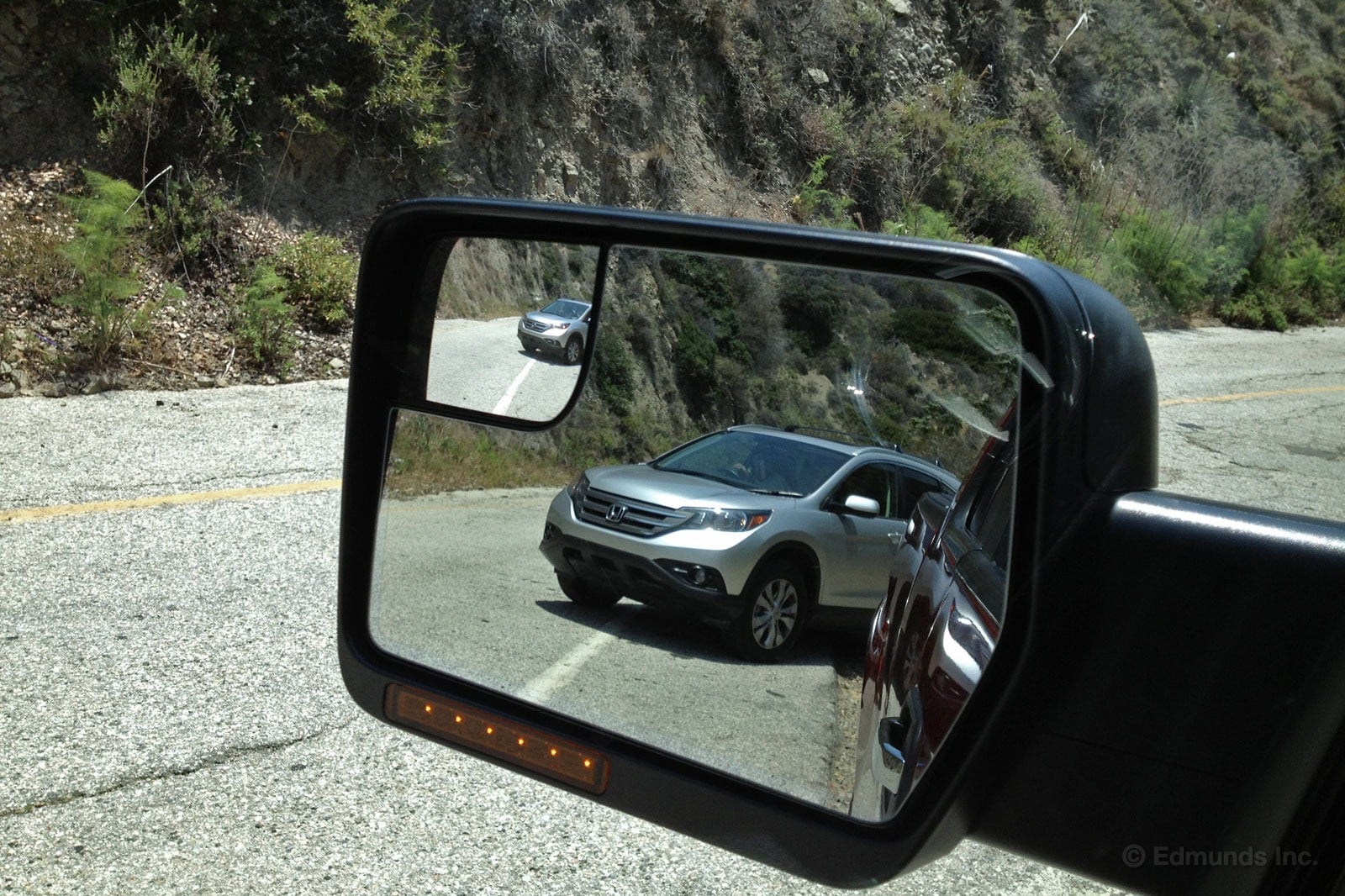
I remember when we were still talking about adding a 2012 Honda CR-V to our long-term test fleet. I was a proponent of it. The CR-V excels at being ordinary, and since most of us lead ordinary lives most of the time, this Honda is nearly impossible to dislike.
Space efficiency is the CR-V's greatest asset. It feels hugely spacious on the inside, and you're sitting in comfy seats with simple controls and useful storage slots all around you. Yet on the outside, it's not huge at all, and so it fits just about anywhere. It's a better fit in most garages than Honda's Accord.
Meanwhile, the driving experience is just pleasant enough to keep me content. No, the engine's not so powerful, but the transmission shifts in a refined manner. And, no, the handling is not sporty or particularly engaging, but the ride quality is nice and the 2012 CR-V's a lot quieter than in years past.
Of course, I'm not suggesting that everyone else on staff agrees with me on these points, but they've voted with their feet: We've used our long-term CR-V for absolutely everything. Everyone commutes in it, several of us have taken road trips, and lately it has become a favorite of our video team. And indeed, we were out on a video shoot when I snapped this photo and jotted down these thoughts.
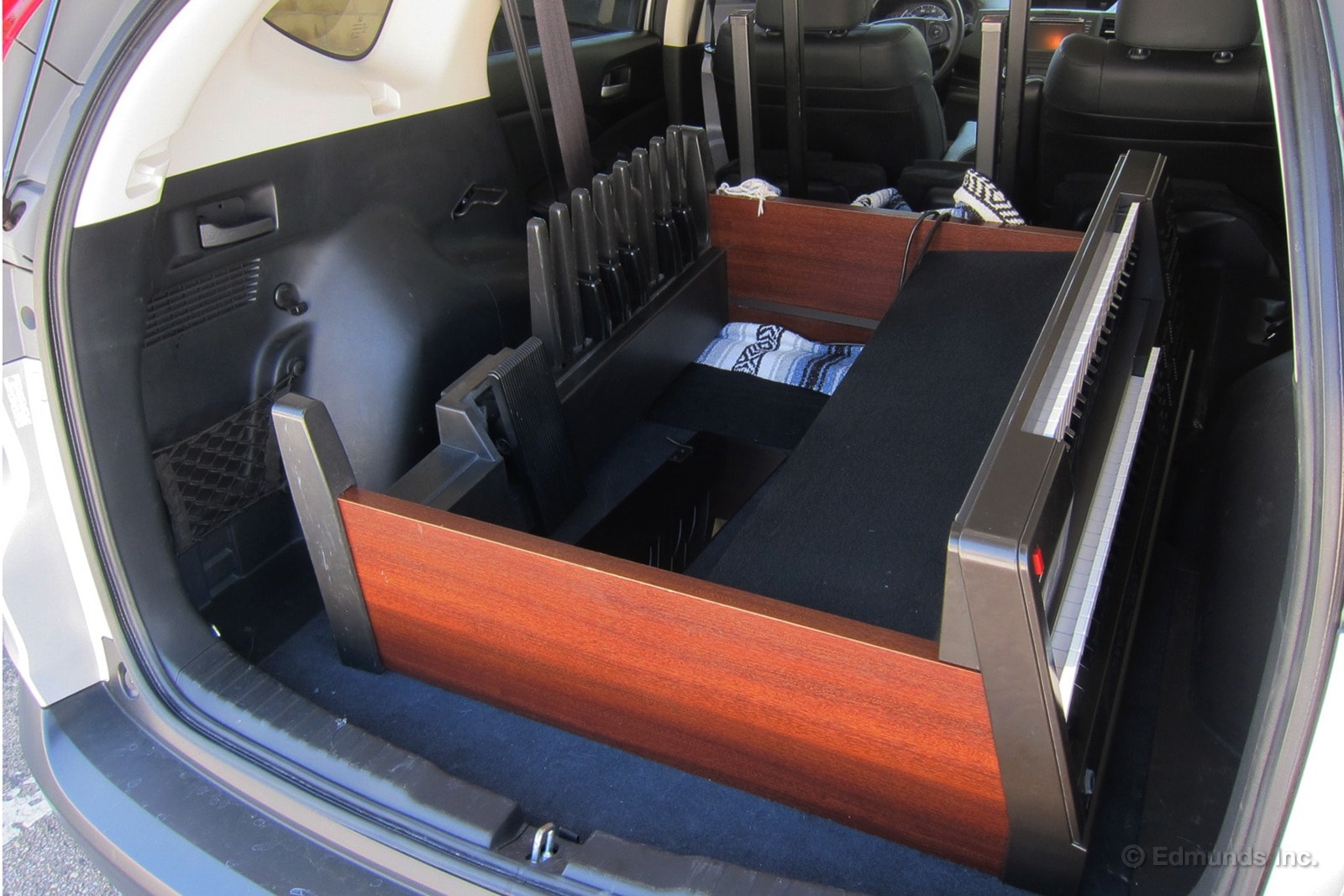
After much Craigslist and local eBay searching, Da Wife finally found an organ that she wanted. Stop with your gutter-minded innuendo, dear reader. This organ I speak of is of the musical instrument genus, specifically a Yamaha Electone.
These aren't your classic Smoke On the Water keyboards, nor the late Ray Manzarek's crunchy circus-music pianos. These are vintage 1980s recreational home-use instruments, with all the dopey, space-man orchestral sounds you'd expect from that era. The Electone also serves up some rich tones that you might hear in a Methodist Sunday service. But instead of some soulful Jimmy Smith licks, I get one-woman band renditions of Carpenters and Flashdance! hits. My wife plays well and her independence of limb is impressive. Still, a new pair of headphones is on order.
At 40 inches long and 35 inches tall, the Electone EL-7 is one of the baby instruments in the family, not like the larger mothership organs. The 2012 Honda CR-V swallowed it no problem, with inches to spare between the wheel wells. The EL-7 weighs 92 pounds and two people can manage it easily. Loading it on its back was a little awkward though, and made us especially appreciate the CR-V's low liftover height. One day when I decide the family deserves a genuine Hammond organ, I imagine the CR-V will be up for the job.
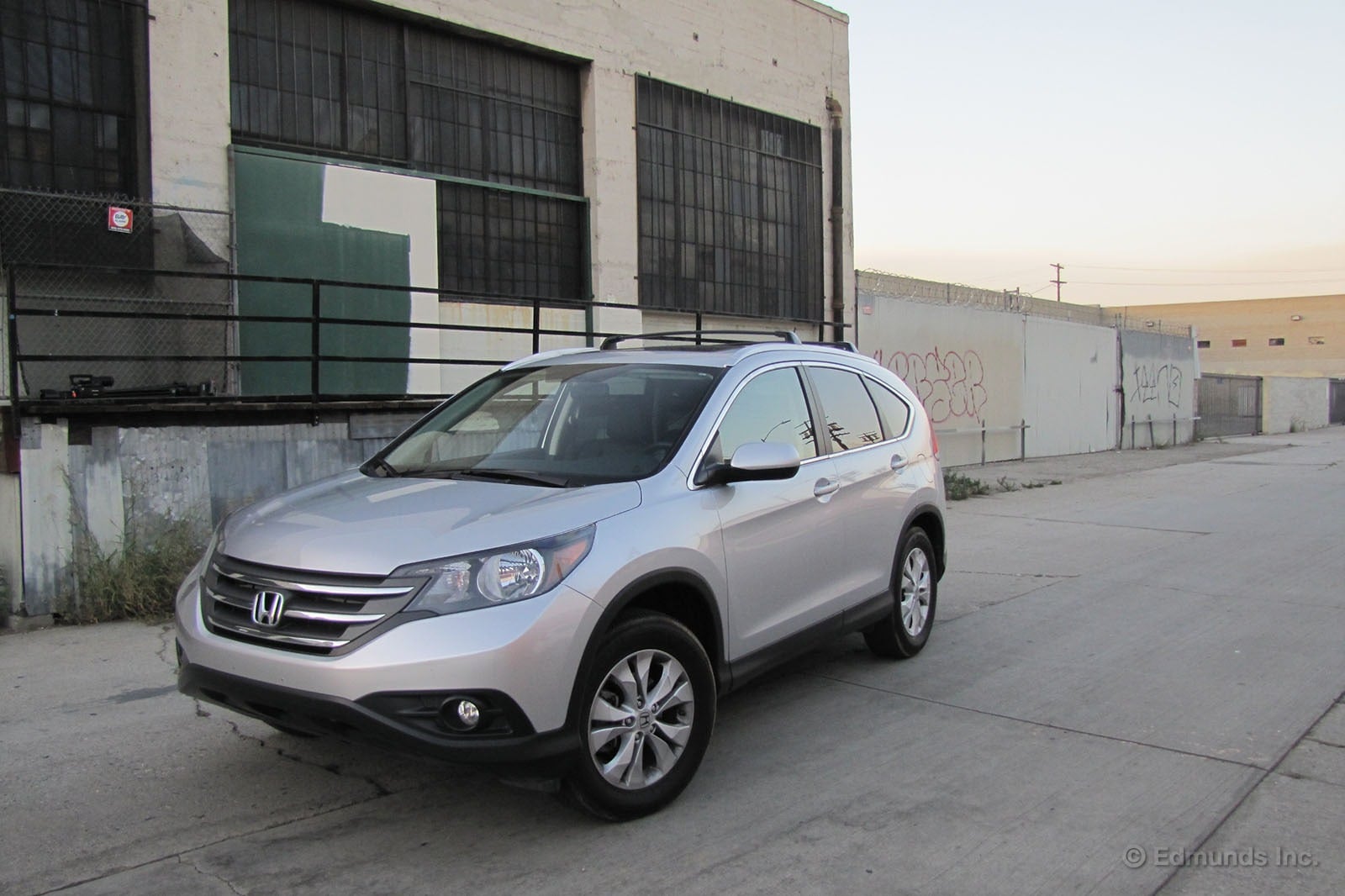
Our long-term 2012 Honda CR-V's lifetime fuel economy dipped by 0.1 mpg over the course of 1,353 miles in May. Still, at 24.9 mpg, that still rounds up to equal the EPA's combined rating of 25 mpg. That's pretty good since many of our long-term cars now fall under EPA combined.
Worst Fill MPG: 17.1
Best Fill MPG: 31.3
Average Lifetime MPG: 24.9
EPA MPG Rating (City/Highway/Combined): 22/30/25
Best Range: 388.9 miles
Current Odometer: 22,603 miles
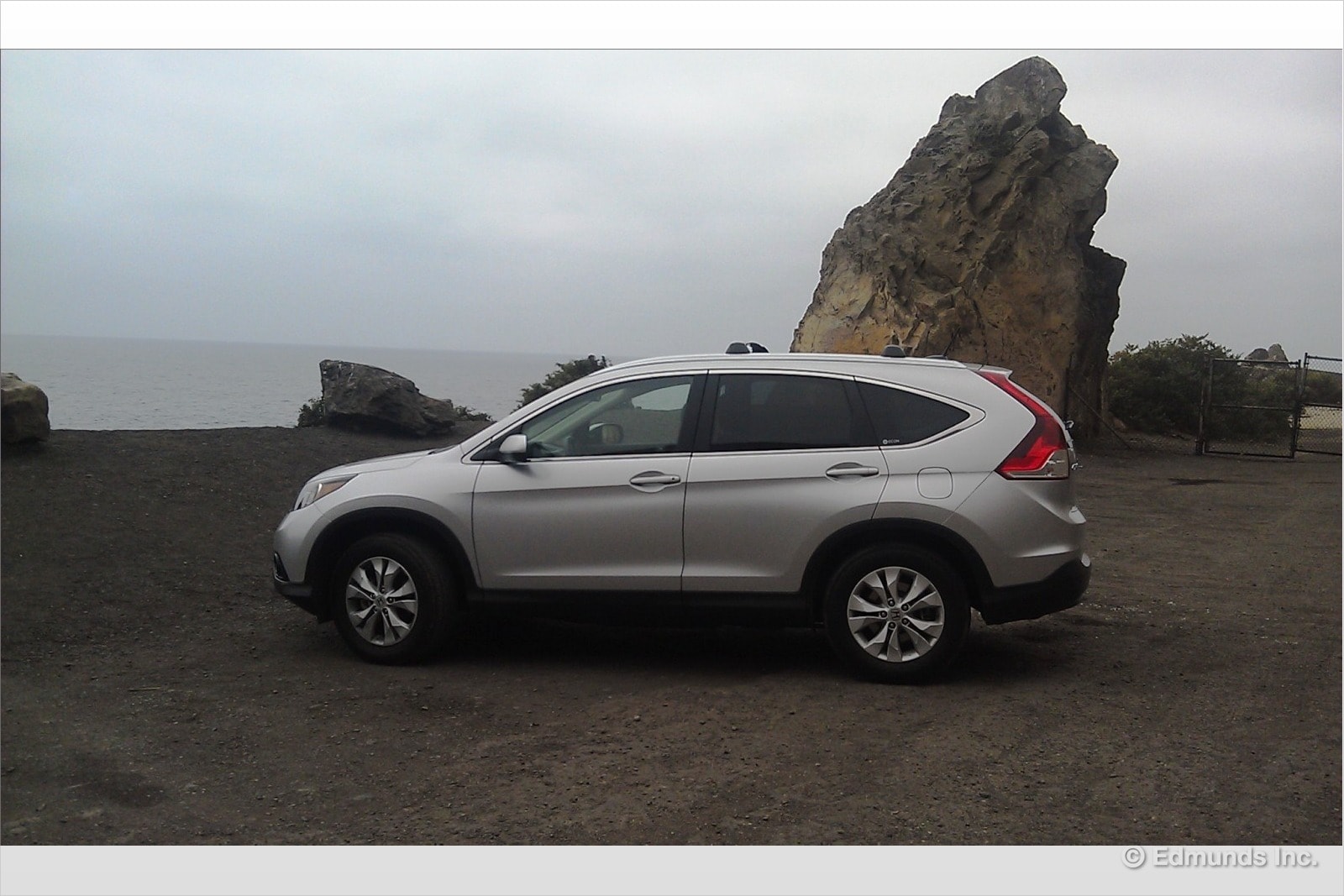
Nowadays, the lines between vehicular size segments are becoming increasingly blurred. Modern "compact" cars are about the same size as yesteryear's midsizers. And even within a current segment, size classification can be murky. Witness the compact crossover SUV segment, where the truly compact Hyundai Tucson (173.2 inches long) rubs fenders with the Chevy Equinox (187.8 inches long). At 178 inches long, the Honda CR-V sits between these two, and is about the same length as a Ford Escape.
The CR-V provides plenty of passenger space and, with about 71 cubic feet, more maximum cargo space than most anything else in its class. Yet as Erin recently pointed out, it's easy to park, a task made all the easier by the rearview camera that comes standard even on the entry-level LX trim.

I purchased a set of Honda S2000 seats for my personal car last week, and the job of transporting them fell to our 2012 Honda CR-V.
Fully assembled, with the rails attached, the seats are pretty bulky and I didn't want to damage them. I didn't have the tools on me to take them apart either. So did they fit?
Pfft. Of course.
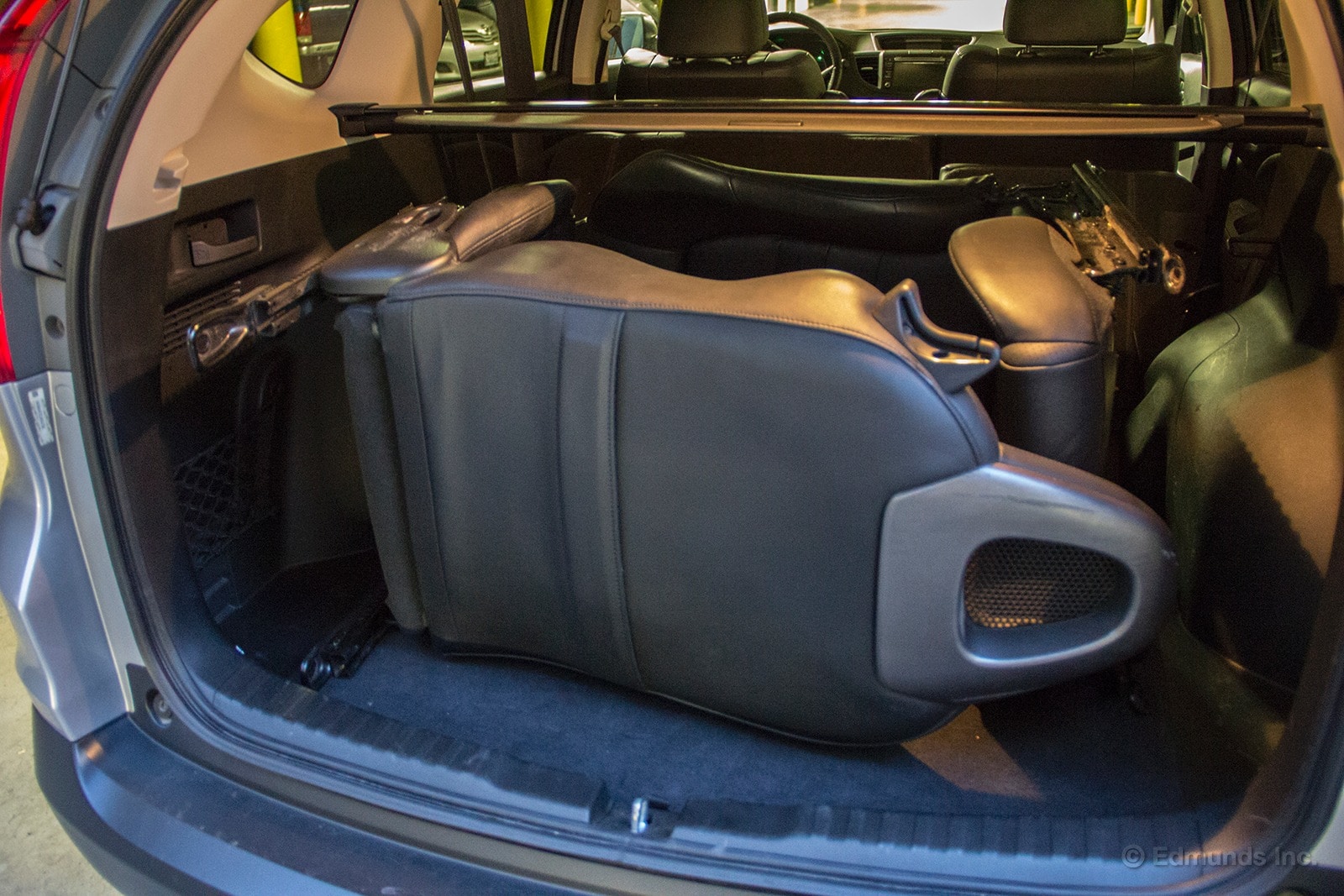
At first I folded down the rear seats to accommodate my cargo, but that wasn't necessary. I folded the back seat up without any issues and I was on my way. Short of my nine-foot surfboard, there's not much that won't fit inside our long-term Honda CR-V.
The ease of this transport got me thinking about our Tesla Model S and its jump seats (http://www.edmunds.com/tesla/model-s/2013/long-term-road-test/2013-tesla-model-s-jump-seats.html), so why not offer them in the CR-V, too? You'd have to ditch the CR-V's donut-spare tire, but it's definitely feasible. Would you buy a seven-passenger CR-V if the final two seats were rear-facing?
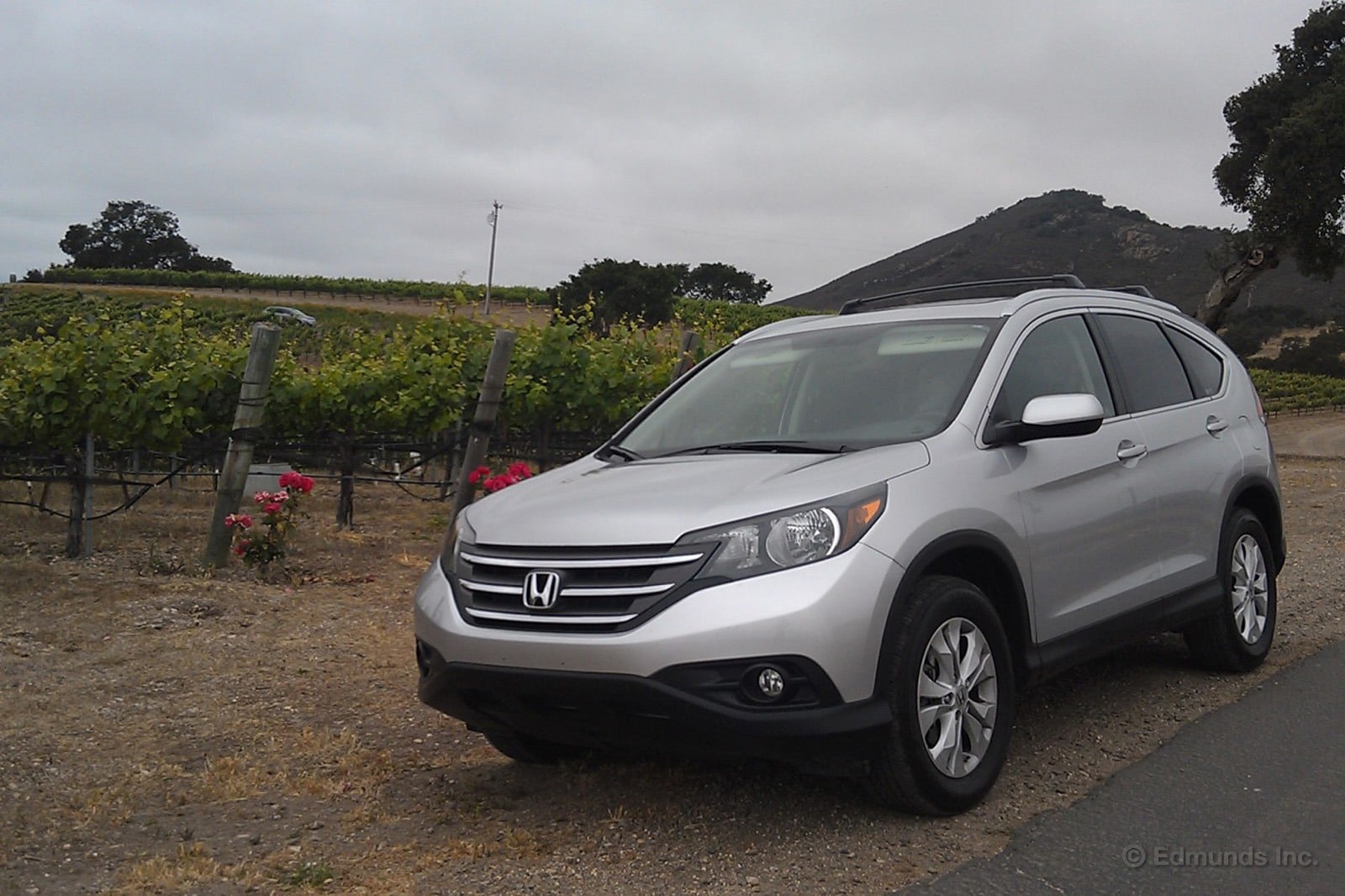
The wife and I just took a "let's get the heck out of L.A." road trip. We were looking for something relaxing, so we went with San Luis Obispo for an overnighter. It was about a 400-mile round trip, as it included a side trip to Solvang. The latter is a quaint Danish town located in the wine country of Santa Ynez valley. It's only about 130 miles north of L.A. The CR-V was available, and as expected was an amiable ally during our journey.
Those front seats, or should I say captain's chairs, provided solid comfort with their well-shaped cushioning, two-stage seat heaters, flip-down armrests and adjustable driver-side lumbar support. My occasionally ornery lower back (compressed disc) didn't complain once. As I require constant feedings, the massive console compartment was clutch, keeping all the road food (including sliced apples, granola bars, M&Ms and some bananas) handy while also keeping the iPod and phone happily charged. The cupholders saw coffee and hot chocolate duty while the door's bottle holders kept water at the ready.
Overall performance was more than adequate. While tackling the winding San Marcos Pass (Route 154), the CR-V felt sure-footed running through the curves and maintained respectable speeds on the steeper uphill sections without the transmission hunting between gears and the engine protesting loudly. Cruising at 70 or so on the open freeway was fairly quiet and relaxed, and we averaged about 27 mpg for the trip. I'll be sorry to see this one leave the fleet.
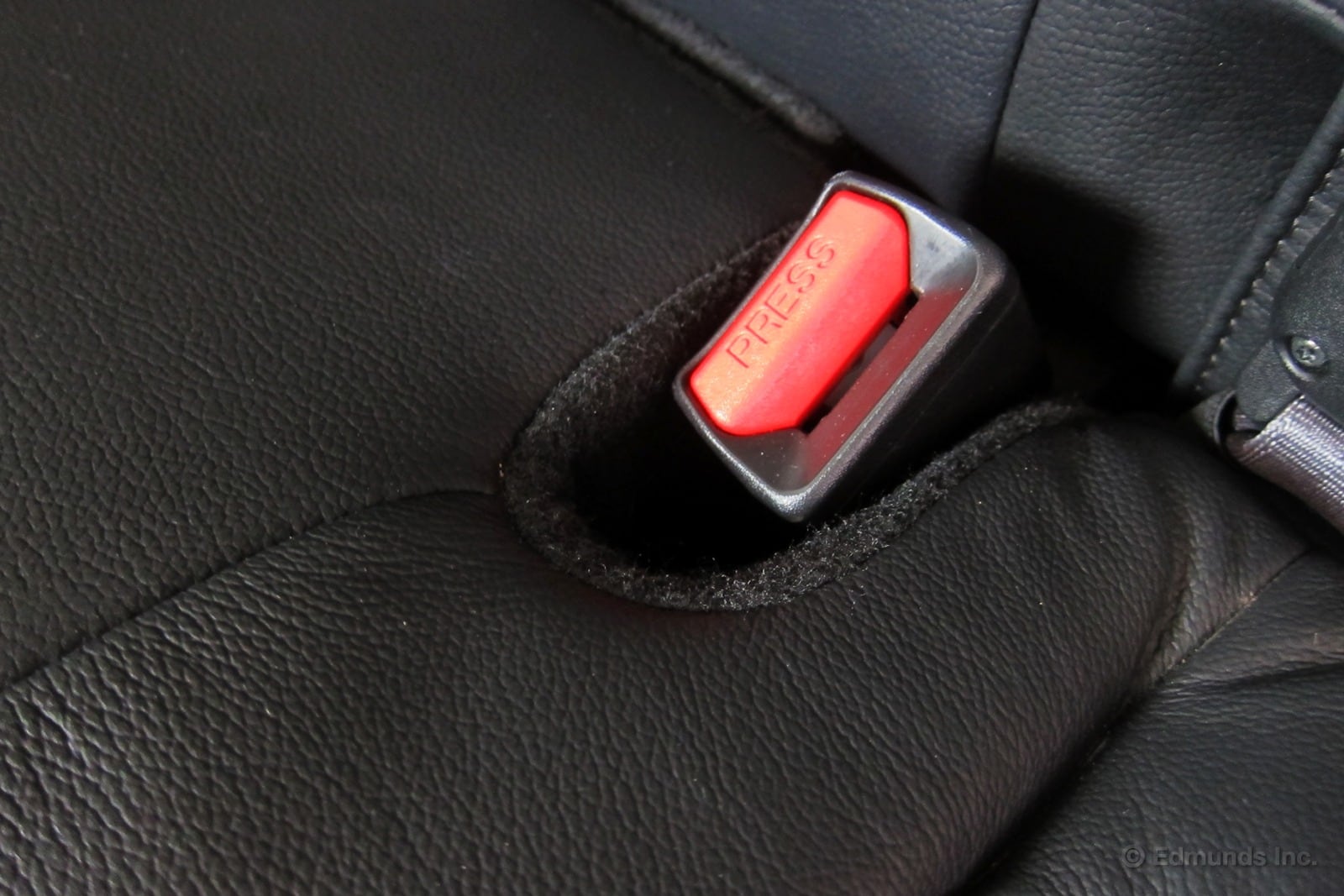
In this gig, you're always looking for details. After you get a feel for a vehicle's fundamental dynamic character, how it accelerates, steers, brakes and shifts its weight, you start noticing the details. Are the seats comfortable? How's the wheel feel? Can I see out of this thing? Then it starts breaking down to a car's purpose.
Moving things around in our long-term Honda CR-V recently, flipping the seats up and down, trying different configurations, I noticed this deft cutout for the left outboard seatbelt receiver in the folding rear seat (the 60-percent section). The seat bench falls right over the receiver, clears it perfectly, and the receiver still has some room to move.
A small, even trivial detail, but I bet there was nothing trivial about it to the interior engineer who had to sweat it. Probably a thankless task that went largely unnoticed on the team, and maybe even to the thousands of rear-seat passengers who'll never know that old-school joy of fumbling around under the seat cushion, feeling for the receiver, before strapping in.
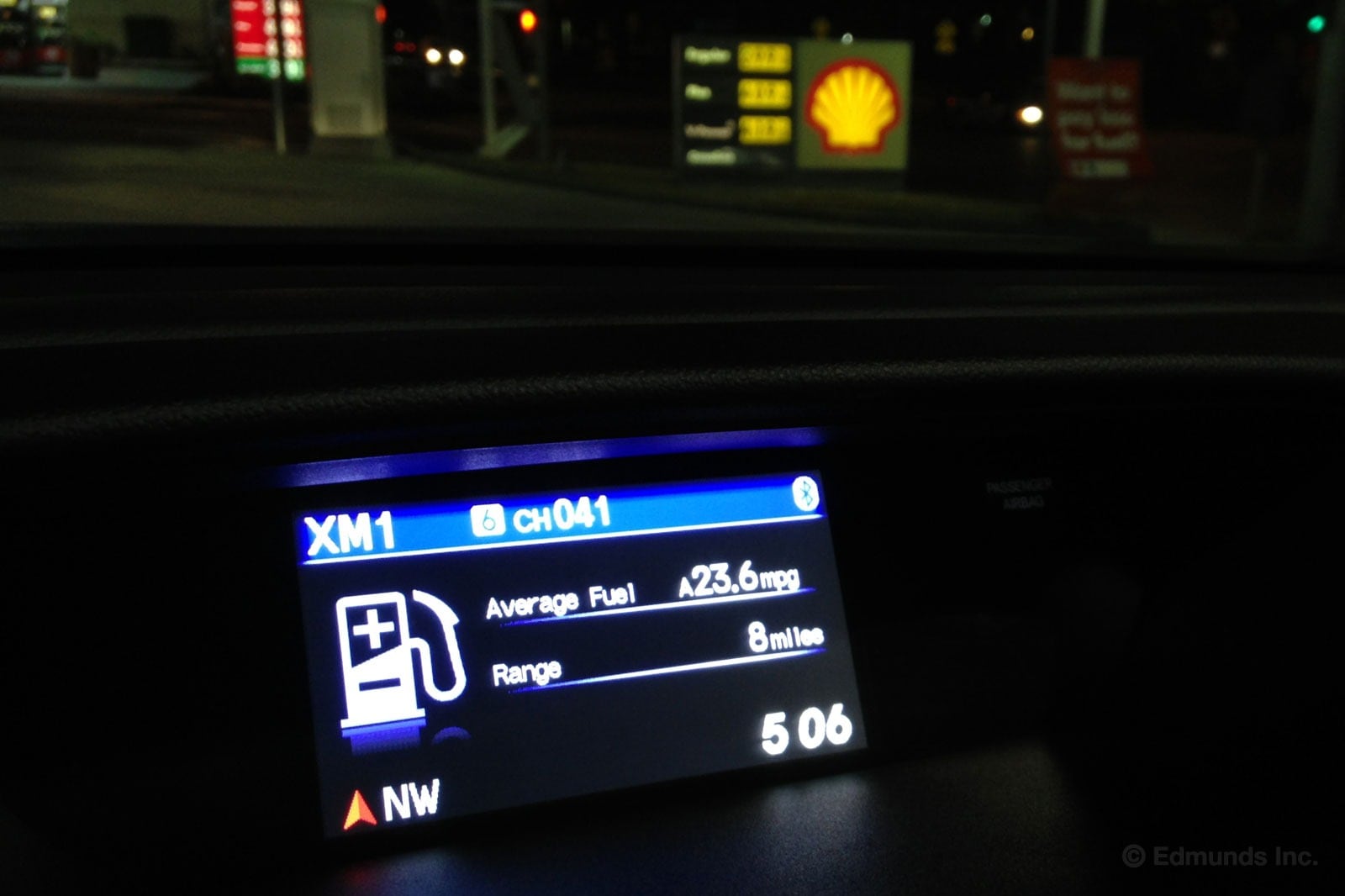
Here is the fuel economy update for our long-term 2012 Honda CR-V during the month of June. We added 1,100 miles to the Honda since last month. This is a bit shy of our monthly goal of 1,700 miles. June marks the final month of our one-year test of the CR-V. Expect a wrap-up published in the near future.
Worst Fill MPG: 17.1
Best Fill MPG: 31.3
Average Lifetime MPG: 24.8
EPA MPG Rating (City/Highway/Combined): 22/30/25
Best Range: 388.9 miles
Current Odometer: 23,726
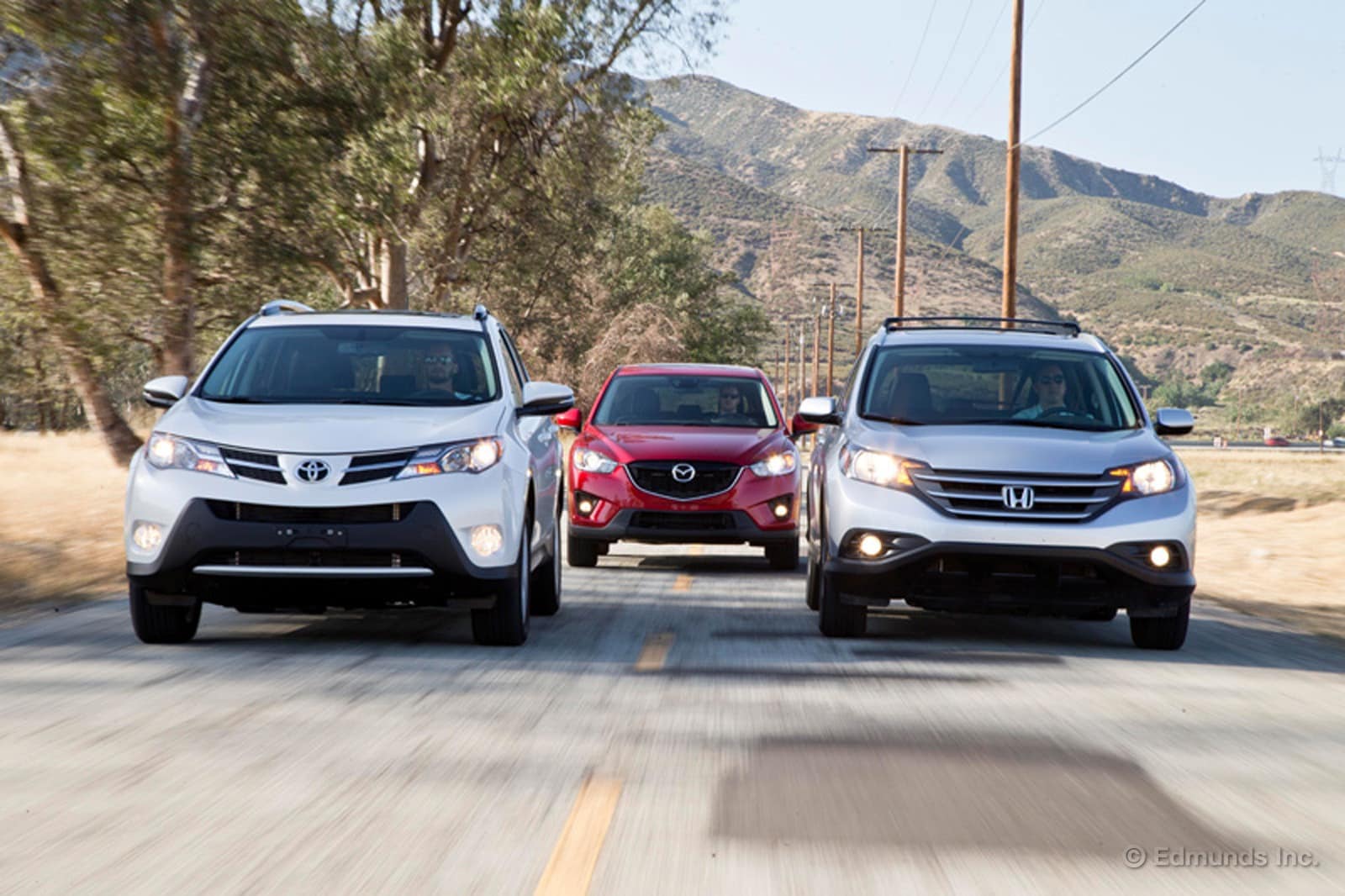
Just before our long-term 2012 Honda CR-V left our test fleet, it had the toughest job of its time with us. It faced off against the 2013 Toyota RAV4 and the 2014 Mazda CX-5.
How'd it do? Read for yourself: Comparison Test: 2012 Honda CR-V vs. 2014 Mazda CX-5 vs. 2013 Toyota RAV4.
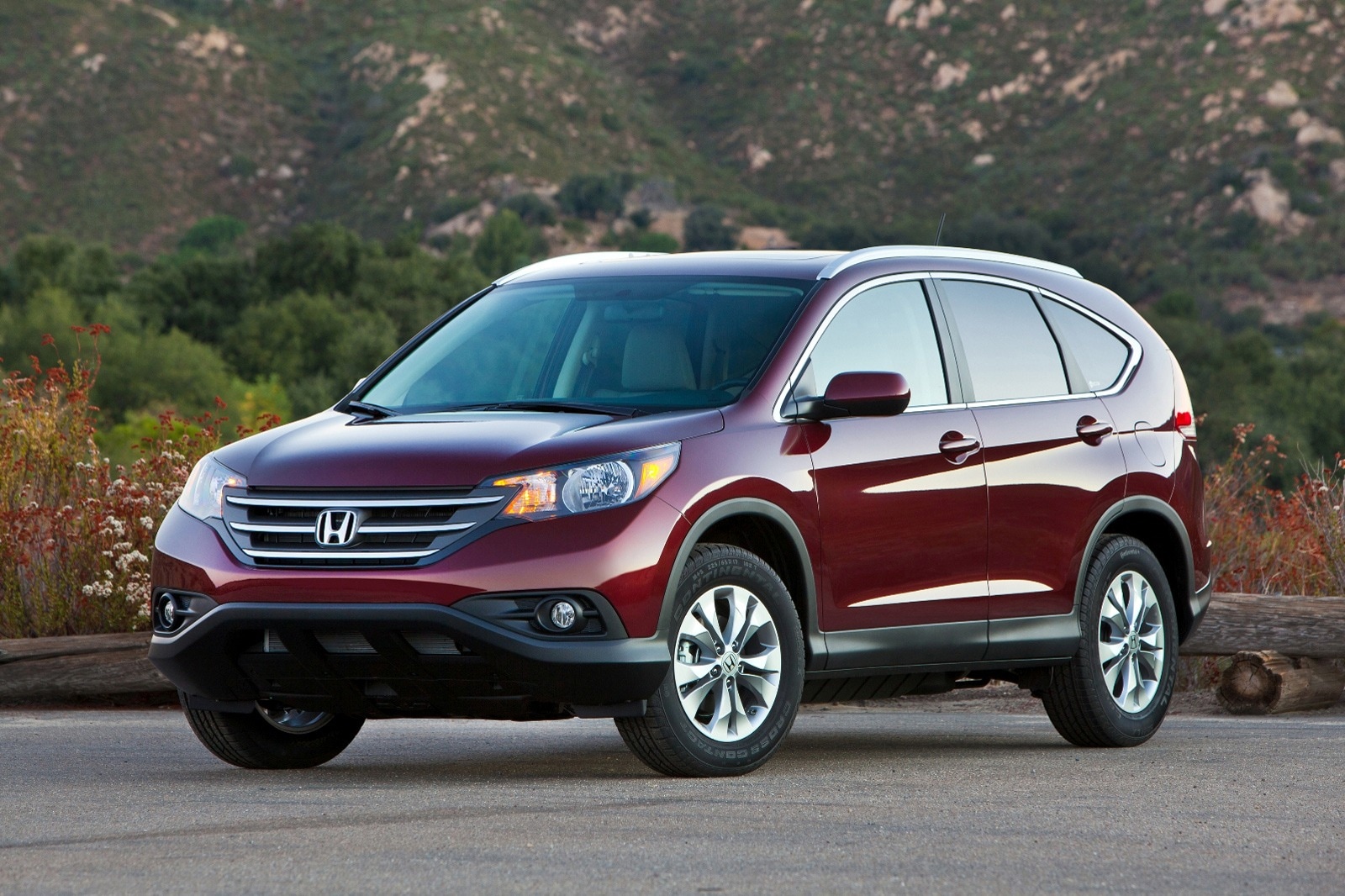
My sister Maria has almost exclusively driven Honda Civics since the mid-1980s, when her younger, car nut brother (yes, that's me) told her to get one when she was looking for a well-built compact sedan.
She's always bought them new, kept 'em for about 8 years and put over 100k on each with nary a problem. Now she's looking at replacing her 2006 Civic EX coupe with a compact crossover.
Of course, she's leaning towards the Honda CR-V, so I told her my thoughts, stating it's hard to go wrong as the Honda is comfortable, practical and pretty good on gas. In other words, my sentiments echo those of our recent comparison test.
Maria's going to be making her purchase in a few months, and she's already picked out a color, "Basque Red Pearl II." I guess she's all done with black and silver Hondas.
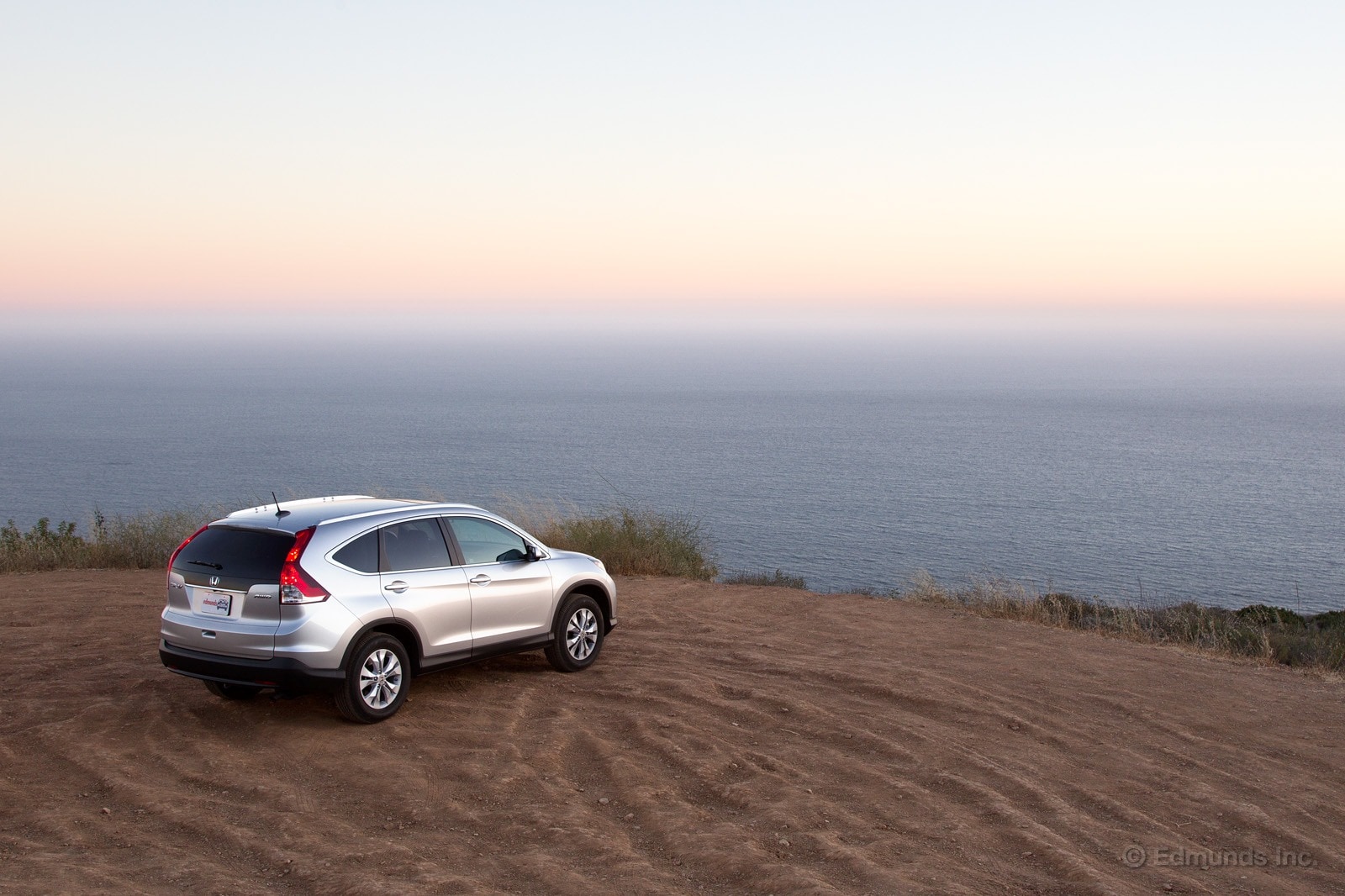
Last month, the Ford Escape was the best-selling SUV in the land, with sales of 22,607 units. The Honda CR-V was very close behind, selling 21,439 units.
Year to date, the CR-V has a slight lead on the Escape, and seems set to hold on to the title of "best-selling SUV" that it nabbed in 2013. Honda sold 229,082 CR-V models in the first 10 months of 2013, while Ford sold 228,290 Escape models.
Smaller SUVs like these are popular with certain market segments, due to their versatility and utility. The CR-V handles these responsibilities especially well. It offers lots of room within the cabin while boasting the sort of manageable footprint that makes it easy to maneuver and pleasant to drive.
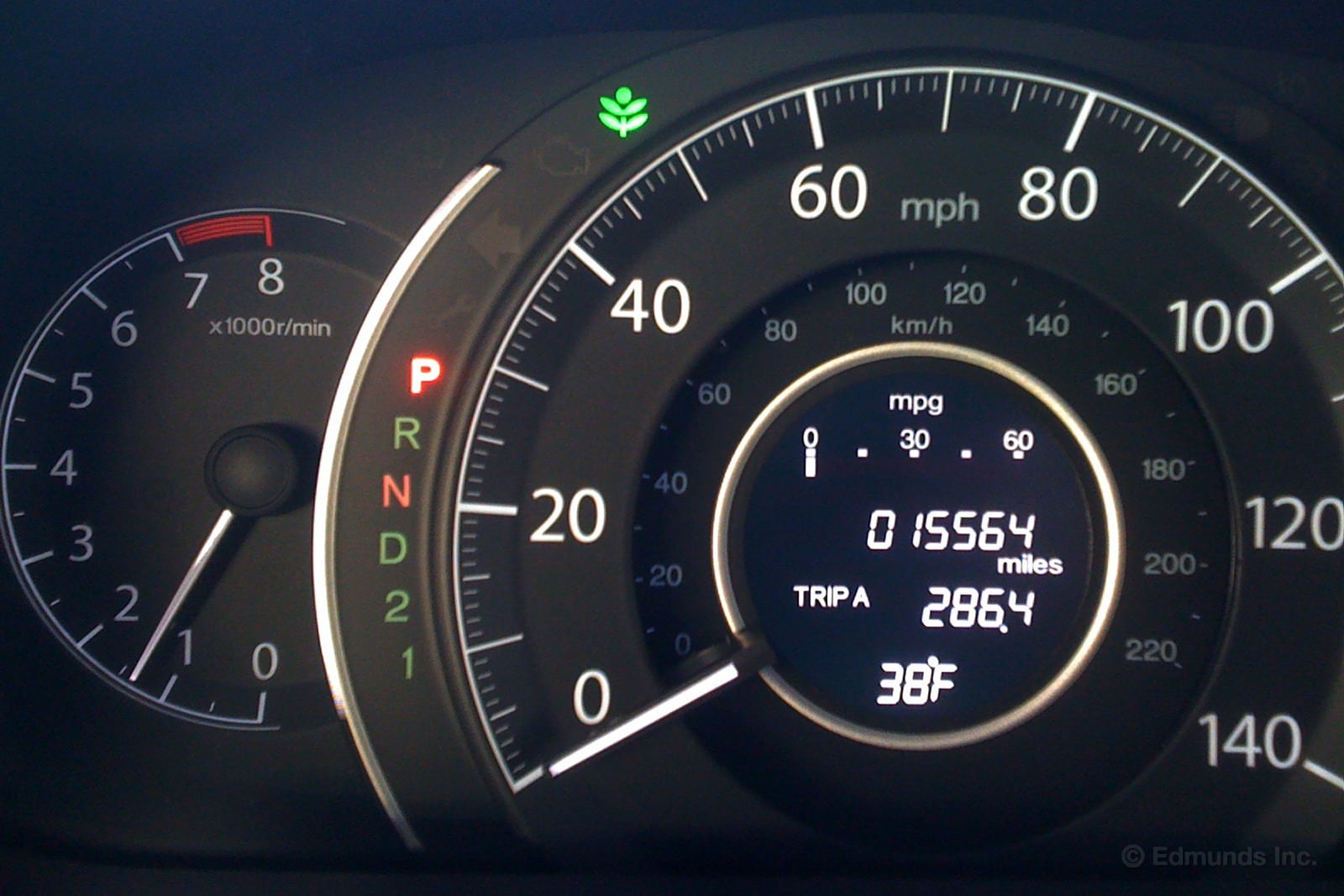
Hard to believe for our friends in the Midwest and Northeastern climes, but not only do we get the shakes out in southern California, but sometimes also the chills. Whether or not a 38-degree morning qualifies as cold for you, to me its six degrees above freezing. Cold enough.
Regardless of the temp, I endeavor to always let the engine of any car I'm driving warm up a bit, three minutes minimum, enough time to get the phone plugged in, get some air moving around the cabin. Before driving the kid to school in the morning, I like to let our old Civic warm up a good five minutes or so, especially if turning the wheel over to the wife, who otherwise would simply turn over the ignition, place it in Drive and hammer on the throttle to be first up the on-ramp.
I can't help but feel that letting an engine's fluids come up to temp before asking too much of it is simply good karma and sound mechanical empathy. But as I was sitting there in the CR-V, letting it warm up, I began to wonder if today's engines are simply built to tolerances that allow them to be wrung out by unknowing, uncaring or just hurried drivers. What do you think? Old myth or good practice?
Wrap-Up
What We Got
For years the Honda CR-V has been a benchmark in the compact utility vehicle segment. Its competition has stepped up for sure, but Honda has always been quick to give the CR-V updates to keep it competitive. The latest upgrades came for the 2012 model year, so we figured it was a good chance to see how well the latest CR-V stacks up against the competition.
In this case, Honda provided us with a loaded CR-V in the form of an EX-L with Navigation and all-wheel drive. This upper-tier example had an MSRP of $30,825 and offered a taste of most everything available on a CR-V.
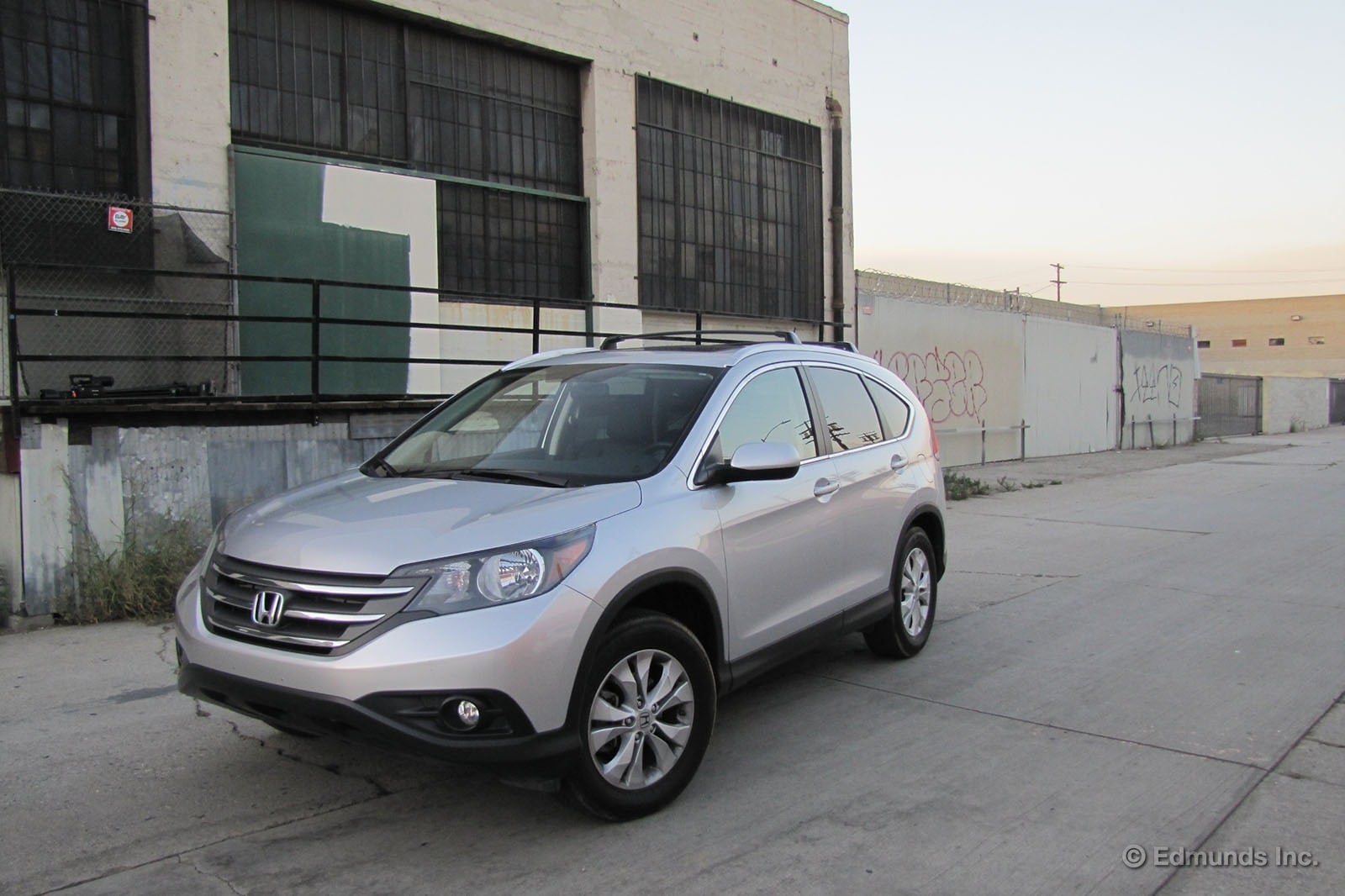
The 2012 Honda CR-V was a mix of old and new. Its 2.4-liter four-cylinder was nearly identical to the previous-generation engine and shared across all trim levels. The inline-4 generated 185 horsepower and 163 pound-feet of torque. The five-speed transmission was carried over from 2011, when it was first introduced. New for 2012 was some mildly revised styling and a new all-wheel-drive system. Namely, updates were made to improve responsiveness to traction loss. Overall, this combination of equipment improved EPA fuel economy estimates to 22 city and 30 highway mpg.
Here's what we found over the course of our 12-month test:
Our Impressions
"The only way to tell the 2012 Honda CR-V is different is to close your eyes. It's quieter, calmer and more refined. The CR-V used to hate big tires, but now it rides across broken pavement with impressive composure on these 225/65R17 Bridgestone Dueler HP Sport AS tires. There's still tire harshness in the Honda way, but the suspension no longer seems to crash across seams and holes. The CR-V has come a long way in price (sadly), but it also seems to have come a long way in refinement." — Michael Jordan
"Am I surprised that our CR-V isn't the fastest vehicle in the fleet? Hardly. Its normally aspirated four-cylinder can only do so much. What does impress me is how smoothly it works in nearly every situation. Whether it's winding up near redline or just cruising along on the highway, the CR-V's 2.4-liter engine always delivers refined power. It runs out of juice pretty quickly on the highway, but the quick-shifting automatic does a good job of grabbing another gear when it's required. At lower speeds the shifts are a little less predictable, so it's not perfect. Overall, it's a solid setup that matches the personality of this SUV." — Ed Hellwig
"The 2012 Honda CR-V's throttle response is so perfectly intuitive, so perfectly supple that it surprises me if I haven't driven it in awhile. Yes, that's right, I'm actually more shocked these days when I drive a car that doesn't immediately lurch forward at throttle tip-in rather than one that does. This abrupt throttle thing has gotten out of hand. But the CR-V's gas pedal is so well-calibrated that it doesn't matter if you take off gently, with a little gusto, or immediately floor it. It's always smooth." — Mike Monticello
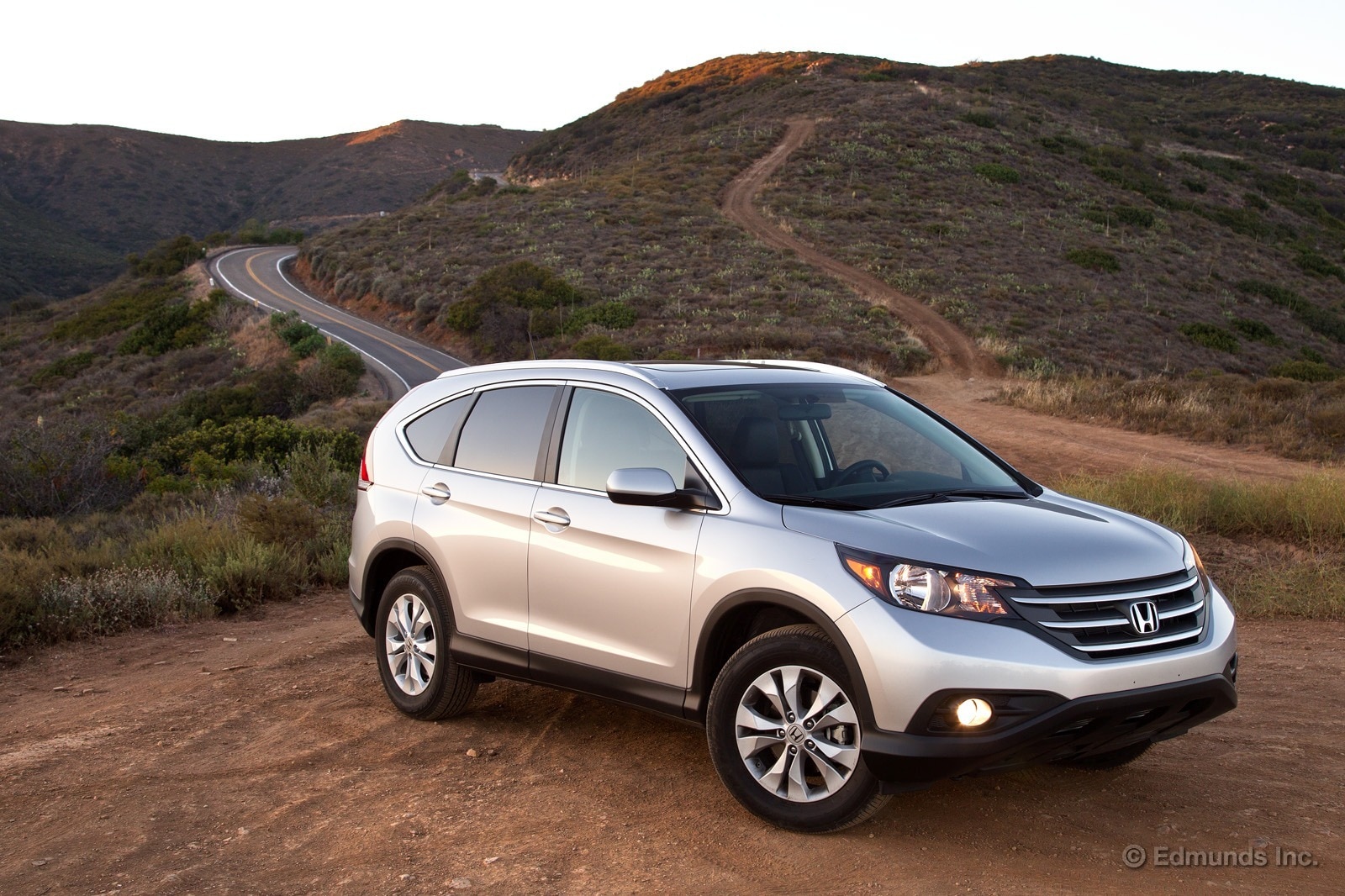
"Recent rains made the going easy in this part of Nevada, on account of a near total absence of dust and excellent grip... which is a good thing since we covered all of 150 miles on dirt today.... Mostly, the roads were straight, but a good number of high- and medium-speed corners and more than a few crests and dips were sprinkled along the route to keep things interesting.... Considering our load of four adults, their luggage, and two loaded coolers, I expected I'd have to rein myself in.... This was not the case. The Honda's suspension does not go all soggy when you add weight. Instead, it seems to come into its own.... I was able to maintain a high pace, upward of 60 mph in places, and through it all the steering was direct and sure. The springs and dampers felt like they were in their sweet spot and the rear suspension still had travel enough to roll through the low places at barely diminished speed, soaking up the compression without coming close to bottoming." — Dan Edmunds
"On the open road, more noise intrudes into the cabin than I'd like. Most of it is road noise from the tires, but there's a fair amount of wind noise that comes in off the large side mirrors. I don't want to give them up, because I like seeing traffic to my left and right, but the noise is there. Also, there are mountains between here and Scottsdale, and the ordinarily adequate 2.4-liter engine has to work pretty hard on uphill grades. And when the engine is working, the cabin vibe is not so relaxed." — Erin Riches
"Those front seats, or should I say captain's chairs, provided solid comfort with their well-shaped cushioning, two-stage seat heaters, flip-down armrests and adjustable driver-side lumbar support. My occasionally ornery lower back didn't complain once." — John DiPietro
"Cargo management is its forte. The CR-V swallows more stuff than its outside appearance would suggest, 37.2 cubic feet behind the rear seats. That volume presents a very usable shape because a typical carry-on roller bag fits under the cargo cover standing up. This made it ridiculously easy to fit all four of our bags with plenty of room to spare for laptop bags, a camera bag, makeup totes and whatnot. Should you need more space, the handle visible to the left is the release for the rear seatback. What's more, the CR-V's cargo loading height is way down there at just 25.75 inches. Little chance of back strain here. When all is said and done, the CR-V has no trouble supporting our family of four on the road for a week with no loss of visibility, no loss of security." — Dan Edmunds
"As best I can tell, this is a new feature on the current-generation CR-V: rear doors that swing open nearly 90 degrees. I only discovered this in an empty driveway while shuffling a car seat in and out of the CR-V. It seems like you only discover these things through physical interface with the car. Pushing the door open wider with your foot, thigh or butt until you realize that you've either dislodged the hinges or that these doors do, in fact, open 90 degrees." — Dan Frio
"Exhibit B is this screen and the matching computerized nanny voice that simultaneously breaks in over the music that says, "The phone has been connected," or words to that effect. This would be OK if the message popped up just once after I started the engine to confirm that the Bluetooth connection has automatically re-paired itself and is ready to go. Thing is, this message and that frickin' voice cut in and repeated that notification every 30 minutes (during our drive to Oregon). So far we've heard this about 25 or 30 times in the 14 or so road-hours we've spent in the CR-V since we left home. Something's not right here." — Dan Edmunds
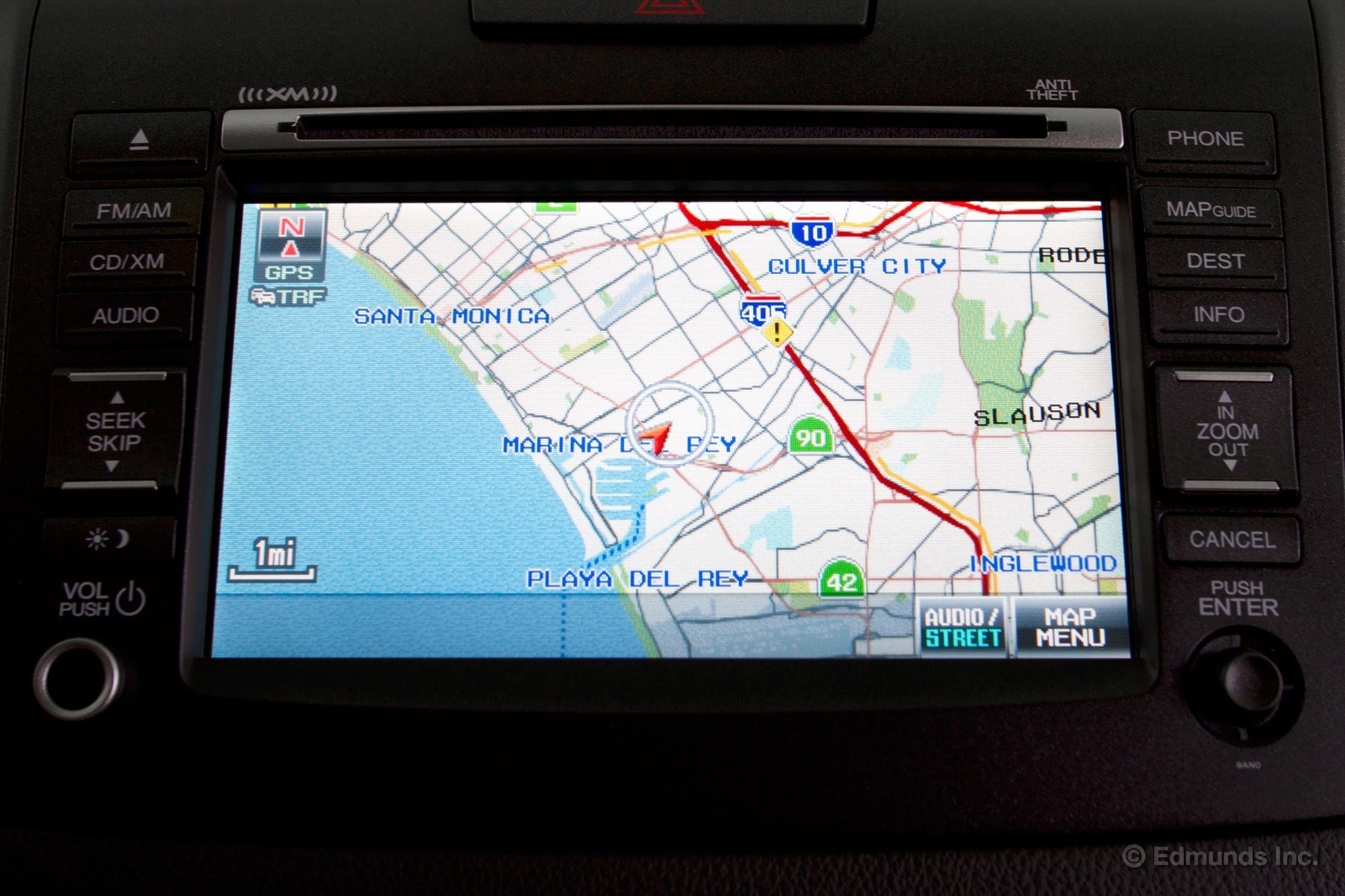
"You can't do much with the CR-V's navigation system when the vehicle is moving, at least not if it involves touching the screen.... However, in a moment of mild desperation and annoyance over the weekend, I tried the voice control. And surprisingly, it works great." — Erin Riches
Maintenance & Repairs
Regular Maintenance:
The CR-V manual outlined routine service at 10,000-mile intervals. At just over 11,000 miles the onboard monitor asked for its first service. This was a unique experience, as we tried an airport parking lot oil change that went from greatest idea ever to a visit to the local Honda dealer for a second oil change. We used our nearby Honda dealership for its second service at 20,000 miles. Over the CR-V's lifetime we spent $188 for regular maintenance.
Service Campaigns:
One CR-V recall surfaced during our test of the CR-V. It required both front door latches and handles to be replaced. The job was performed in about two hours.
Fuel Economy and Resale Value
Observed Fuel Economy:
EPA estimates for the 2012 Honda CR-V with all-wheel drive were 25 mpg combined (22 city/30 highway). Believe it or not, we averaged 25 mpg over 23,000 miles. Our best single tank returned 31 mpg and our longest distance between fill-ups was 389 miles.
Resale and Depreciation:
Hondas have a history of retaining their value well. The CR-V was no exception. After 23,726 miles of service, Edmunds' TMV® Calculator valued the car at $25,146 based on a private-party sale. This was expectedly strong at just 18 percent depreciation.
Summing Up
Pros: Good balance of power, fuel economy and drivability from its standard four-cylinder engine, very responsive automatic transmission, excellent cargo versatility, easy-to-use cabin controls, strong resale value.
Cons: Cabin noise is pervasive on the highway, occasional technology quirks from the multimedia center, gets winded easily over mountain passes.
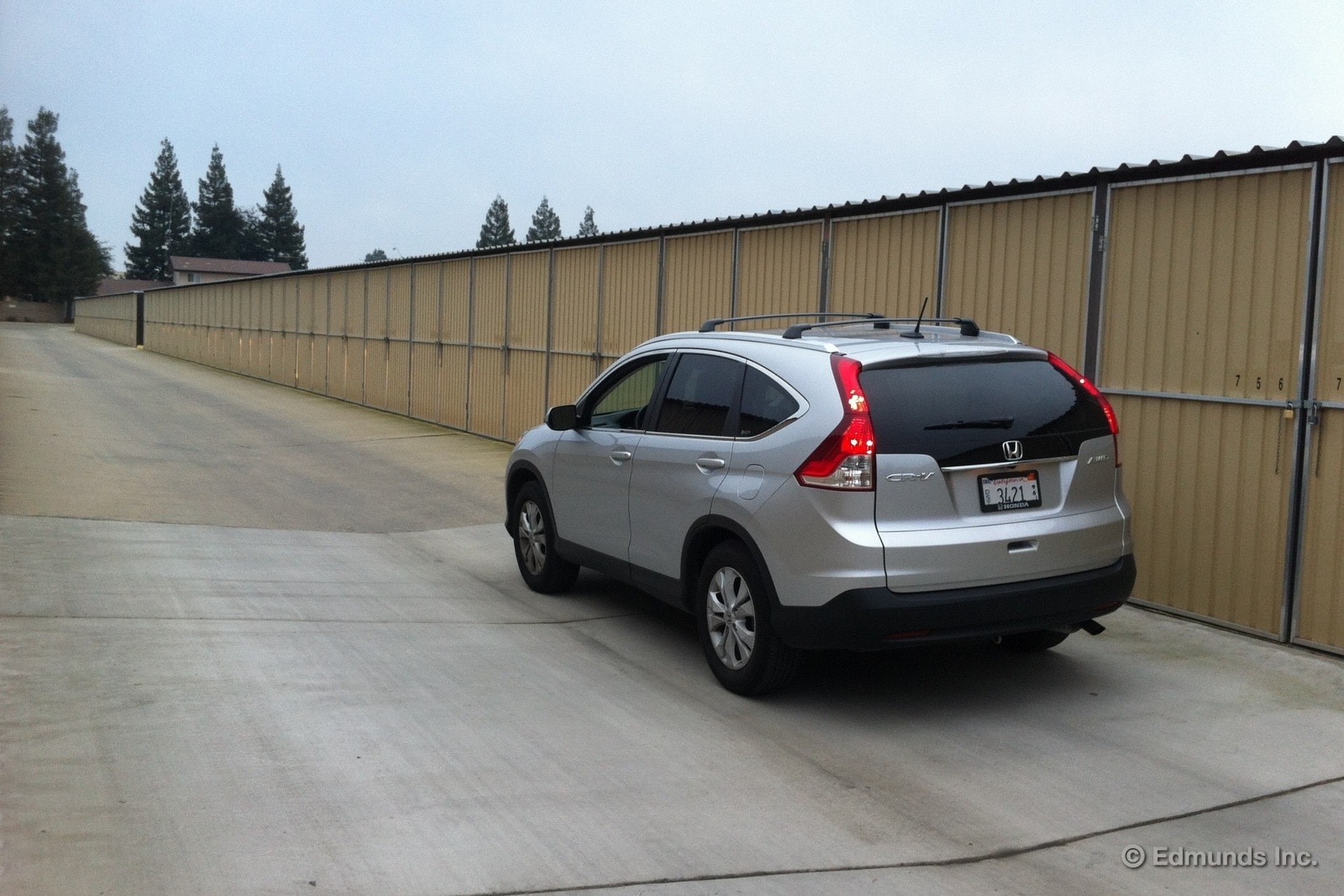
Bottom Line: The Honda CR-V remains one of the top choices in the compact utility vehicle segment thanks to its flexible and fuel-efficient engine, excellent use of space and strong resale value.
| Total Body Repair Costs: | None |
| Total Routine Maintenance Costs: | $187.86 (over 12 months) |
| Additional Maintenance Costs: | None |
| Warranty Repairs: | Replace both front door latches and handles |
| Non-Warranty Repairs: | None |
| Scheduled Dealer Visits: | 2 |
| Unscheduled Dealer Visits: | 1 for door handle recall |
| Days Out of Service: | None |
| Breakdowns Stranding Driver: | None |
| Best Fuel Economy: | 31.3 mpg |
| Worst Fuel Economy: | 15.0 mpg |
| Average Fuel Economy: | 24.8 mpg |
| True Market Value at service end: | $25,146 (private-party sale) |
| Depreciation: | $5,679 (18% of original MSRP) |
| Final Odometer Reading: | 23,726 miles |
The manufacturer provided Edmunds this vehicle for the purposes of evaluation.